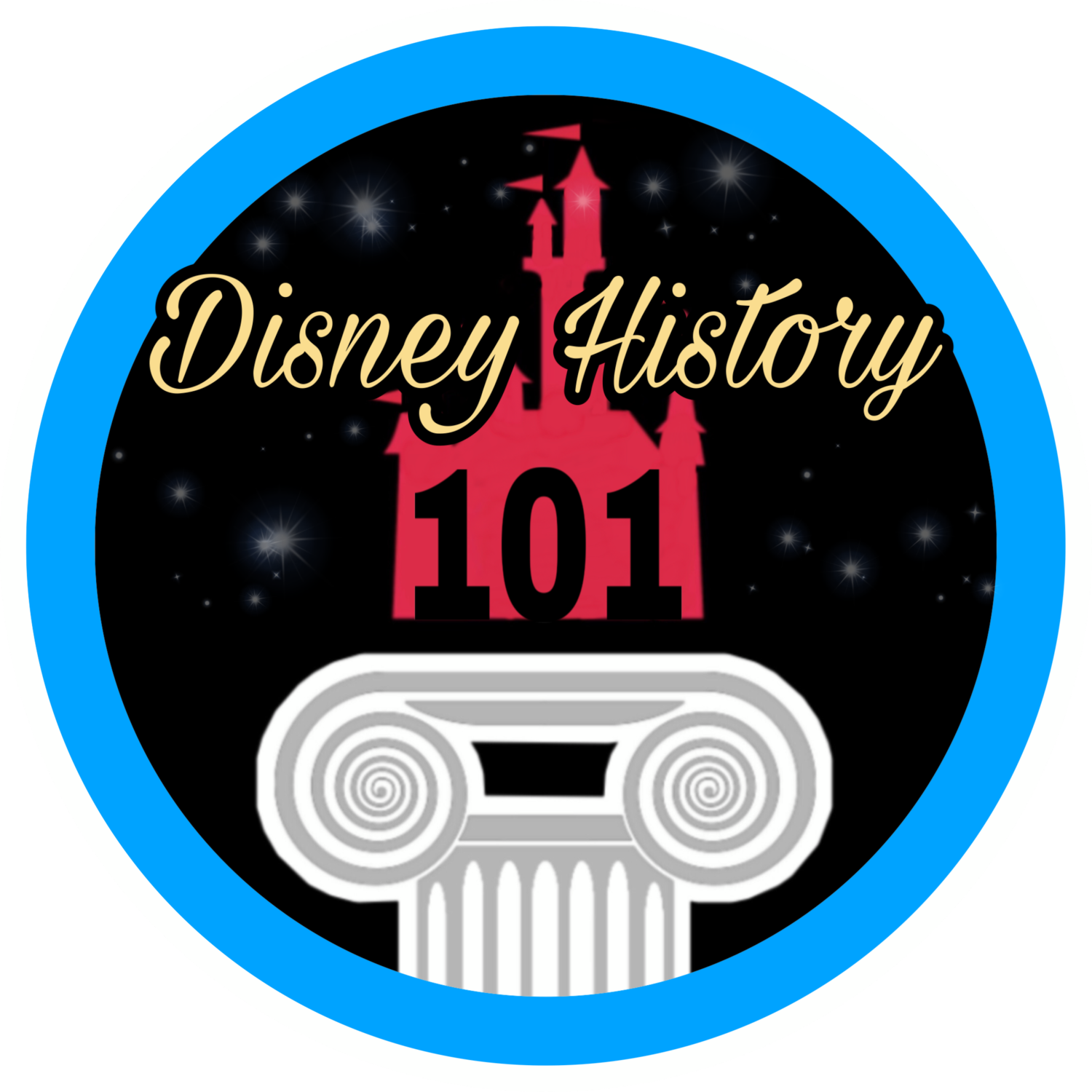HOLIDAYLAND
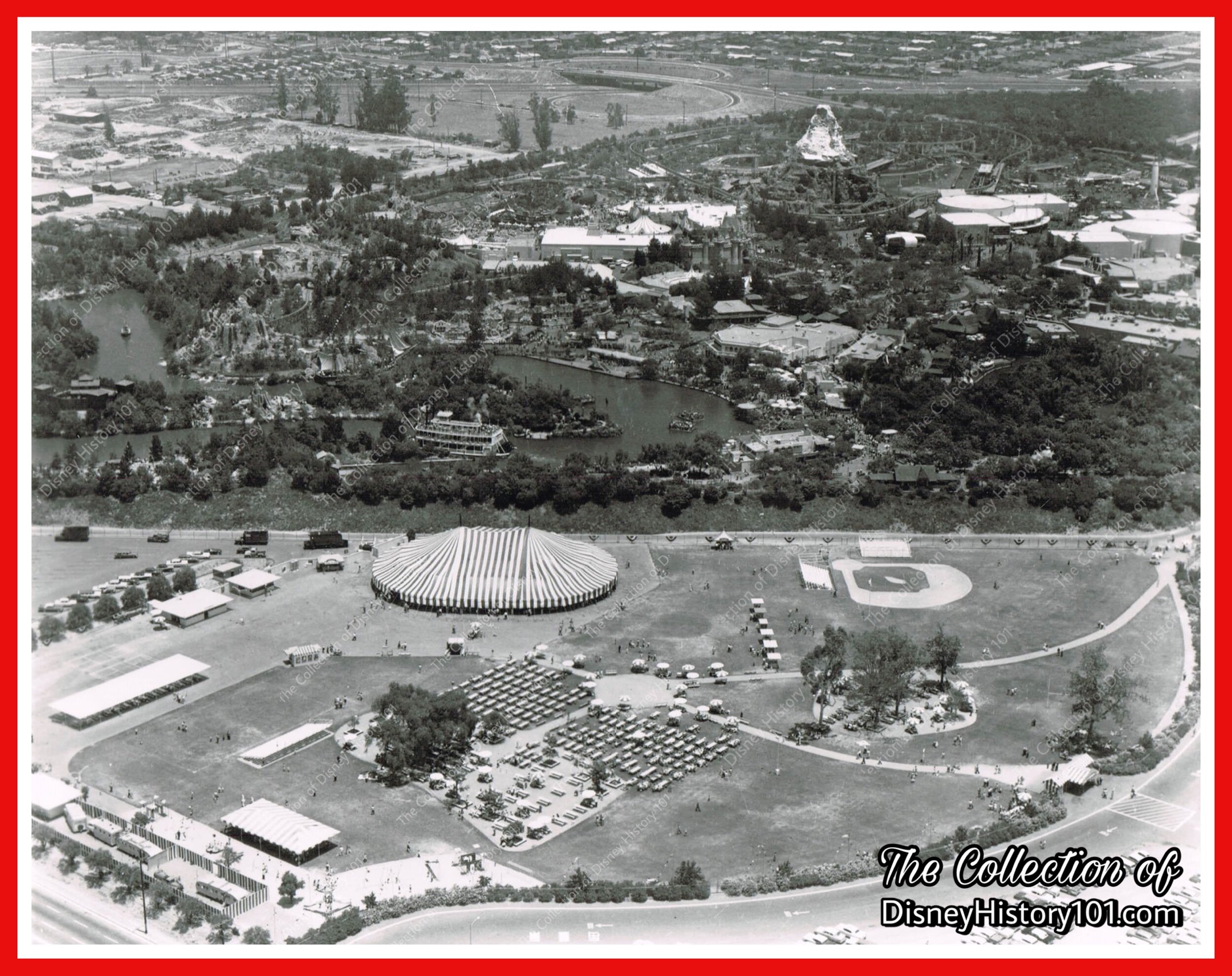
Aerial "Vintage View" of Holidayland, c. 1959
Walt Disney, on the eve of Disneyland’s first day of operation, promised that “Disneyland will never be completed. It will continue to grow, to add new things, as long as there is imagination left in the world.” A year later (in 1956), and as Disneyland was ever-expanding, many ideas would be submitted before Walt Disney. Some ground shaking concepts (like George Whitney’s “Pompeii Attraction”) would never see the light of day. But many other Disneyland attractions would debut during 1957, and some of these would endure (i.e. the Sleeping Beauty Castle walk-through exhibit, the Monsanto House of Tomorrow). Still, others would unfortunately be short-lived (i.e. the Viewliner Train of Tomorrow). Now, we invite you to explore what is undeniably Disneyland’s least photographed (and least understood land), and what has even been called a “lost land” of Disneyland. “Please, step this way” as we embark on our tour of. . .
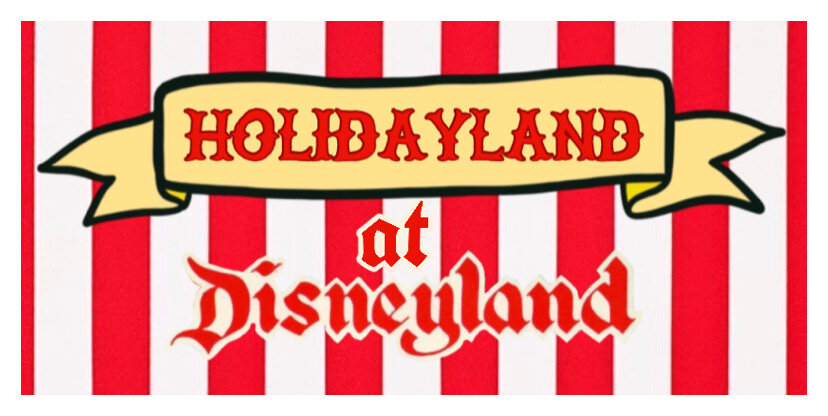
(June 16, 1957 - September, 1961)
Since the beginning, Walt believed that “people need play as much as they need toil,” as related to Wisdom magazine, December 1959. It isn’t any wonder that the earliest drawings of a Mickey Mouse Park (to be proposed for an 11-acre triangular plot near Buena Vista and Riverside Drive in the City of Burbank, California) featured details of a “picnic area” and an adjacent “carnival”. As Disneyland’s development continued throughout 1953, some Disneyland concept drawings and documents like the “Proposed Diagramatic Layout of Disneyland” (Marvin A. Davis’ plot plan, produced for WED Enterprises, by September 12, 1953) included both Holiday Park (Fantasyland and the World of Tomorrow) and Recreation Land (located in an area between “Frontier Land” and “Fantasy Land.” As we will see, the features contained within the concepts of these seemed proposed attractions seem to have heavily contributed to the outcome of the future Holidayland!
According to the October 8, 1953 Disneyland Prospectus (prepared by Bill Walsh of WED Enterprises for Disneyland Inc.), Recreation Land was to be “A Leisure Land - a shady park set aside for reservations by clubs, schools, or other groups for picnic and special outings. A catering service supplies special foods or lunch-in-a-basket. There is a little old-fashioned bandstand and a pavilion for dancing and entertainment and an area for games.” According to the same documents, Holiday Land was to be “a showplace of special attractions that change with the seasons. Its theme is as current as the calendar. Its decorations, entertainment, or exhibits follow the flowers in Spring, with the Flower Festival…the Mardi Gras and special Easter activities. Mother’s day…St. Valentines Day…Boy Scout Week. Summer brings the Fourth of July…and Circus Time…with a Circus Parade down Main Street…and under the big top, a one-ring circus with special acts from all over the world.”
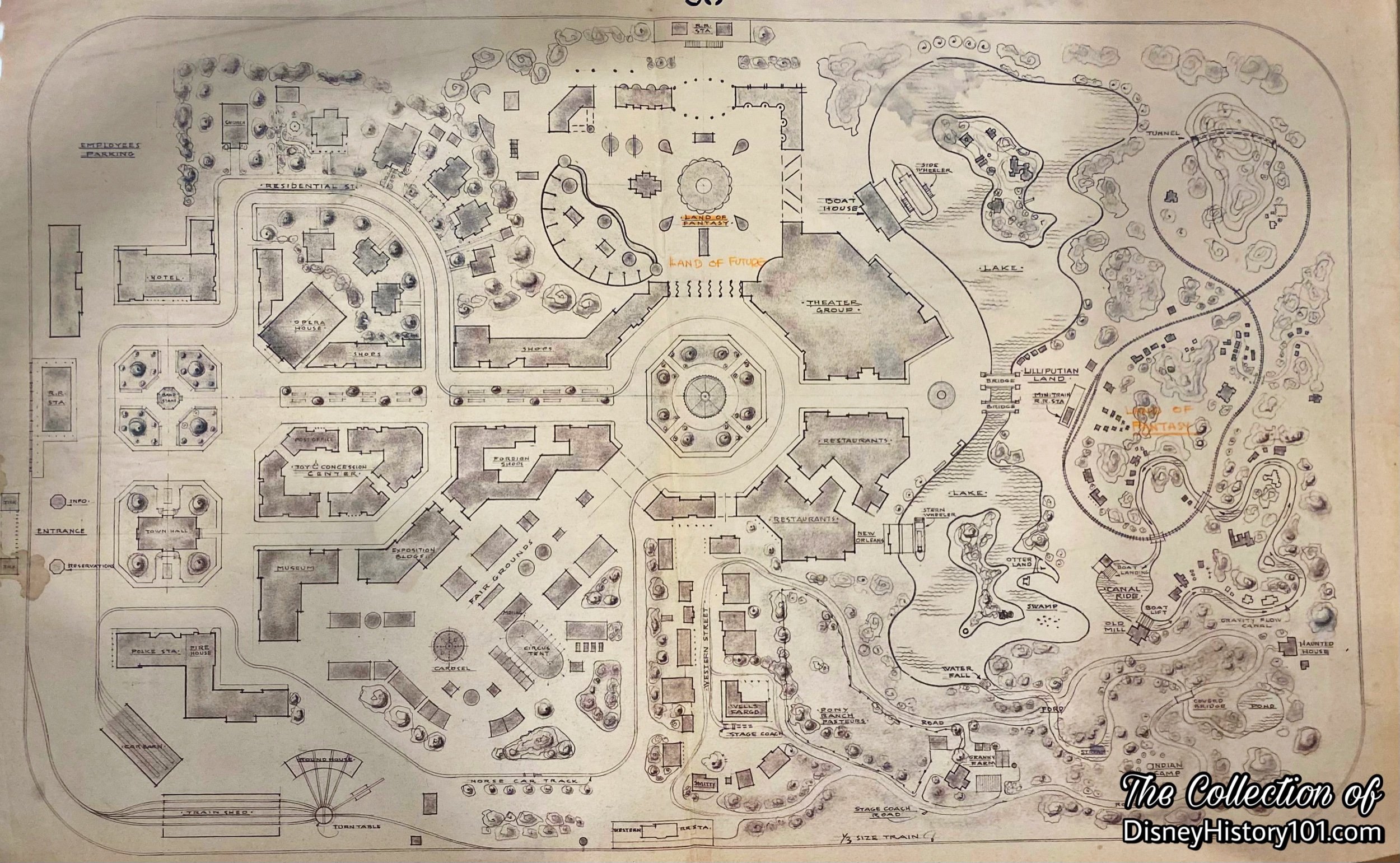
The Southwest portion of “Disneyland Preliminary Scheme #1” with Fair Grounds, Circus Tent, and Carousel.
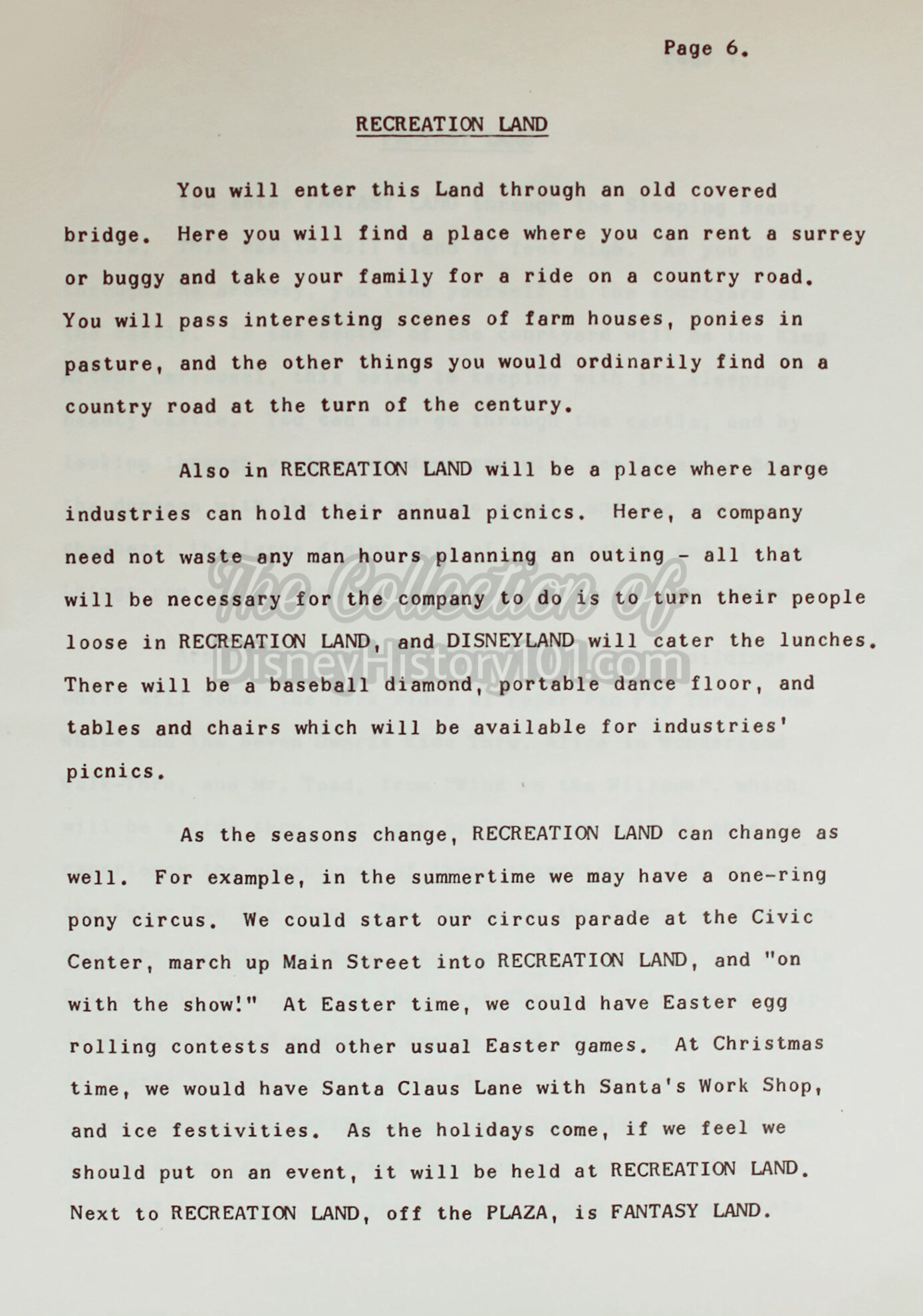
“Disneyland Prospectus” 1954, Page 6, Facsimile. Similar details about Holidayland were published in Nash Airflyte Magazine (July of 1955).
The “Schematic Aerial View of Disneyland” (produced by Herb Ryman) has gained some notoriety when few have come to auction in recent years, yet it was first published in periodicals like Popular Mechanics, December, 1954. This and a portfolio of colored sketches by Herb Ryman, Bruce Bushman, Harper Goff, and others was prepared for Dick Irvine and Nat Winecoff to take back East to sell the Disneyland concept to prospective licensees.
Herb’s drawings (as well as their photostat and hand-traced copies) continued to feature a land of circus tents and wagons, and another area called Holiday Park, which was to be located West of Main Street U.S.A., south of a “Frontier Country.” It seems that these were to be two separate areas accessed from the Central Plaza of Disneyland. A short time after this drawing (pictured below) was created, what has been called the 1954 “Disneyland prospectus” by some, continued to mention the inclusion of picnic areas at Disneyland.
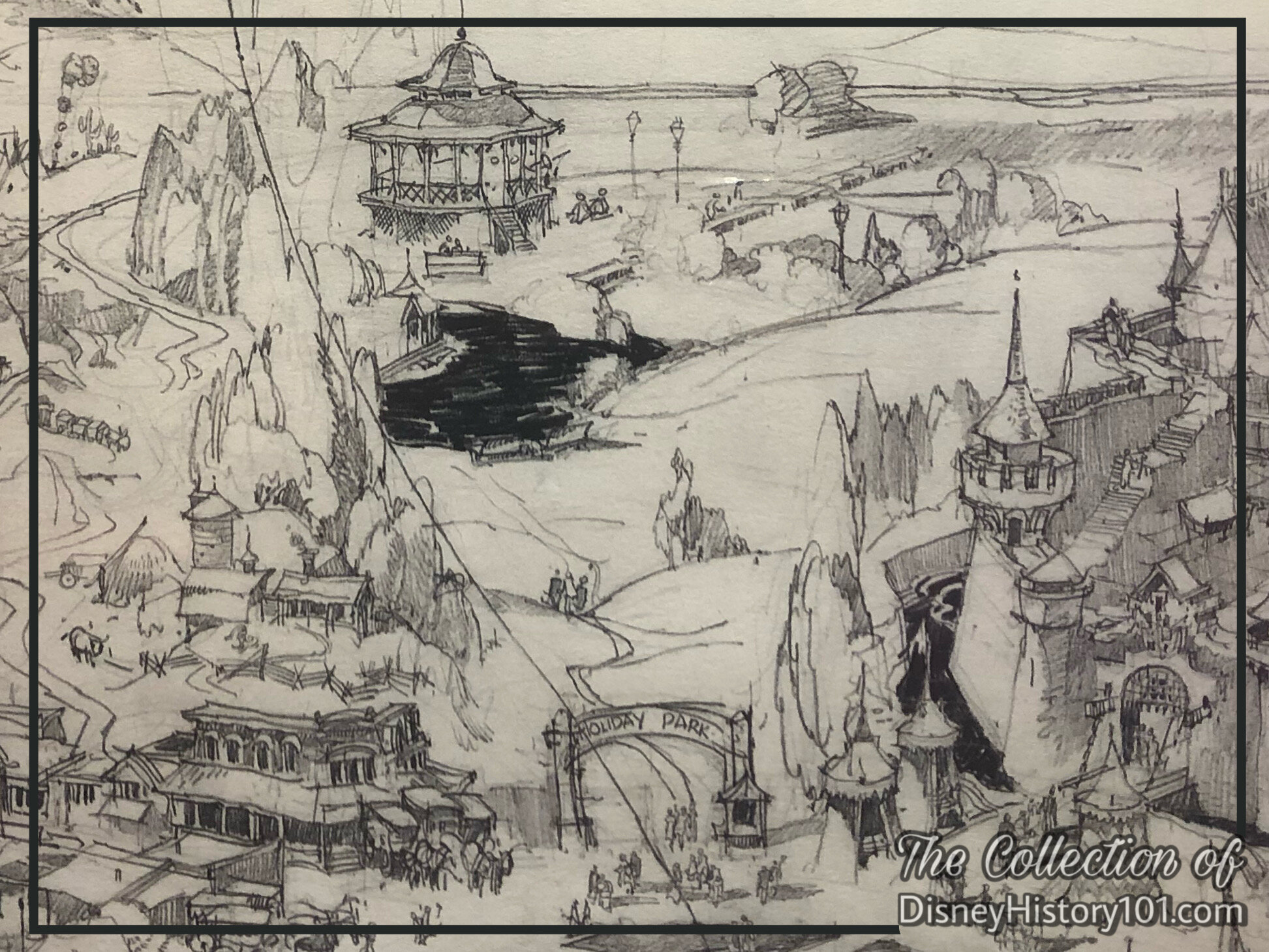
"Holiday Park" in Herb Ryman's "Aerial View Over Disneyland" or “Disneyland Schematic Aerial View” originally produced September 26 & 27, 1953.
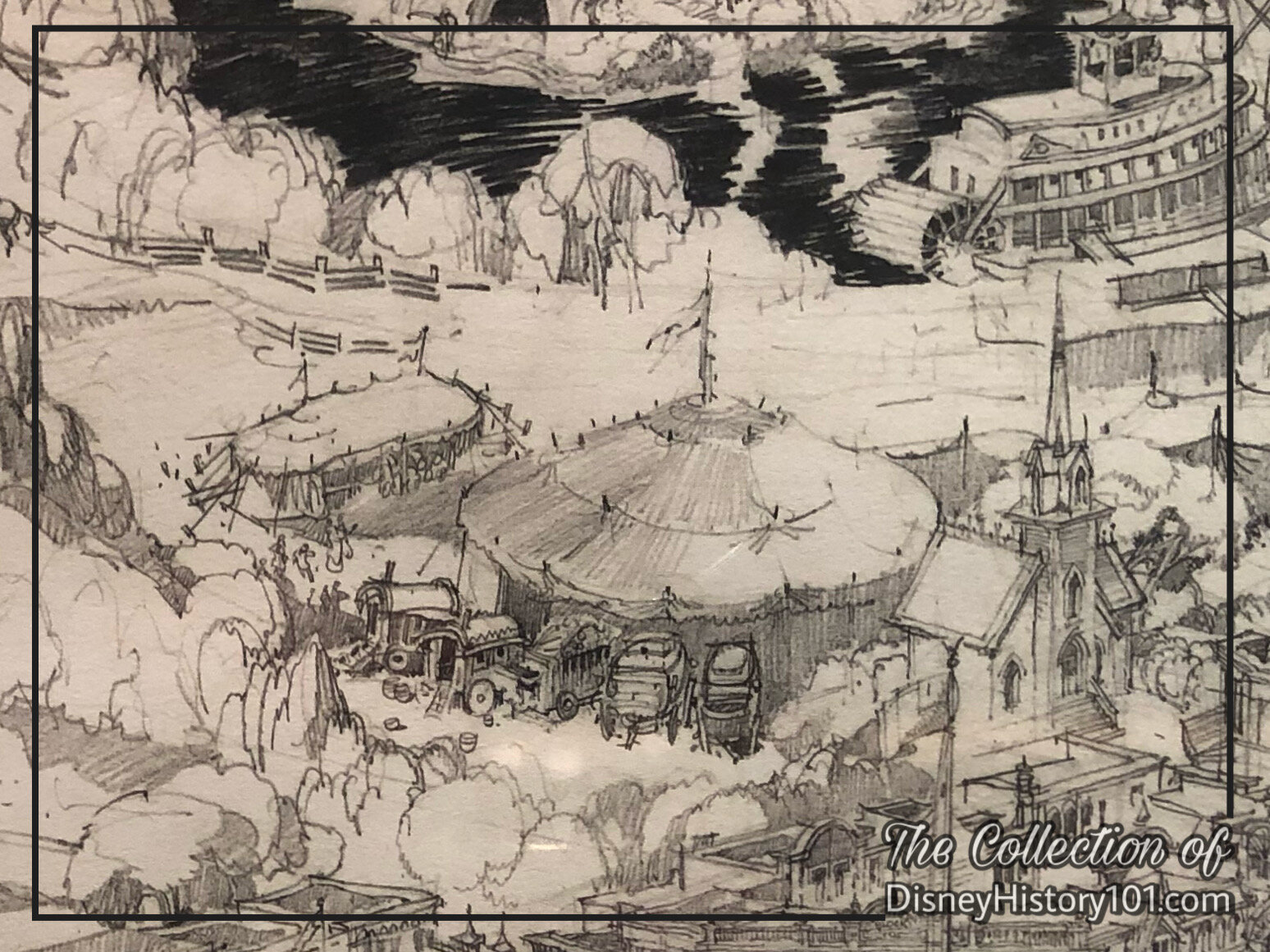
Circus Tents in Herb Ryman's "Aerial View Over Disneyland" or “Disneyland Schematic Aerial View” Excerpt, originally produced September 26 & 27, 1953.
Fast forward to August of 1954 - during the “excavation” phase of Disneyland - when a good portion of the 350,000 cubic yards of dirt (most of it excavated for the waterways) began to be piled into the 15-foot-high berm that would surround Disneyland. The rest of the dirt was formed into a “mountain” (now realized on the North-East side of the Park) from which guests could hike and survey a spectacular panoramic view of the Park from benches. The area was home to one original gasoline-powered motorized pump left on the parcel of land that would become Holiday Park (used occasionally as a booster when water pressure dropped). This entire area was called Holiday Hill (or, “Holiday Park”, as seen in Marvin Aubrey Davis’ Plot Plan drawing below)!
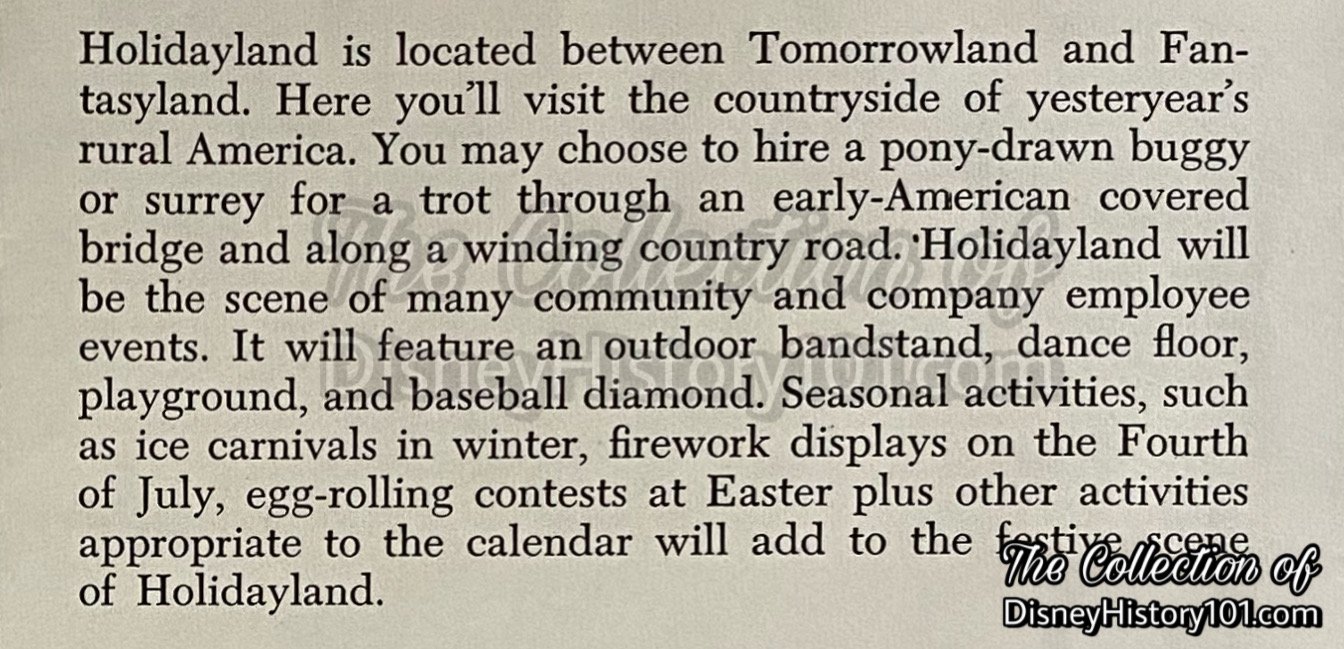
A 1955 prospectus brochure describing “Your Disneyland Tour.”
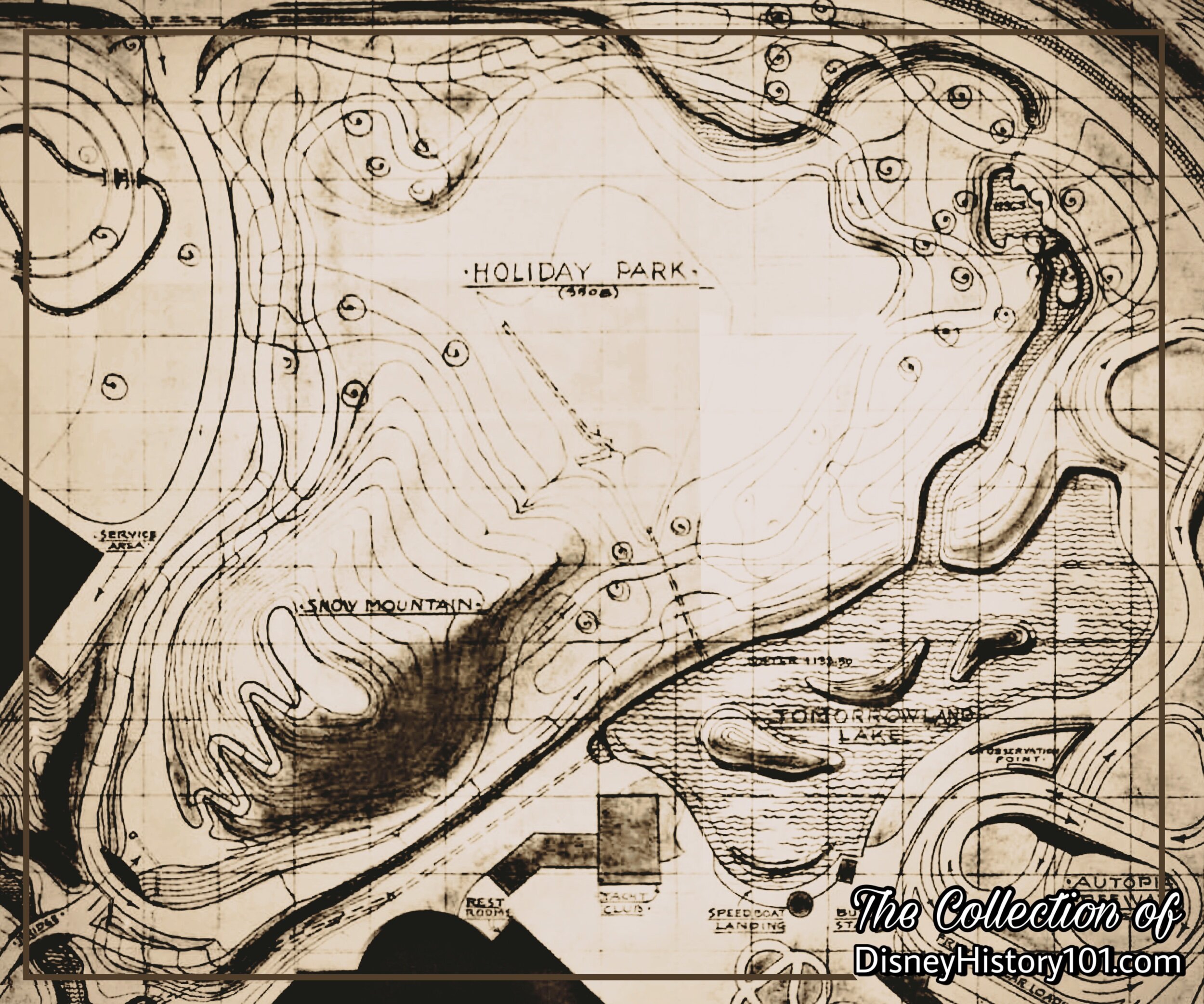
Excerpt from one Marvin A. Davis’ c. 1953 “Plot Plan of Disneyland” facsimile (also referred to as Marvin Davis’ “Second Generation Hub Layout”)
Many ambitious plans for Holiday Hill surfaced. One of the earliest (c.1953) concepts for “Holiday Land” described what it would look like in the winter, mentioning an “ice skating rink, sleigh rides,” a “Christmas Tree Lane that leads to Santa’s home in the North Pole,” and “Bob-Sled Hill with real snow.” Some of these ideas were still being considered by 1955, and this is testified to, by the words of Walt’s friend (and Hollywood columnist) Hedda Hopper. In her “Looking at Hollywood” column (published May 22, 1955), Hedda divulges “One hill is covered with pines, and he’ll have a snow machine working full time, so that kids in this area who’ve never had a sleigh ride can rent a sled and sail down hill.” While the snow never materialized, Skyway Cabins (and Guests on winding footpaths) would reach their highest point in Disneyland from the top of Holiday Hill. In fact, the Skyway’s tallest battery-bearing pylon would be placed here a year later. This tree-topped hill rose (to the east) over Fantasyland (as seen in some aerial footage of “Disneyland, U.S.A.” a “People and Places” feature film, released in the U.S. on December 20, 1956 through Buena Vista Film Distribution Company).

Holiday Park & Archery Range; Plot Plan of Disneyland by Marvin Aubrey Davis of WED.
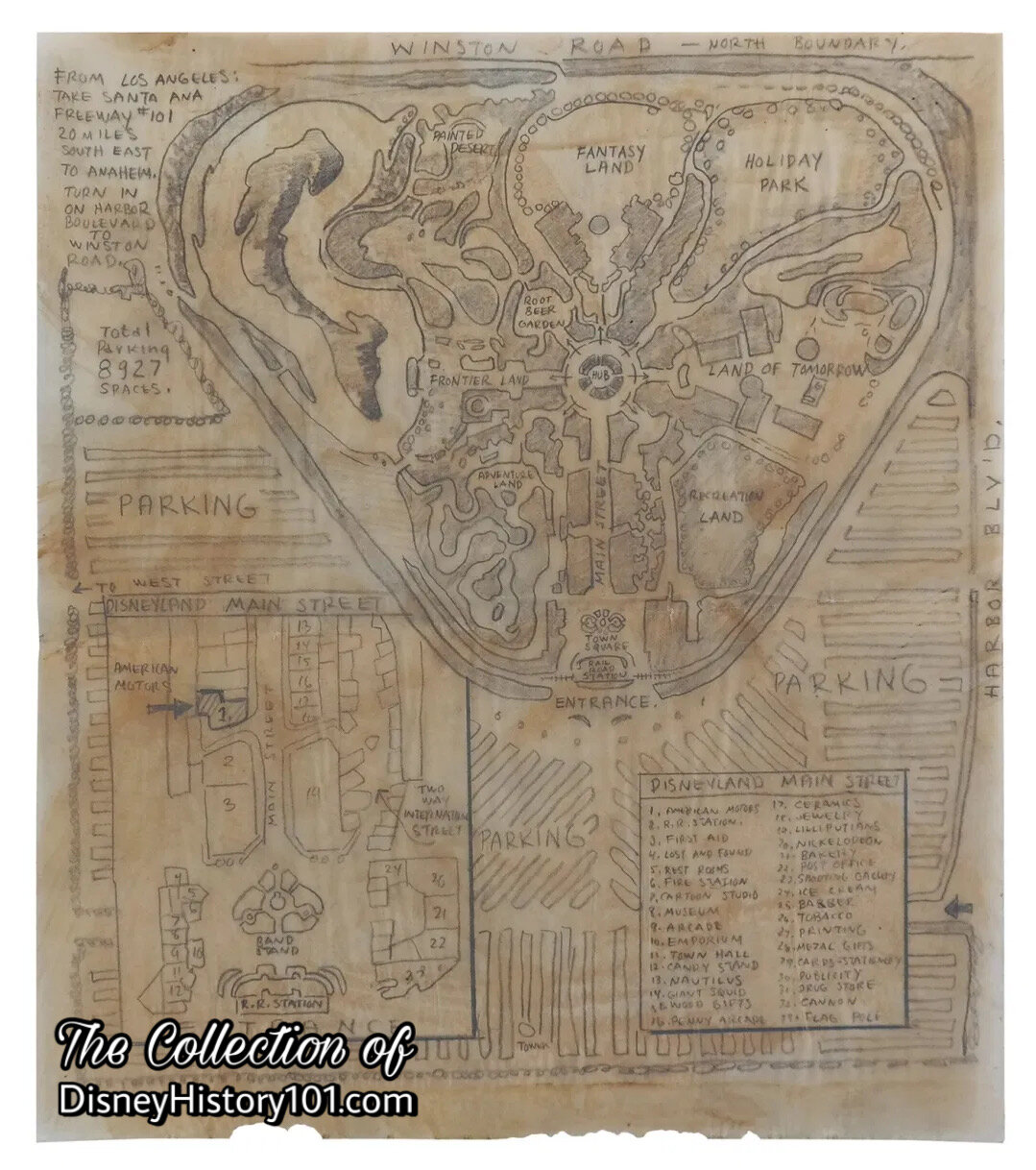
Hand Drawn Map of Disneyland, c. 1954.
Pictured Above : This hand-drawn map created for American Motors Corporation includes an area labeled Recreation Land, and another area labeled Holiday Park (in an area similar to the 1st incarnation of Holidayland)!
As ambitious as those plans for Holiday Hill were, it seems that most of the land’s developments took place in its shadow - Holidayland! Yes, from November 24, 1955 thru January 8, 1956 (and not even a year before Disneyland celebrated its first year of operation), the first incarnation of Holidayland opened to guests, with entry via Fantasyland! What was a Holidayland experience to be like?
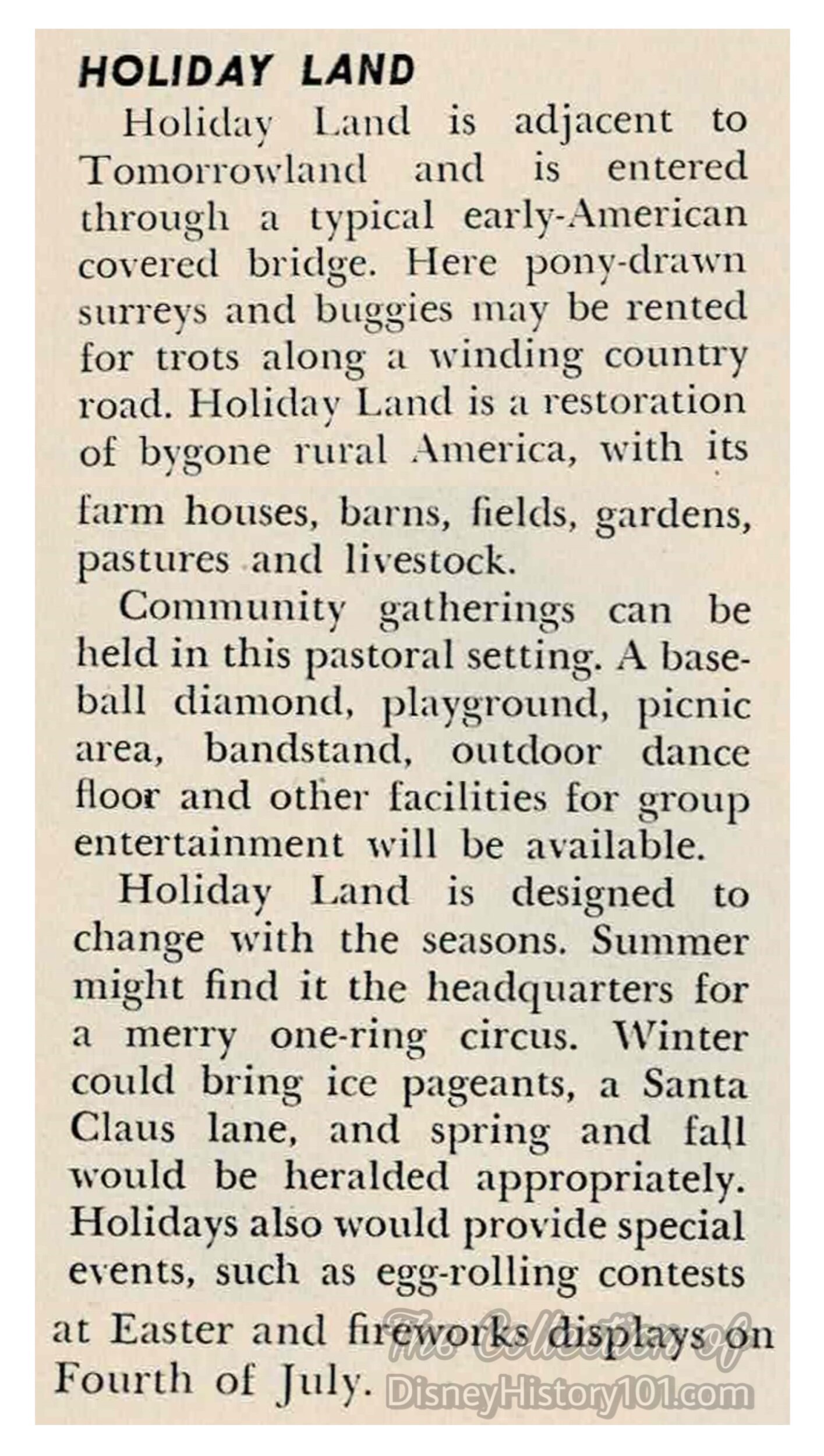
"Travel - The Magazine That Roams The Globe" (July, 1955) Excerpt Describes Holiday Land
Articles in magazines (like “Travel”; published July, 1955) prepared audiences for the many adventures and attractions that they would encounter in Disneyland - including Holidayland! Artwork prepared for this television tray (one of the earliest pieces of licensed Disneyland merchandise, pictured below) gave future visitors an idea of what the circus might look like. A very similar piece of artwork (likely by the same unknown artist) appeared in the “Mattel Musical Map,” another early piece of licensed Disneyland merchandise.
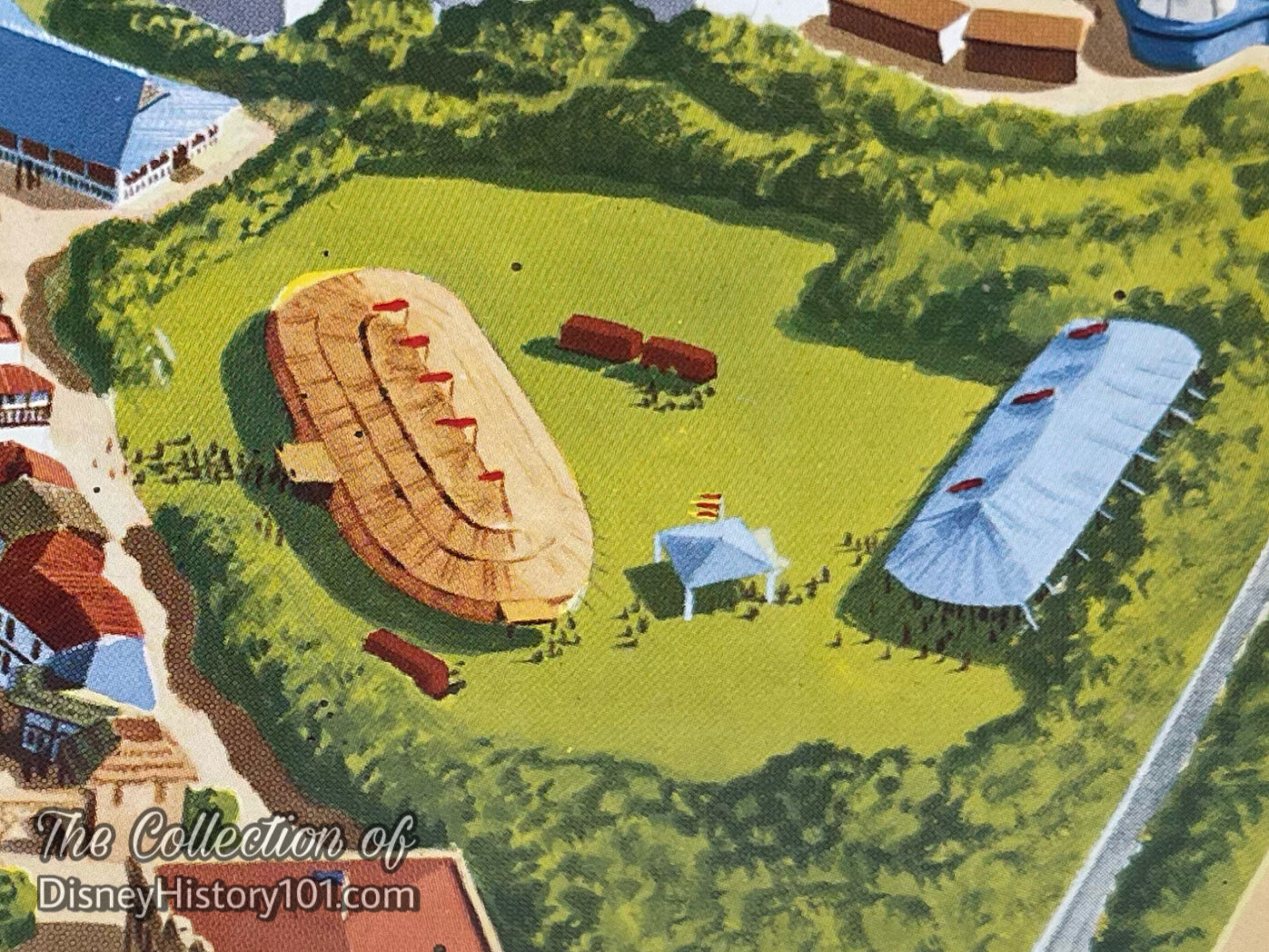
Circus Tents on Disneyland Television Tray, 1955 ; Note the Circus Tent and Circus Wagons as well as a 2nd Tent on the Grounds
Some of these viable project Concepts (as above), were supported by a well-developed business case and built expectation.
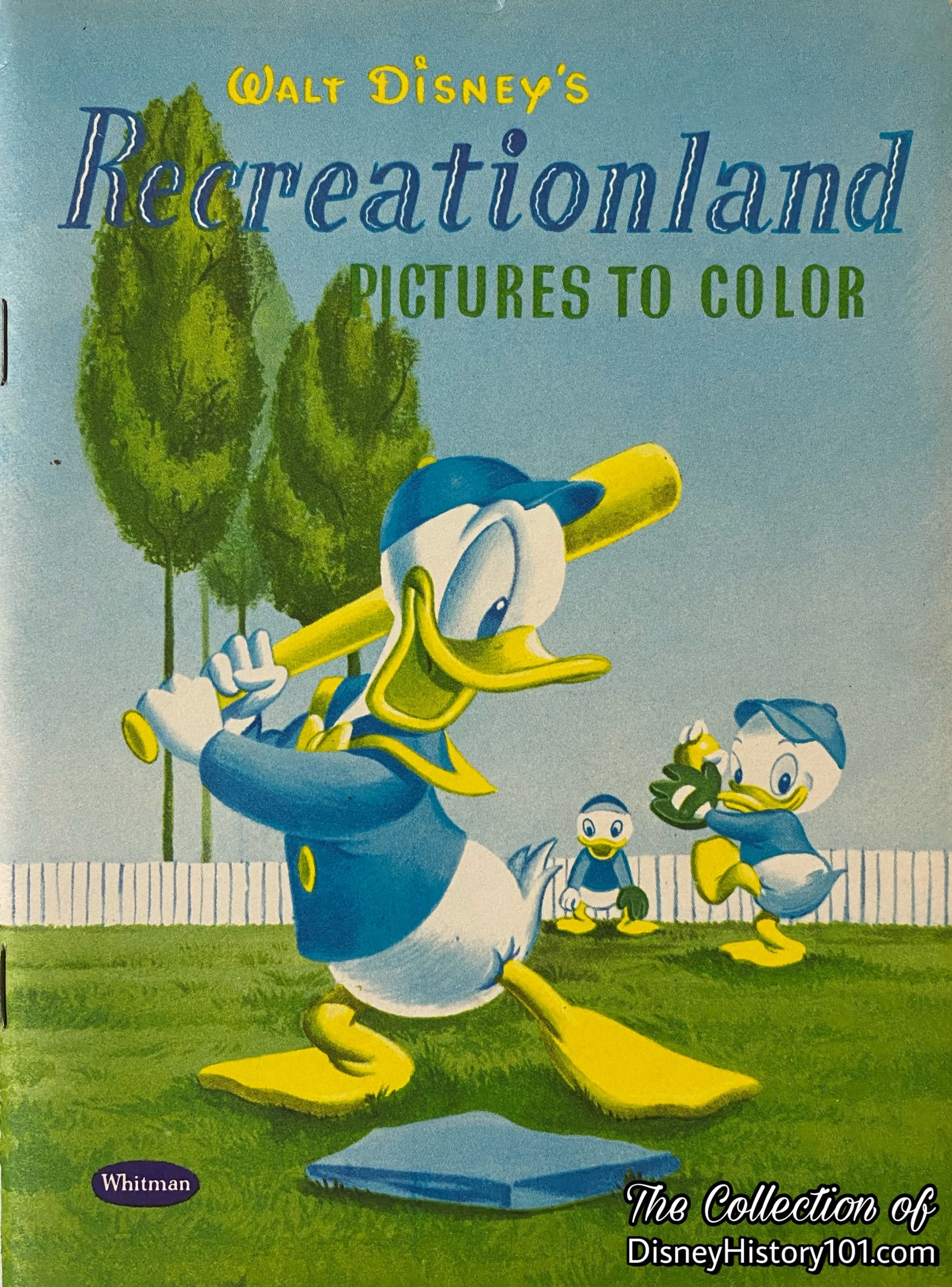
Walt Disney’s Disneyland Fun Box Recreationland Coloring Book

Walt Disney's "Donald Duck In Disneyland" Cover (depicting a Circus Among Other Attractions) Excerpt, (c. 1954-1955)
Pictured Above : This wraparound cover of Walt Disney's "Donald Duck In Disneyland" (published from c. 1954-1955) featured a number of elements that gave a good idea of adventures awaiting Disneyland visitors. Just off to the right (below the rocket ship), sits a striped circus tent, many months before Disneyland (and Holidayland with its Mickey Mouse Club Circus) would open to Guests!
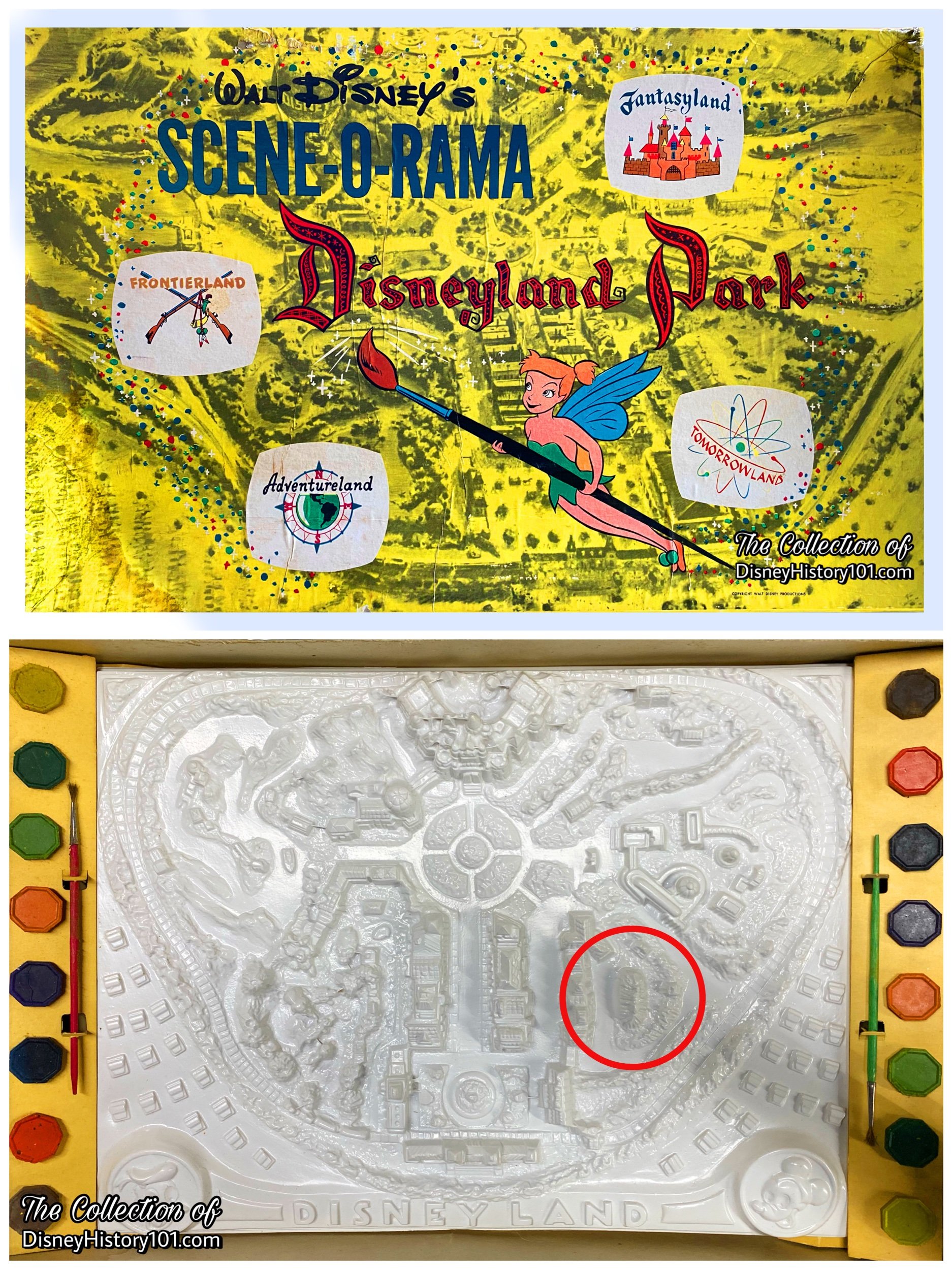
"Walt Disney's Scene-O-Rama Disneyland Park" manufactured c.1955 featured a Circus Tent in this same location.
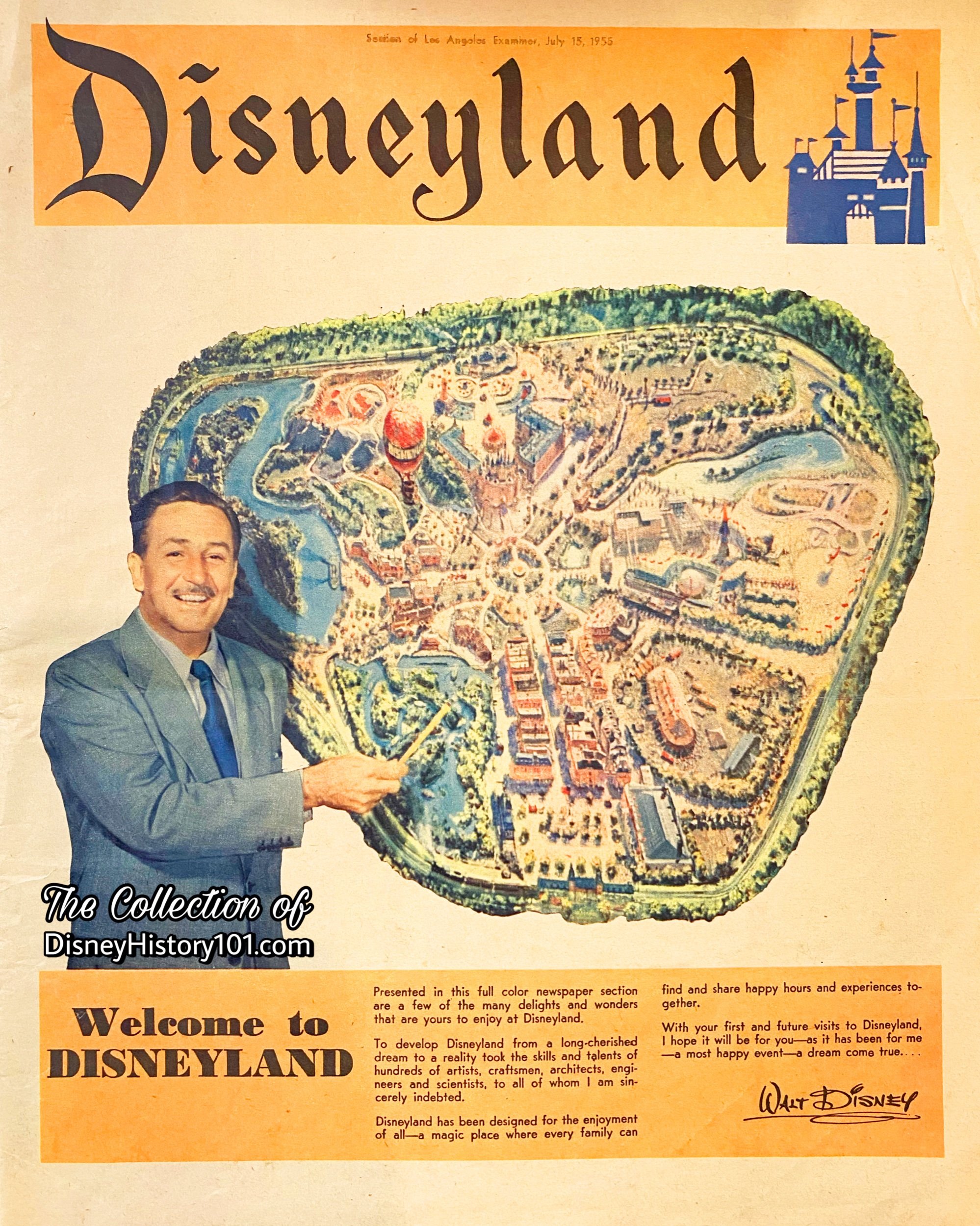
While not mentioned in the pages, Holiday Land (and it’s circus tent) are depicted on newspaper supplement covers (published for July 15, 1955).
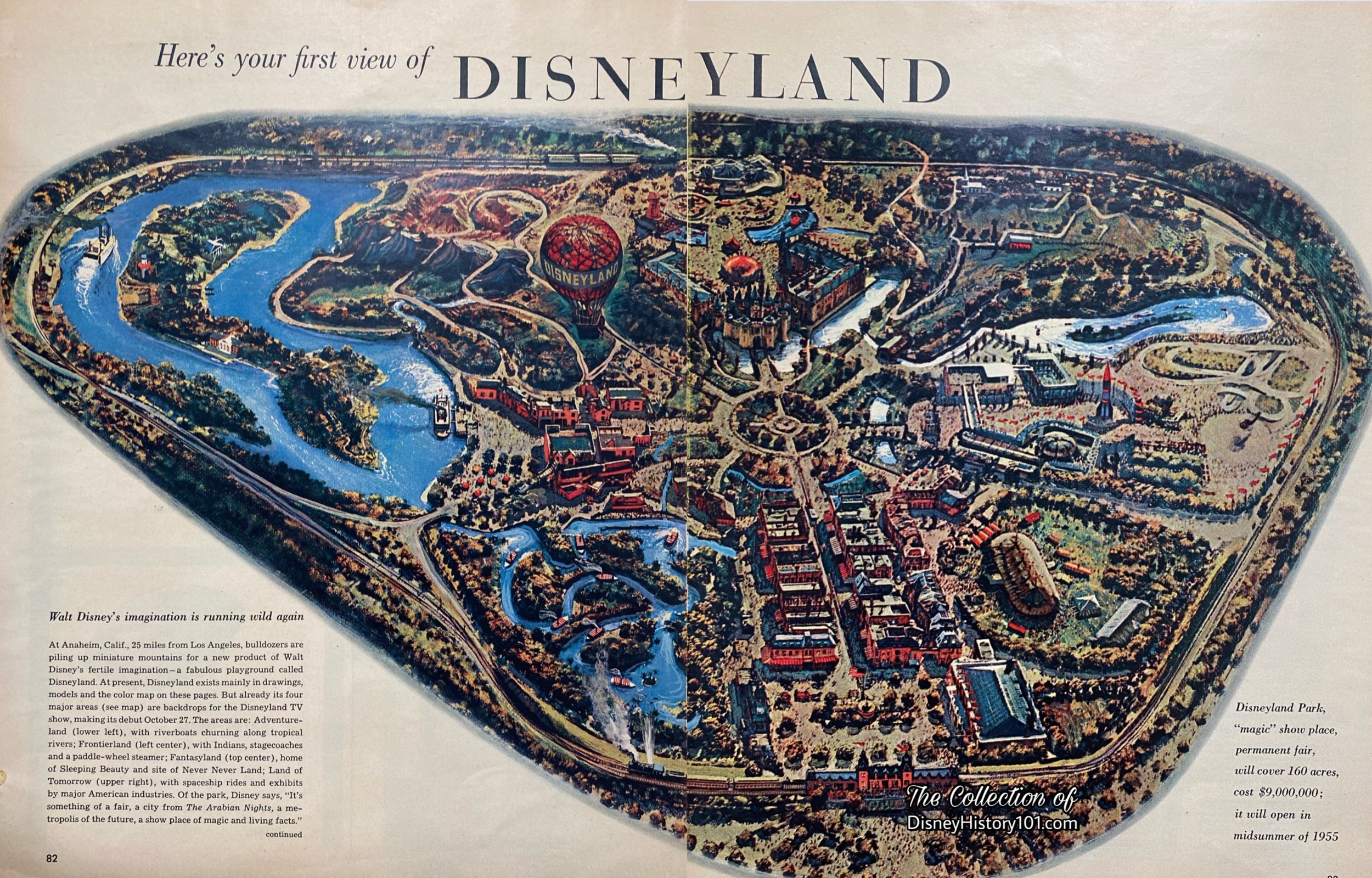
LOOK magazine presented a “first view” of Disneyland as illustrated by Peter Ellenshaw. The areas were depicted but not named in the text.

(November 24, 1955 - January 8, 1956)
“Ev’ryone Loves The Circus - And That Includes The Merry Mouseketeers”
Holidayland (which was originally conceived as “Recreation Land”), would provide a stage for the Mickey Mouse Club Circus (a $30,000 Disneyland addition) that would come to include a veritable “talent roundup” of television’s Mouseketeers as well as top acts from major circuses - all under the world’s largest candy-striped tent! The Mickey Mouse Club Circus was a temporary show which began Thanksgiving of 1955, and ran until January 8, 1956. It was produced by Walt Disney, managed by Ben Chapman, and staged by both Hal Adelquist (co-creator and Associate Producer for television’s Mickey Mouse Club) and Walt Disney Studio “gag artist” and “Big Mooseketeer” Roy Williams! Artistic Direction of this “gaudy and gilded circus of the good old days” was owed to Bruce Bushman, who once (from 1954 to 1955) provided many original concept drawings of potential Fantasyland adventures and attractions (many of which became reality). The diverse and colorful wardrobe was provided by Chuck Keehne.
The big show (which cost more than $300,000 to produce), featured more than 80 animals and more than 70 performers (many of them, children ranging from “ages 8 to 14”), appropriately underneath a circus tent with a 2500 guest capacity! The seventy-five minute show (led by Ringmaster Jimmie Dodd, songwriter and musician of The Mickey Mouse Club television series) had 12 headlining acts. Many of these co-starred television’s Mouseketeers - Sharon Baird, Karen Pendleton, Mike Smith, Doreen Tracey, Dennis Day, Dickie Dodd, Billie Jean Beanblossom, Tommy Cole, Darlene Gillespie (as “Tinker Bell”), Mark Sutherland, Cubby O’Brien, Lonnie Burr, Ronnie Steiner, Judy Harriett, Lee Johann, Johnny Crawford, Bonni Kern, Nancy Abbate, Mary Sartori, Don Underhill, Mary Espinosa, Annette Funicello, Bronson Scott, and Bobby Burgess - for the first time in-person!
The show’s lineup opened with the set of Professor George Keller’s Feline Fantastics, which did not utilize “whips, gun, or chair,” and featured panthers, leopards, Bengal tigers, and mountain lions (among 30 cats). There was Ted DeWayne and his troupe of acrobats and gymnasts performing human pyramids, and the Flying Alexanders. The show’s second act featured “The March of the Clowns” (like Bob-O the Clown of television’s Mickey Mouse Club, or Klinko the Clown and his miniature automobile). The clown act helped set the stage for the “Aerial Ballet” featuring Tinkerbell and Peter Pan alongside 24 Mouseketeers. There were camels, dogs, the world’s only twin baby elephants, horses (like Serenado the musical horse), llamas, ponies, and seals in the “Animal Varieties” act. A Christmas tree rising from the center ring triggered the climax of the show! The “Flying Alexanders” with their breathtaking aerial summersaults and soaring fly-throughs” astounded audiences. The highlight of the show was a procession of pageantry (which would become a Disneyland tradition) - the “March of the Toys” (the “Living Toys” from Walt Disney’s “Babes in Toyland”) and Walt Disney’s characters courtesy of the Ice Capades (including Mickey Mouse and Minnie Mouse, Donald Duck, Goofy, Pluto), and even Santa Claus riding in a sleigh pulled by “matching ponies” in the “Christmas Tree Finale.” All of these acts were performed to music directed by Tommy Walker (son of Vesey Walker, Director of the Disneyland Band). This entire show ran twice daily on weekdays, and three times daily on weekends.
In addition, Walt had a number of “forgotten” antique circus wagons restored for use in pictures, and then brought to Holidayland. The “Souvenir of The Mickey Mouse Club Circus” (published 1955) states, “Taking it upon himself as a public trust, and deserting to perpetuate the happier things of our American heritage, Was searched for and found these original circus parade wagons. Researchers, artists, designers, special craftsmen and wagon builders were enlisted by Walt in his desire for authenticity in their rebuilding. Circus historians and ‘old-timers’ were brought in as consultants. And since Walt Disney believes that any heritage worth bringing back to life is worth putting back into actual use, these circus wagons were put back into service. Proudly they’ll roll again up Disneyland’s Main Street on their way to the Big Top.” Of the cars restored was a “Steam Calliope, a Beauty Wagon, Whiskers Wagon, White Ticket Wagon [featuring ornate hand-carved figures in cameos], the [1890] Swan Band Wagon, the [Barnes Circus] Green Cage [wagon], the Swan and Fawn, and the Shell Cab”, according to the Pasadena Independent (published December 18, 1955). General admission for the grand Mickey Mouse Club Circusshow was just 50 cents, and reserved seating $1.00 (this was of course, separate from Disneyland General Admission). The Mickey Mouse Club Circus was covered in a wonderful 2-page spread full of photos, in The Disneyland News (Vol.1 -No.6 ; published December 10, 1955).
When the Mickey Mouse Club Circus first opened on Thanksgiving Day, there was a parade of the entire cast, led by Grand Marshall Walt Disney (wearing a cowboy hat) and Co-Grand Marshall Fess Parker (dressed in his Davy Crockett duds)! Mouseketeers marched along the route, bearing standards, which introduced the various parade units. The Disneyland Band was piled high inside the Swan Band Wagon, while school bands marched along the route. The sky-blue and gold-accented Beauty Wagon was pulled by six horses dawning red feather plumes on their head. There were elephants, clowns, and the Steam Calliope providing the keynotes of popular melodies and piping white clouds of steam down the route (with engineer in tow). The circus lasted for only a few months, but before being discontinued, the beige Mickey Mouse Club Circus tent, those restored circus wagons, the opening parade, along with a certain tree-topped hill (rising to the east, over Fantasyland), can readily be seen preserved on film, in some aerial footage of “Disneyland, U.S.A.” (a “People and Places” feature film, released in the U.S. on December 20, 1956 through Buena Vista Film Distribution Company). Remember, that the circus was one of Walt’s dreams (seen in Harper Goff’s early c.1951 drawings of Mickey Mouse Park to be built along Riverside Drive in Burbank), and a true labor of love (judging by all the details added to the big show). The popular headlining act, Keller’s Jungle Killers was held over from February 18, 1956 to September 9, 1956. Though this version of Holidayland was dismantled, that wasn’t the end of the red-and-white circus tent, or the Holidayland dream!
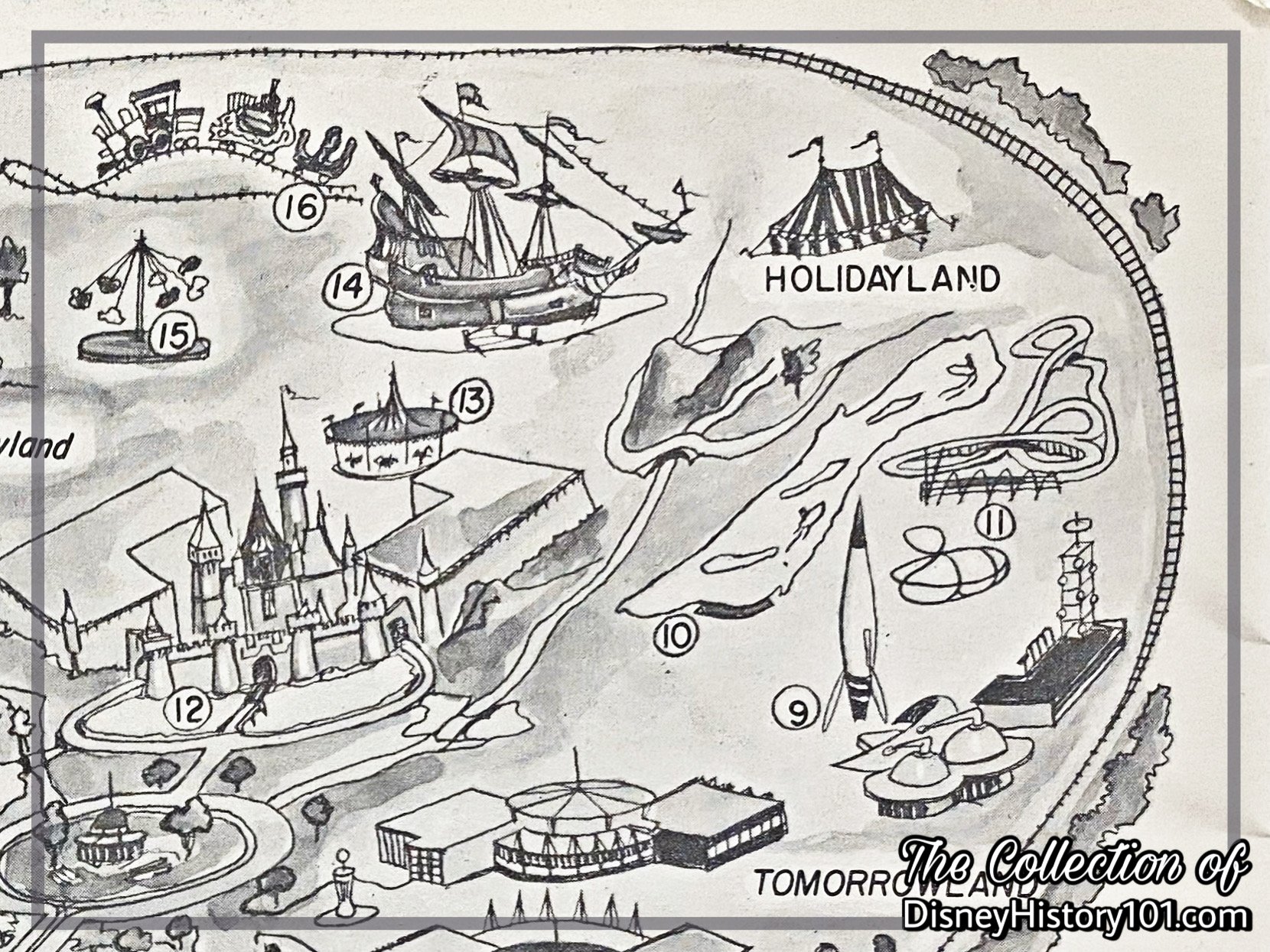
Holidayland and the candy-striped circus tent appear in the Picture Souvenir Book of Disneyland in Natural Color, ©1955 Walt Disney Productions Excerpt.

Santa Fe & Disneyland Railroad Train Tickets, (c. 1956 - 1957)
Santa Fe & Disneyland Railroad tickets would have allowed passage from Fantasyland to Holidayland (in its early incarnation), and from Holidayland to Tomorrowland. According to “The Nickel Tour,” “In the early days, train passengers needed a separate ticket for each leg of the journey! This ticket was apparently printed before the Park opened, as it features a Holidayland Station that was never built!”
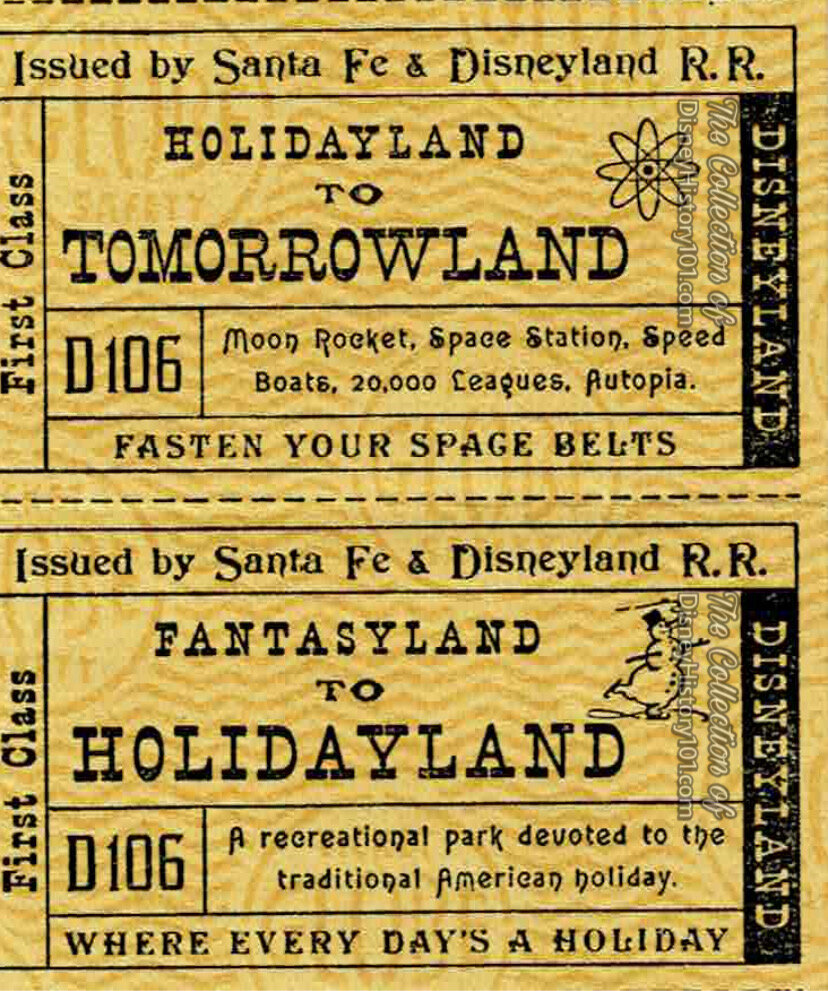
Santa Fe & Disneyland Railroad Train Tickets, (c. 1956 - 1957)
“Albright’s Bright Idea & The ‘Traditional American Holiday’”
Holidayland (in its final and most memorable realization) may have partially been the brainchild of Milt Albright (Missouri native and Walt Disney Studio Payroll Department Junior Accountant, since c.1947), but it wasn’t the first time he was affiliated with a conceptual idea for Disneyland. During 1953, Disneyland was being conceived and Milt created a miniature car for the Autopia, which was also in progressive stages of development at the time. Though Walt was unimpressed with Milt’s car (the design lacked brakes), he was impressed with Milt’s innovation. Walt soon hired Milt as a Disneyland Manager of Accounting, during the spring of 1954.
Soon, Milt became affiliated with the Disneyland Public Relations Team, and as plans for Disneyland’s expansion were being discussed, he became involved in yet another project for the Park. Now, many of Disneyland’s aspects saluted Americana - from the Mississippi sternwheeler navigating the frontier rivers of America to the soda fountain and pharmacy of its turn-of-the-century Main Street U.S.A. Milt’s next project (which was in stages of concept, research and development), was an entire new Disneyland land - “a recreational park devoted to the traditional American holiday”!
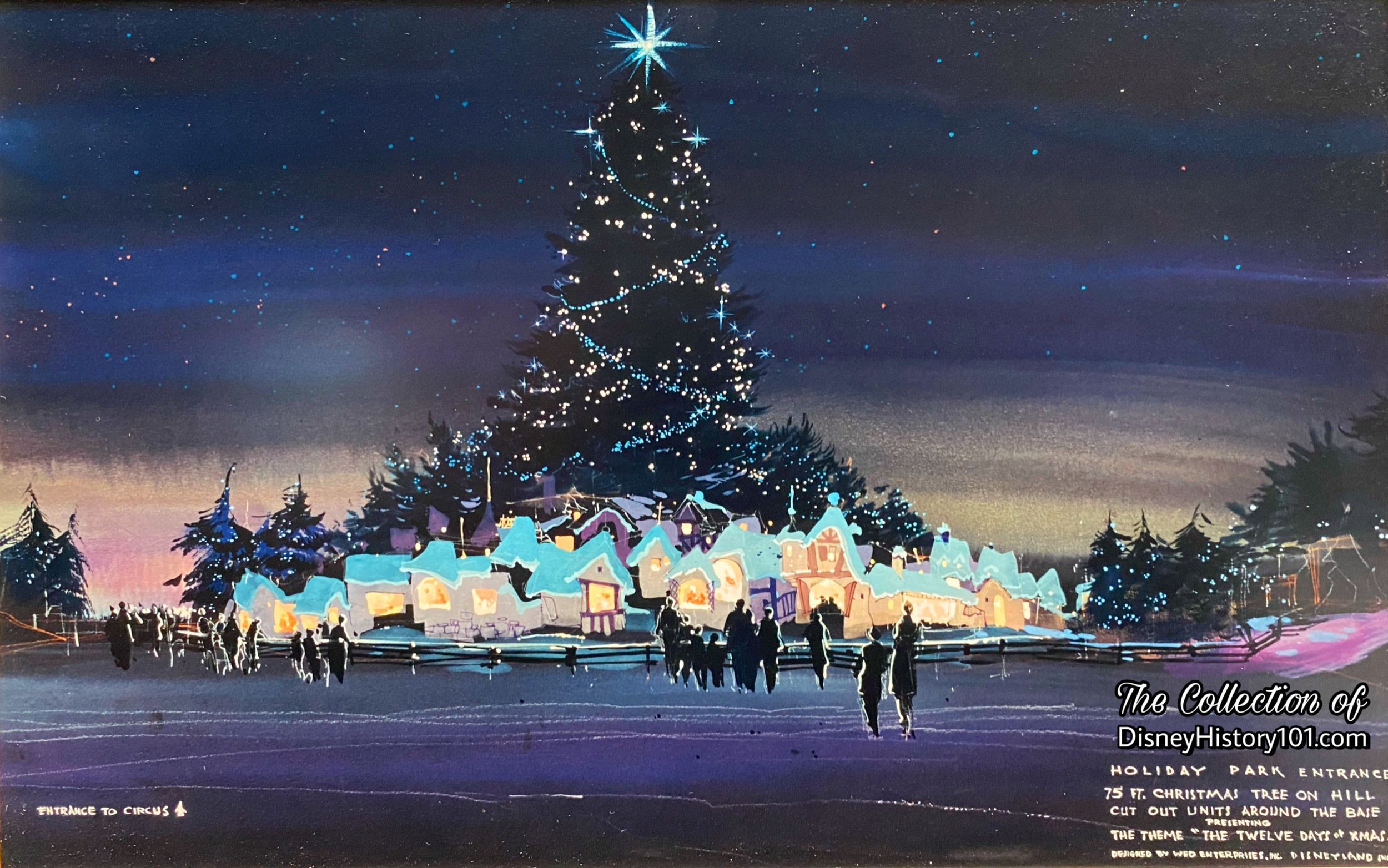
Note the entrance to circus in this “Holiday Park Entrance” concept by Herb Ryman; WED Enterprises, Inc. & Disneyland, Inc.
It is perhaps at this time, that Herbert Ryman created one of the last “Holiday Park Entrance” concept drawings of Holiday Hill inside Disneyland, featuring a 75-foot Christmas Tree (prospectively for the future winter season of 1957). During this time, Dick Irvine (chief art director) and Emile Kuri (set designer) were put in charge of seasonal decorations at Disneyland by Walt.
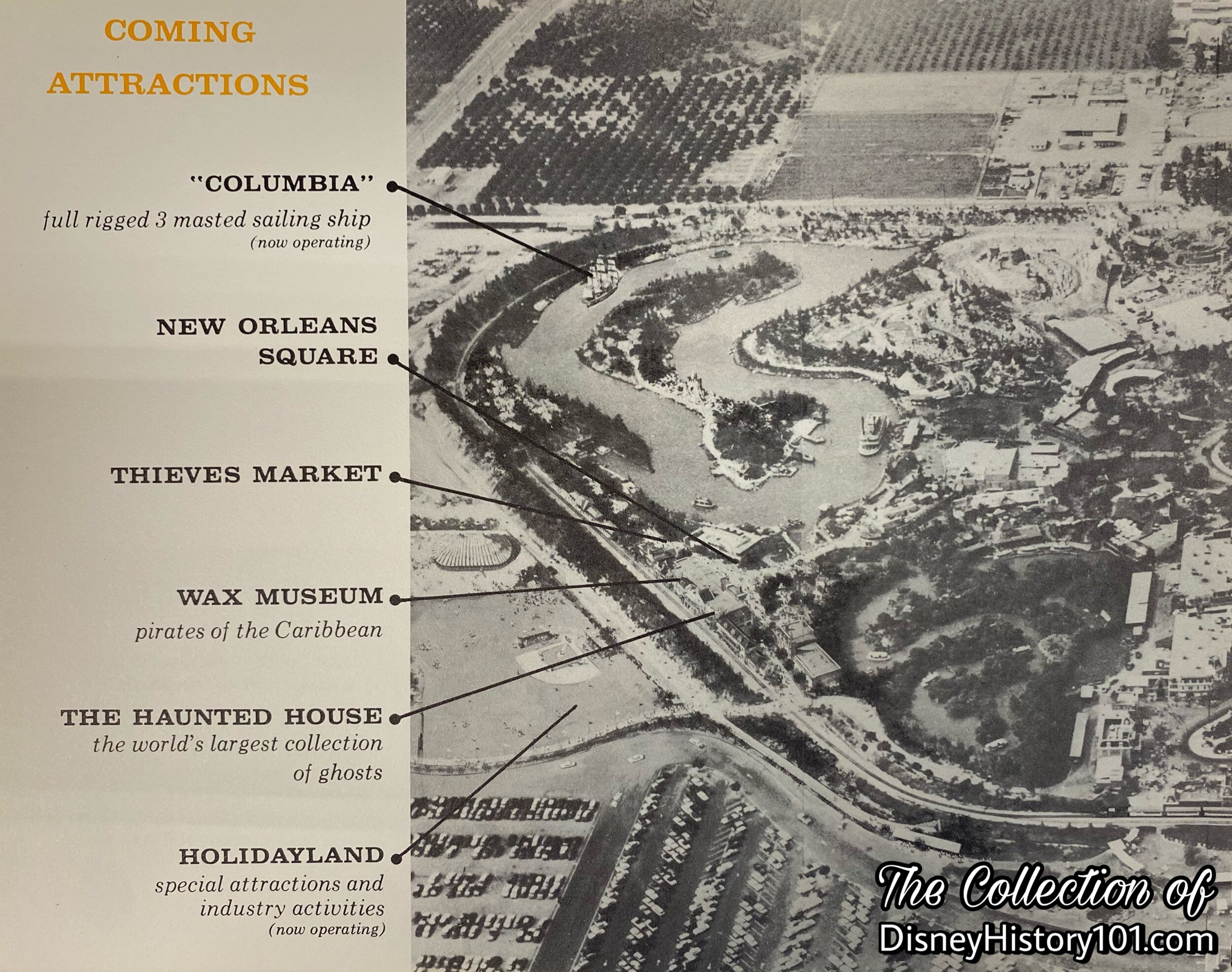
Excerpt from “Disneyland U.S.A.” (Published 1958)
Yes, during Disneyland’s fabulous first decade, many new attractions opened to the public including an entire new “land”! This new “land” was created and designed with audiences in mind, “to accommodate requests for large organizations, principally industry,” and under the direction of Disneyland University Founder and Chief Emeritus Van France. You see, during the summer of 1956 the very first “Day at Disneyland” events were attended by the employees of some 250 Industry Groups in California which had joined the Industry Plan. Some members of these had made some form of “requests… for a special event area to hold picnics, parties and meetings.” [“Disneyland, U.S.A.” published 1958]
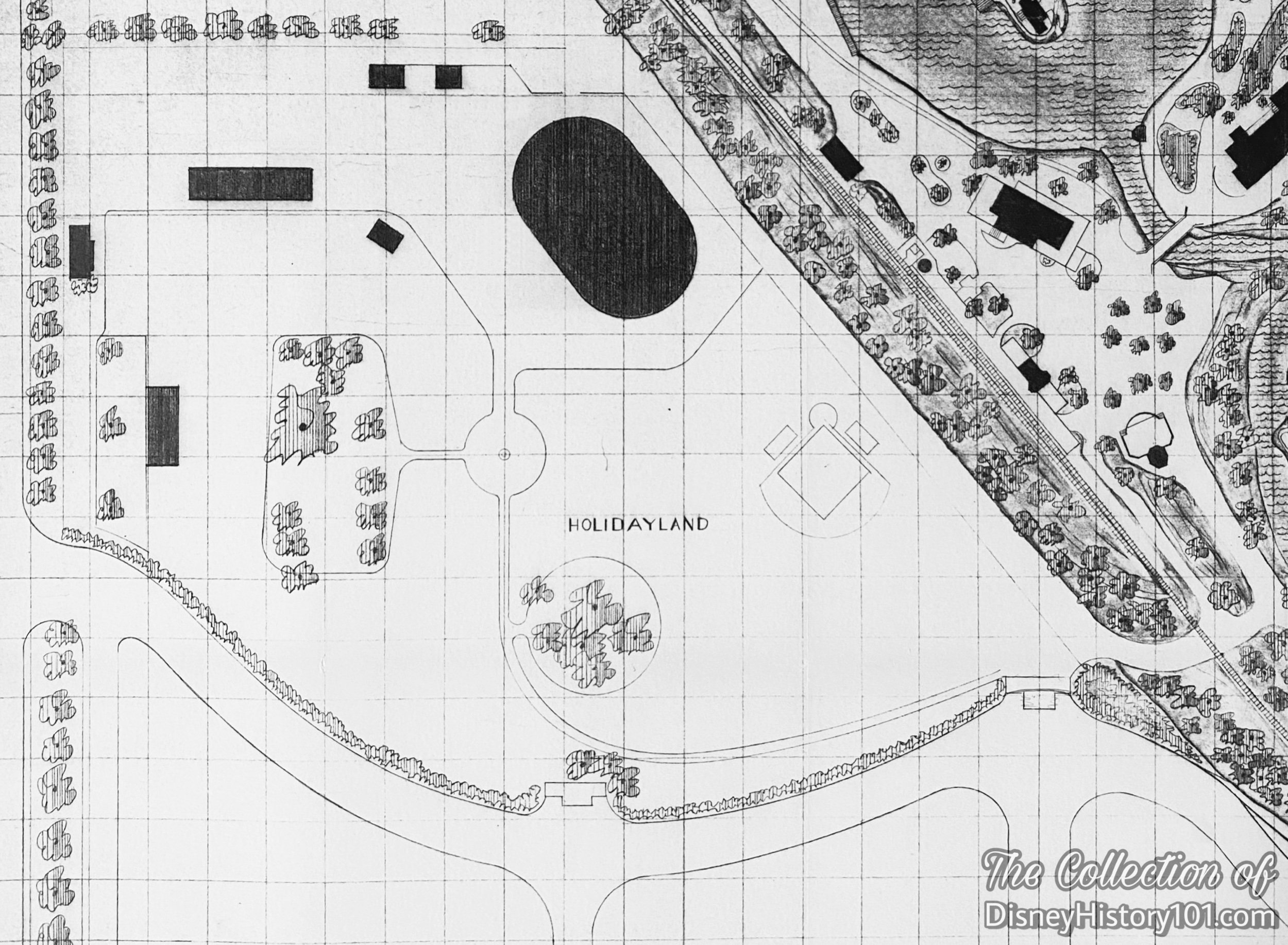
Holidayland as depicted on a Disneyland Plot Plan designed by WED Enterprises, Inc., c.1957.
Now, at that time Disneyland was surrounded by a sufficient amount of acreage to accommodate future growth. Drawings suggested for new “land” were developed for an area encompassing a western portion of the Parking Lot and other land between Disneyland’s western Berm and West Street. Yes, work on the “Picnic Area” was moving forward by the spring of 1957, according to a WED Incorporated Inter-Office Communication to Walt from Dick Irvine (dated March 12th, 1957). “Bill Martin has a schematic ready for discussion. Myrt Westering is working on the plans for the catering building and the self-service refreshment building. The area has been completed grading will start Wednesday, March 13.”
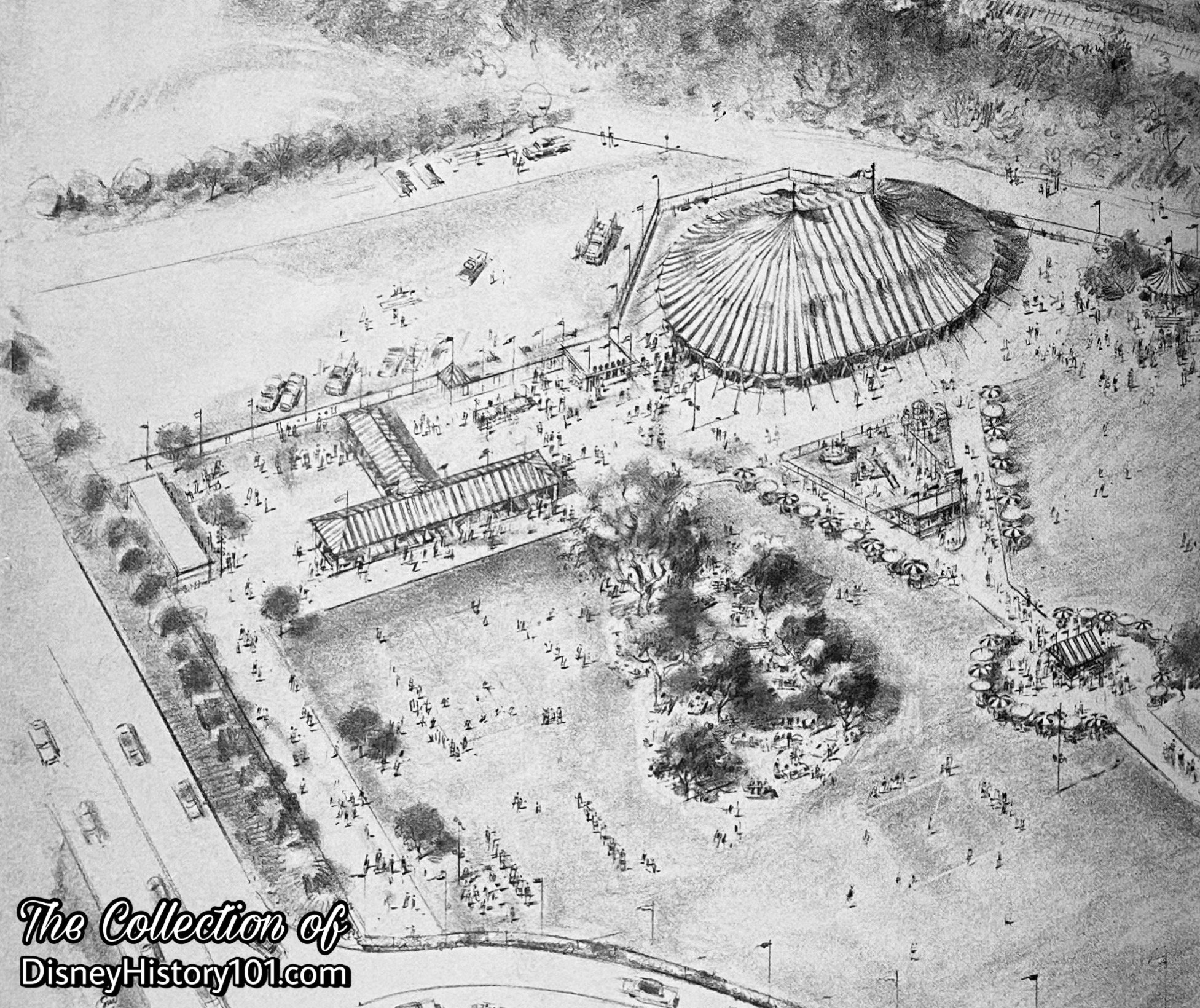
An excerpt of Sam McKim Holiday Land artwork.
Van next appointed Milt Albright Manager of Holidayland, over a Holidayland Picnic Committee of Disneyland employees. Many of the Vintage Views (below) are excerpts from contact (proof) sheets once belonging to Milt Albright.
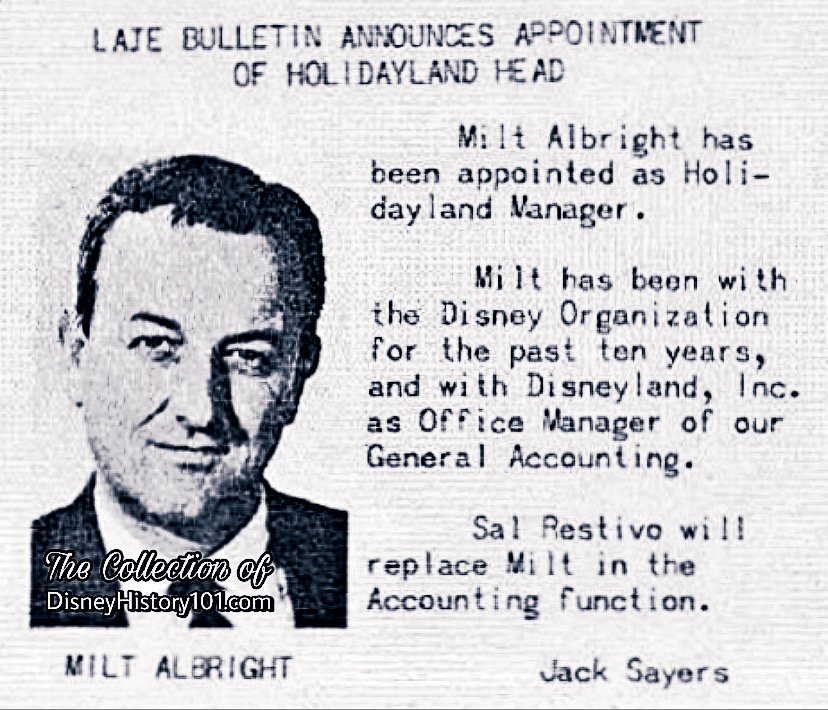
"Disneylander" Excerpt, May of 1957, page 8 announces the Holidayland Head.
According to the “Disneylander” (May, 1957), the Holidayland (or, “Holiday Land”) Picnic Committee came to include “Bill Stewart, Van France, Howie Vineyard, Cap Blackburn, Bob Carbonnel, Tommy Scheid, Bob Reilly, Barbara Bray (Secretary), Marty Sklar, Jack Sayers, Dick Stovall, Tommy Walker, Ray Webster, Earl Shelton, and Larry Tryon.” This team had such a fantastic set of skills to support Holiday Land. For instance, before Disneyland, Jack Sayers had previously been with the original Gallup Poll, performing studies for Walt’s movies and was west coast manager of LOOK Magazine when he was hired by Walt. Van Arsdale France was hired by C.V. Wood in July of 1954 to help with hiring.
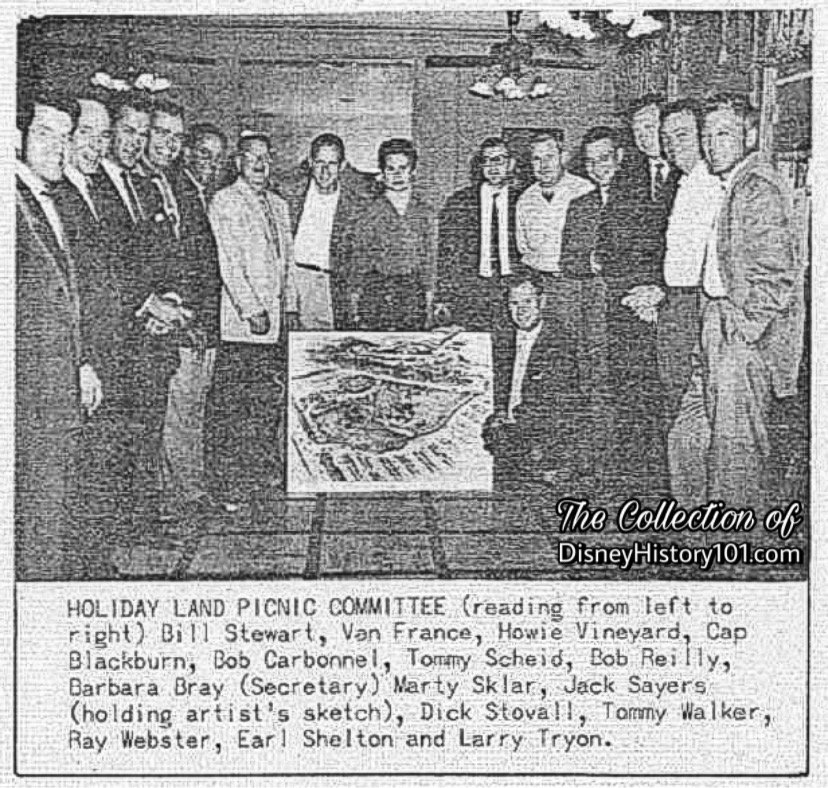
The Holiday Land Picnic Committee is announced and photographed with Sam McKim’s concept art for the "Disneylander," May of 1957, page 8.
(The photo above may have been shot inside the old Brown House on West Street, Youth Activities & Holidayland Headquarters)
Contemporaneous postcards described Holidayland as “a new concept in facilities for group activities,” while brochures called Holidayland a new area “devoted to the traditional American holiday.” Here was a group activities center for company picnics, dances, conventions, and special events. Guests usually enjoyed activities and games, softball, volleyball, dancing, horseshoes in the pits, a children’s play area, and picnicking in a shaded picnic area. Holidayland was open daily (at 10:00am) and parking for Holidayland guests was generally free. Reservations and general information about Holidayland could be acquired through the Disneyland Group Sales Department (extension 437), and calling them through either Disneyland KEystone 3-4456 or MAdison 6-8605.
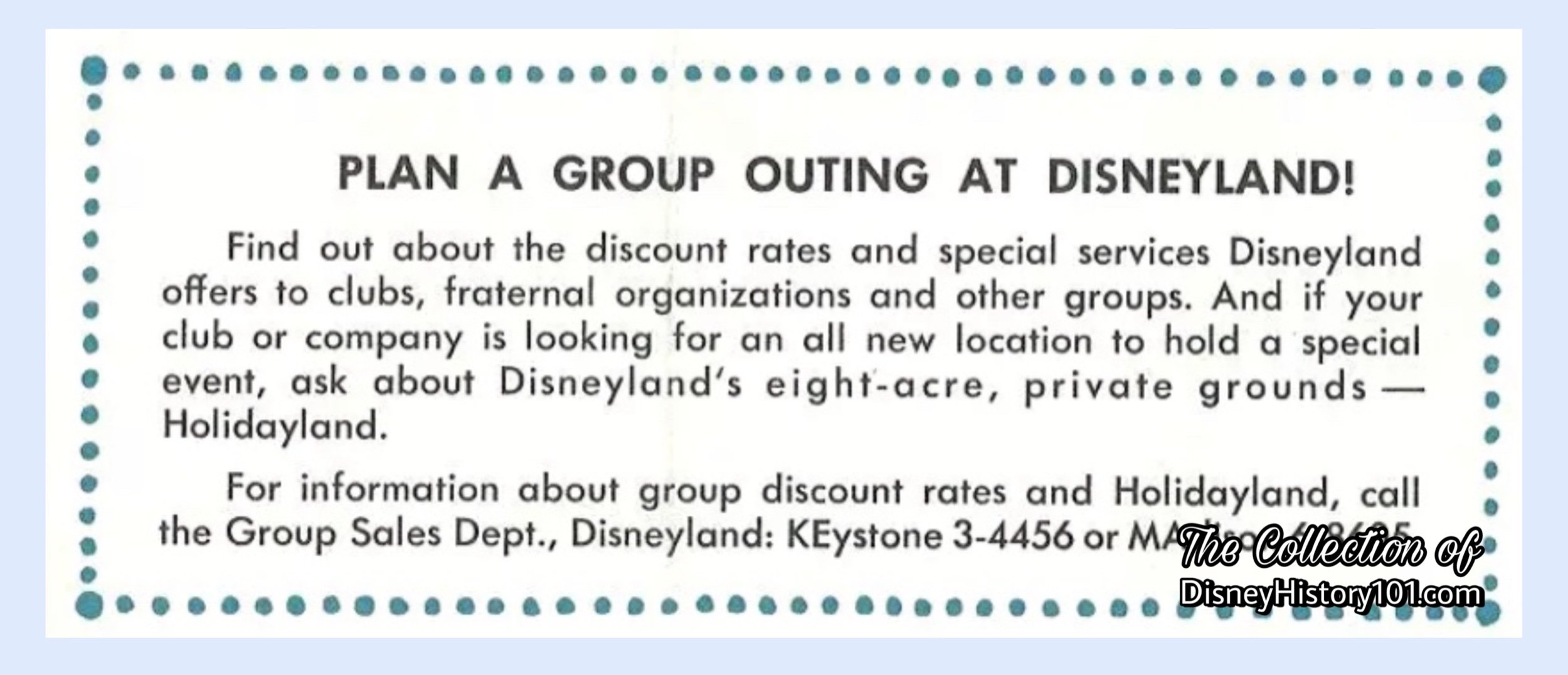
Holidayland had its own picnic planning services.
Reservations and Information regarding the use of Holidayland facilities could be obtained from Group Services of the Public Relations Division.
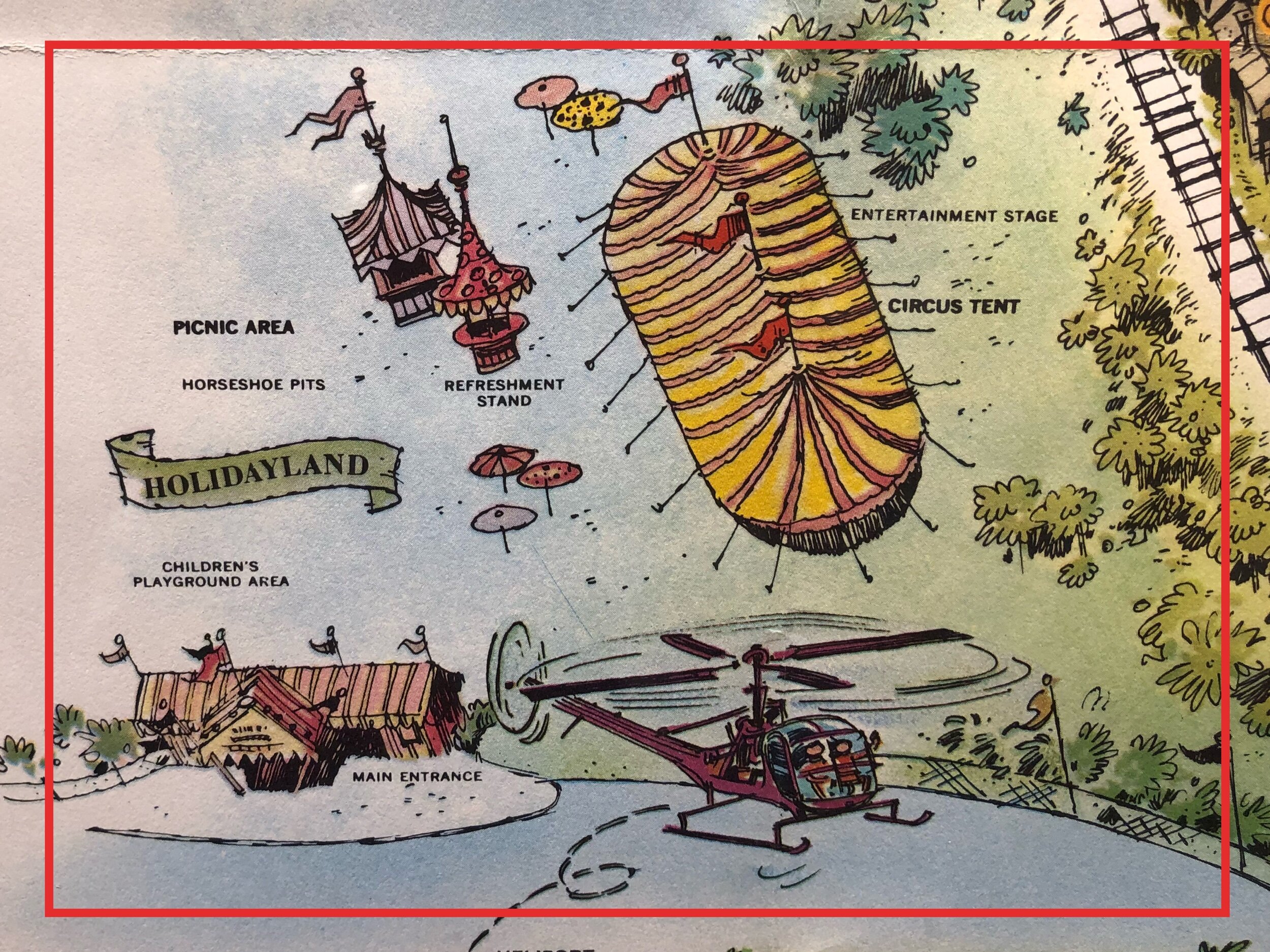
Holidayland as depicted on the Sam McKim Disneyland Map (Excerpt), c. 1961-1962
“Every day’s a holiday in Holidayland!”
Disneyland Map excerpts give Guests an idea of what to expect in their visit to Holidayland. First of all, Holidayland (though a land itself), was never accounted among Disneyland’s other cardinal five lands. In fact, Holidayland was its own separate entity (located outside the berm), and even had its own entrance and separate admission (as we will see).
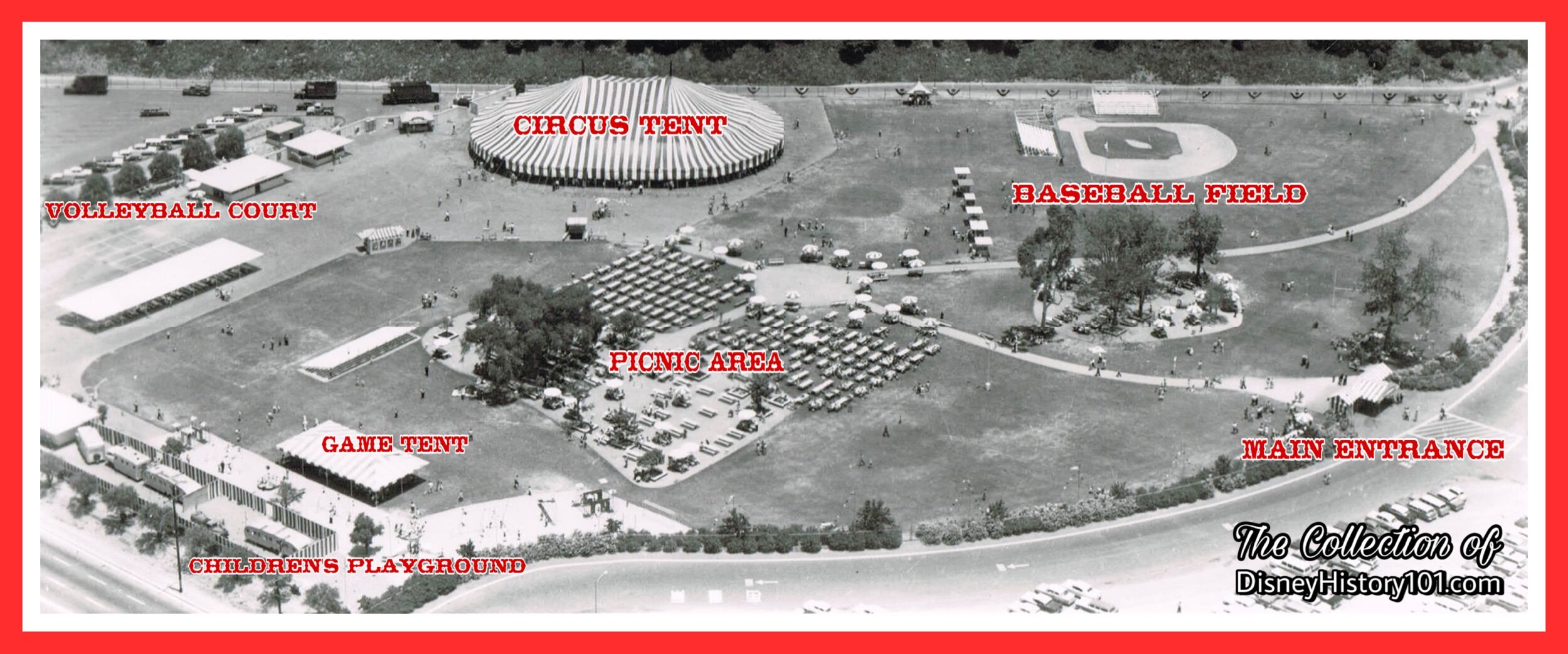
Holidayland Aerial, c. 1959.
The presentation of the Holidayland show on the vast DISNEYLAND “stage” was a distinct part of the Disneyland theater concept. While the Amusement Area of Disneyland covered sixty-five (65) acres (by 1959), Holidayland was (9) acres of completely fenced-in, landscaped grounds. Once through the Holidayland Main Gate Entrance (located on the southern side of the park), Guests found that Holidayland had two “lands” of its own - beyond the Baseball Field (and bleachers) sat two “Picnic Areas” and a “Circus Tent” and an Activity Tent (or, “Covered Pavilion,” typically seen utilized for board games and games of BINGO). Beyond the Shaded Picnic Areas were several attractions including a Children’s Playground Area (along the west) with the newest, specially designed and exclusive children's playground equipment. The playground was near the Restrooms and an Office Building, Horseshoe Pits (with equipment supplied by Holidayland), and Refreshment Stands (a Self Service Food Building, a Snack Stand and Dinner Service Building, Snack Stand #1, and Snack Stand #2 offering coffee, soft drinks, and yes, even beer). On the other side of a large lawn, sat “the world’s largest candy striped” Circus Tent featuring a Band Stand and Stage where events (pageants, contests, and band performances) were held. There was also “modern restrooms and first aid facilities… a super market type refreshment stand, [and] a fully equipped public address system.” [Disneylander, May of 1957] The First Aid Tent had its own extension (296).
You may notice Mickey Mouse Club Circus wagons scattered around Holidayland in the subsequent photos. Paved sidewalks lined with benches and a few lamps, connected these major attractions.
Holidayland also had men’s and women’s restrooms (located in separate structures on the North side of Holidayland), telephones, and plenty of garbage receptacles for guest’s convenience. In case of low pressure, water was provided by a pre-existing gasoline-powered pump located at the east end of a meter pit on the property.
All of Holidayland was located just on the other side of landscaper Bill Evans 20-foot-tall, raised, dirt berm. Owing to the perimeter around Disneyland, the guest activity of Holidayland was concealed and did not infringe upon the realms of Frontierland and Adventureland.
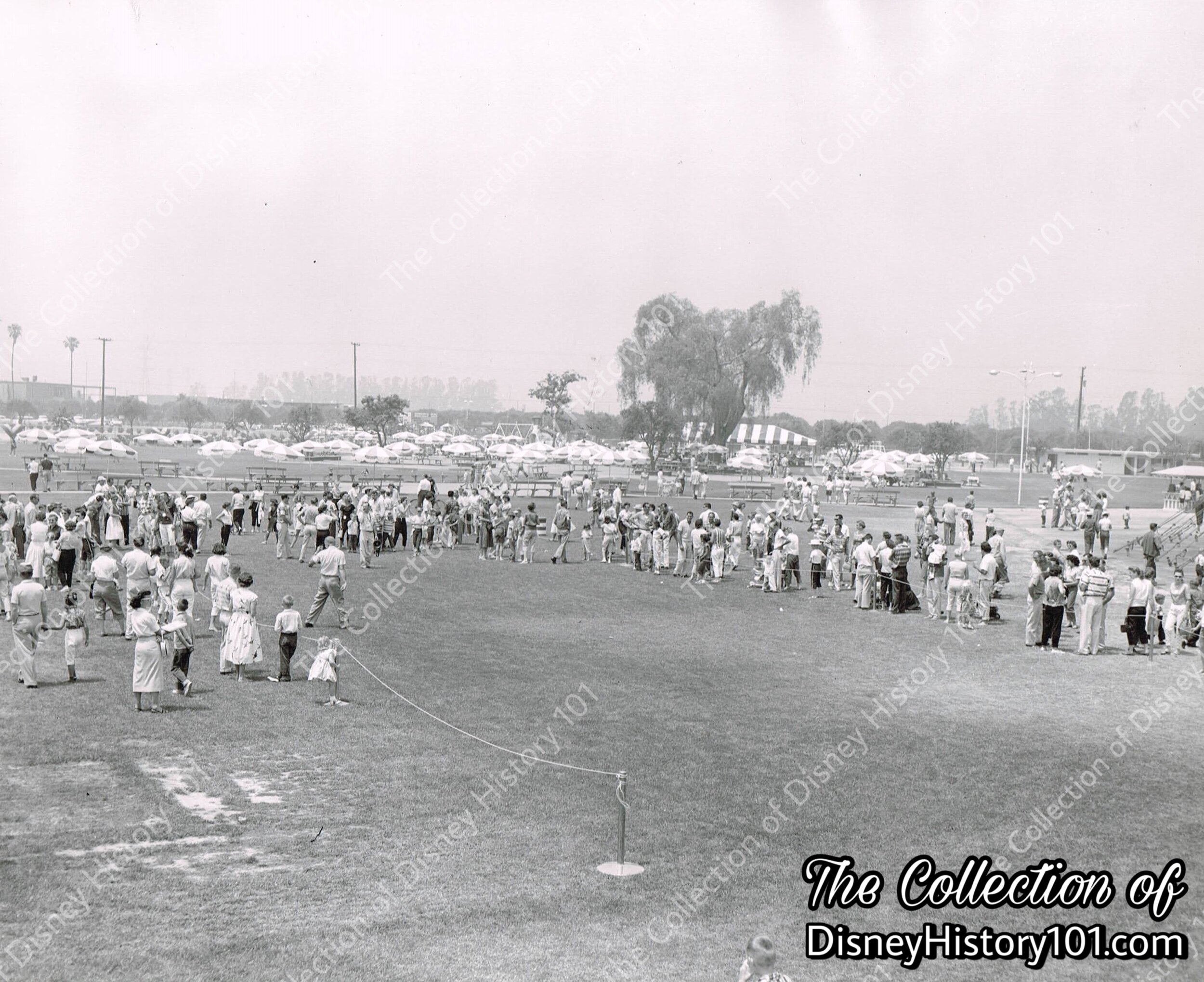
Holidayland, c. 1957
The vast area of Holidayland was described as “Disneyland’s eight-acre, private playground” though it was actually 9-acres (that is 36,000 m2). The sheer size of Holidayland simply can’t be comprehended on a Disneyland novelty souvenir map. However, it can be somewhat understood in this captured memory from a Telco Division Picnic. Due to the wide open space, up to 7,000 guests could visit Holidayland at one time. In the foreground, guests assemble for an epic race near a roped-off area. Despite the “Disneylander’s” promise that “with these facilities, it is not necessary to have the traditional fat man’s race, the three-legged race, and other games which are sometimes hazardous,” race competitions of this type were still popular and held at Holiday Land. At the time, anyone inquiring about holding a special event at Disneyland’s “private playground” need only “call the Group Sales Dept., Disneyland KEystone 3-4456 or Madison 6-8605.”

Excerpt from “Disneyland U.S.A.” (Published 1958)
“Corporations & Organizations Salute ‘the Great American Pastime’”
One of Holidayland’s very first scheduled organized group picnics was for the Los Angeles Elk’s Lodge #99, occurring on the same day that the dedication of Holiday Land occurred, on Sunday, June 16, 1957. This was less than two years after the opening of Disneyland. A total of 5000 members and their families attended the event, challenging Holidayland’s Guest capacity capability.
Walt welcomed Guests: “It is with the greatest pleasure that I welcome you to Holidayland,” said Walt Disney, “where the guiding spirit is - FUN!”
“‘I remember the first picnic only too well,’ “55er” Milt Albright recalled. ‘There was only one small restroom for the ladies and one for the men. The wait for the ladies’ room was one hour long. I'll never forget the look of disbelief, shock, and dismay on Walts face as he came up to survey the incredible sight… the longest queue line in the Park, the ladies’ rest room.’ To this day, Milt has a photo of himself with Walt, taken by a staff photographer as Walt surveyed the line. Oh, the look on Walt's face.’ So out came the "Honey Wagons," movie studio lingo for the portable restrooms used on location filming. The trailers were lined up along the west side of the picnic grounds, and soon brought the situation under control.” [The Nickel Tour]
Arrangements were “proceeding rapidly for the bookings of other large group gatherings during the summer months.” [Disneylander, May of 1957] A variety of scheduled events ensued, including “Disney Studio Day at Holidayland and Disneyland” (held on Saturday, October 5, 1957). Brief footage of some of the event’s features & activities (Balloon vendors, the Potato Derby, Pie Eating Contest, and Bobby Burgess & Doreen Tracy’s Mouseketeer performances) have been amazingly preserved on film in the “An Adventure in the Magic Kingdom” episode of Walt Disney’s Disneyland (airing in 1958)!
Though we can’t recall any of the dates they were held, Bob Penfield (Supervisor of Disneyland Construction Services) fondly recalled “Holidayland and the [Disneyland] employee salaried vs. hourlies football games” played here. Another Disneylander Ben Harris remembered what he called the Holiday Land End of Season baseball games played here, from about 1958 to 1963. Ben described “Disneyland’s Supervision Team - Nunis, Reilly, Conk, Ater, Penfield, Sully, Hoelshire, Harris, etc. versus the Parking Lot Champs.”

Though technically on Disneyland property, Holidayland was actually a separate recreational park (located outside the berm), with its own separate admission, and its own Main Entrance turnstiles. Guests of Holidayland entered thru the candy-striped Holidayland Main Gate, located on the west side of Disneyland, near what is now a complex of New Orleans Square show structures. The Holidayland Main Gate held two windows often utilized for ticket sales and distribution (see photos below). When these windows were not in use, they were concealed by doors featuring Disneyland attraction posters. Owing to the fact that Holidayland was often rented for events, the names of the rentees (often clubs, families, companies, and fraternal organizations) were featured on the letter board over the entrance.
In the following Holidayland Main Entrance Vintage View section, notice the organizations and corporations that made use of Holidayland, when their names appeared on the marquee over the Holidayland Main Entrance Gate (from 1957 to 1961)! Note memories of numerous organizations, like the Local International Brotherhood of Electrical Workers, the Southern California Gas Company, Crane Company, U.S. Junior Chamber of Commerce (“Jaycees”), and many, many more are represented in the gallery. Even rival Warner Brothers Studio rented Holidayland for at least one corporate picnic during the late 1950s.
Guests could enter Holidayland as a singular guest. Guest admission for Holidayland during the summer of 1960 was was $1.20 (Established Price, $1.18 plus Federal Tax 2¢) for Adults, and 20¢ for Juniors.
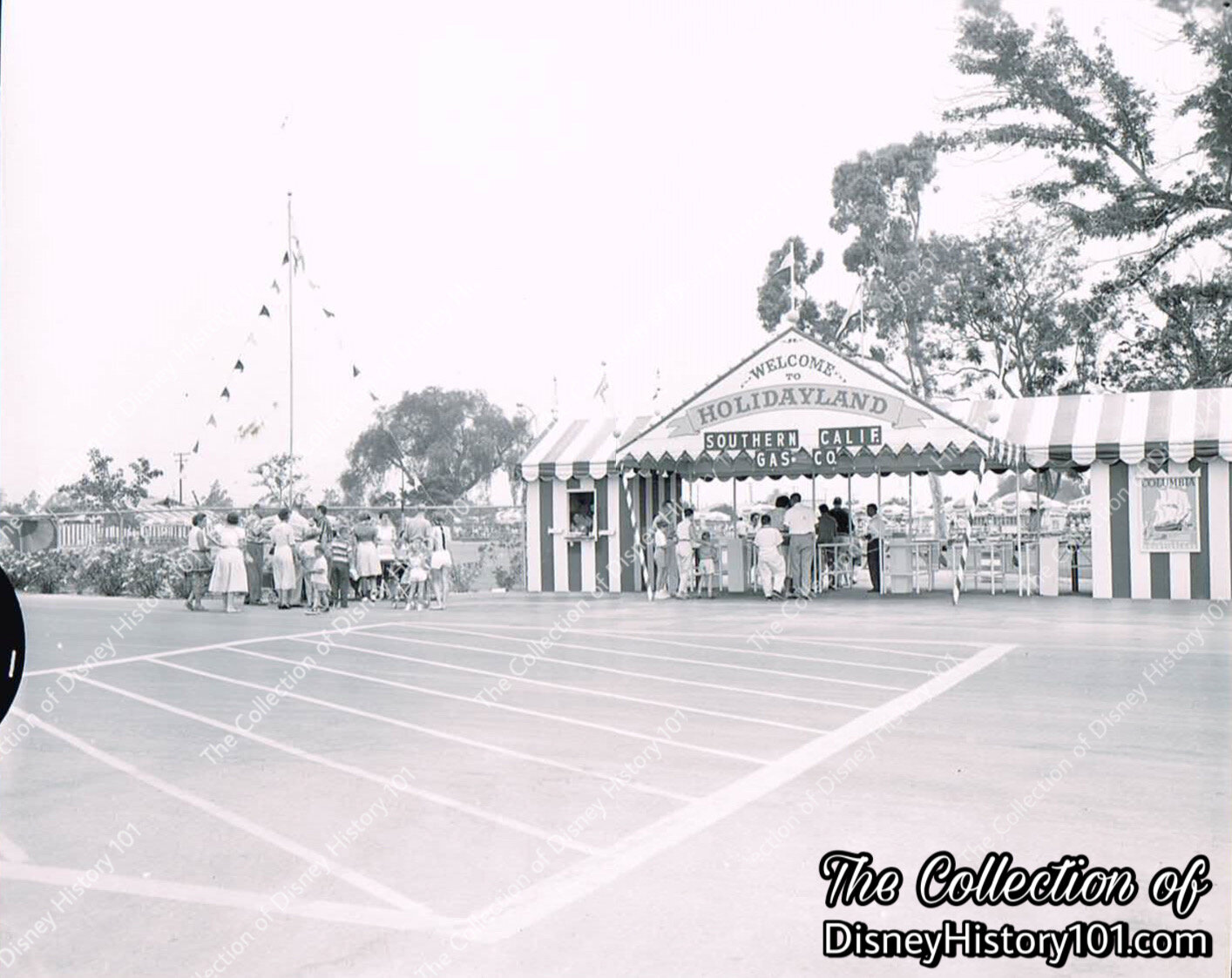
Holidayland Main Gate, c. 1957
The Holidayland Main Gate decorated for the Southern California Gas Company Party. Since Opening Day of Disneyland, the Southern California (Counties) Gas Company provided clean and economical gas to Disneyland’s modern automatic attractions, and ultra-modern cooking appliances to its dining destinations.
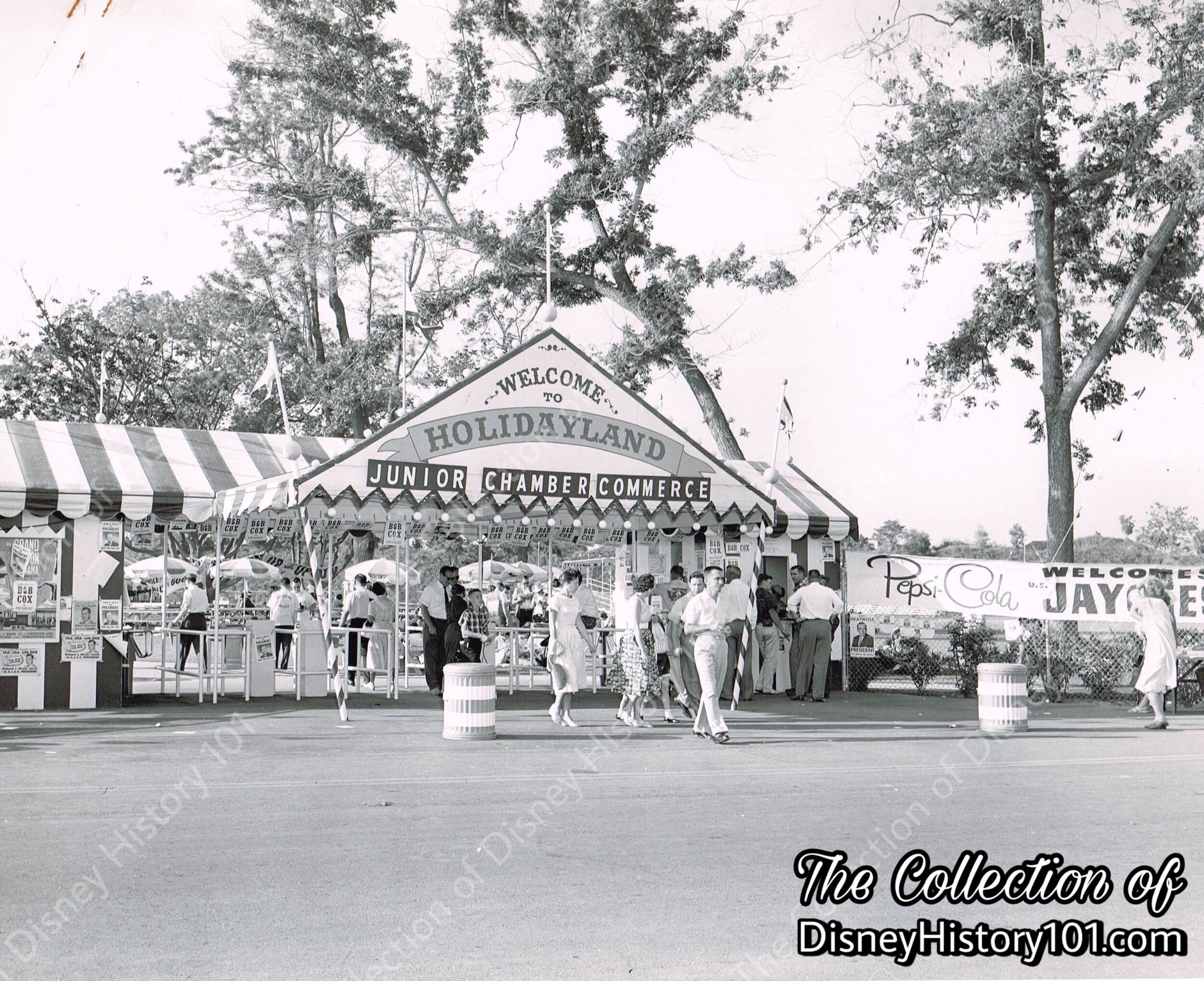
Holidayland Main Entrance, c. 1957
The U.S. Junior Chamber of Commerce (“Jaycees”) rented Holidayland to hold a pre-election party sponsored in part by Pepsi-Cola (the very same sponsor of Slue Foot Sue’s Golden Horseshoe Revue). Election bills of Richard Lynch and Bob Cox were posted over the entrance and Disneyland attraction posters on the sides of the Main Gate. You won’t see this done in very many of the subsequent photographic documentation.

Holidayland Main Entrance (decorated for the U.S. Junior Chamber of Commerce Event)
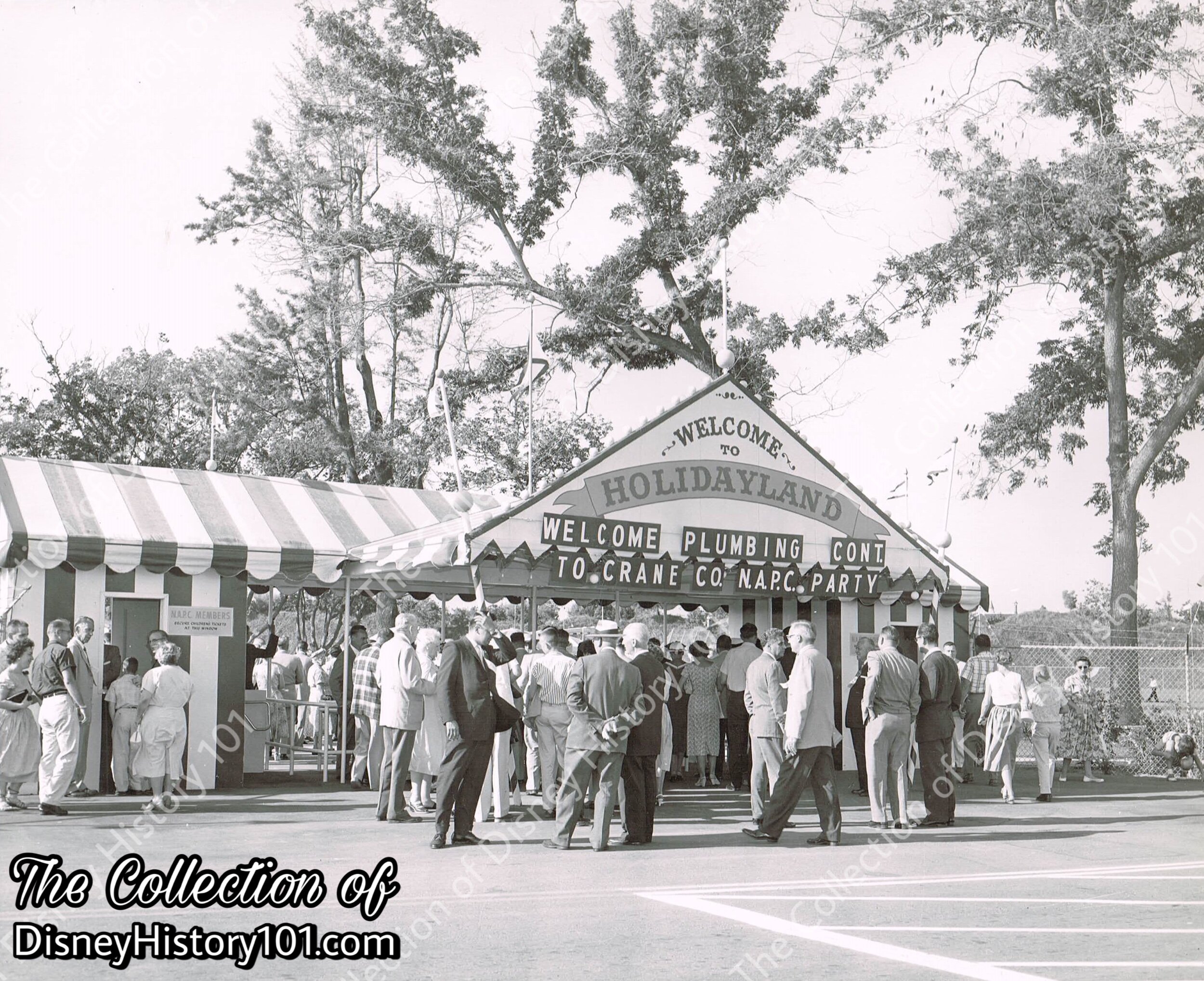
Holidayland Main Entrance, c. 1957
You may recall that Crane contemporaneously sponsored the Tomorrowland Bathroom of Tomorrow exhibit (with its operable Flying Saucers and Industrial Flow displays). Now, the Holidayland Main Gate is decorated for the Crane Company Party, as employees flock through the turnstiles.
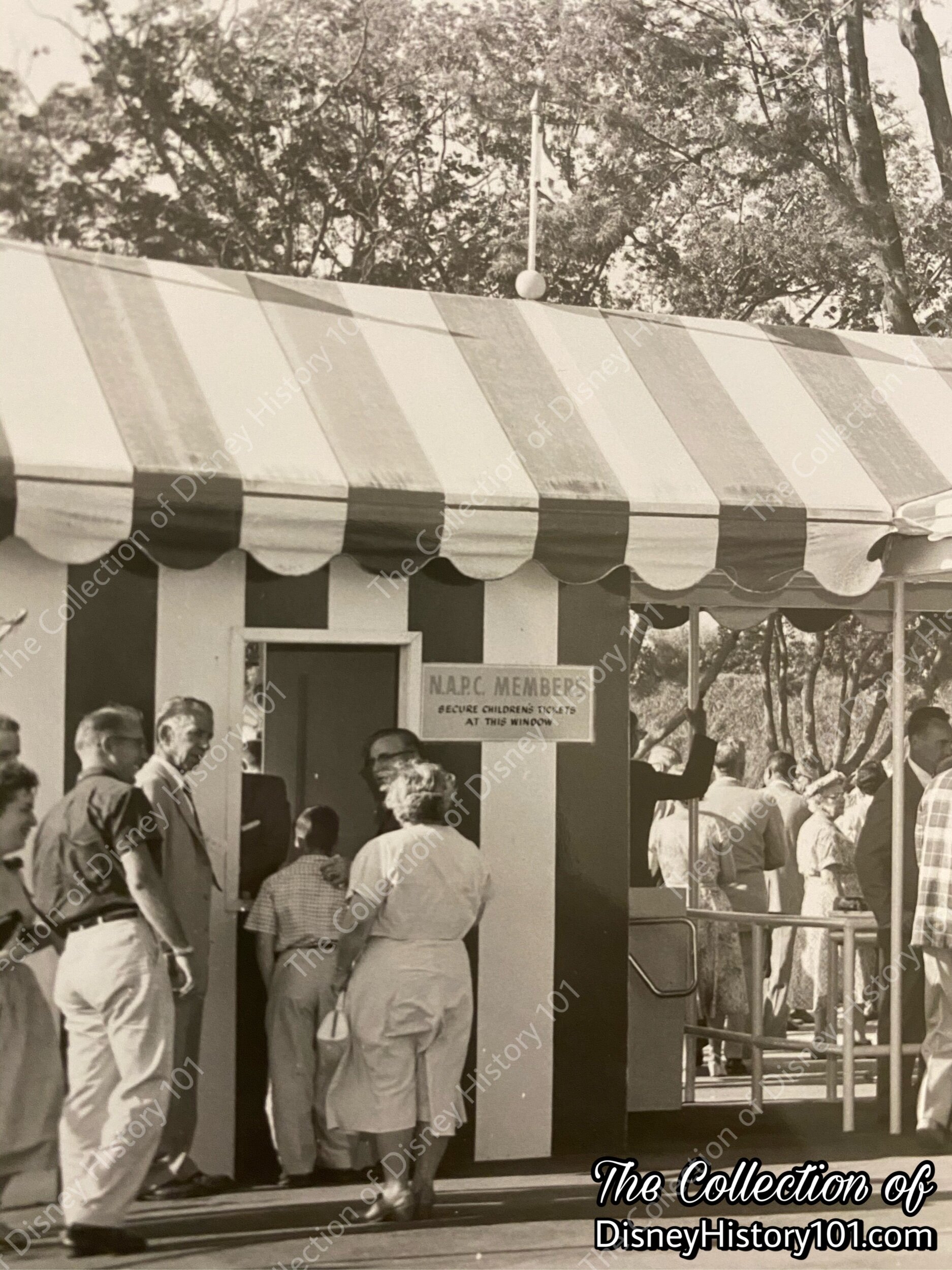
The side entrance is utilized for the N.A.P.C. event.
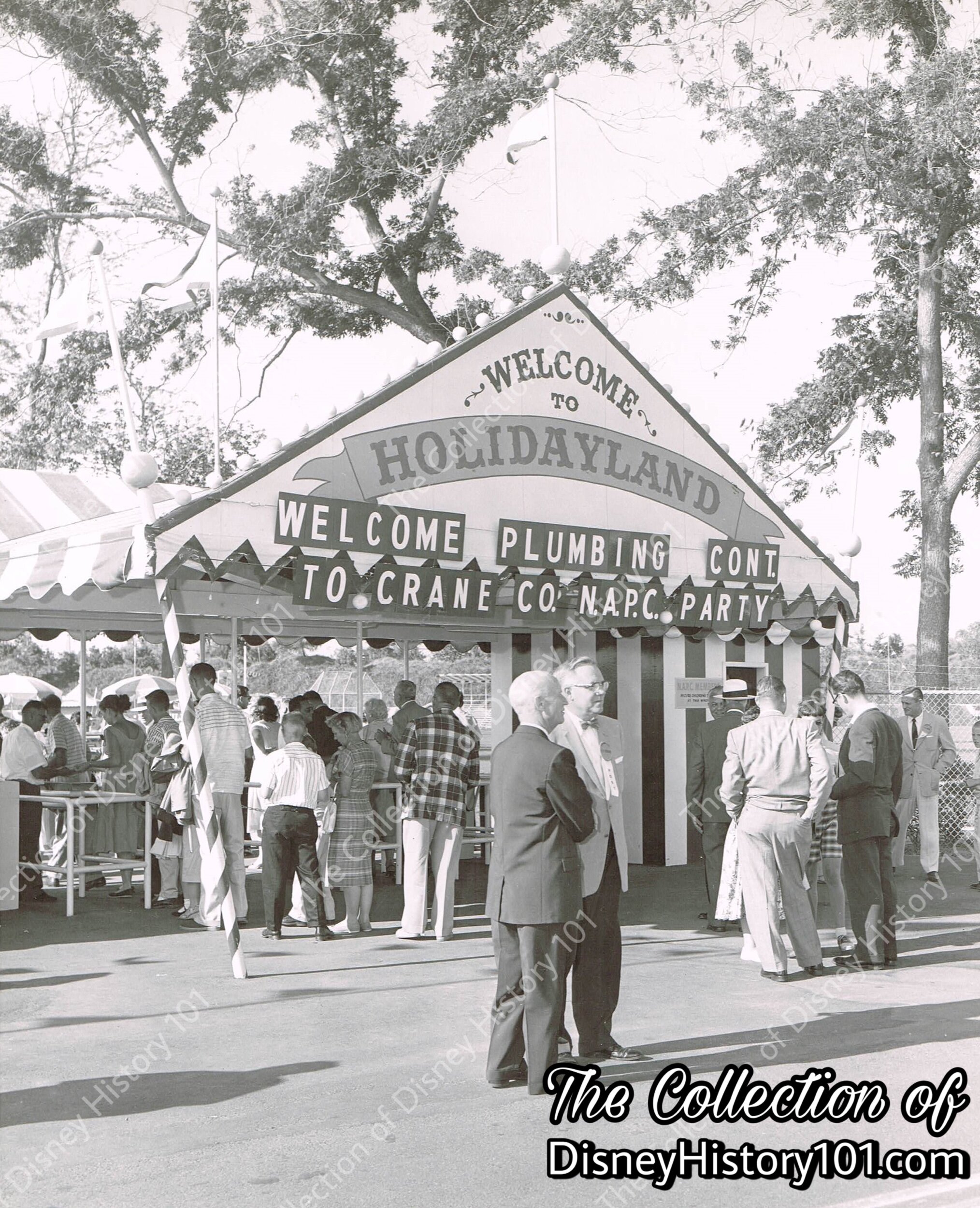
Holidayland Main Entrance, c. 1957
The Holidayland Main Gate decorated for the Crane Company and National Association of Plumbers and Contractors Party.
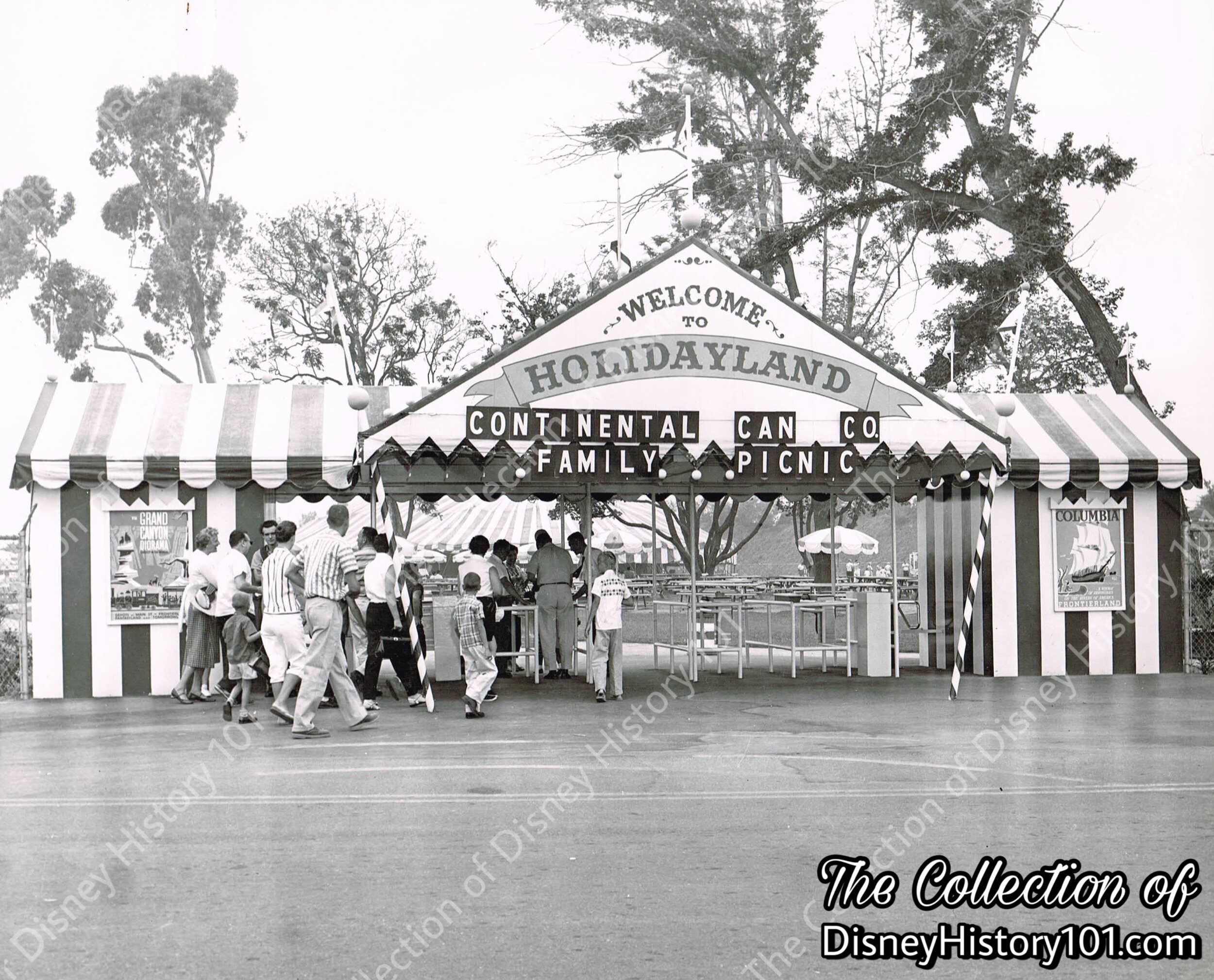
Holidayland Main Entrance, c. 1957
The Holidayland Main Gate decorated for the Continental Can Company Party.
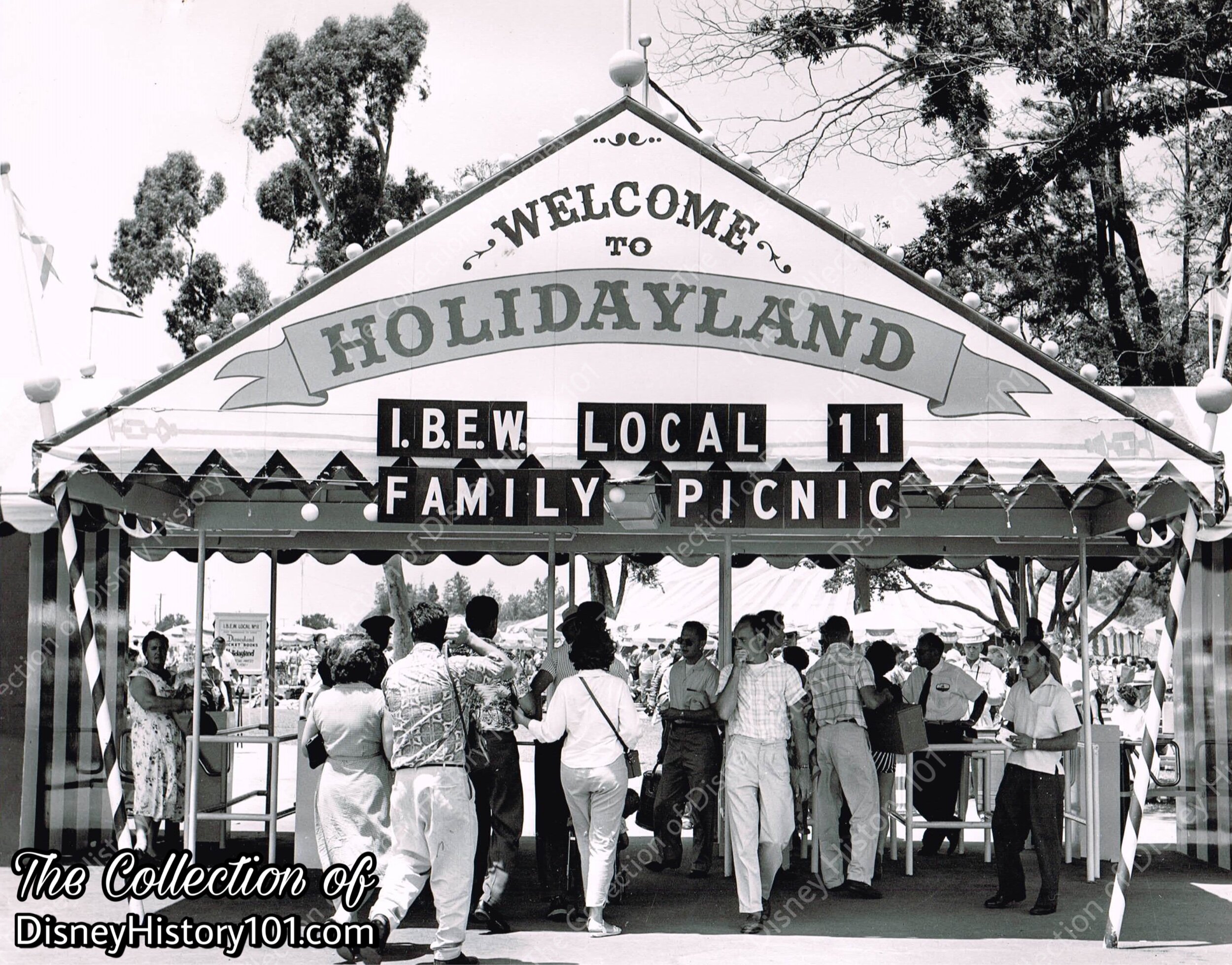
Holidayland Main Entrance, c. 1957
The Holidayland Main Gate decorated for the I.B.E.W. Local 11 Family Picnic.
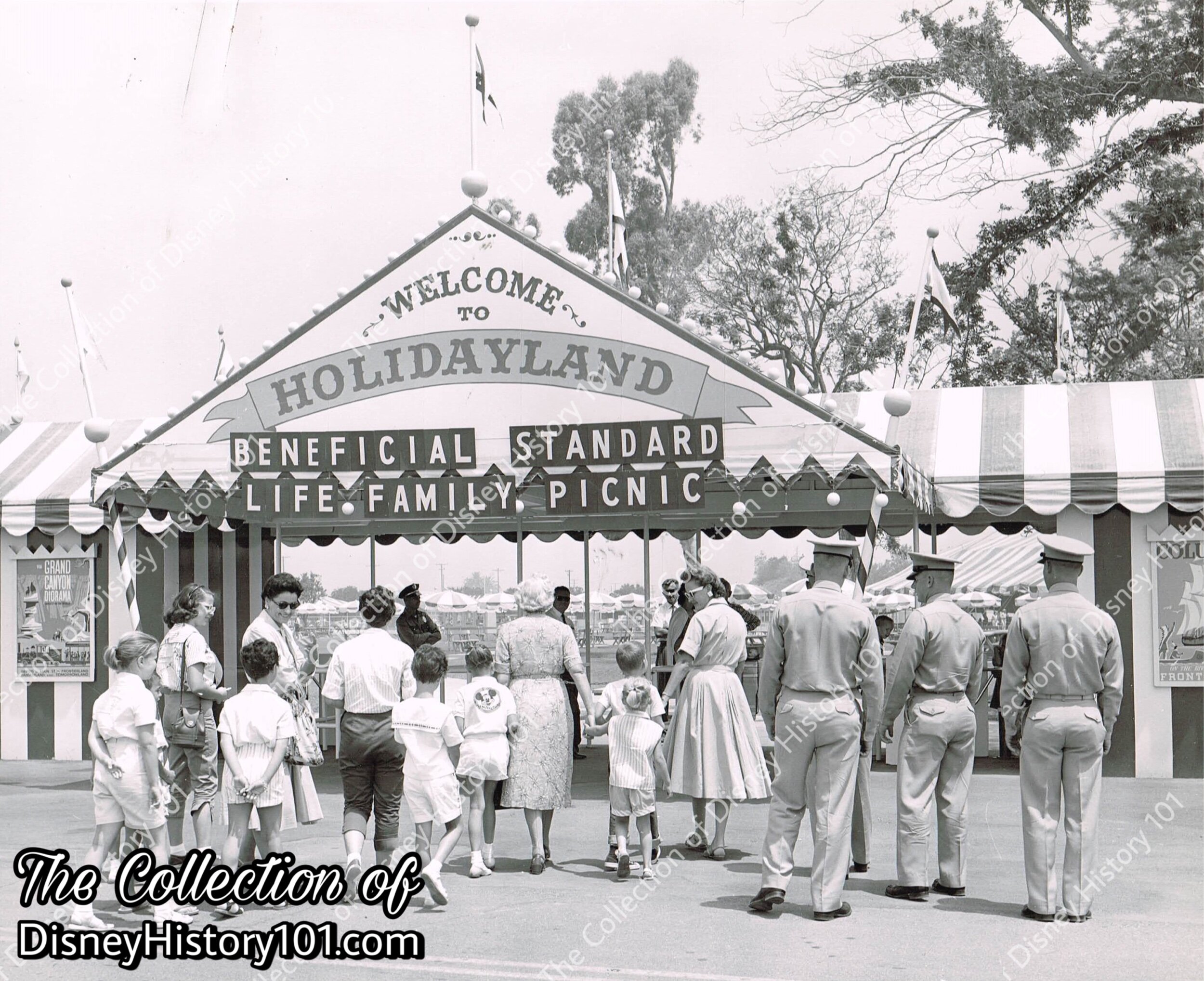
Holidayland Main Entrance, c. 1957
The Holidayland Main Gate decorated for the Beneficial Standard Life Insurance Family Picnic.
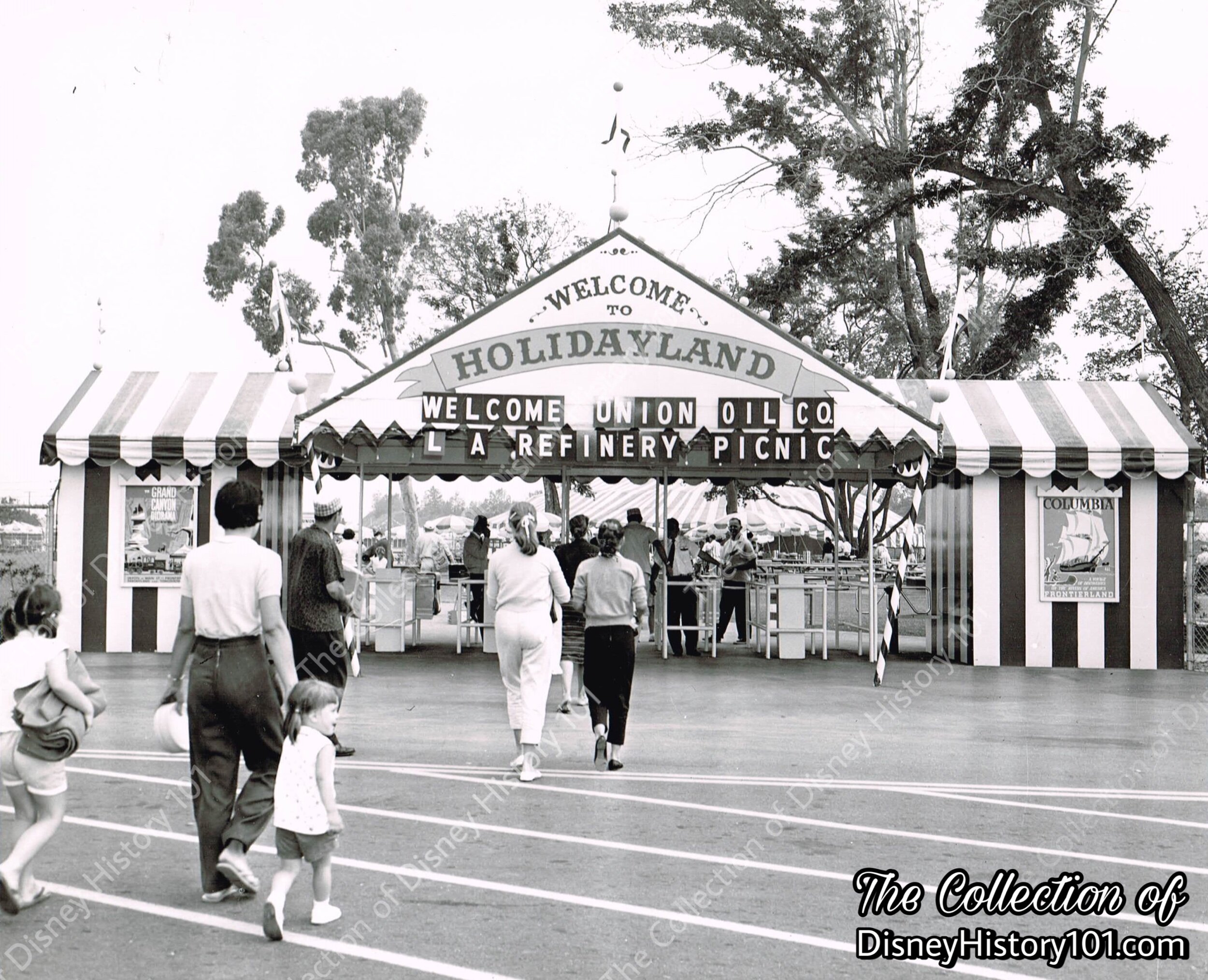
Holidayland Main Entrance, c. 1957
The Holidayland Main Gate decorated for the Union Oil Company and L.A. Refinery Picnic.
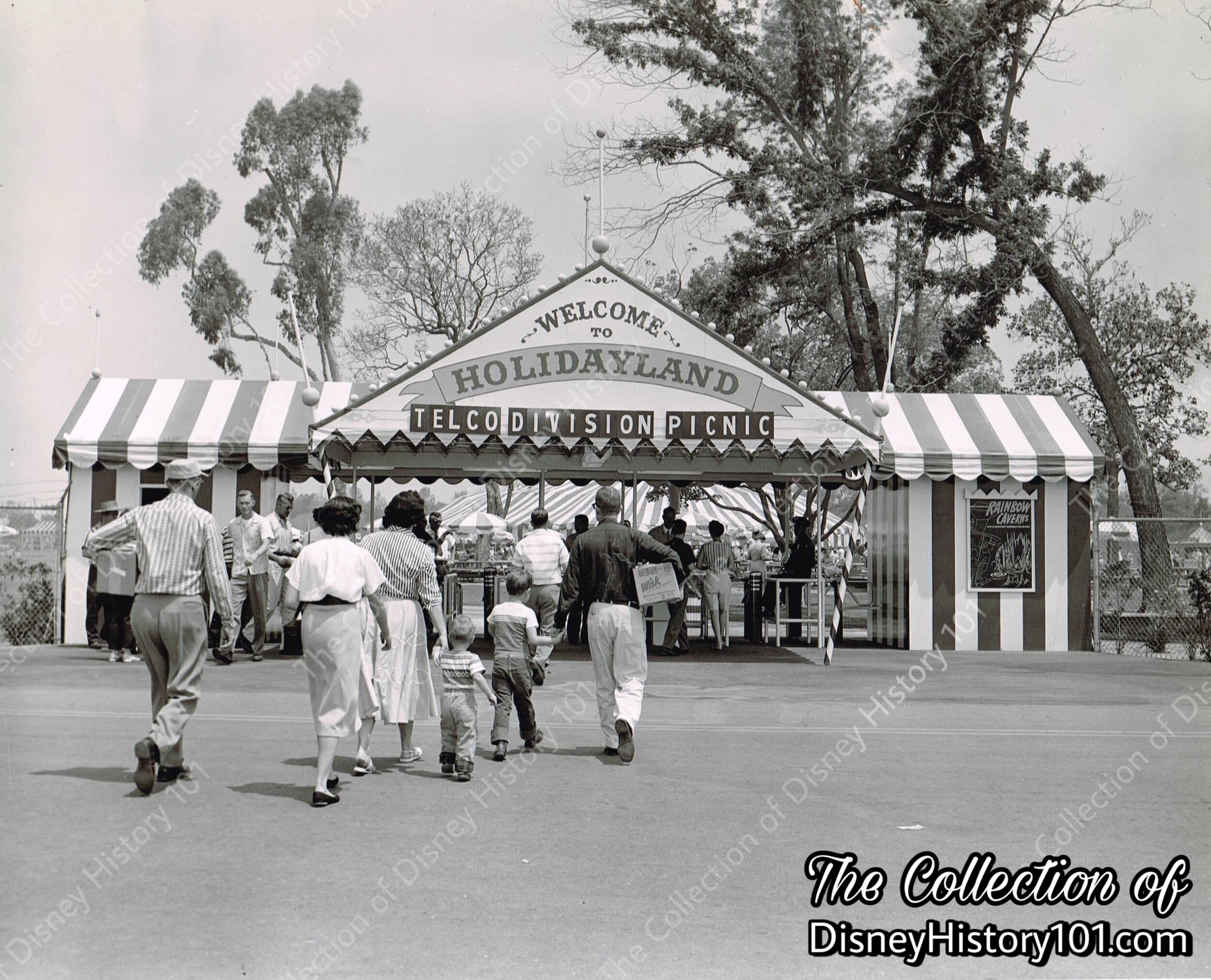
Holidayland Main Entrance, c. 1957
The Holidayland Main Gate decorated for the Telco Division Picnic. This particular image was once featured in the Disneylander published July of 1958.
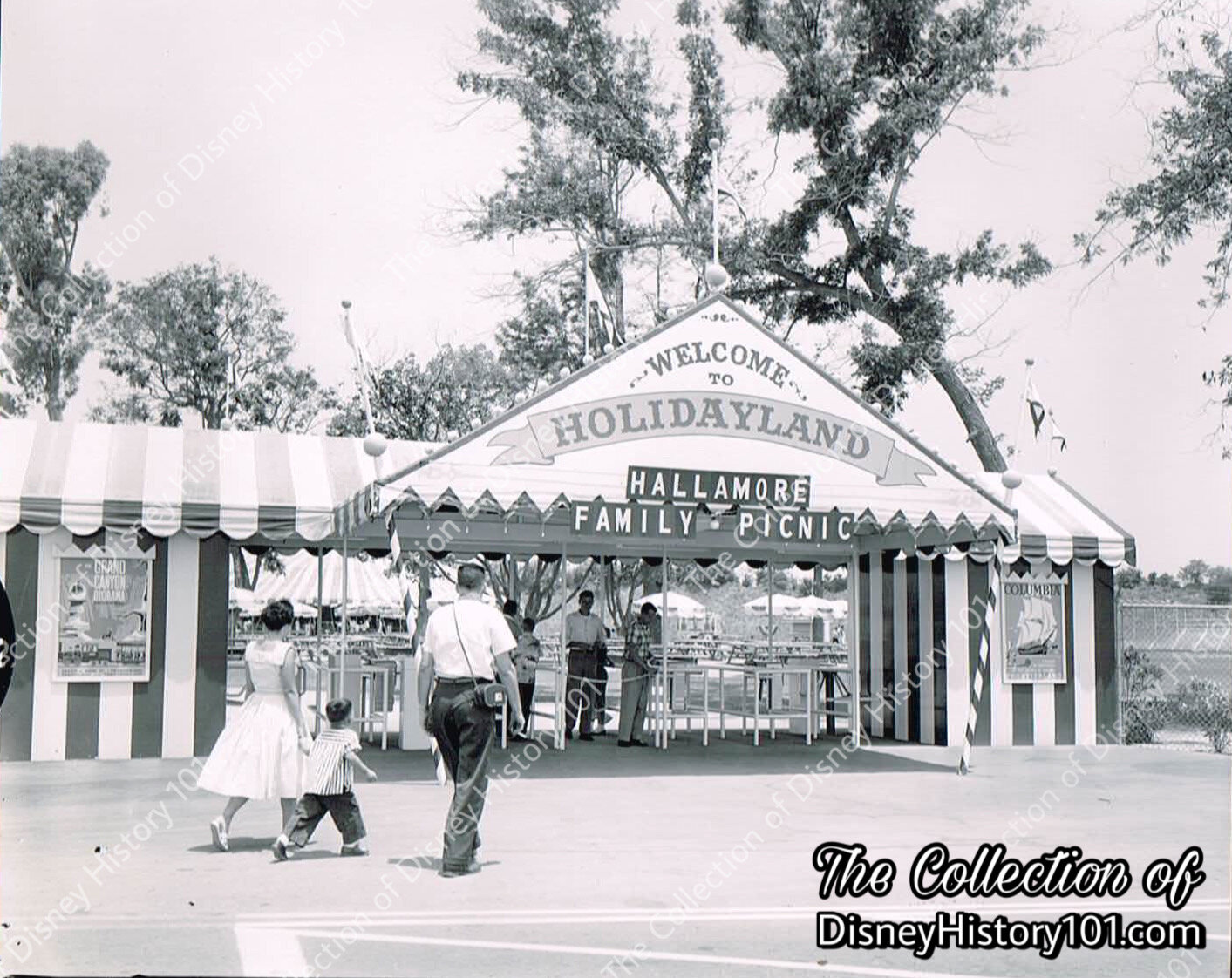
Holidayland Main Entrance, c. 1957
The Holidayland Main Gate decorated for the Hallamore Family Picnic.
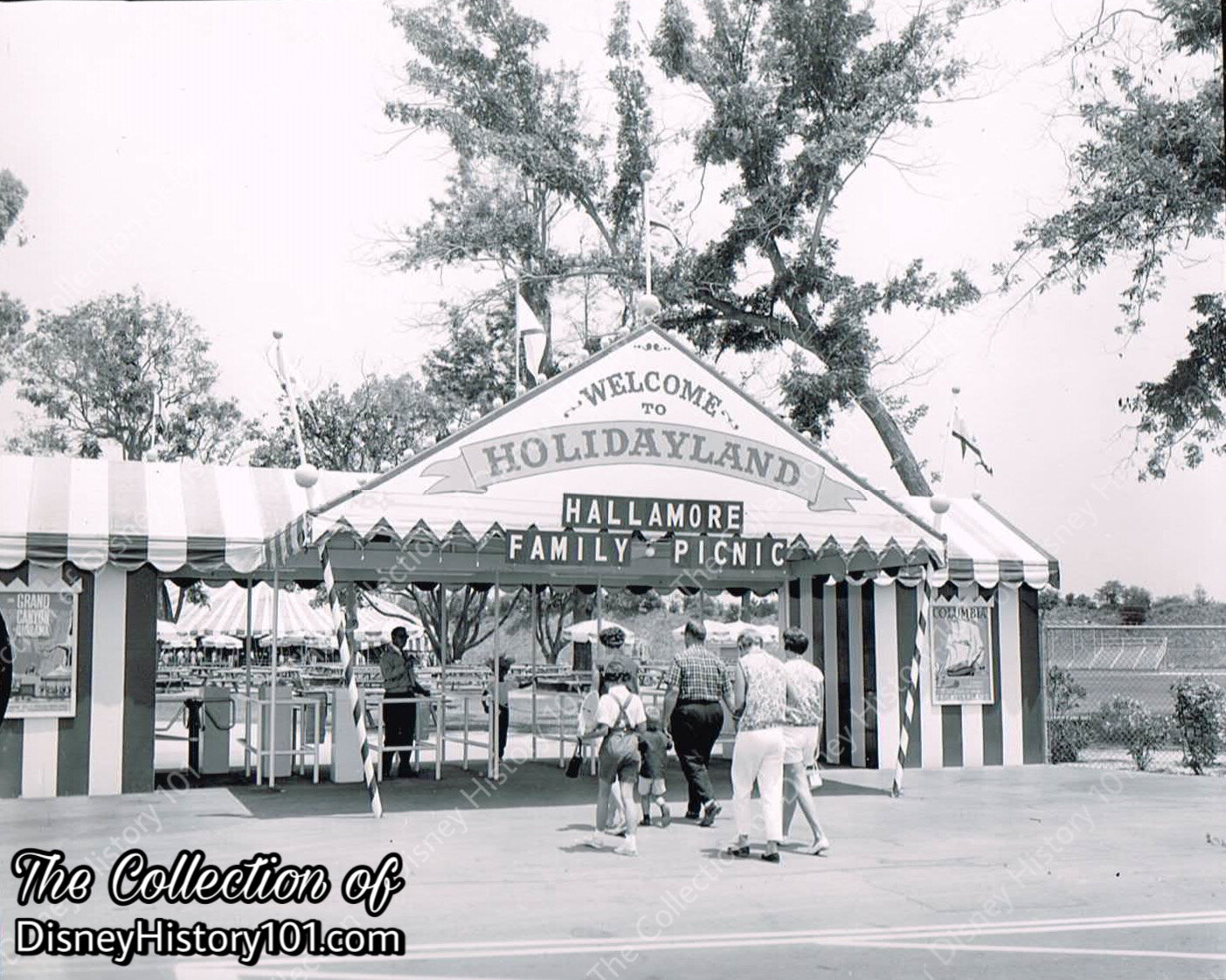
Holidayland Main Entrance, c. 1957
The Holidayland Main Gate decorated for the Hallamore Family Picnic.
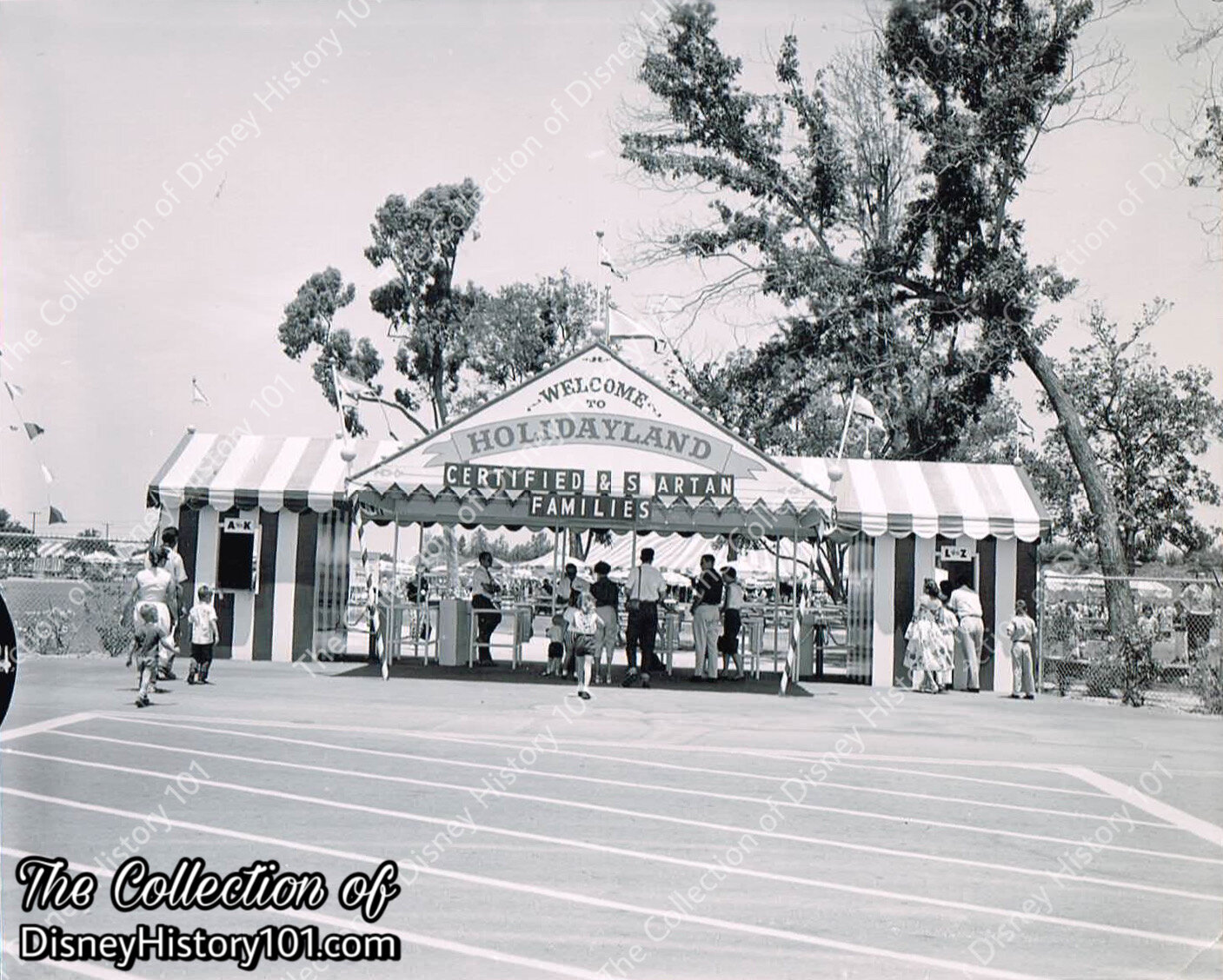
Holidayland Main Entrance, c. 1957
The Holidayland Main Gate decorated for the Certified & S. Artan Families.
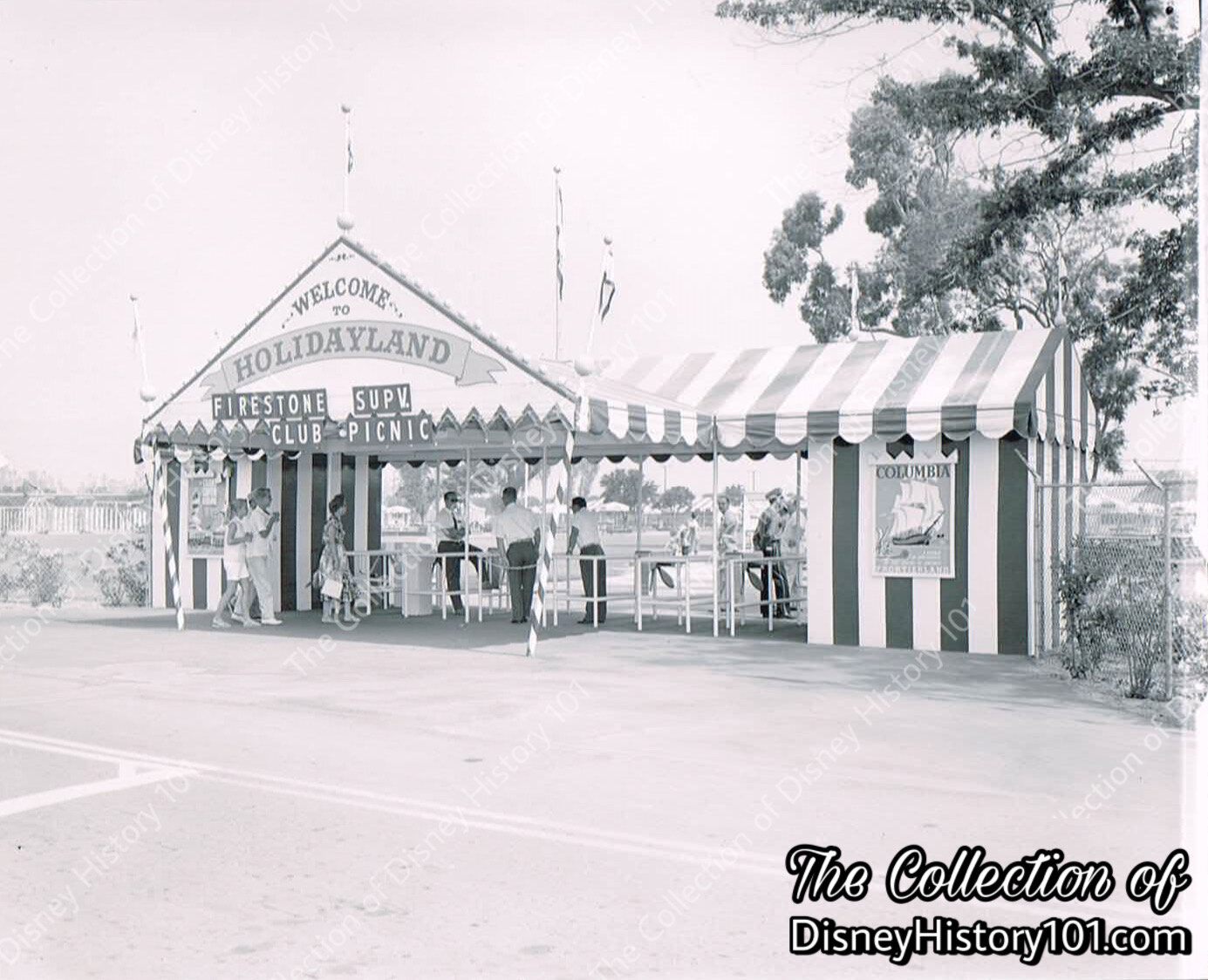
Holidayland Main Entrance, c. 1957
The Holidayland Main Gate decorated for the Firestone Supervisor Club Picnic.
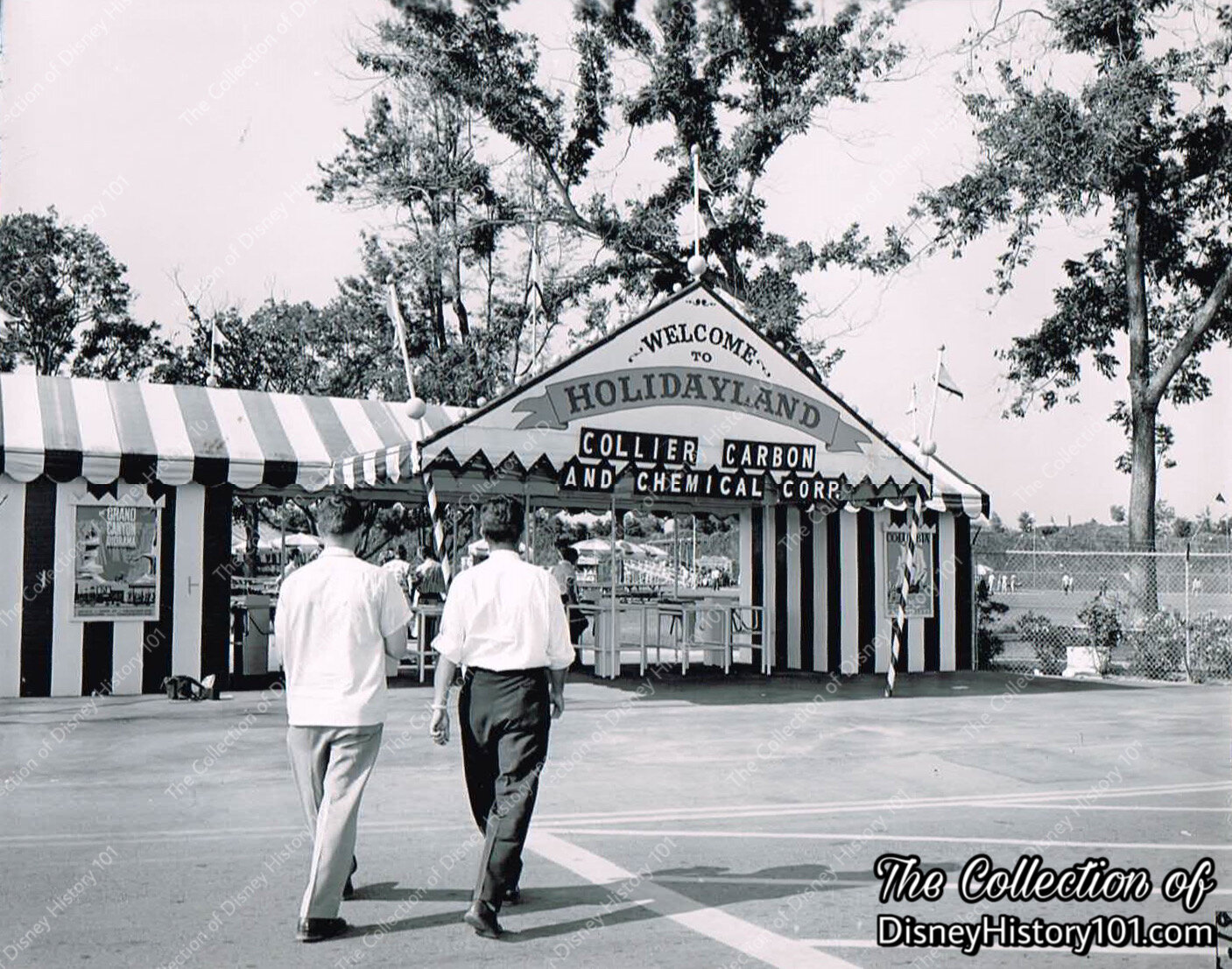
Holidayland Main Entrance, c. 1957
The Holidayland Main Gate decorated for the Collier Carbon and Chemical Corp. Picnic.
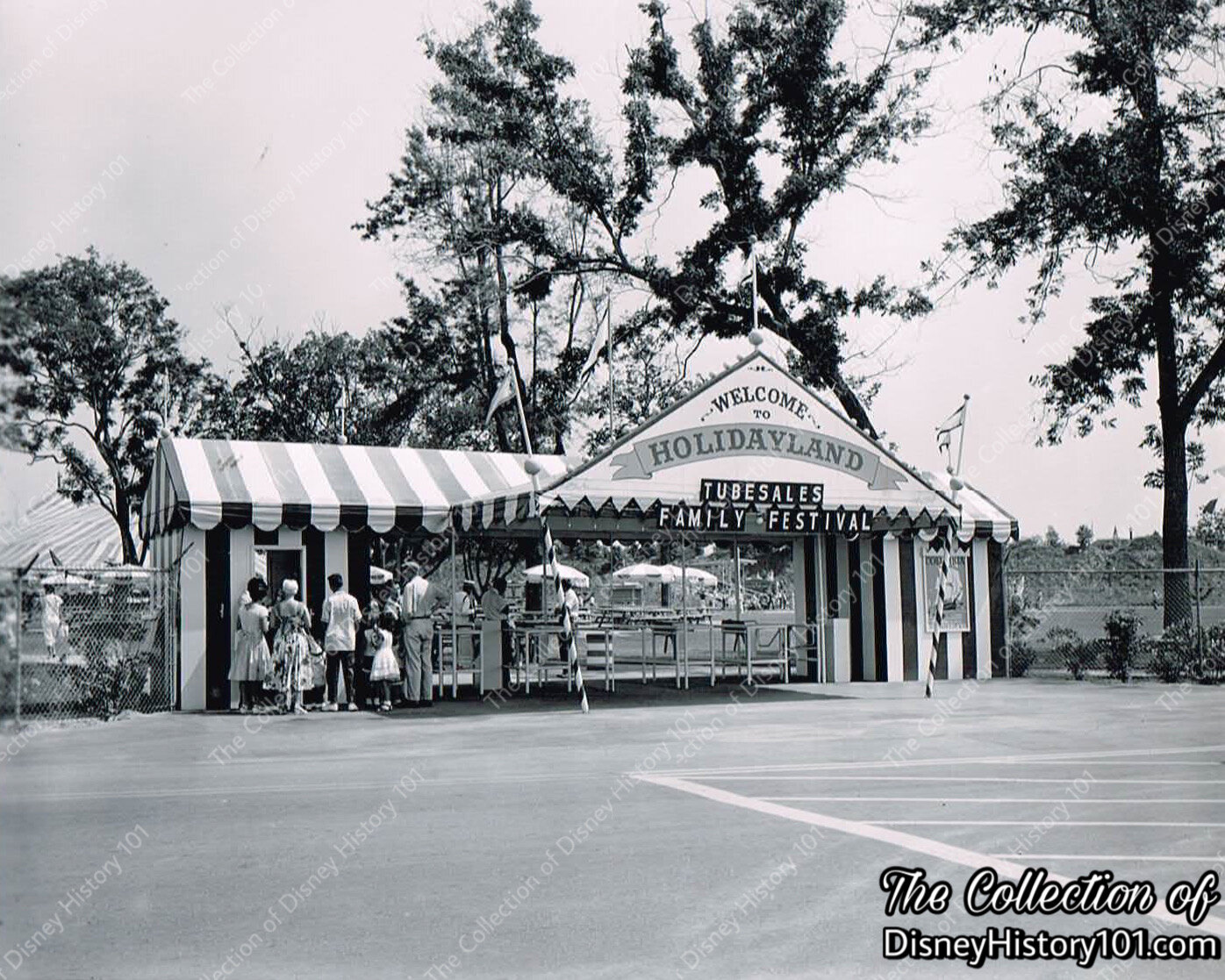
Holidayland Main Entrance, c. 1957
The Holidayland Main Gate decorated for the Tubesales Family Festival.
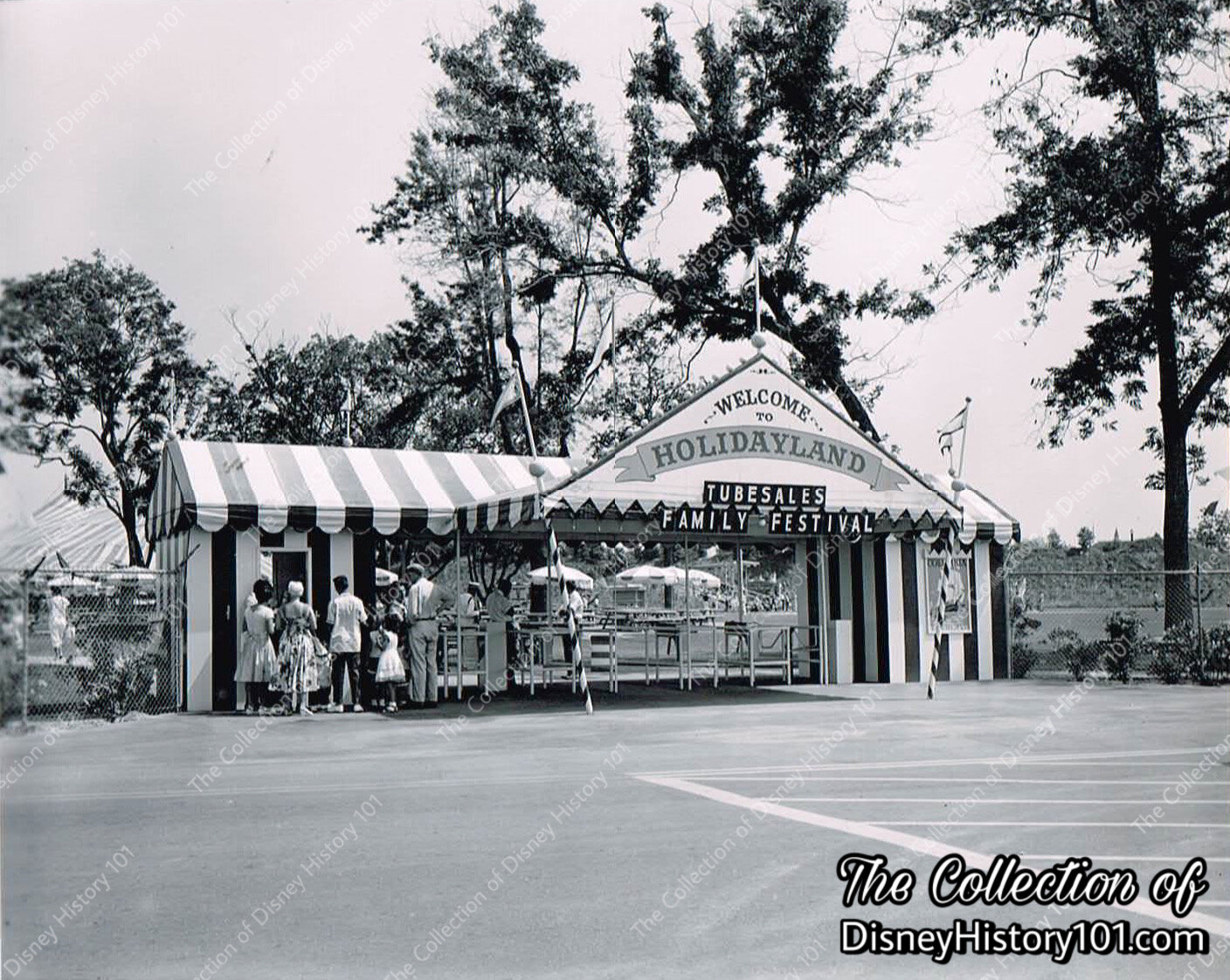
Holidayland Main Entrance, c. 1957
The Holidayland Main Gate decorated for the Tubesales Family Festival.
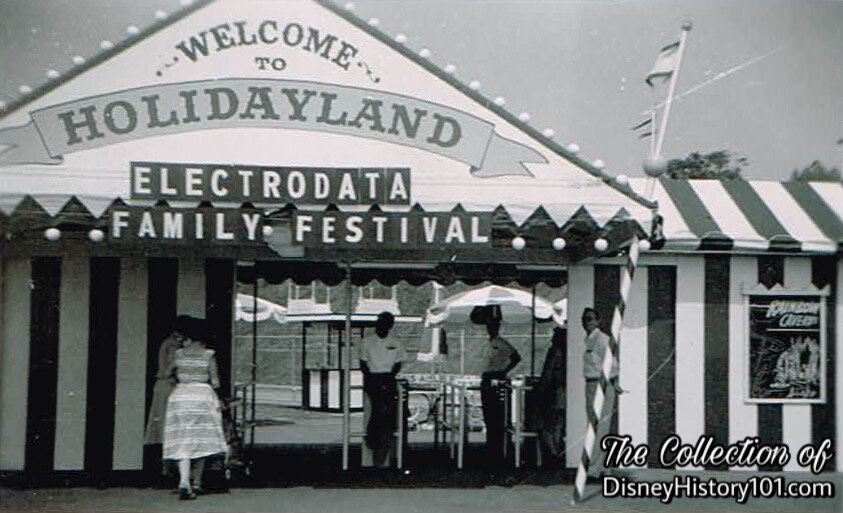
Holidayland Main Entrance
Holidayland Main Entrance welcomes the Electrodata Family Festival.
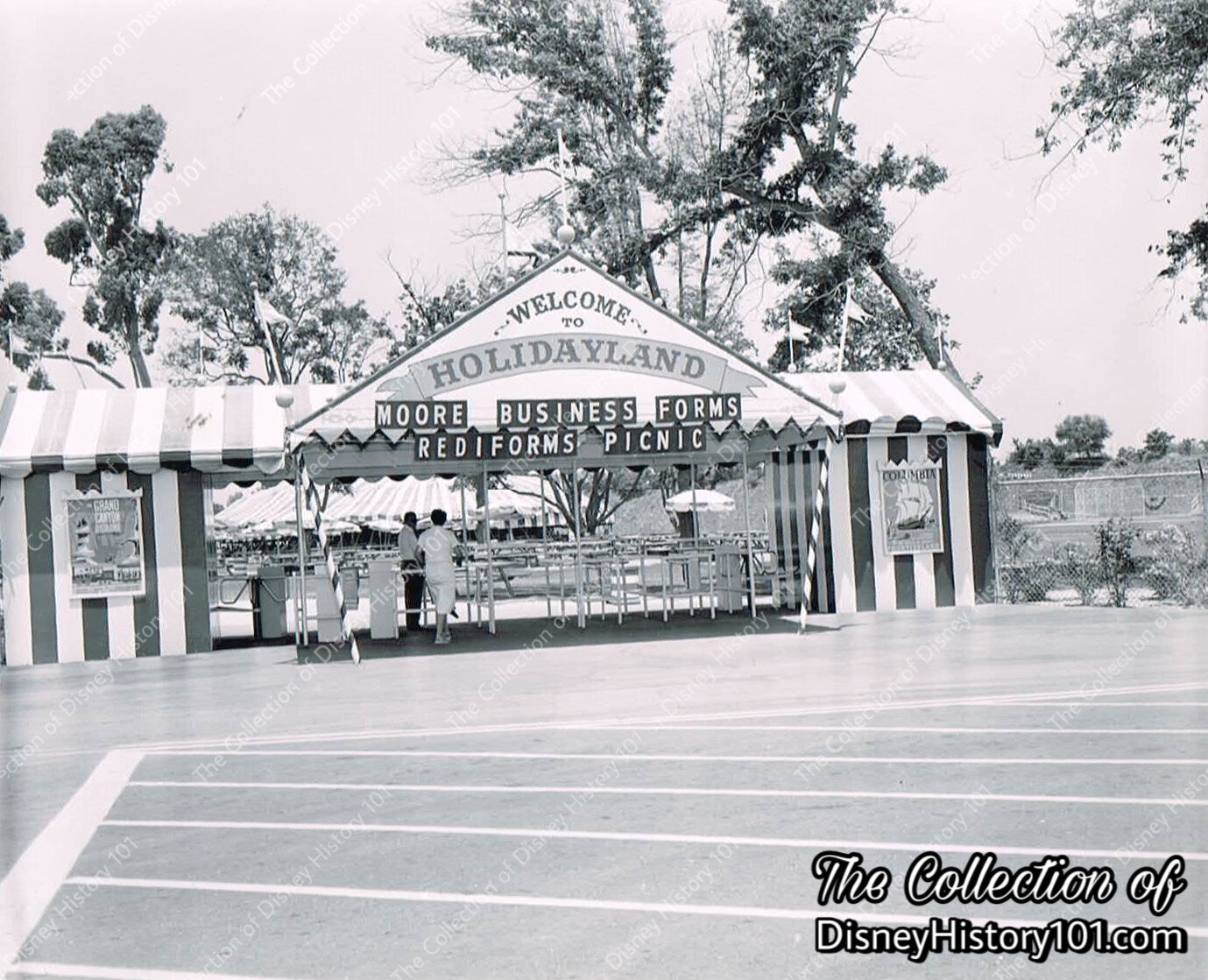
Holidayland Main Entrance, c. 1957
The Holidayland Main Gate decorated for the Moore Business Forms Rediforms Picnic.
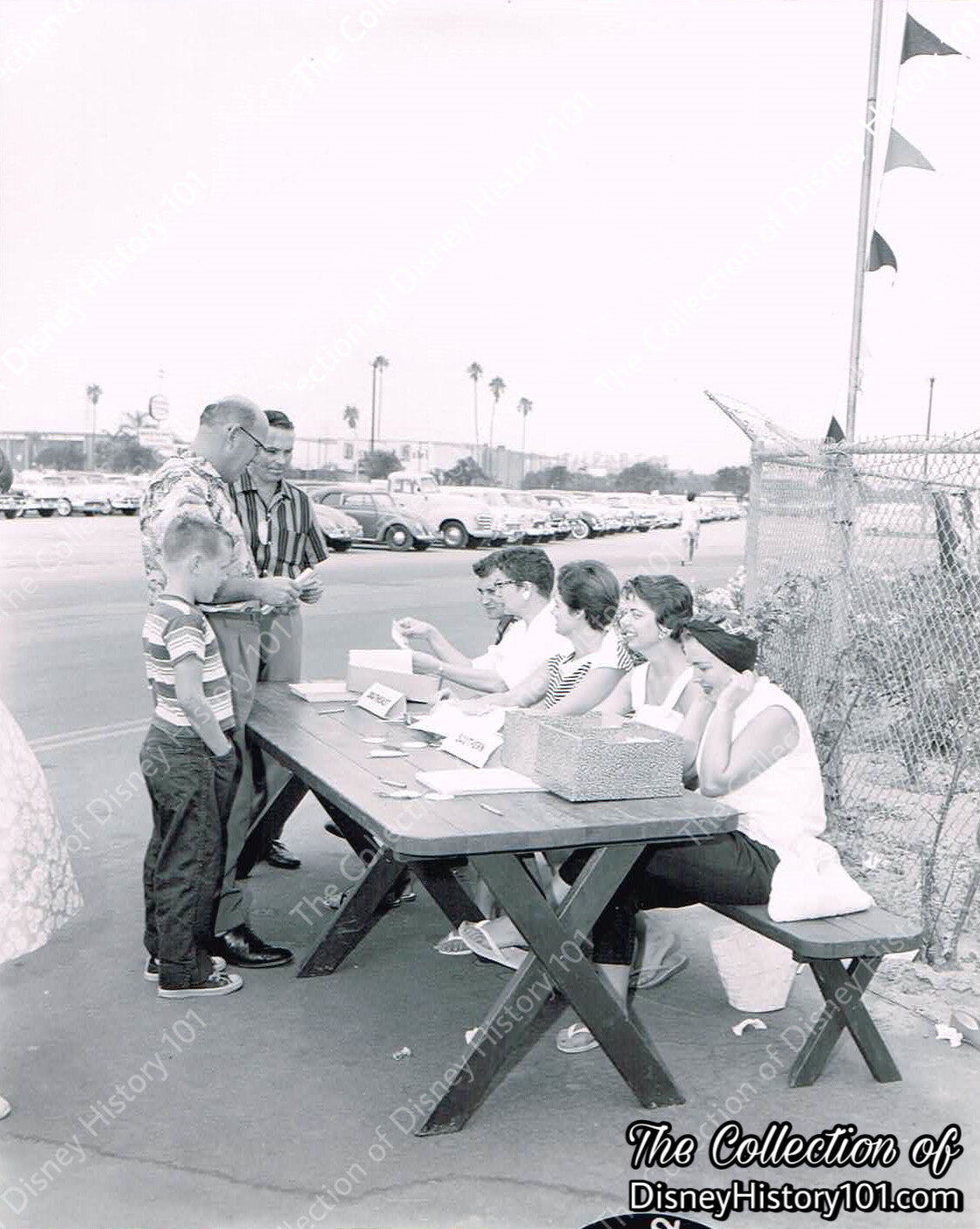
Holidayland Parking Lot, c. 1957
Guests parked in the Reserved Parking Area at a regular Disneyland fee of 25¢.
It looks as if some form of welcoming committee was set up on a bench near the Parking Lot, to welcome employees and family members of the Southern California Gas Company. This location was utilized to distribute special Holidayland Identification Tags to guests attending this event.

The Holidayland Picnic Area was the veritable hub of Holidayland, as concrete paths led to other Holidayland features (a second Picnic Area, the Circus Tent, and Baseball Field) from this central location. The Holidayland Picnic Area offered complete food and catering services through several quick service kiosks and the Holidayland Snack Bar (managed by Myrt Westering of the Red Wagon Company). Myrt Westering, promised that “the facilities will be as modern and as up to date as modern food science can make them…… it is so arranged that the hot dogs will be HOT and the cold drinks will be COLD.” [“Disneylander,” May, 1957] Here, guests could purchase food, refreshments, deserts, and beverages (coffee, soft drinks, and perhaps a Disneyland first - the “bottomless beer mug”). These kiosks were located against Disneyland’s western barrier (with Frontierland’s tree-lined berm seen just beyond). Telephones were also located here, not far from the dining area - numerous benches shaded from the sun by large trees and umbrellas.
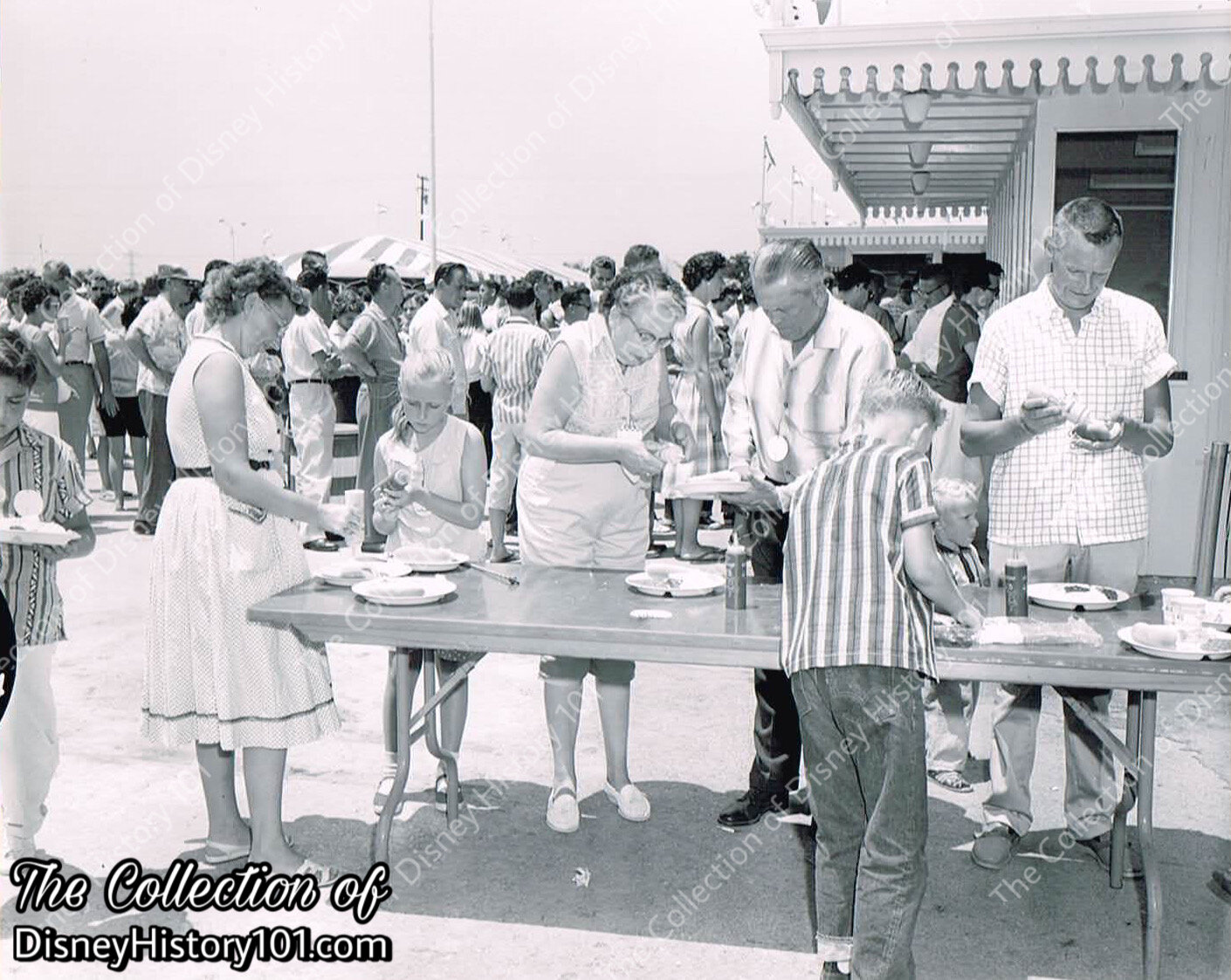
Holidayland Refeshment Stand, c. 1957
The Holidayland Refreshment Stand was a quick service (counter service) location that offered many menu items (courtesy of institutional lessee Red Wagon Company) - several salad options, hot dogs, barbecued ham, barbecued beef, and rolls, (as seen in this Moore Business Forms Rediforms Picnic memory). Institutional lessee Swift & Company’s lease of Holidayland areas would yield very little revenue for Disneyland Inc. - $36 for the fiscal year ending September 29, 1957 and $364 for the fiscal year ending September 28, 1958.
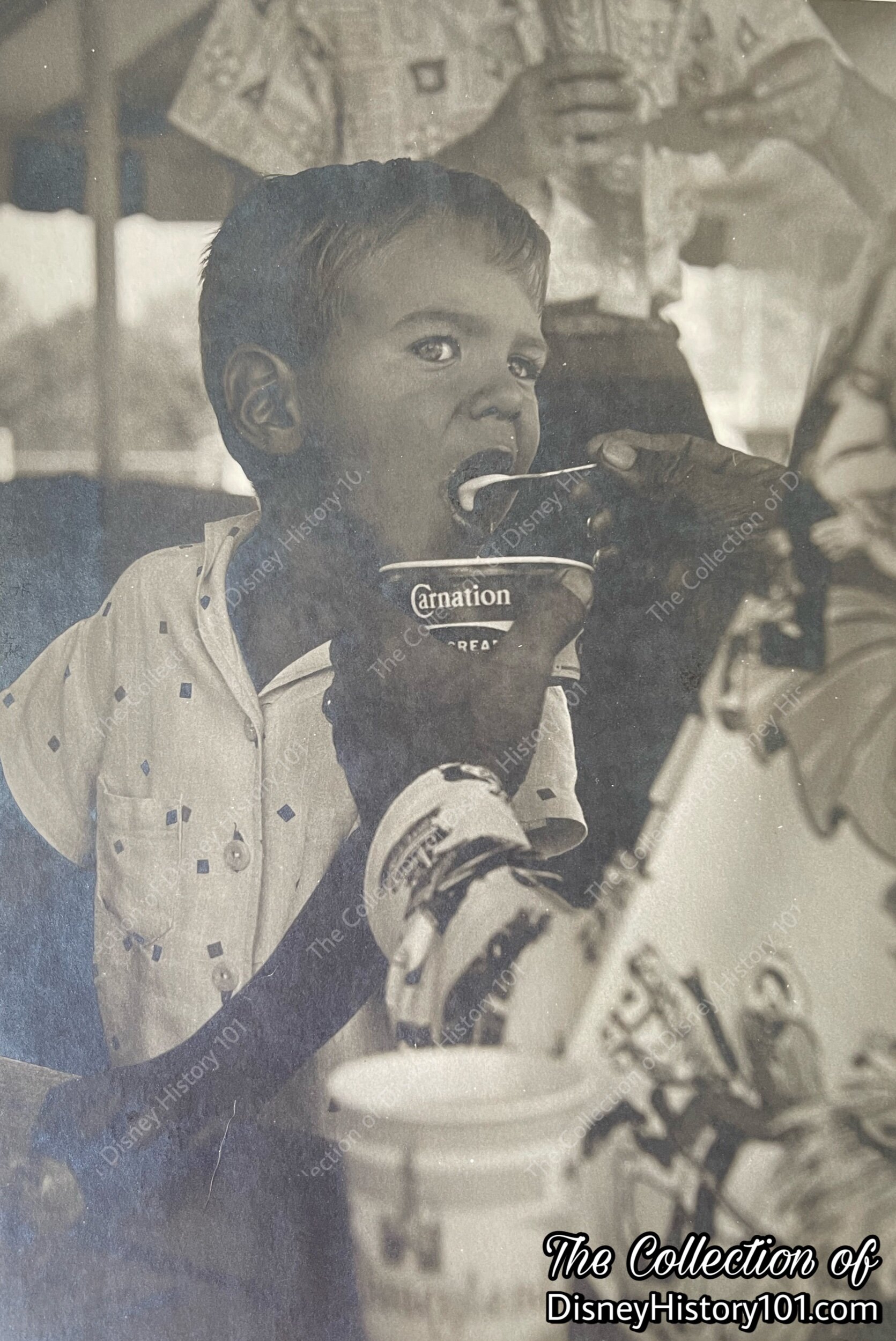
Guest Enjoying a Carnation Ice Cream, NRC Festival held August 10th, 1958 ; Photo Credit : Fred Armstrong
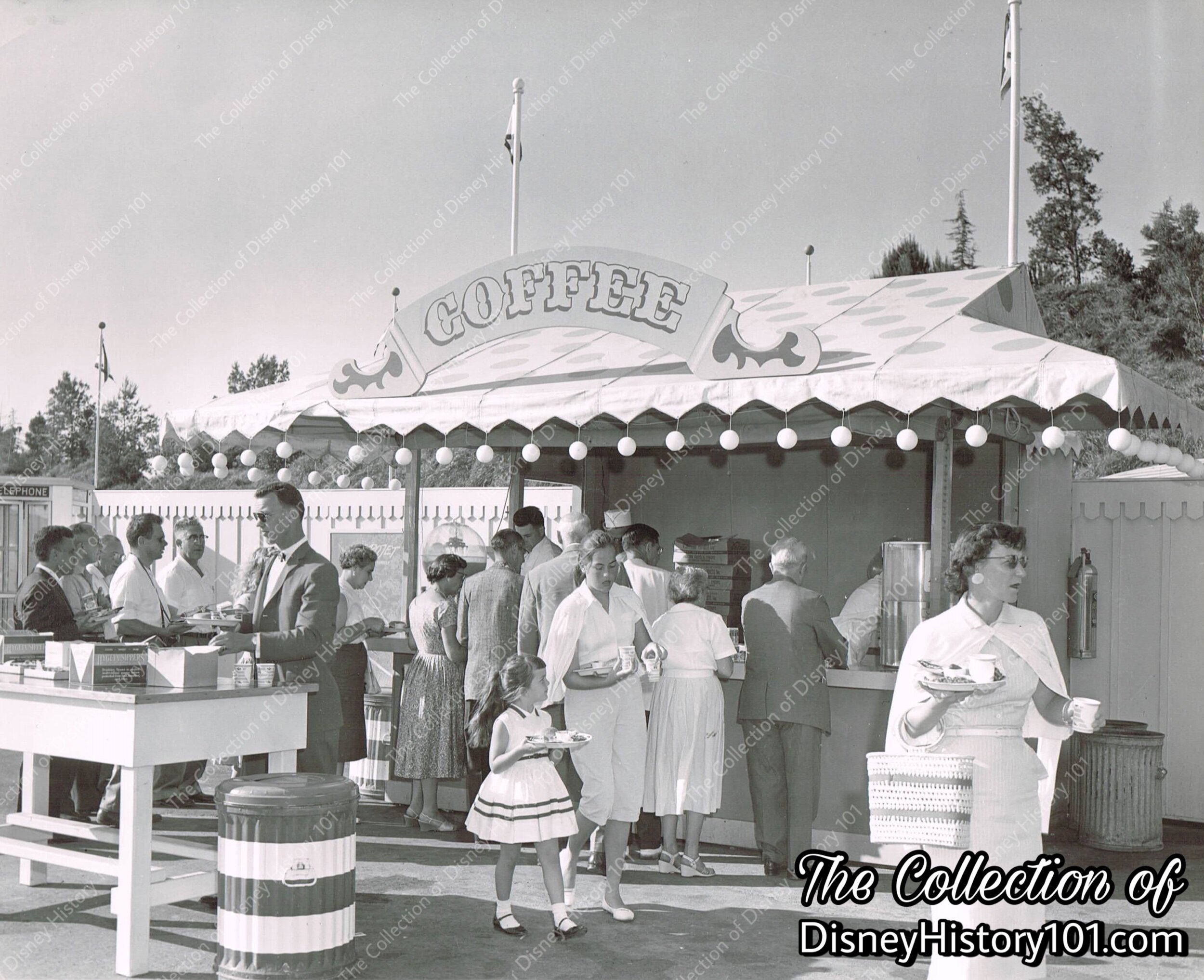
Holidayland Coffee Kiosk and Condiment Bar, c. 1957
Coffee and cold drinks were readily available here, as well as condiments. You may also note the telephone booth for guest’s convenience (on the left side of the Vintage View).
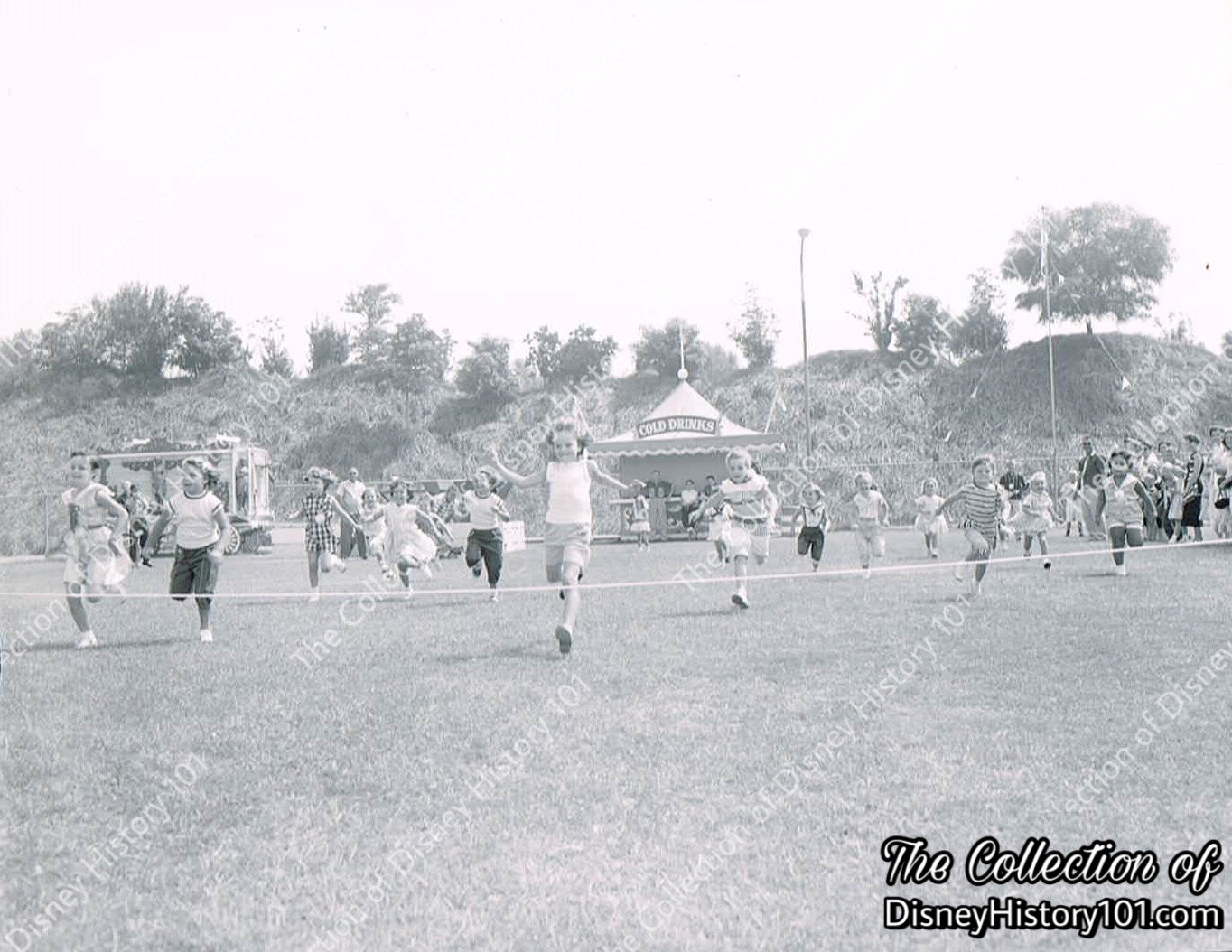
Holidayland Refeshment Stand, c. 1957
Kiosks were also placed outside the Picnic Area, like this Cold Drinks kiosk, seen on the far end of the lawn near the berm, at the Firestone Supervisor Club Picnic. This stand likely catered to general guests.
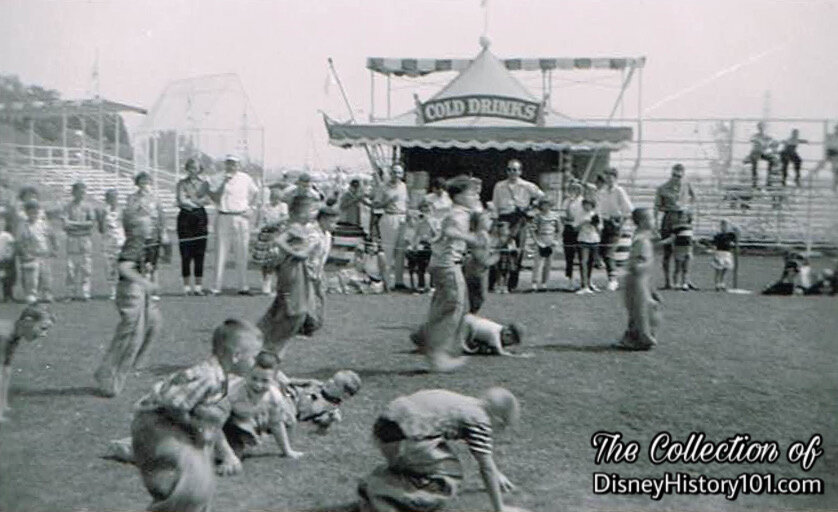
Holidayland Refeshment Stand
This Vintage View (captured during the Electrodata Family Festival) depicts the Cold Drinks Kiosk in a different location near the Softball Field.
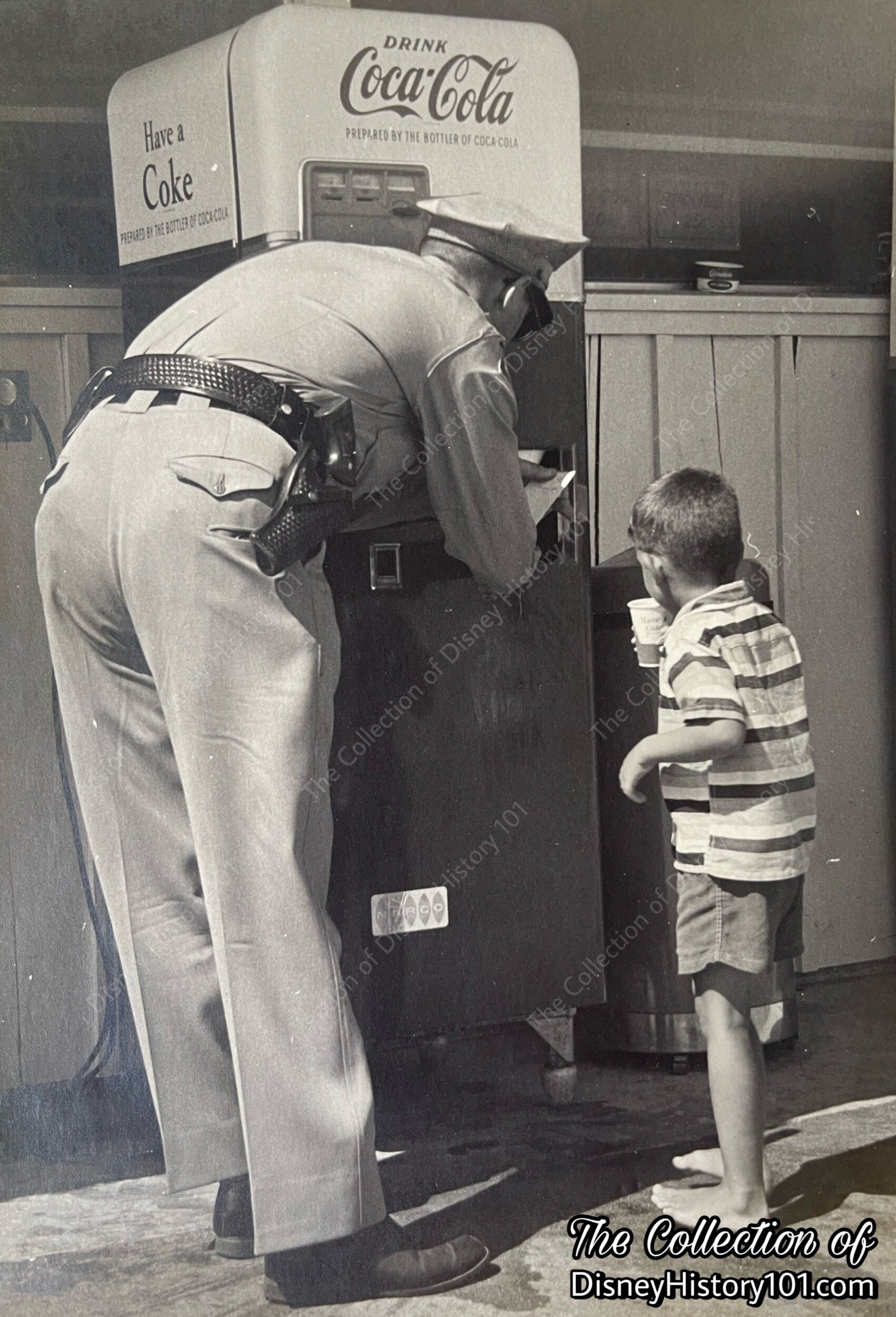
A Dixie-Narco Coca-Cola Vending Machine Near Holidayland Refreshment Stand, NRC Festival held August 10th, 1958 ; Photo Credit : Fred Armstrong
Back in 1955 (through a special arrangement between Walt Disney Productions and the Coca-Cola Company and the Coca-Coca Bottling Company of Los Angeles), bottles of Ice Cold Coca-Cola were available to Disneyland audiences. But after about a year, the Disneyland Operations team decided to do away with bottles. Once Holidayland opened, visitors enjoying a picnic could enjoy cups of ice-cold Coca-Cola through an arrangement with Dixie-Narco (manufacturer of those contemporaneous Disneyland Dixie paper cups).
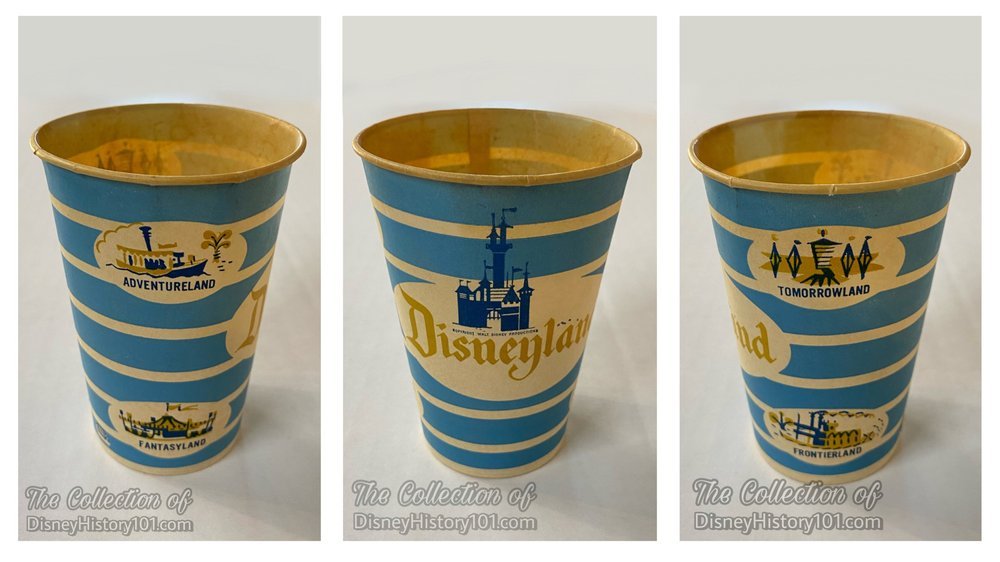
A contemporaneous Disneyland Dixie Cup, manufactured by American Can Co. of Easton Pennsylvania; these were utilized by Holidayland.
The DIXIE CUP division of the American Can Company opened the doors of their Anaheim facility in 1952. The neighboring business came to be located at 901 E. South St., Anaheim, Cal. With a staff of nearly two hundred people under the direction of J.D. Mitchell, the center operated as a manufacturing and distribution point for their product quality paper cups to seven of the Western States.
The business partnership between Disneyland, Inc. and the Dixie Cup Company (America’s #1 paper cup company) was profitable. By September of 1958, the Dixie Cup Company was contributing a routine portion of accounts receivable to Disneyland, Inc.
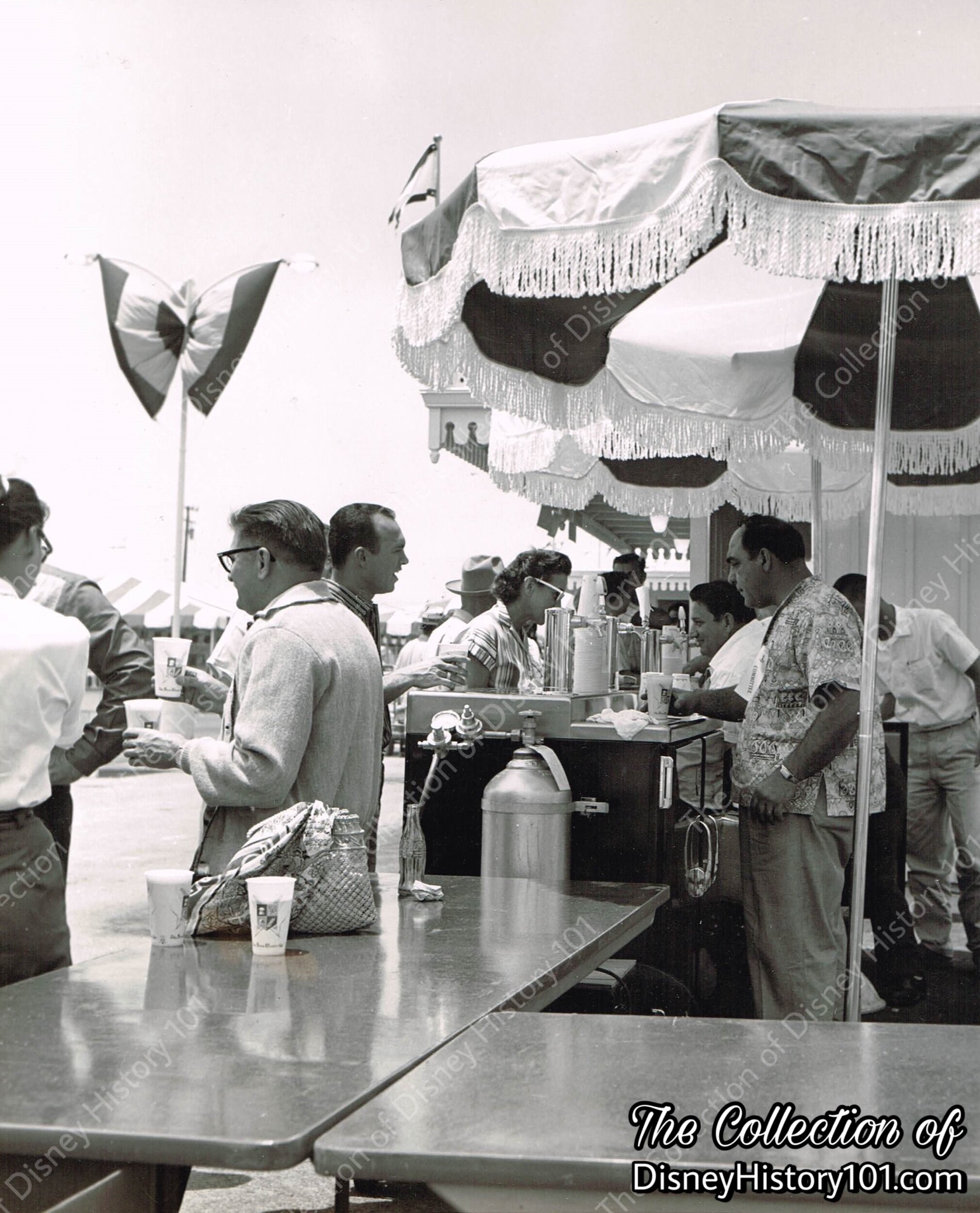
Holidayland Refeshment Stand, c. 1957
“Disneyland and Beer”
Members of the Holidayland Picnic Committee dispense carbonated beverages to guests at this event (pictured above). Bottles of Coca-Cola, and cups of Maxwell House Coffee and Carnation Milk were available at this location. This is also where the “bottomless beer mug” was dispensed.
The latter was truly a rare offering, as Walt was firmly against beer being sold inside Disneyland, a stand made clear during the research and development phase of Disneyland. “Successful amusement park owners… told him he was doomed if he did not have a liquor sponsor” or “failed to sell beer in the Park. Walt ignored them.” Even before the Park opened, numerous articles (as one published in Printer’s Ink, July 15, 1955) shared: “No beer or liquor will be sold in Disneyland Park.” Florabel Muir (of the New York Daily News) reported, “With a couple of exceptions, every diversion… will be available to… visitors. One exception is liquor. Disney has even banned beer, though the suds makers made him some mighty tempting offers.” Harper Goff recalled about opening day, that despite the Press allowed to bring alcohol to Disneyland on opening day, the Park would “not… serve it or have it for sale” due to “Anaheim’s old-standing laws”… [and not getting an adjunction on it].
Disneyland Security Hosts were instructed “No alcoholic beverages or those under the influence of alcohol are allowed in the Park at any time.” As for the Disneyland staff, the c.1955 employee orientation handbook “You Will Create Happiness” prohibited the possession or the scent of alcohol on employees this way : labelling it as a “taboo” which “prohibits drinking [alcohol] by hosts and hostesses within Disneyland, or having the odor of liquor on your breath while at work.” This was especially the case for Attractions Hosts and Hostesses as Santa Fe and Disneyland Railroad Engineers and Firemen who abided by Rule G - The railroad rule against drinking.
It is worthwhile to mention that in 1955, the little Gourmet Restaurant at the Disneyland Hotel did serve expertly prepared cocktails with their fine meals. Two years later, Disneyland Drug Store (also located at the Disneyland Hotel) began selling liquor. However, these offerings were outside the Park and never allowed in Disneyland.
Now by the time Holidayland was open (in 1957) things hadn’t changed at Disneyland. In The Story of Walt Disney by Diane Disney as told to Pete Martin (1956), Walt’s own daughter stated: “No liquor is sold, not even beer… Father says if he dispensed alcohol in his park it would attract an element that he doesn’t want.” At least two publications commented on the resolution. “Disneyland U.S.A.” (published 1958) stating: “no alcoholic beverage…[was] sold in Disneyland” for the good of the “wholesome environment of Disneyland”. The TWA publication “Let’s Talk About My Visit To Disneyland Anaheim California: A Note From Mary Gordon TWA Travel Advisor” also noted that “no alcoholic beverages are served within the Park.”
“Beer at Holidayland”
However this was not the case at the concessions kiosks of Holidayland which was still technically reckoned as part of Disneyland Park’s acreage but not located inside the periphery of Disneyland. “Walt thought beer was a basic part of a picnic,” recalled Jack Taylor, the first operations supervisor at Holiday-land. This being the case, this kiosk was the only place where alcoholic beverages were sold (on Disneyland property, but not in the Park). “The beer at Holidayland didn't bother Walt,” Milt agreed, “even though you didn't dare mention alcohol in connection with Disneyland.” [The Nickel Tour]
The Nickel Tour told the tale of “one picnic that did sell and sell real well… set up for a major labor union, who purchased more than 10,000 tickets for the picnic. As soon as the picnic began, the beer was already flowing in an endless stream. ‘By the time they headed into the Park,’ Milt recalls, ‘they were drunker than hoot owls.’ Disneyland survived the day, but it was the last time beer was allowed at a picnic if the guests were going to enter Disneyland.”
In the end, it was decided that Alcoholic beverages would not be sold or permitted on Disneyland property for more than two decades. Disneyland remained determined in this regard until the Walt Disney Company changed their no-alcohol policy during May of 1986. In the present, some of the most exclusive locations in the Park offer a “Disney Family of Wines,” bottled beer, draft beers, and even absinthe selections… For now (c. 1957), beer was briefly offered at just one location at Holidayland!
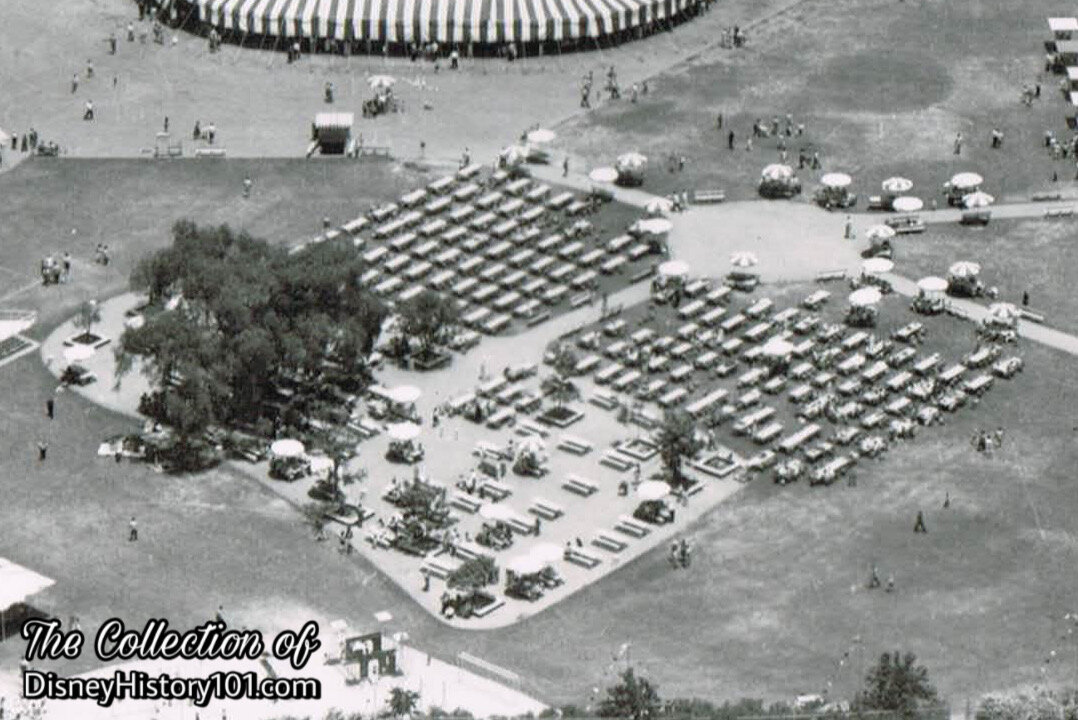
Holidayland Picnic Area, c. 1959.
The paths that run along the Picnic Area were ideal for parking cars for the Road Lord’s Car Club “Car Day & Autocade” event, mentioned earlier. But typically, benches lined the paths for the convenience of picnickers.
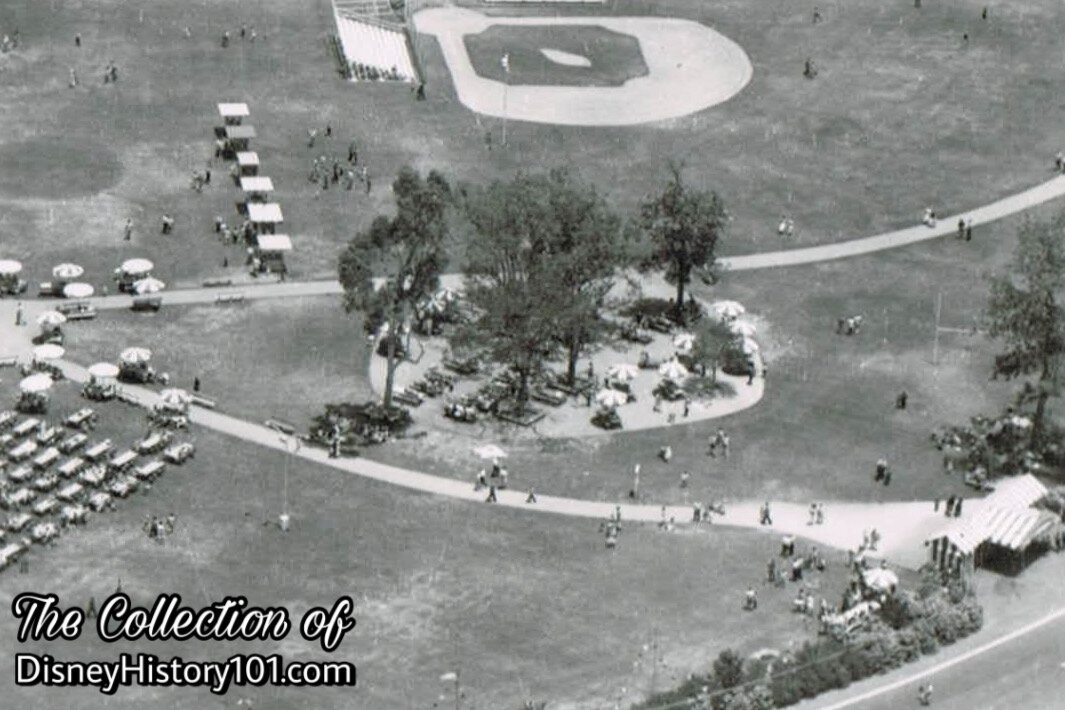
2nd Holidayland Picnic Area, c. 1959.
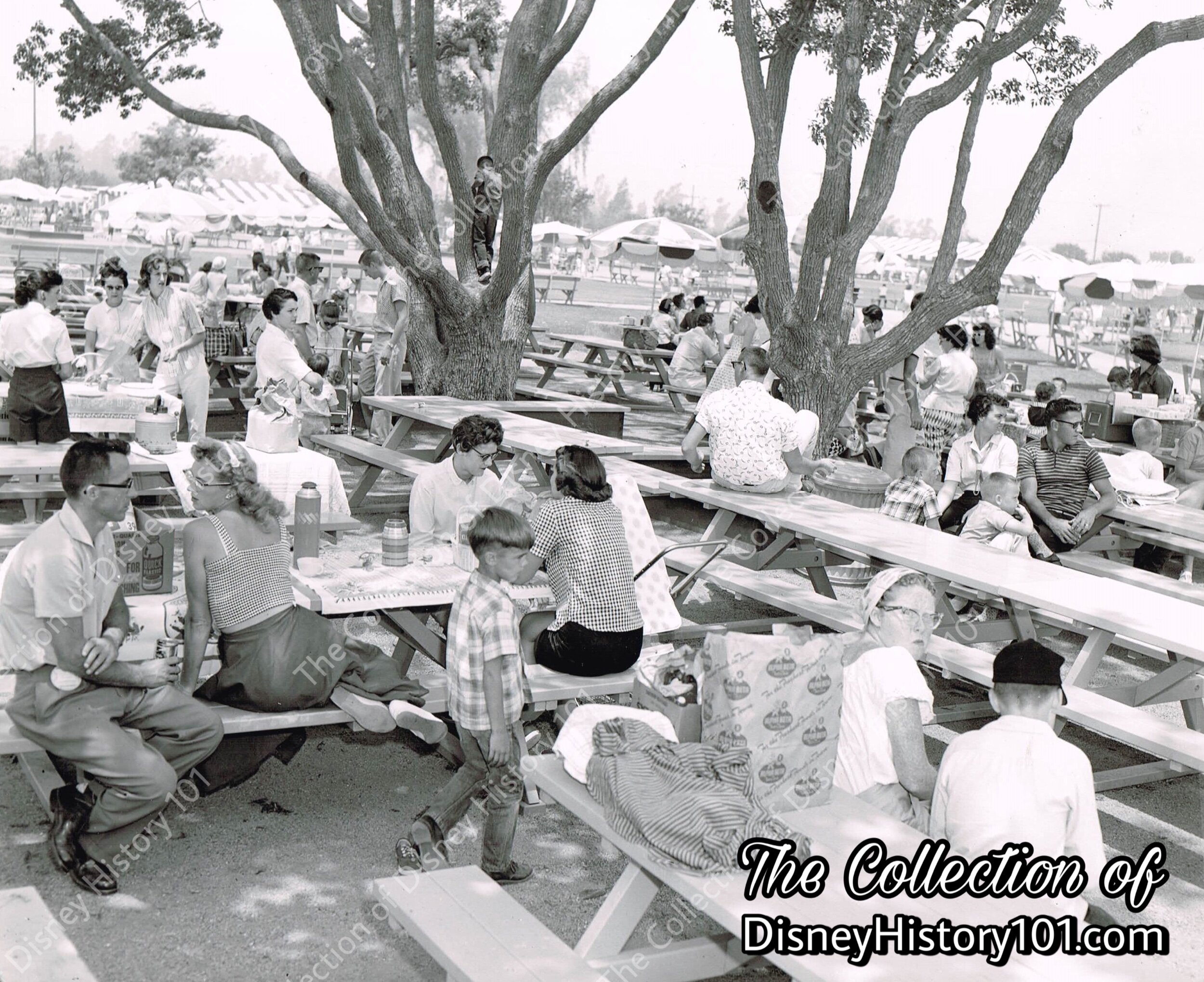
Holidayland Picnic Area, c. 1957
Holidayland had few shade trees. One of the few naturally covered sections was the Picnic Area, located near these large trees. If you couldn’t find a seat in the shade of these trees, there were also plenty of tables bearing umbrellas.

The rarely photographed Holidayland Volleyball Court nets offered athletic alternatives to softball games - badminton and volleyball (Equipment supplied by Holidayland).
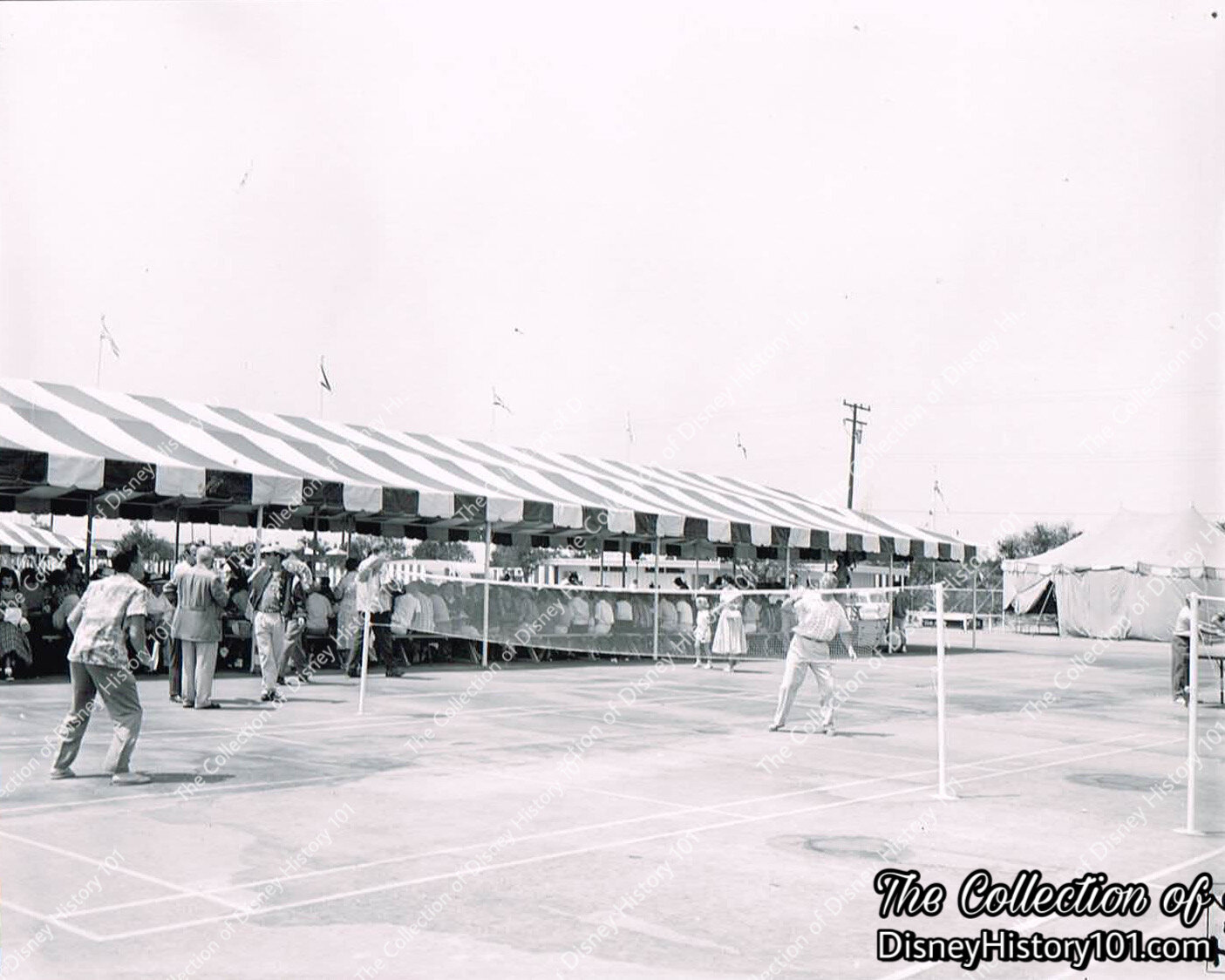
Holidayland Volleyball Court (and Holidayland Game Tent), c. 1957
Southern California Gas Company employees and their family members enjoy a volleyball competition.

The Activity Tent or Game Tent was typically utilized for games that required hard surfaces to play on. Guests usually enjoyed games of cards or BINGO here. Guests could also observe the adjacent Volleyball competitions from the shade of the Holidayland Game Tent’s canvas covering.
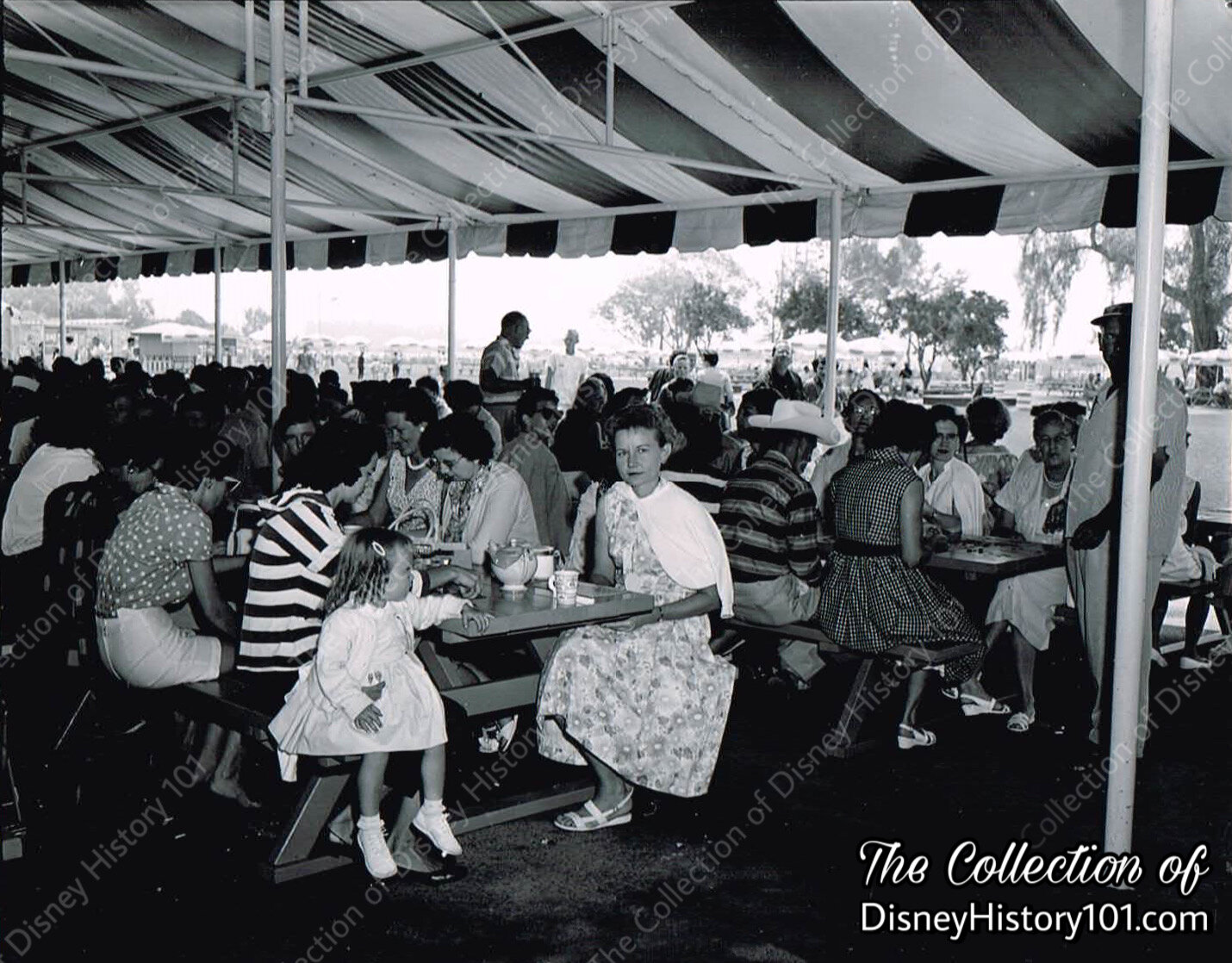
Holidayland Game Tent, c. 1957
Southern California Gas Company employees and their family members made good use of the Holidayland Game Tent.
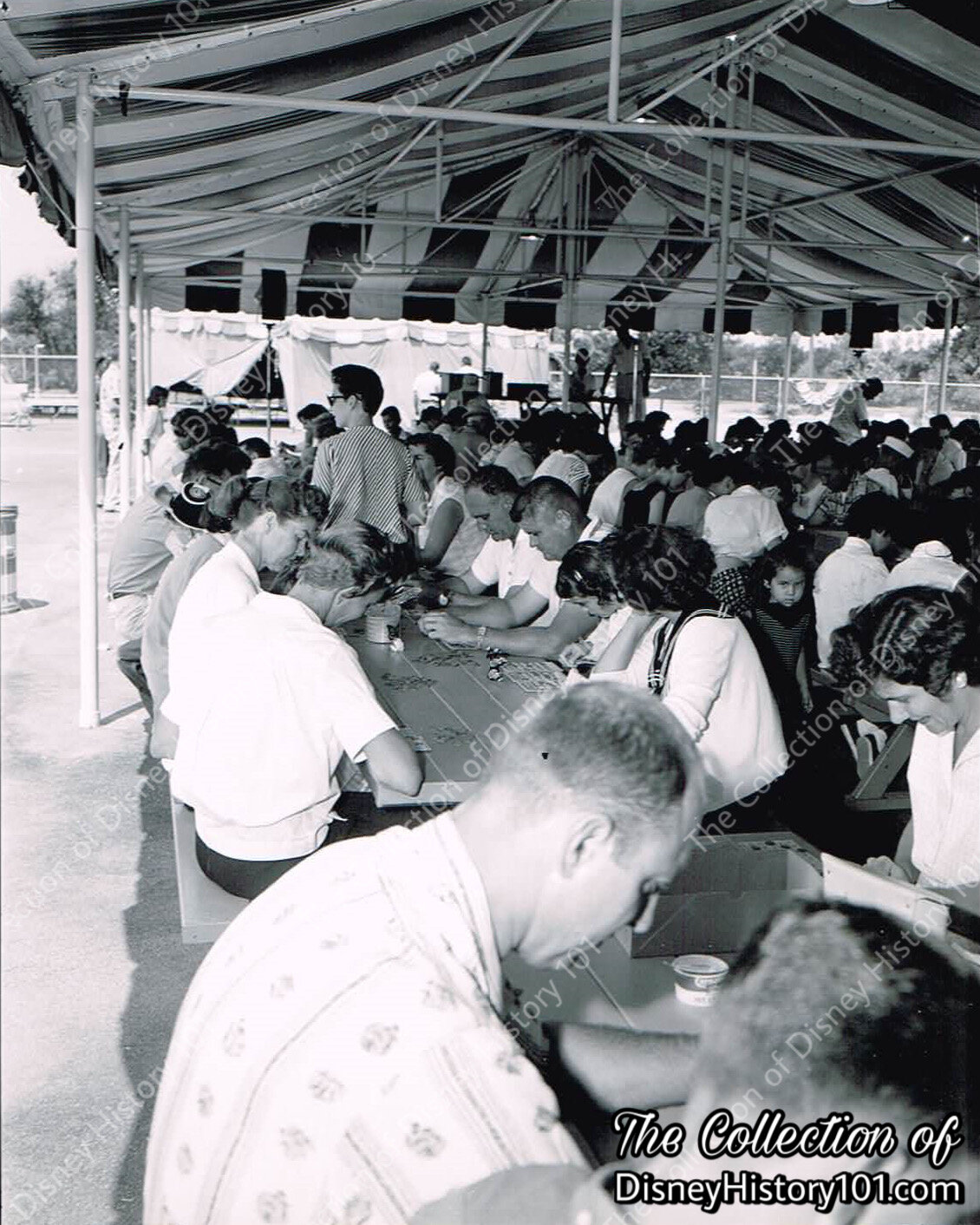
Holidayland Game Tent, c. 1957
Southern California Gas Company employees and their families enjoy a game of BINGO.
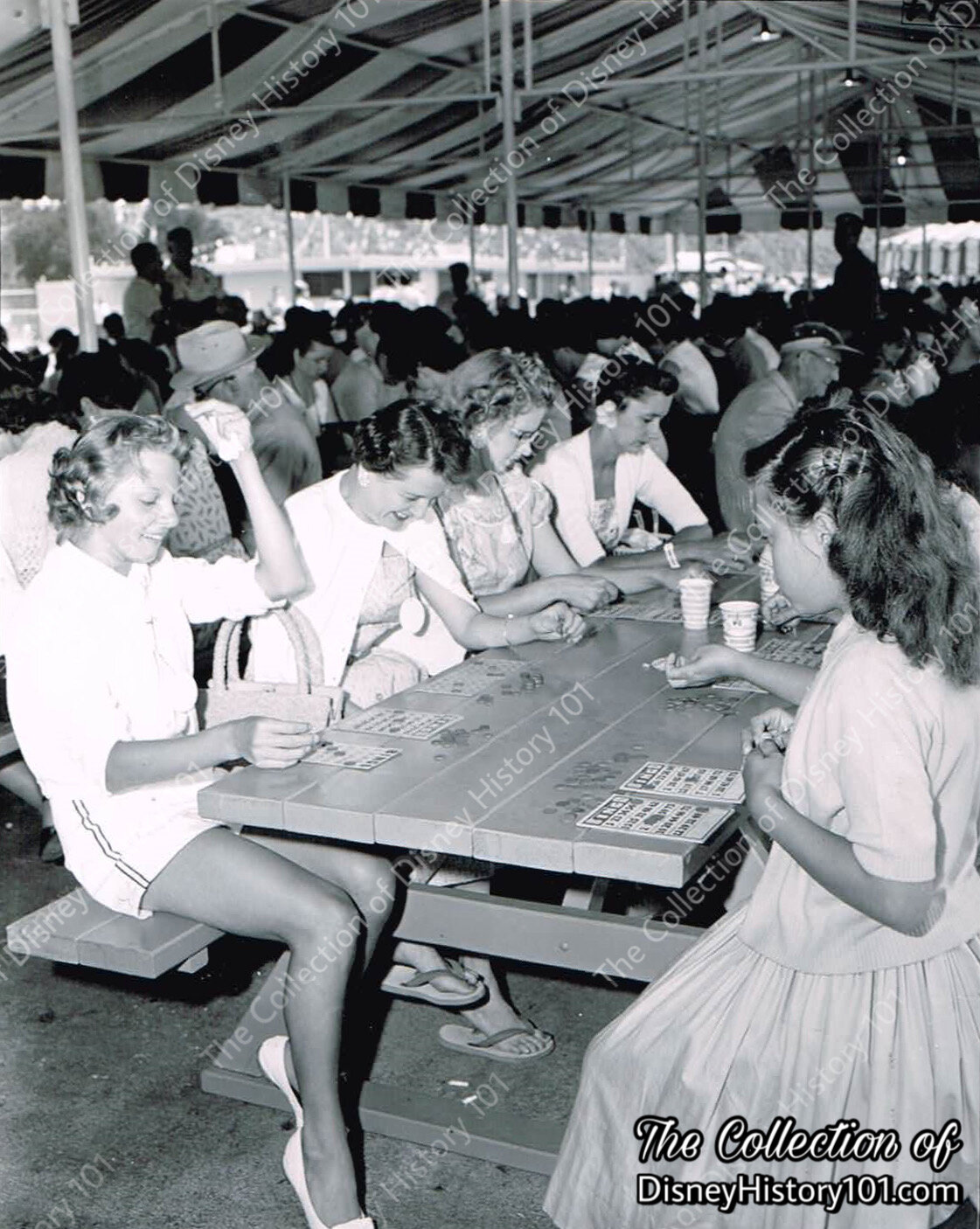
Holidayland Game Tent, c. 1957
(Southern California Gas Company)
In addition to BINGO, there were also pie-eating contests.
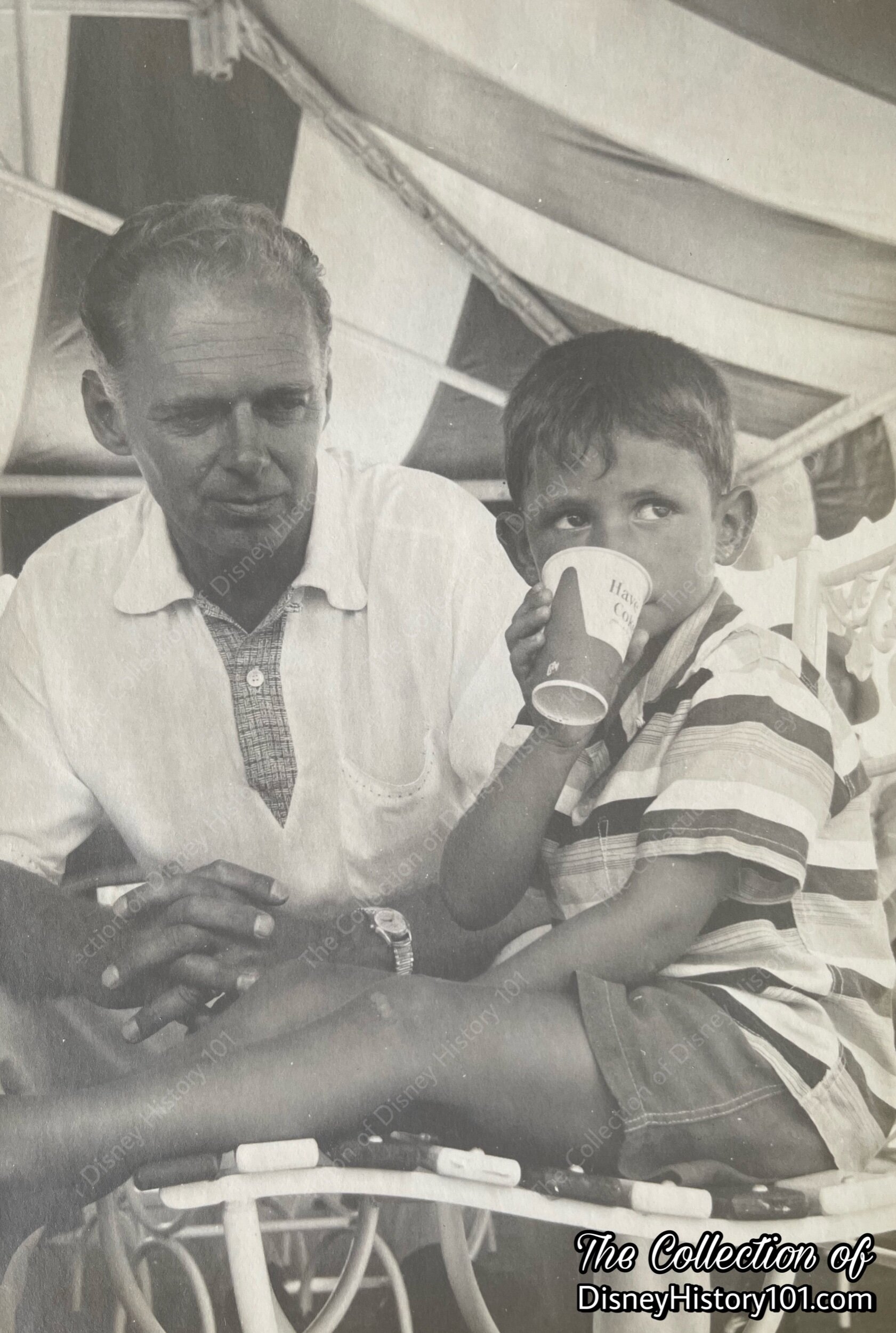
Holidayland Game Tent, NRC Festival held August 10th, 1958 ; Photo Credit : Fred Armstrong
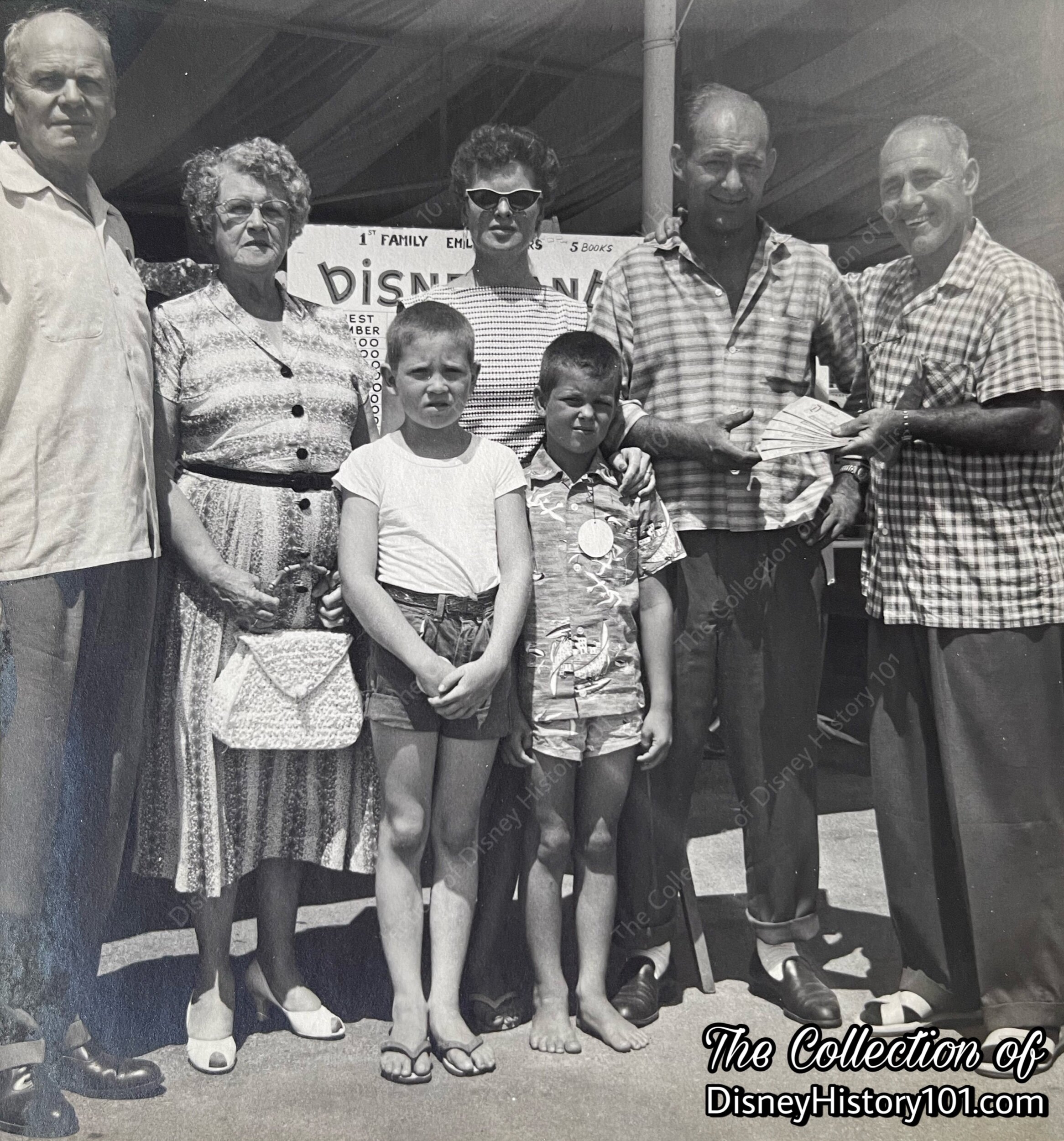
Disneyland Ticket Books Awarded at Holidayland Game Tent, NRC Festival held August 10th, 1958 ; Photo Credit : Fred Armstrong
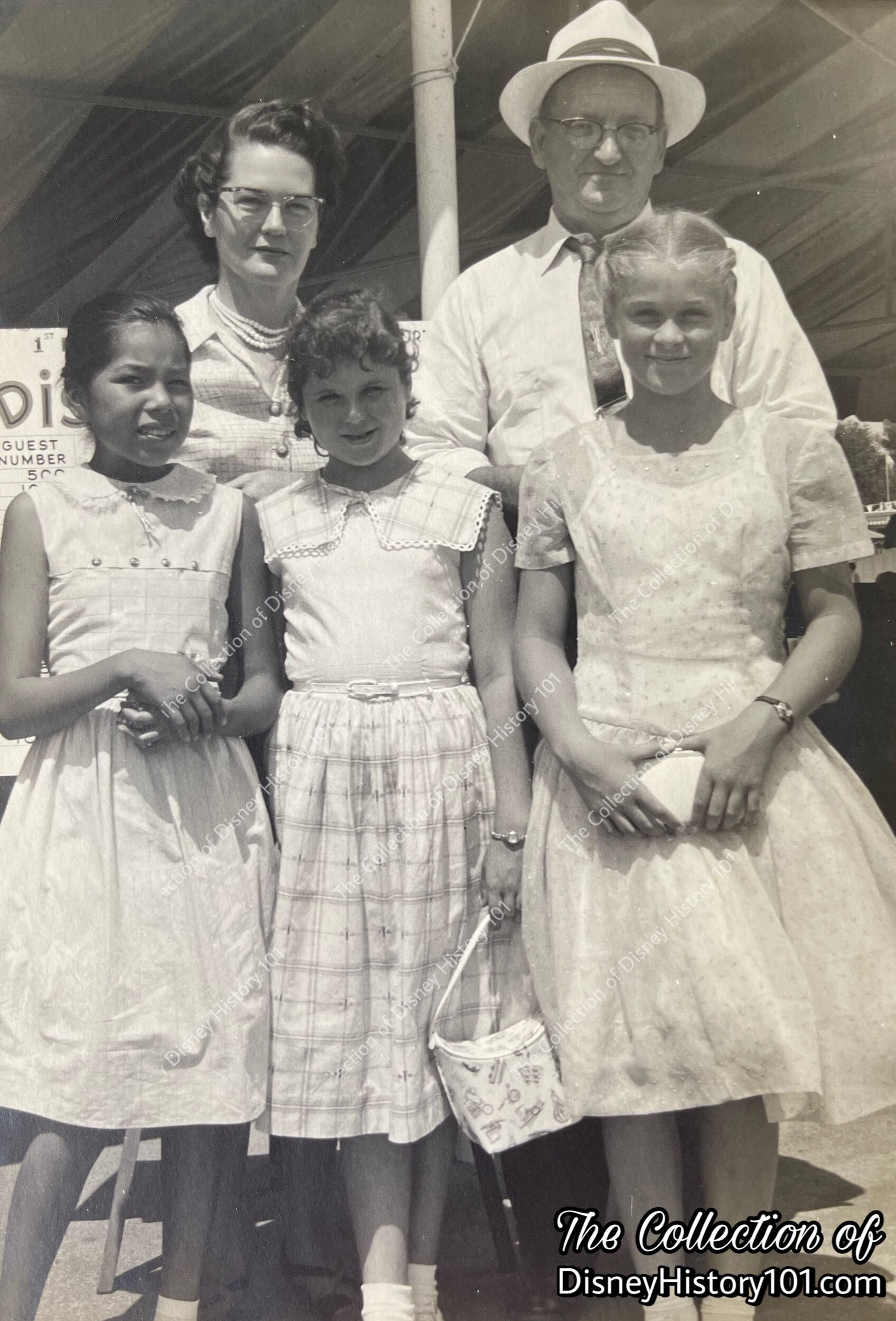
Holidayland Game Tent, NRC Festival held August 10th, 1958 ; Photo Credit : Fred Armstrong
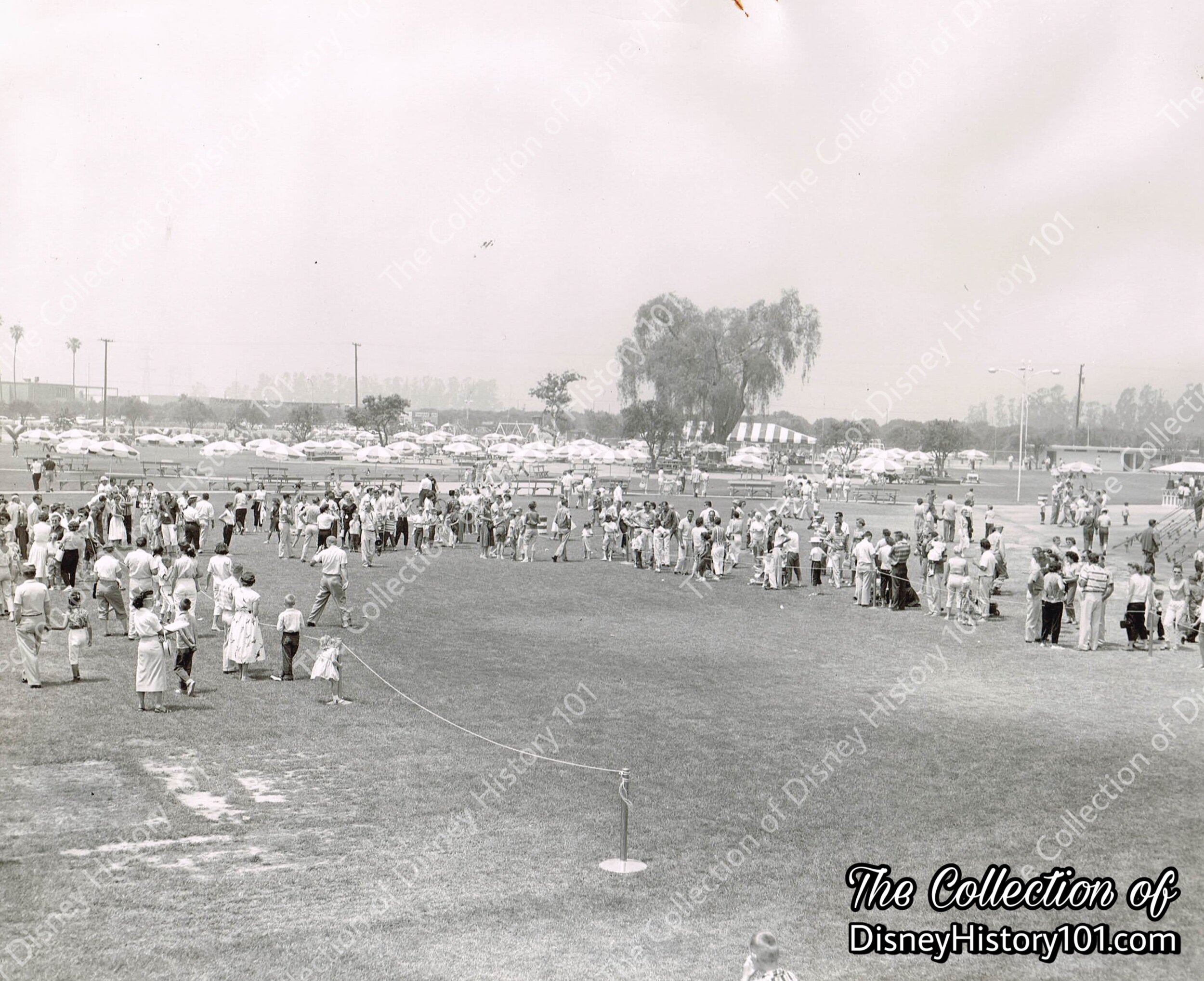
Holidayland Green
Speaking of games, Holidayland’s vast grassy lawn was home to numerous types of races during its years of operation. Both children and adults competed in relay races, wheelbarrow races, head-carrying races, potato sack races, and many more! Tug-of-war competitions, and games of horseshoes were also held here.
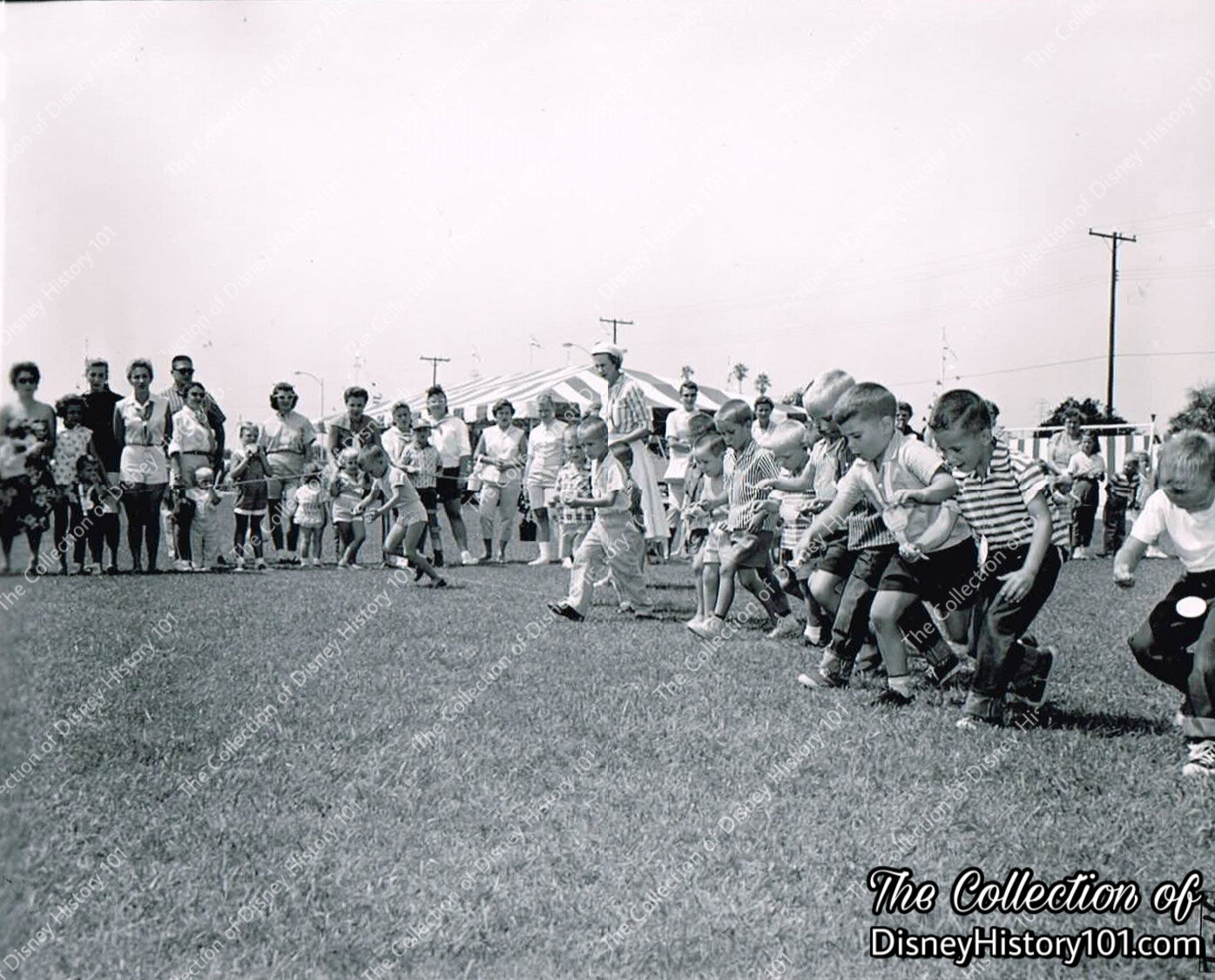
Holidayland Green
A children’s race at the Tubesales Family Festival.
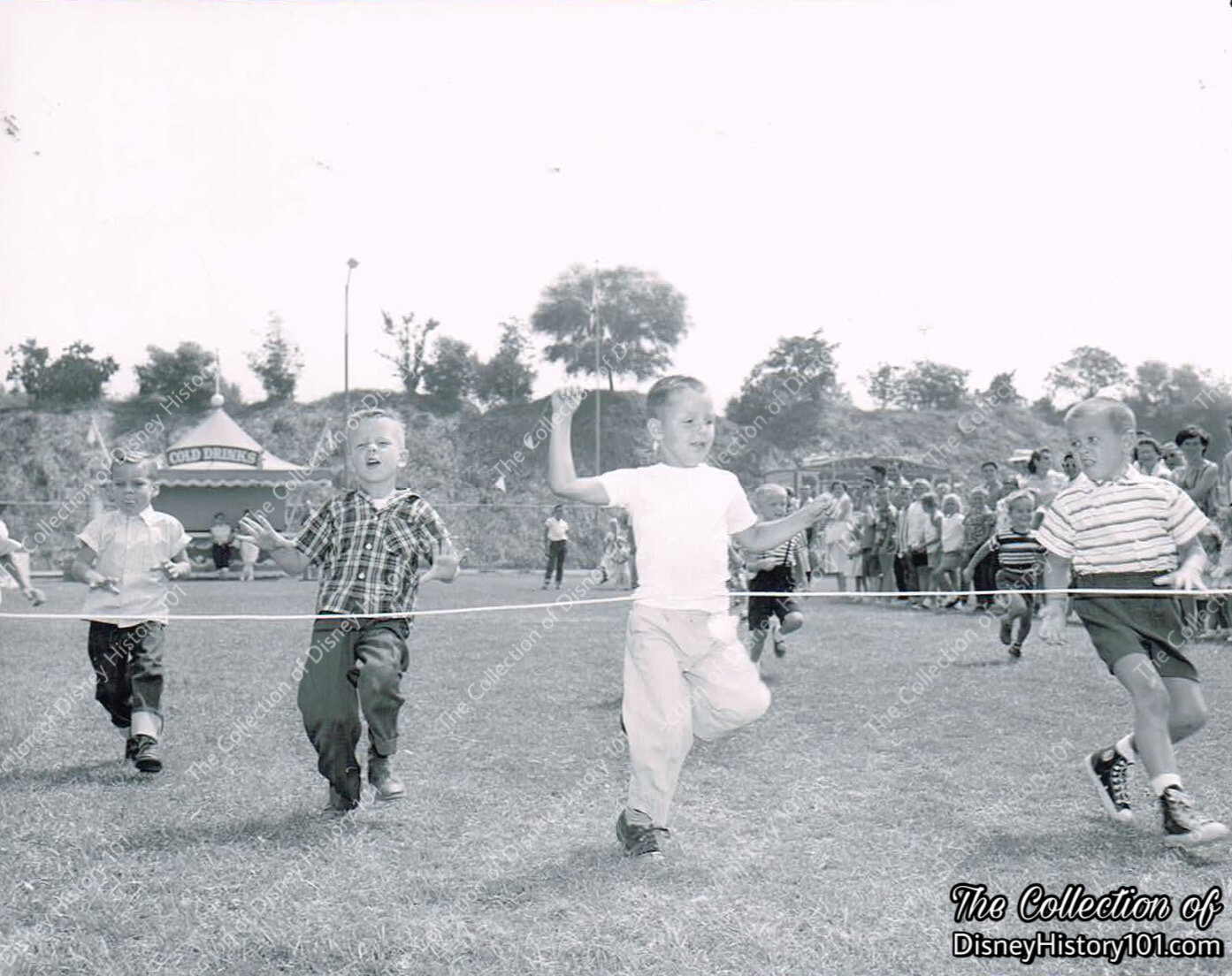
Holidayland Green
A children’s race at the Firestone Supervisor Club Picnic.
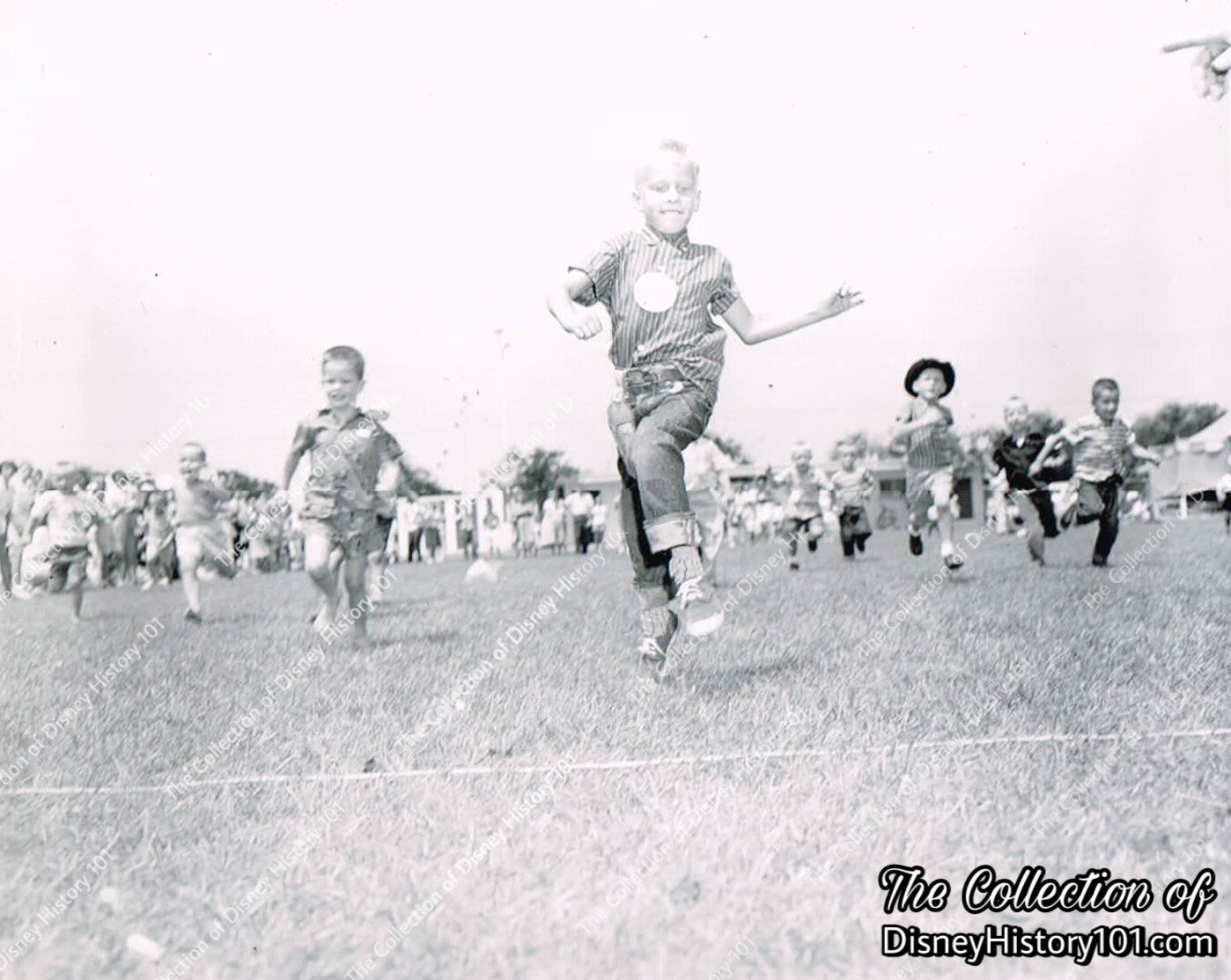
Holidayland Green
A children’s race at the Tubesales Family Festival.
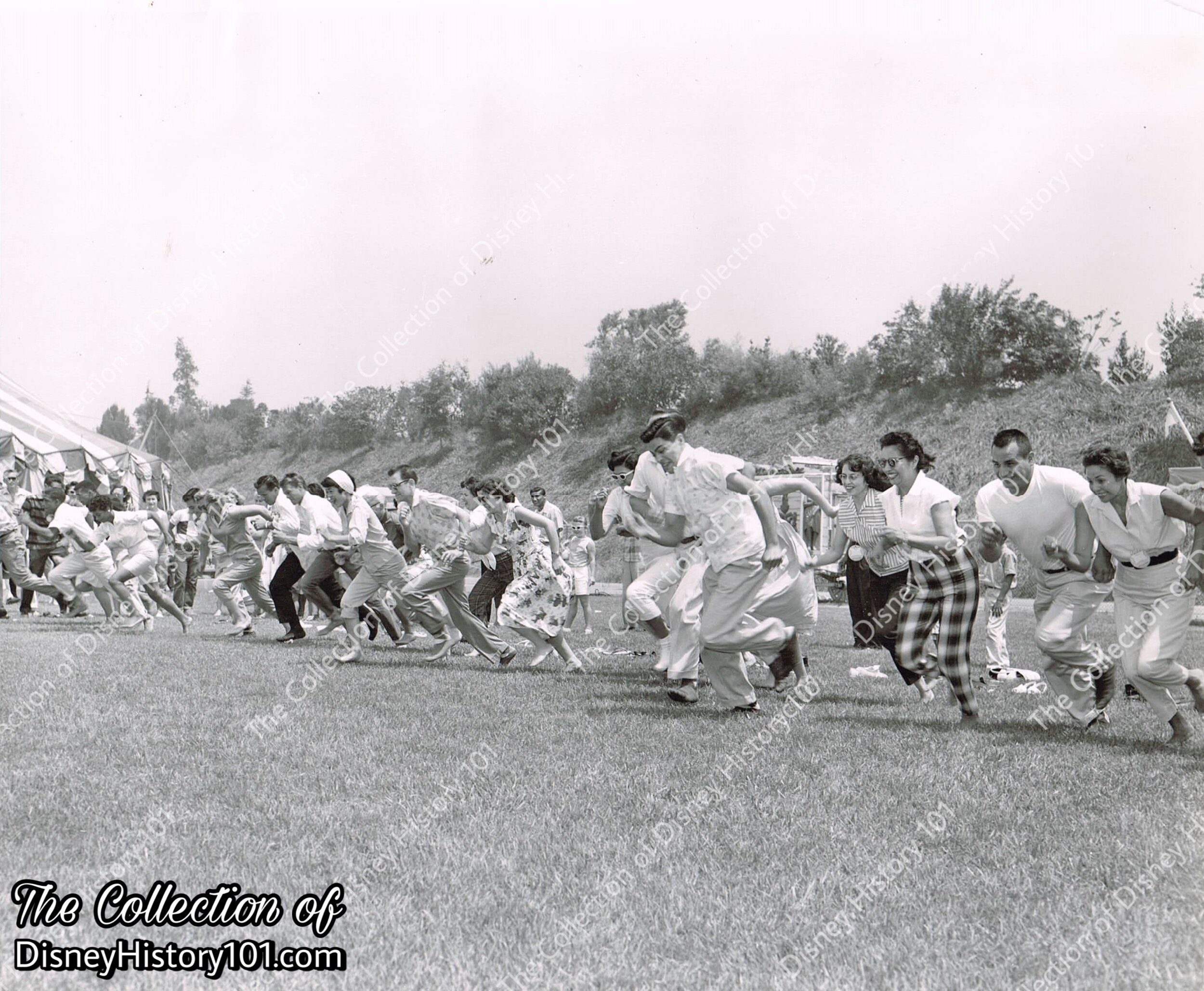
Holidayland Green
Children of all ages engage in a friendly competition at an unidentified event.
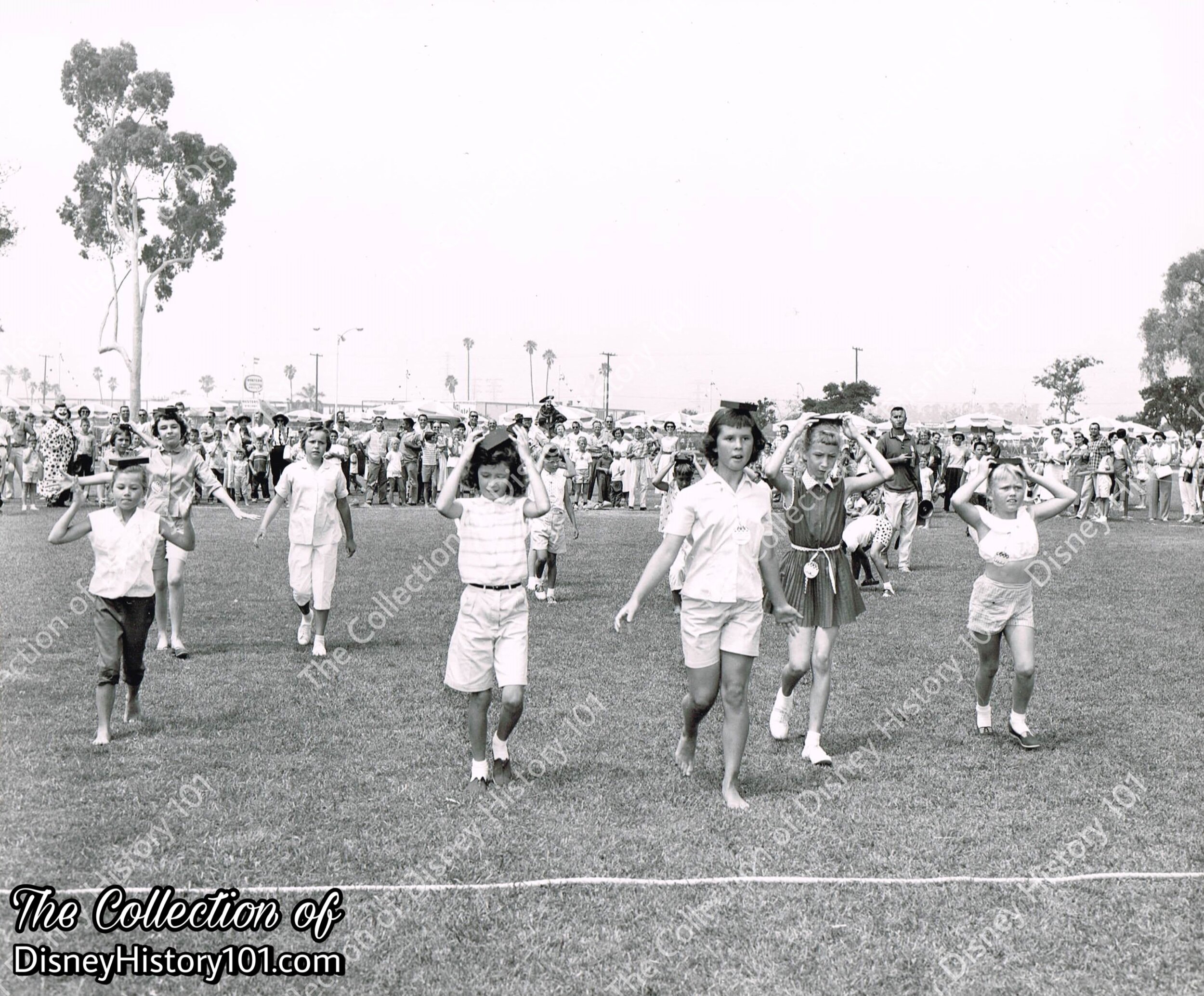
Holidayland Green
A girls’ head-balancing race.
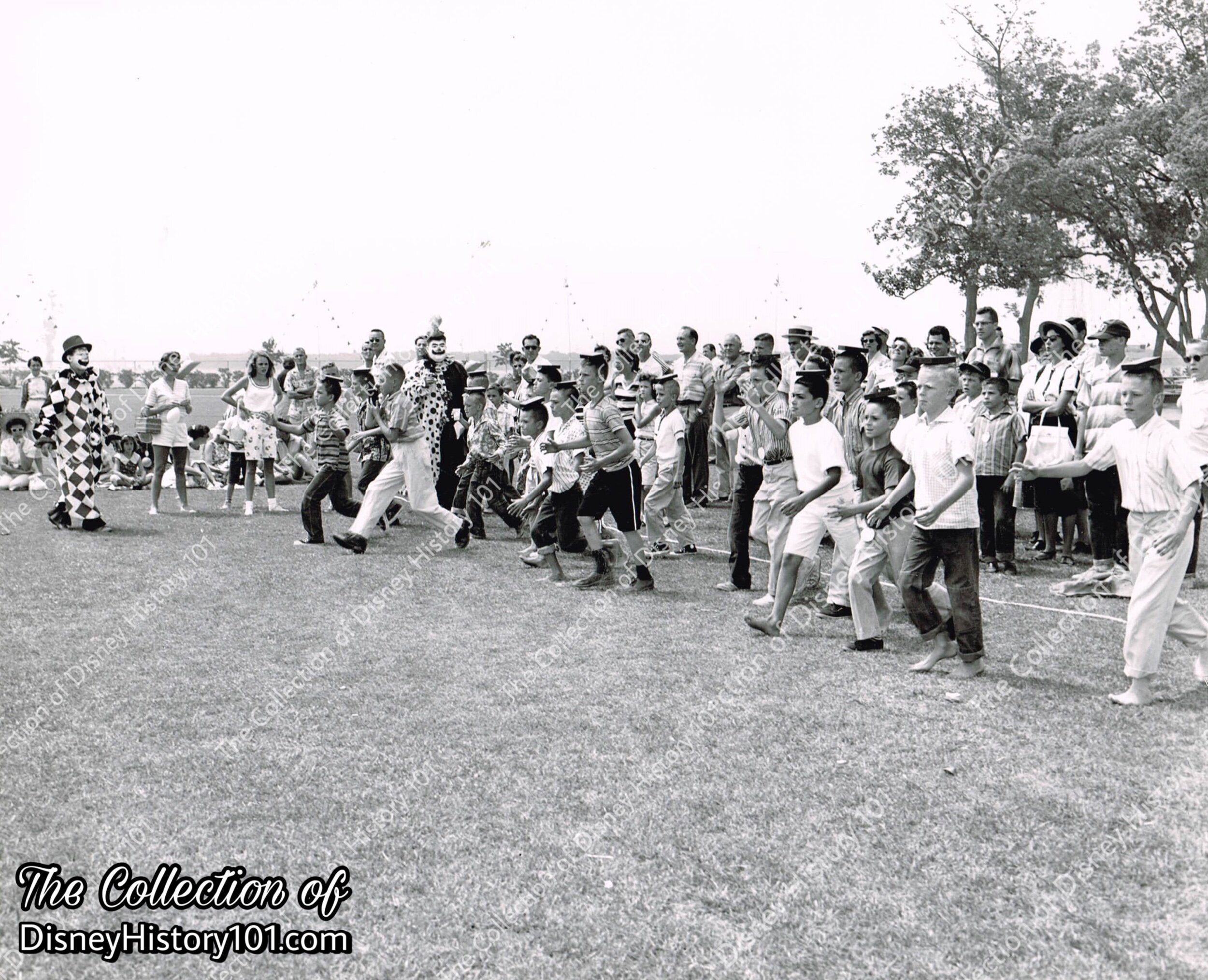
Holidayland Green
A boys’ head-balancing race.
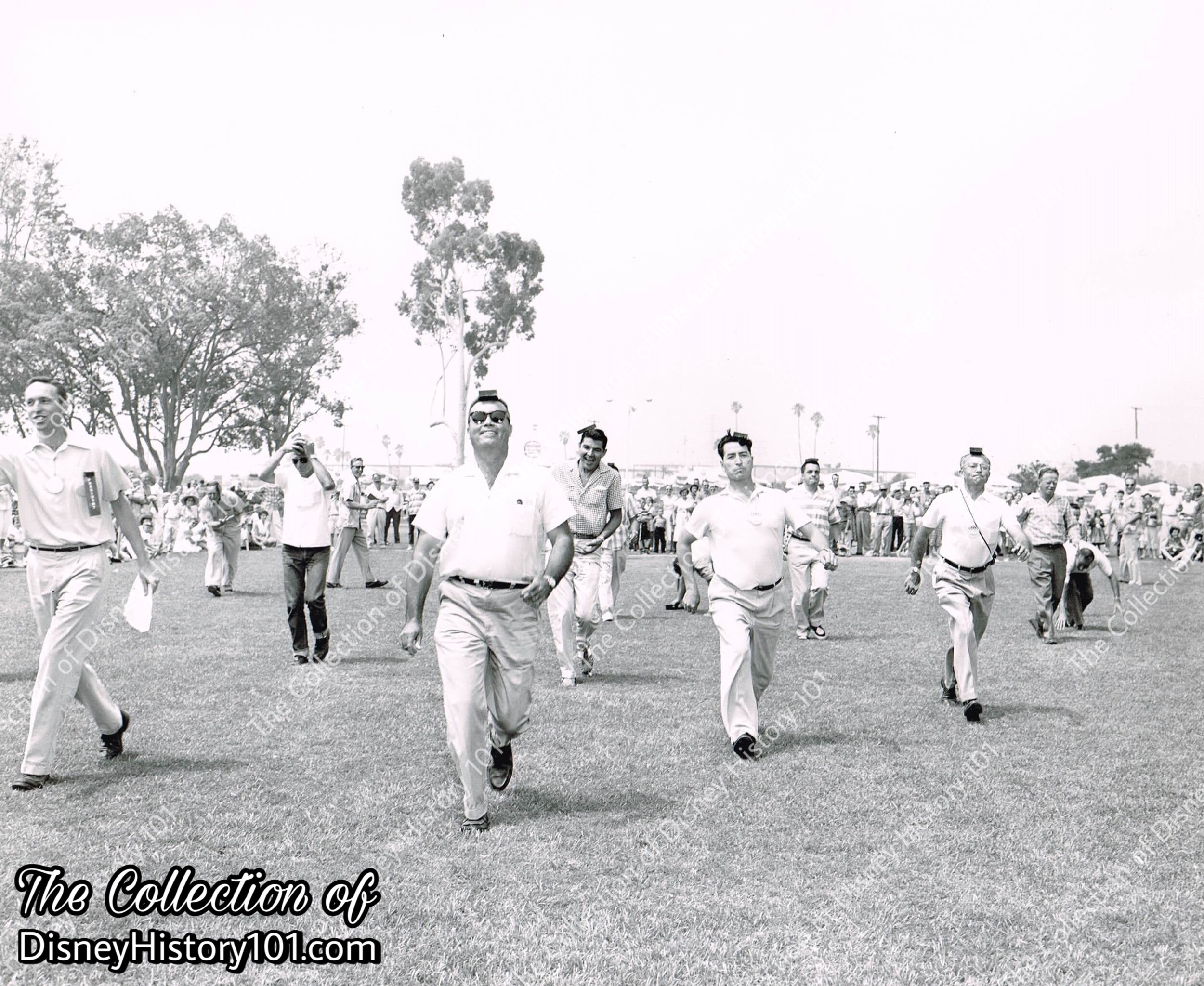
Holidayland Green
A mens’ head-balancing race.
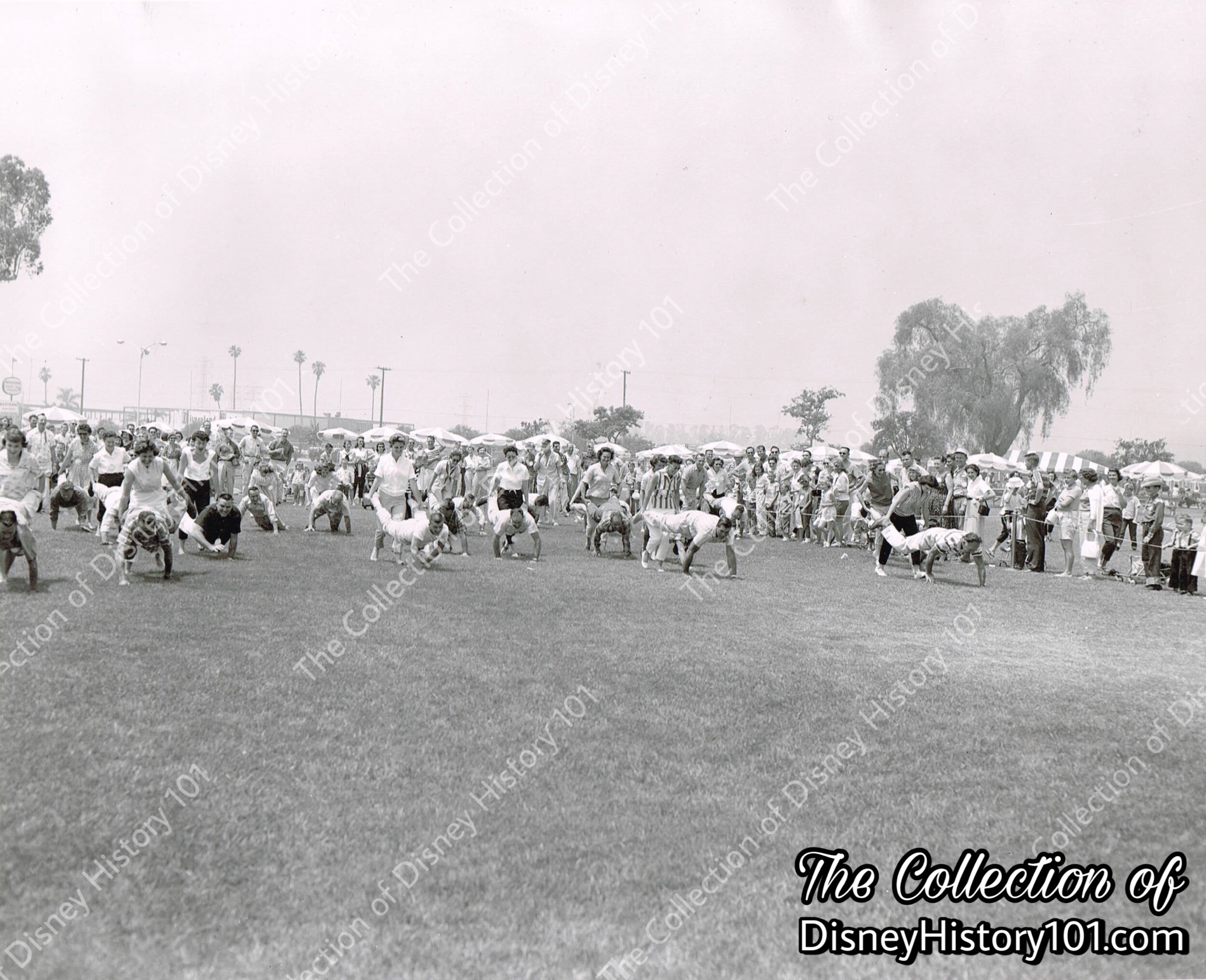
Holidayland Green
Wheelbarrow races were a common sight.
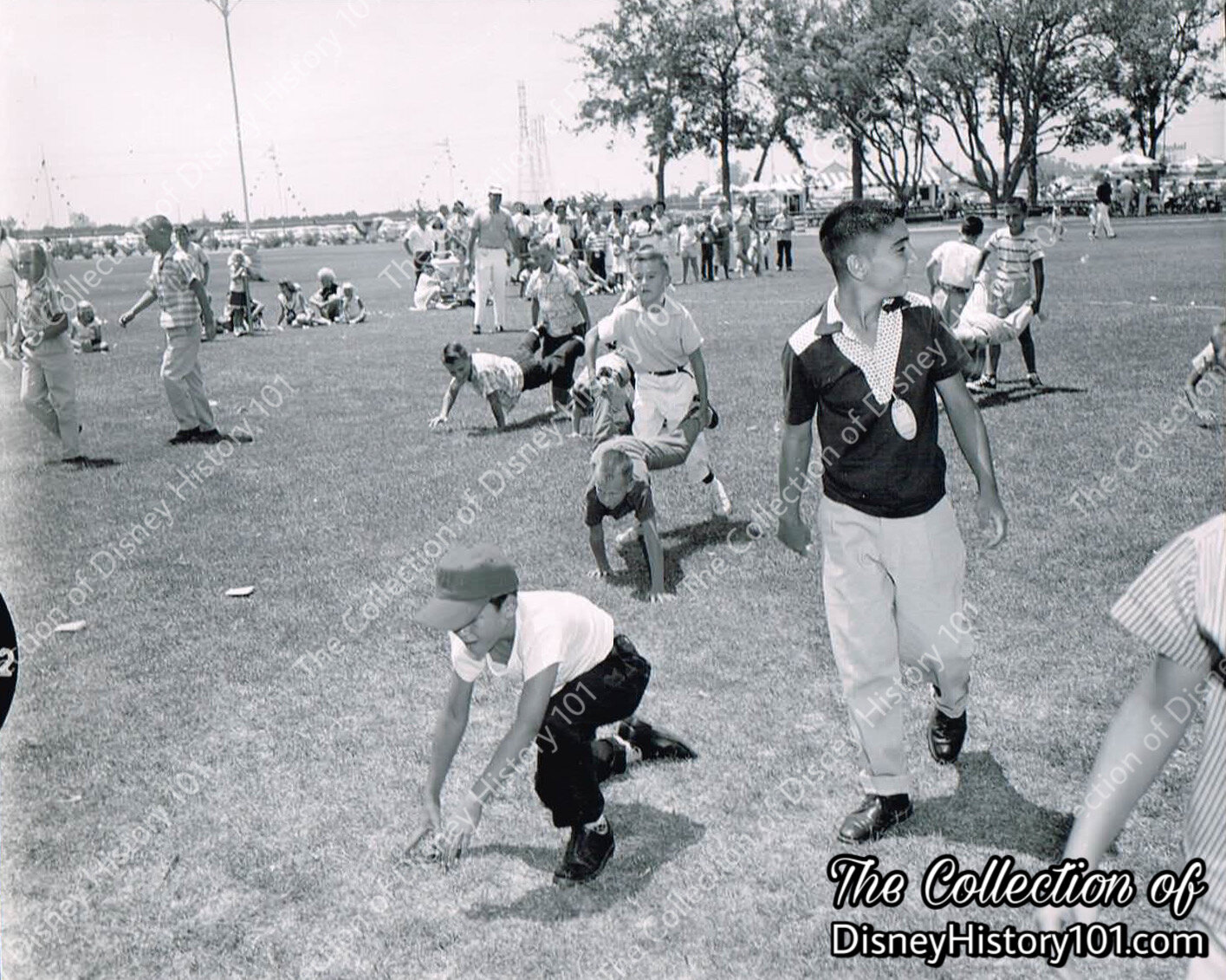
Holidayland Green
Wheelbarrow races at the Certified & S. Artan Families Picnic.
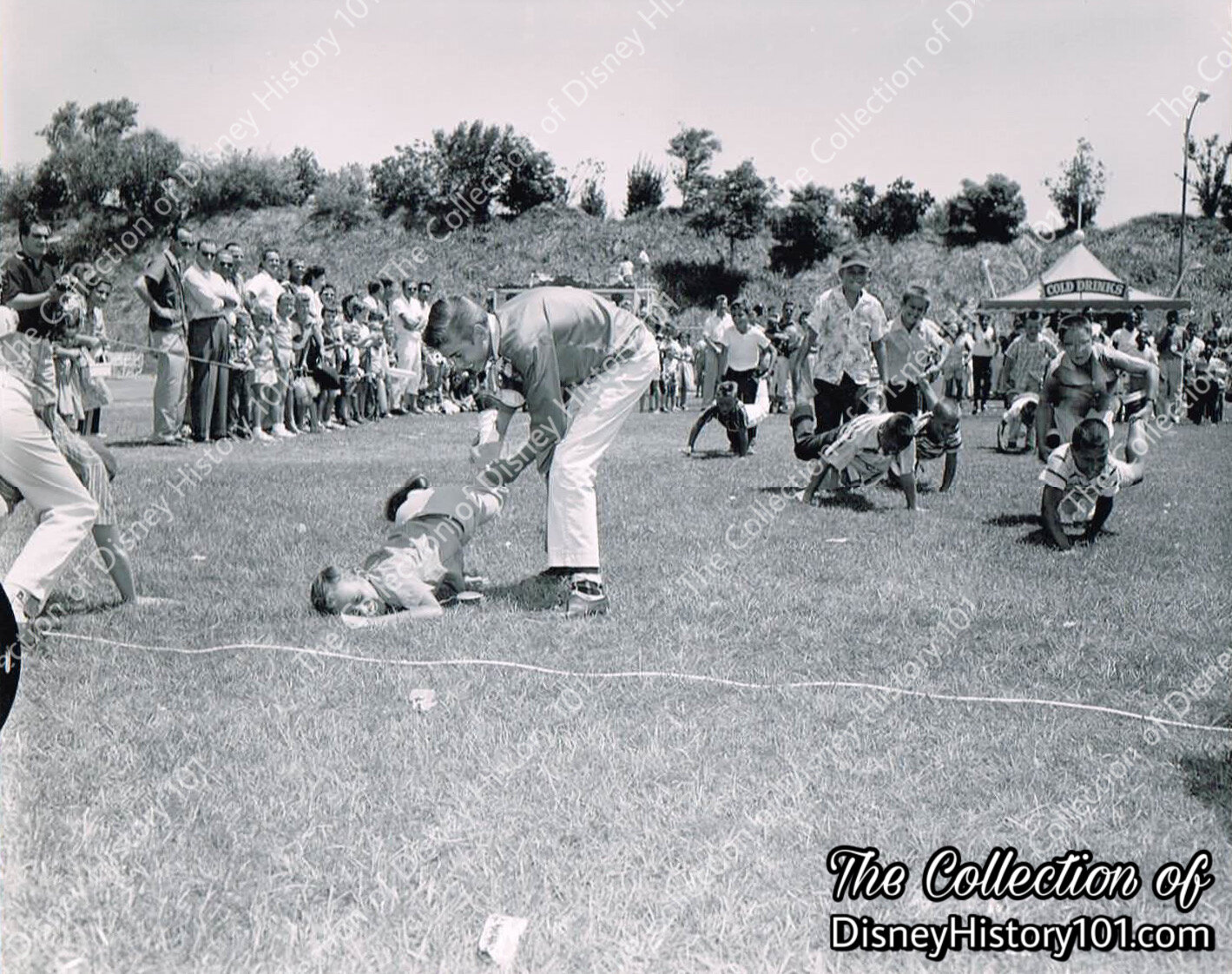
Holidayland Green
Another Vintage View of wheelbarrow races at the Certified & S. Artan Families Picnic.
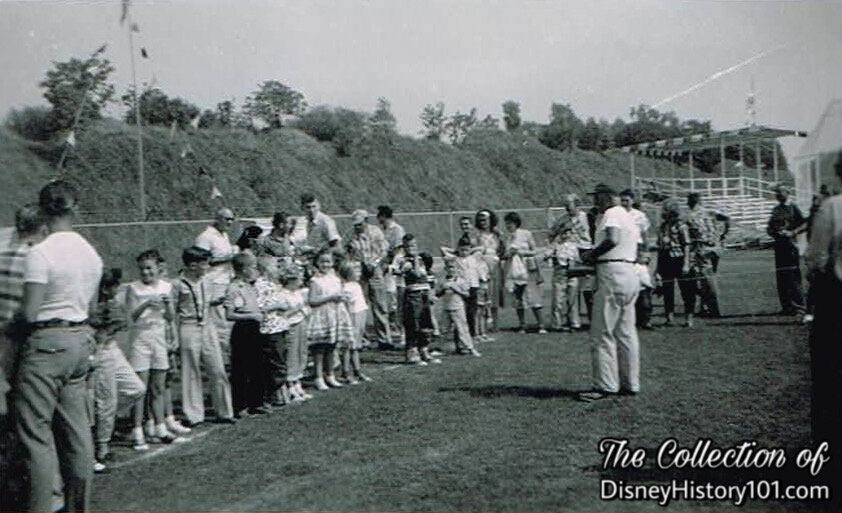
Holidayland Green
Instructions of another competition are explained to the Electrodata Family Festival game contestants.
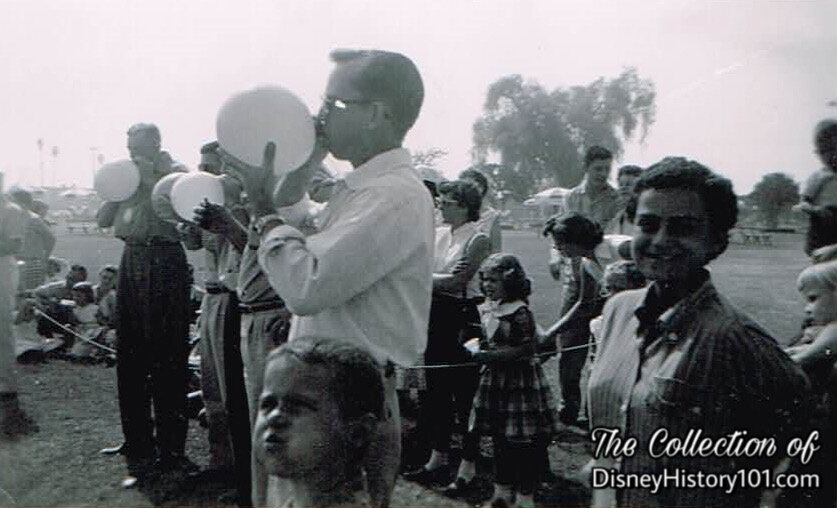
Holidayland Green
Adult guests of the Electrodata Family Festival prepare balloons for another competition.
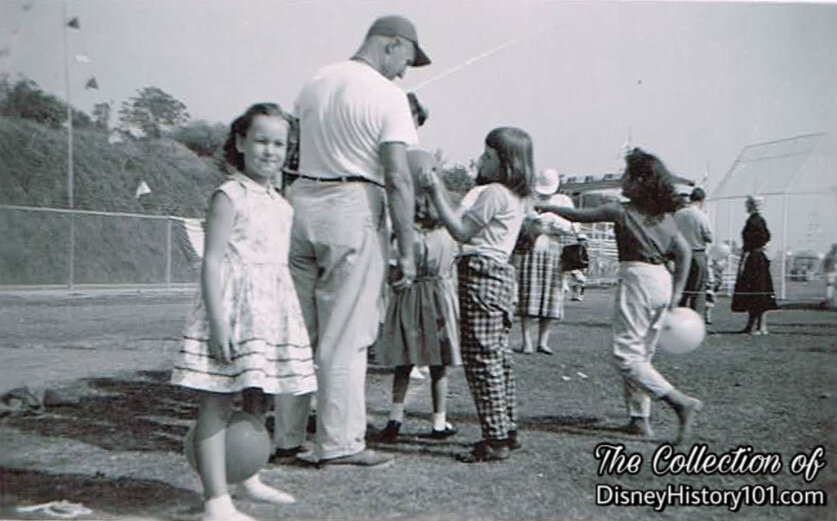
Holidayland Green
Once the balloons are ready, the young guests of Electrodata Family Festival await the beginning of the games!

Holidayland Green
The children of the Electrodata Family Festival await their sacks, as they prepare for a Potato Sack Race.
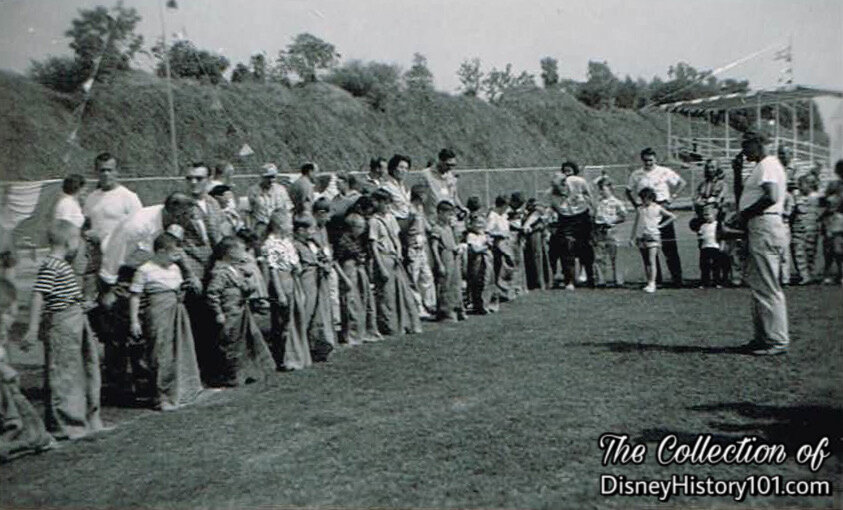
Electrodata Family Festival on Holidayland Green
The children of the Electrodata Family Festival prepare for an exciting Potato Sack Race to begin!
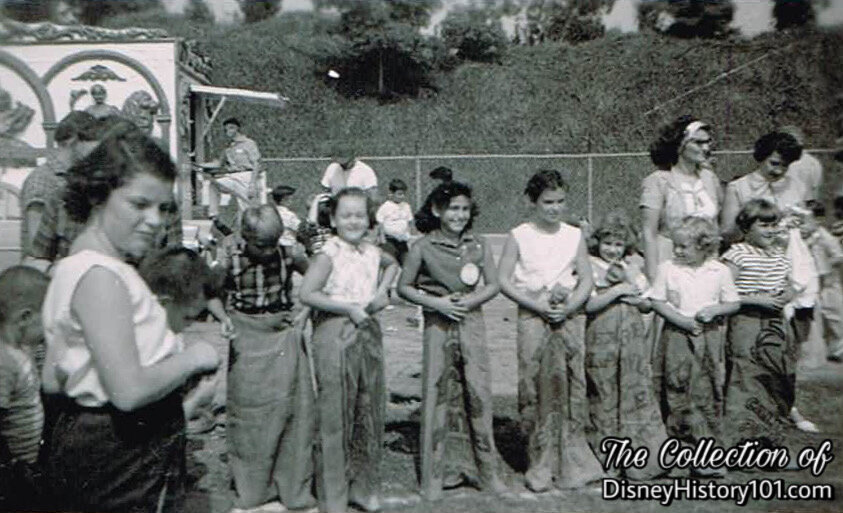
Holidayland Green
The children of the Electrodata Family Festival “get set” on the “mark” for the Potato Sack Race to commence!
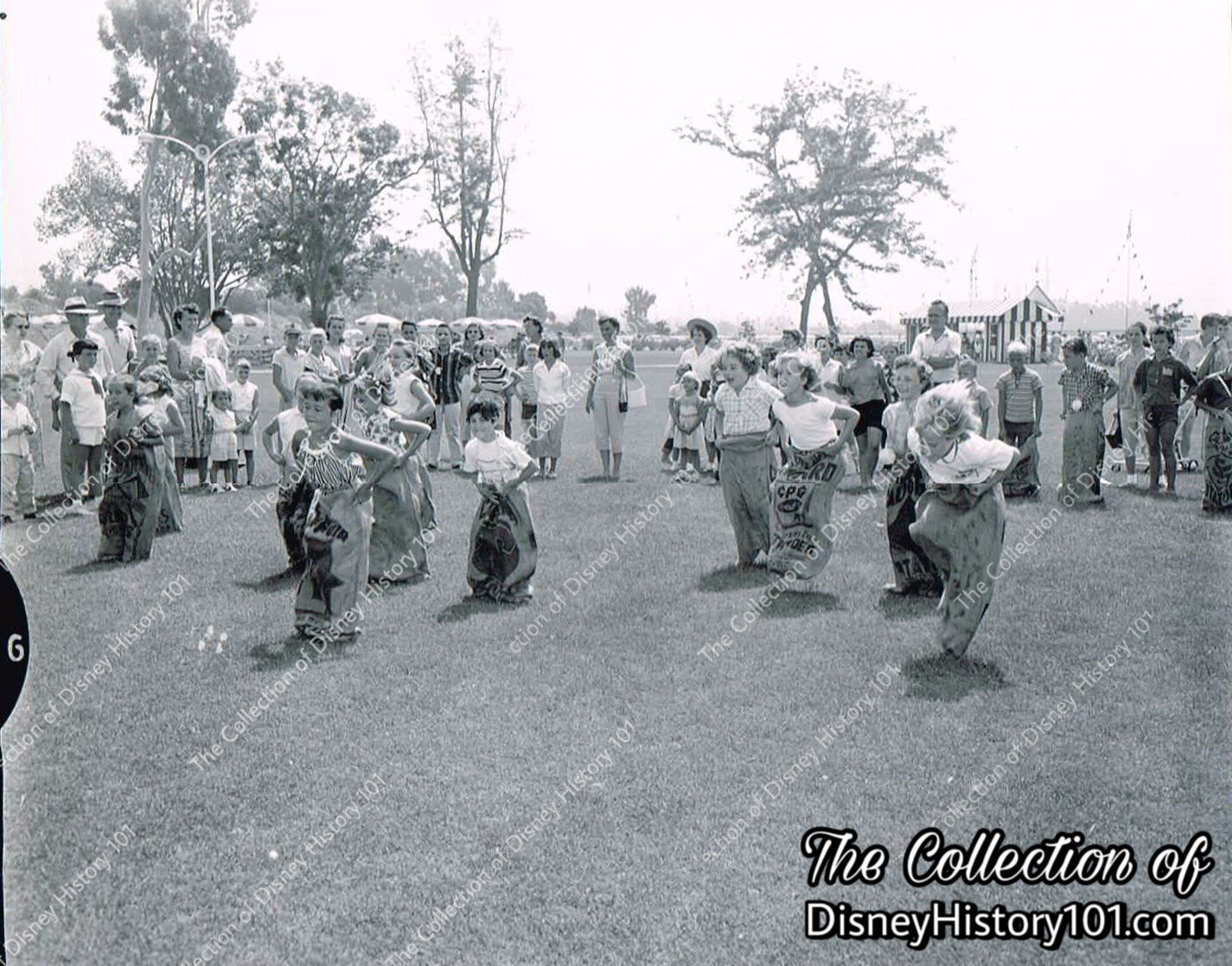
Holidayland Green
A potato sack race at the Southern California Gas Company Picnic.
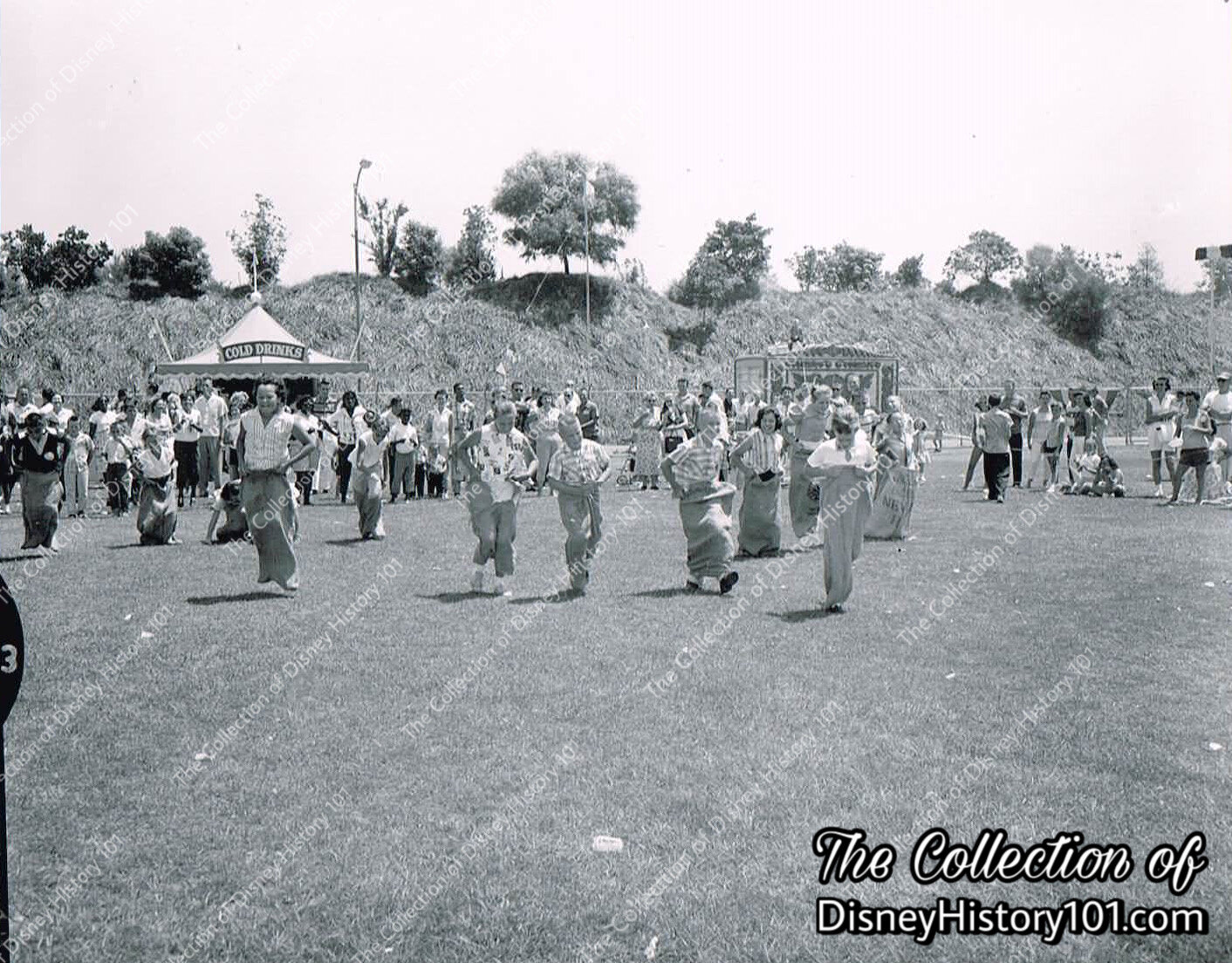
Holidayland Green
A potato sack race at the Certified & S. Artan Families Picnic.
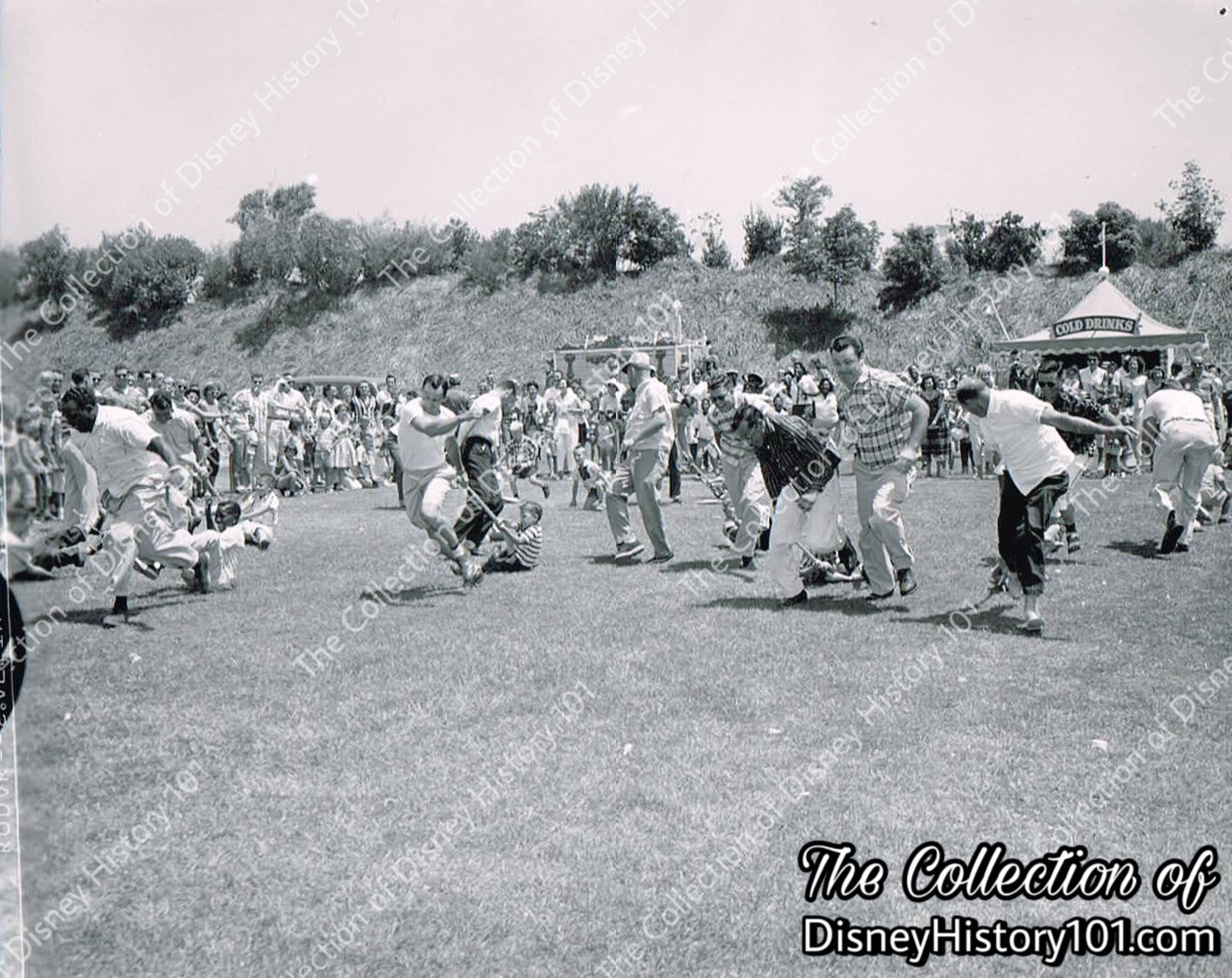
Holidayland Green
An unidentified competition (perhaps a three-legged race) ensues at the Certified & S. Artan Families Picnic.
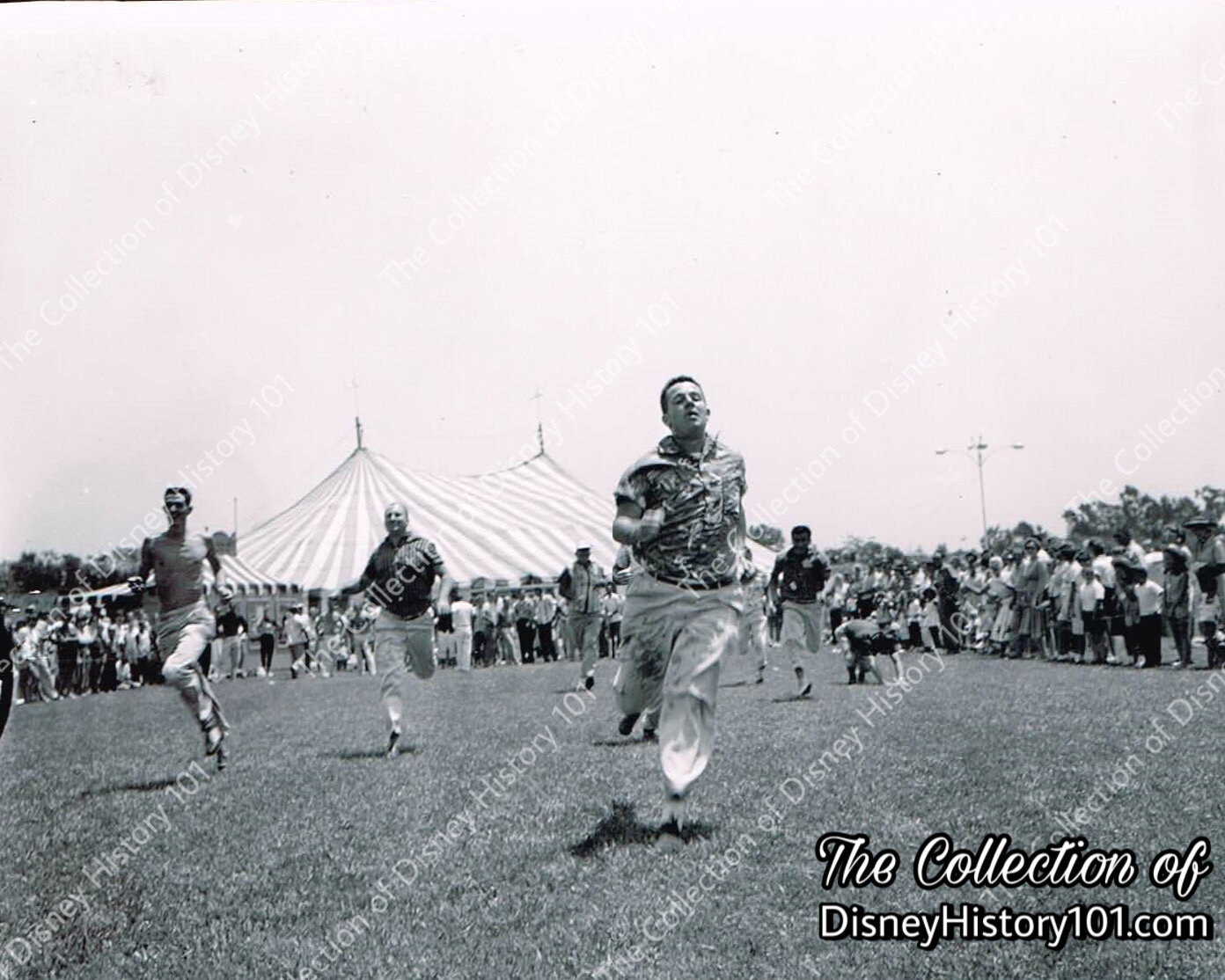
Holidayland Green
A race at the Moore Business Forms Rediforms Picnic.
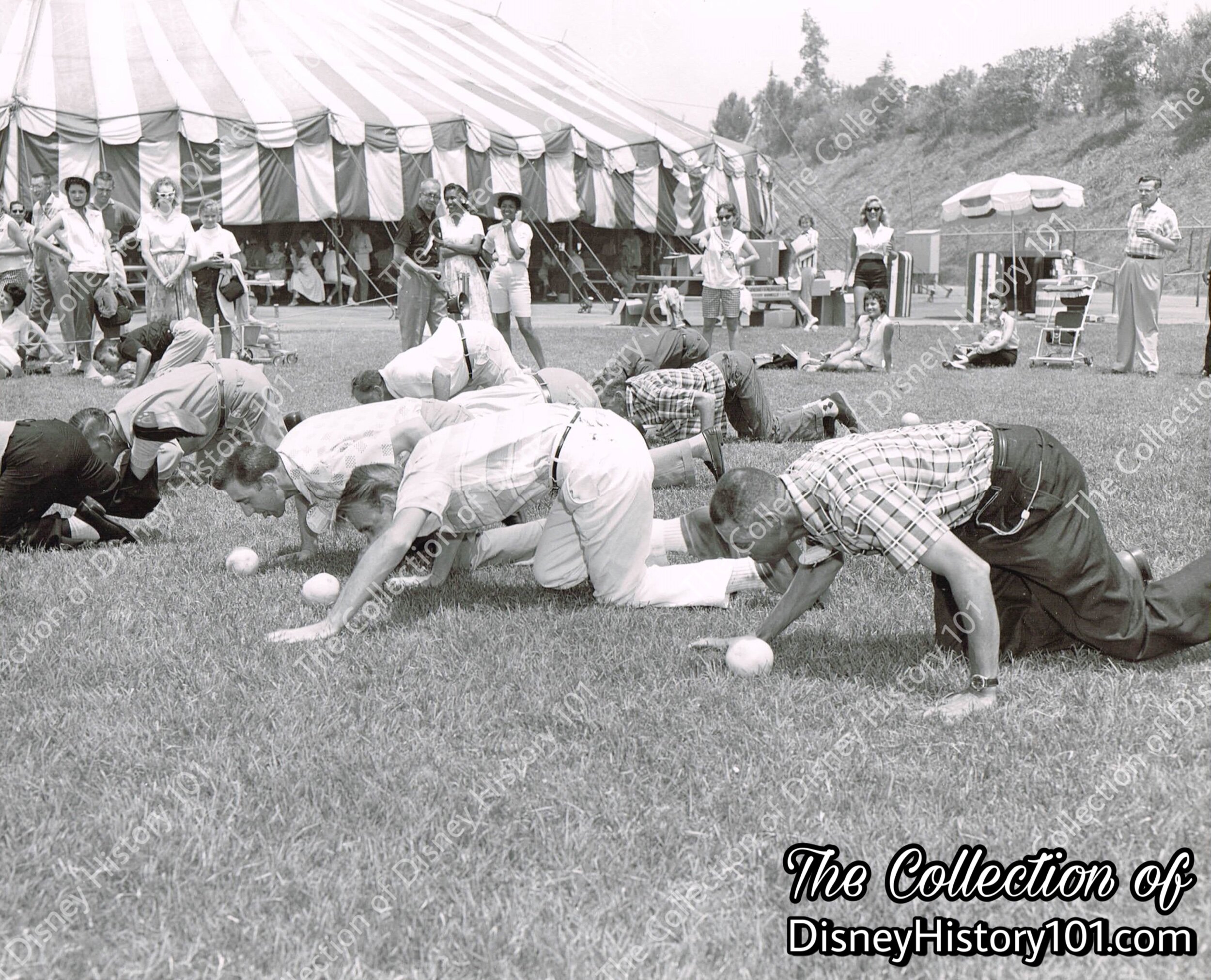
Holidayland Green
A fruit rolling race at an unidentified family picnic.
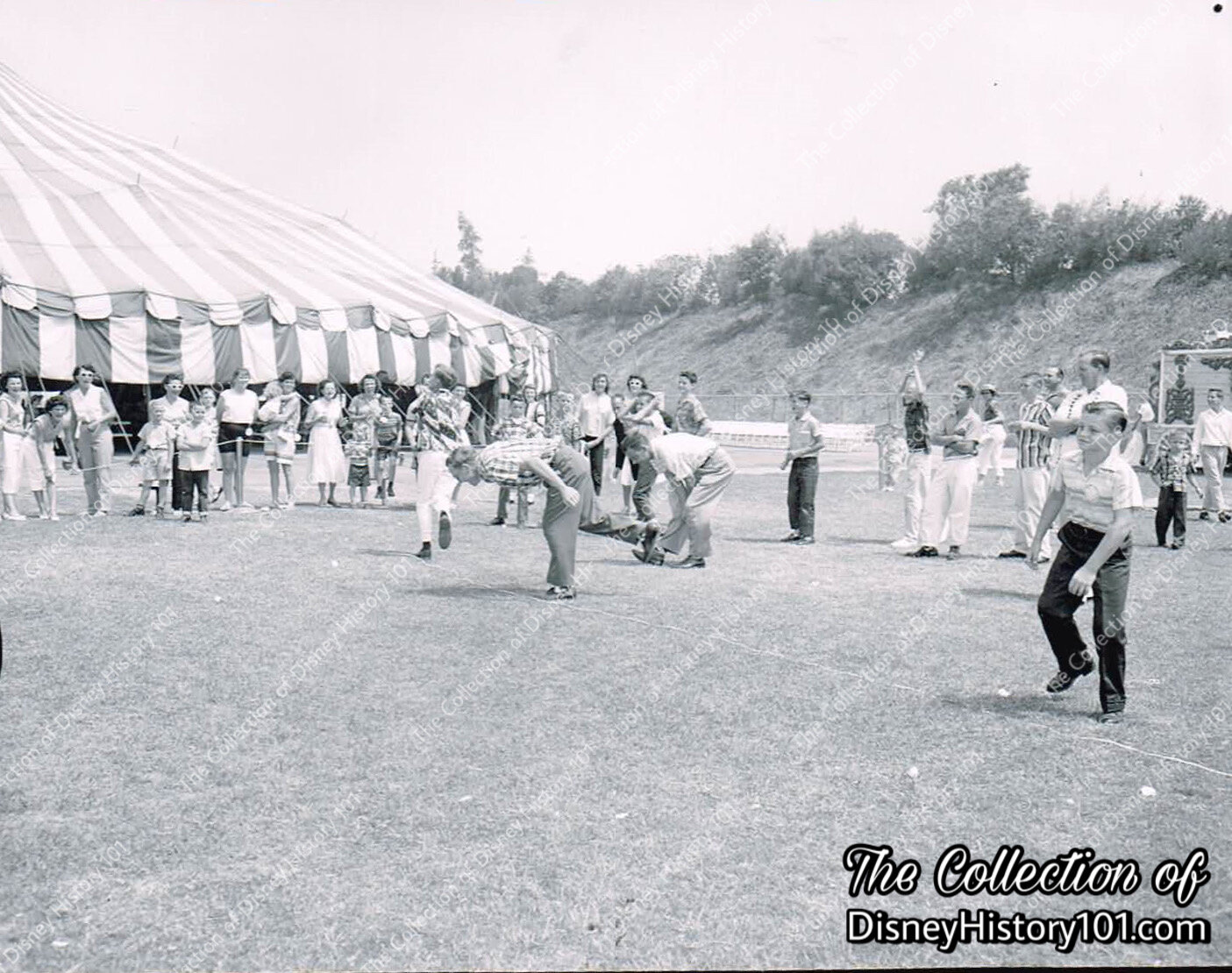
Holidayland Green
An unidentified competition at the Firestone Supervisor Club Picnic.
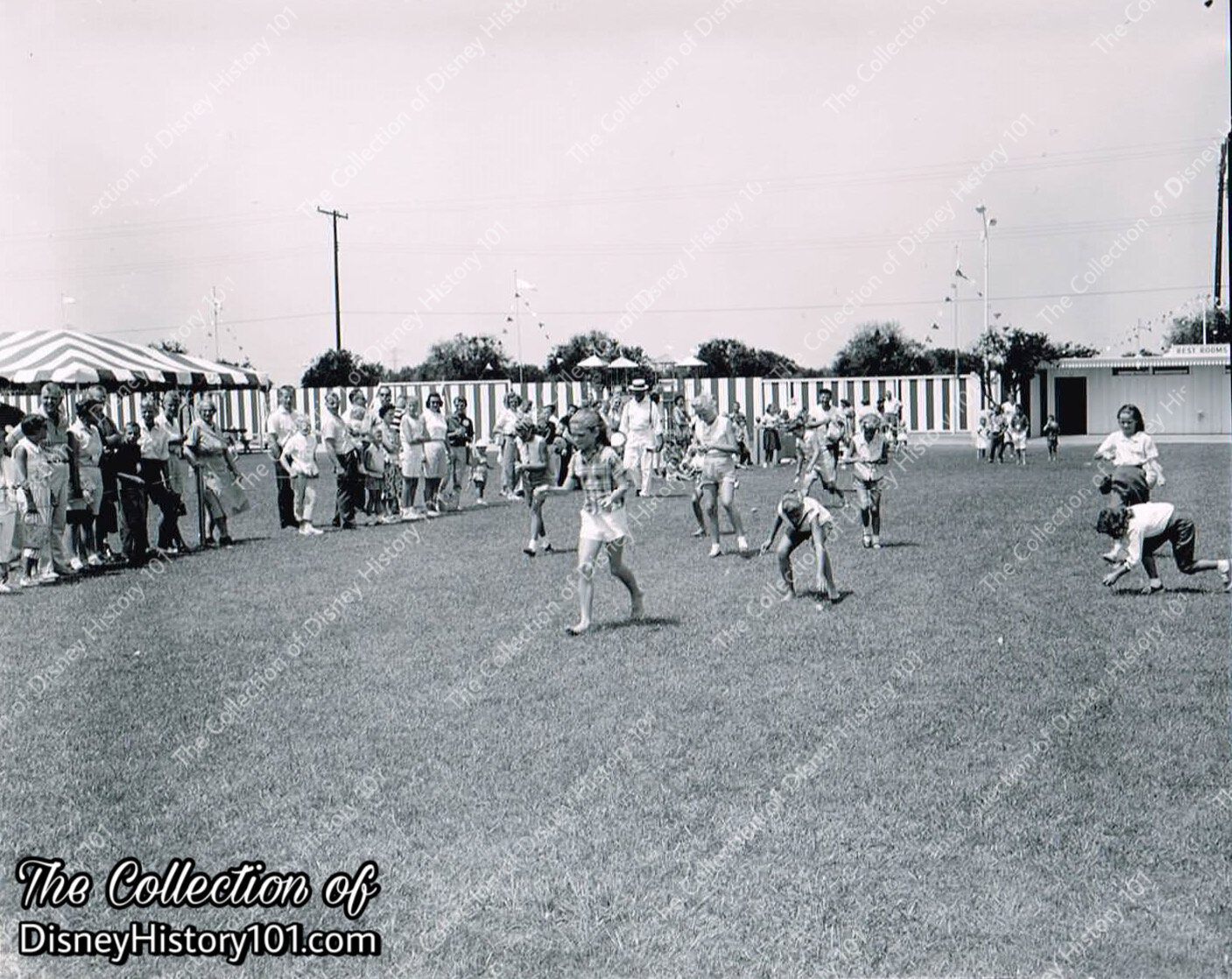
Holidayland Green
An unidentified children’s contest at the Telco Division Picnic.
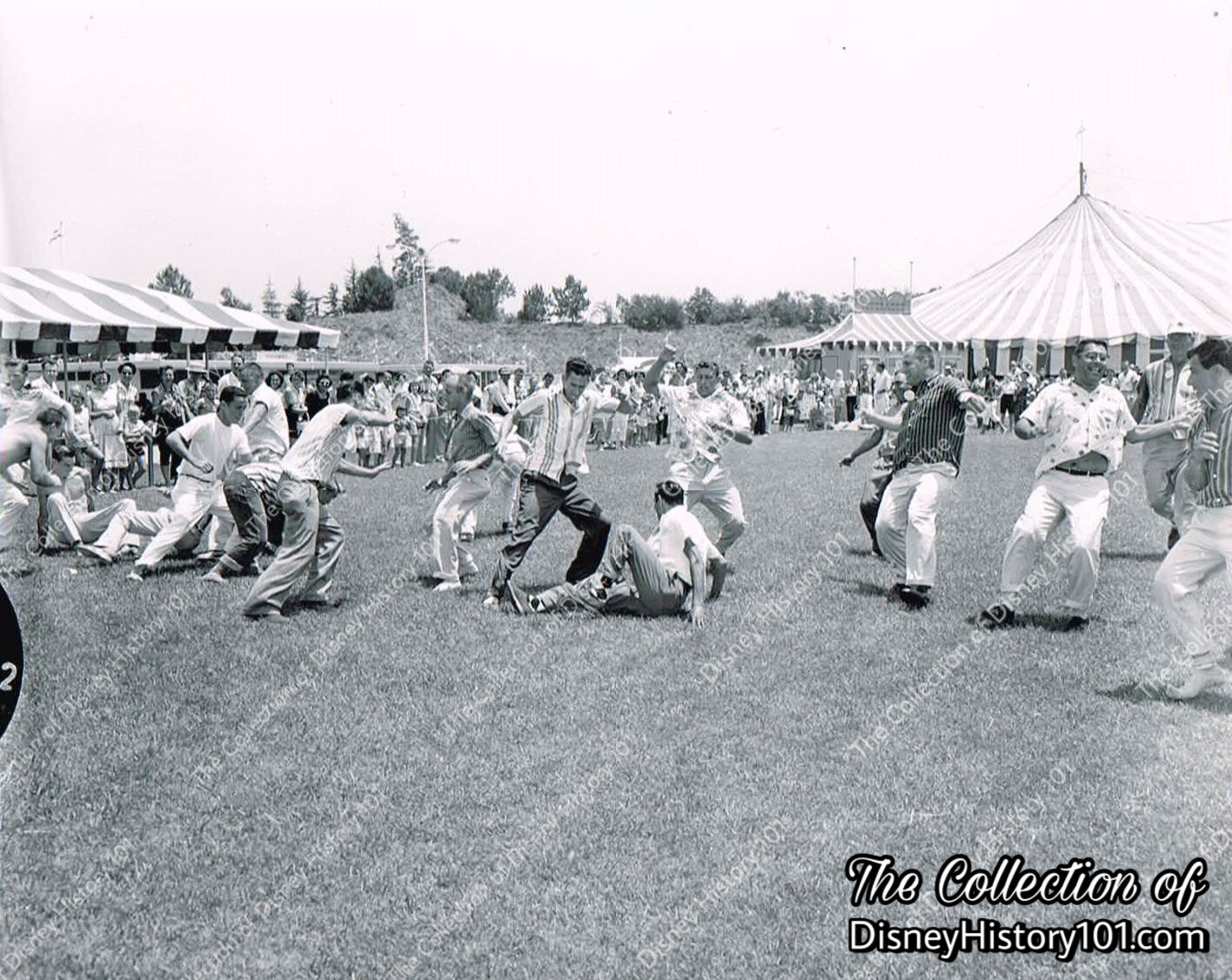
Holidayland Green
A men’s competition at the Moore Business Forms Rediforms Picnic.
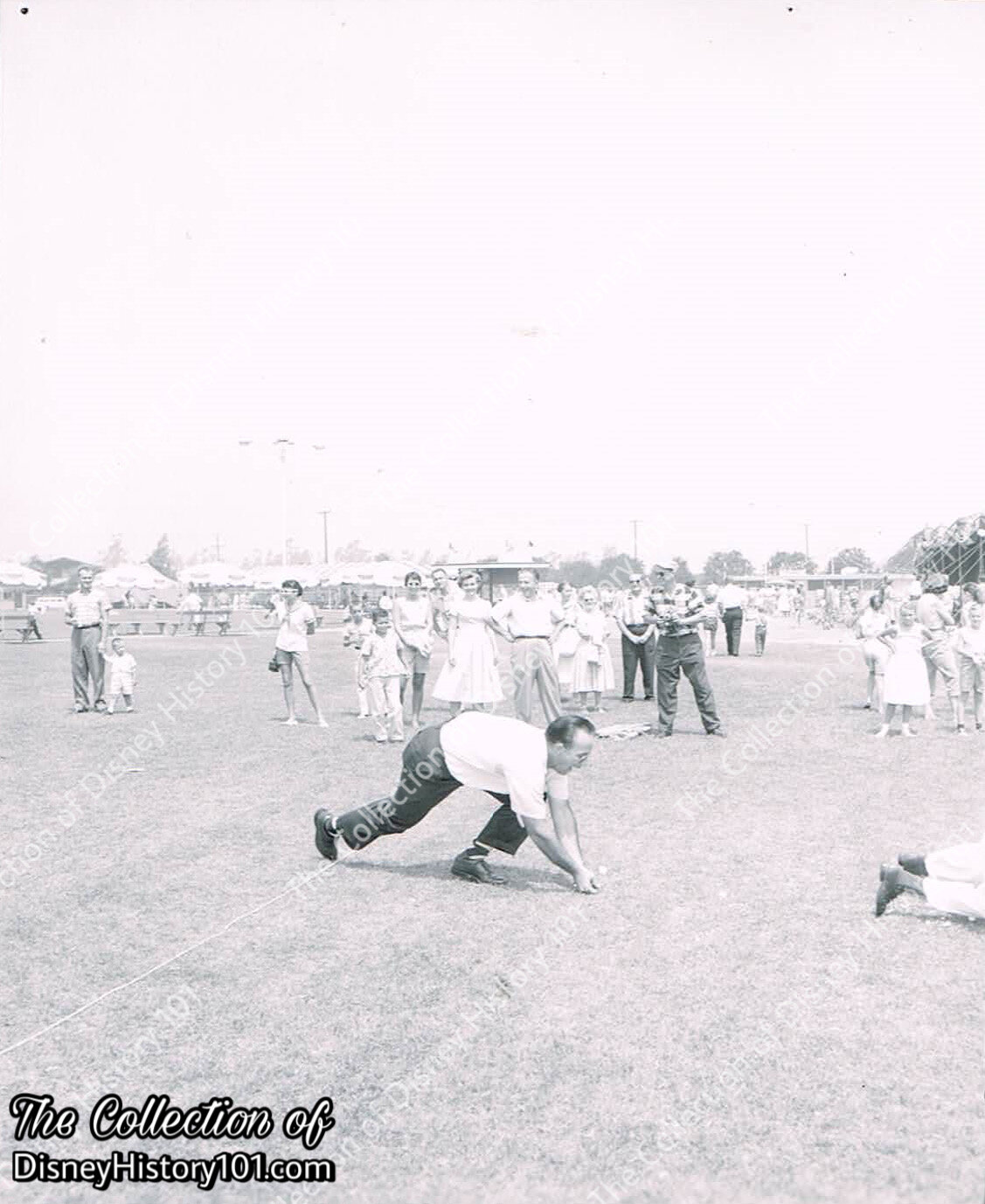
Holidayland Green
An unidentified race at the Firestone Supervisor Club Picnic.
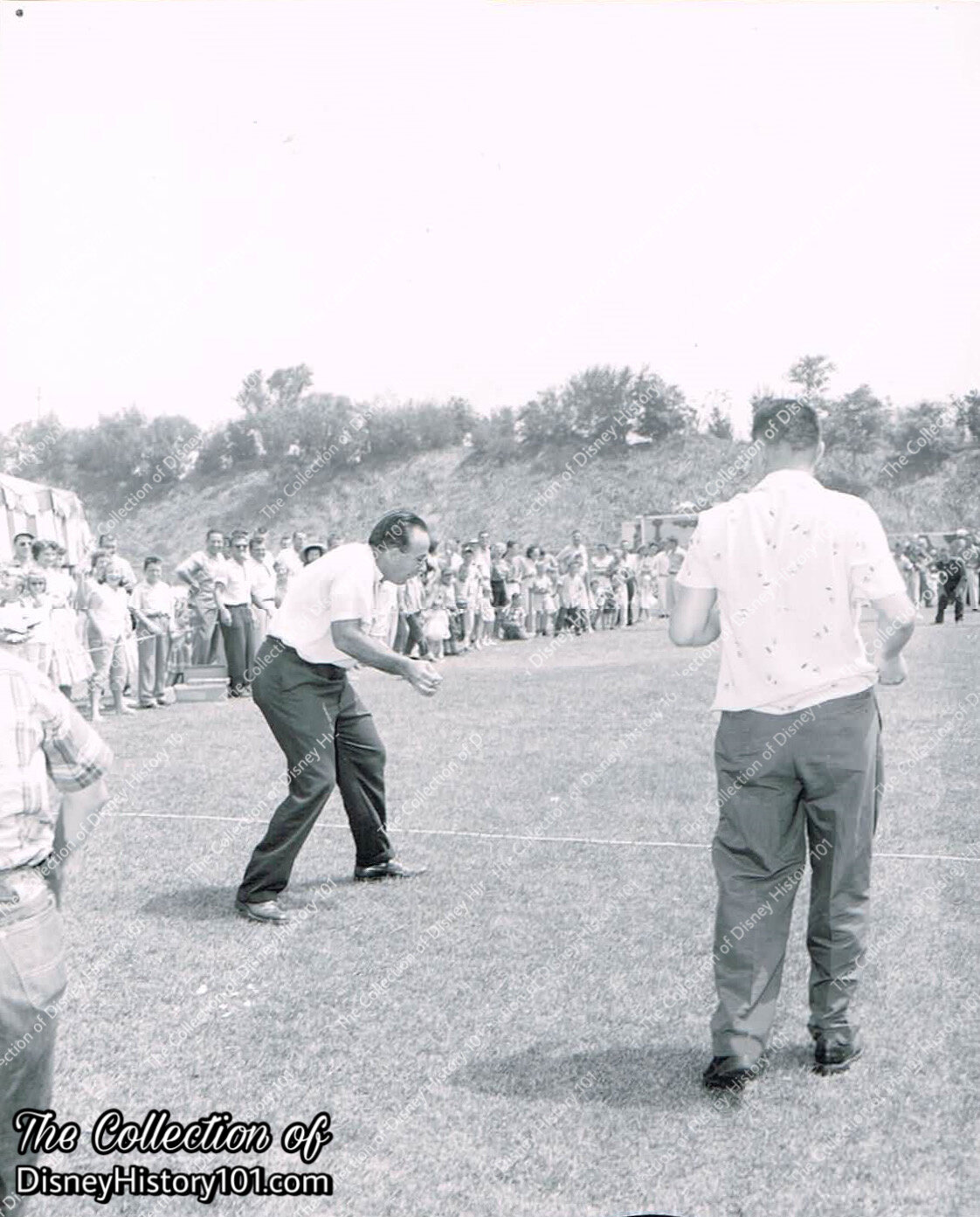
Holidayland Green
An unidentified race at the Firestone Supervisor Club Picnic.
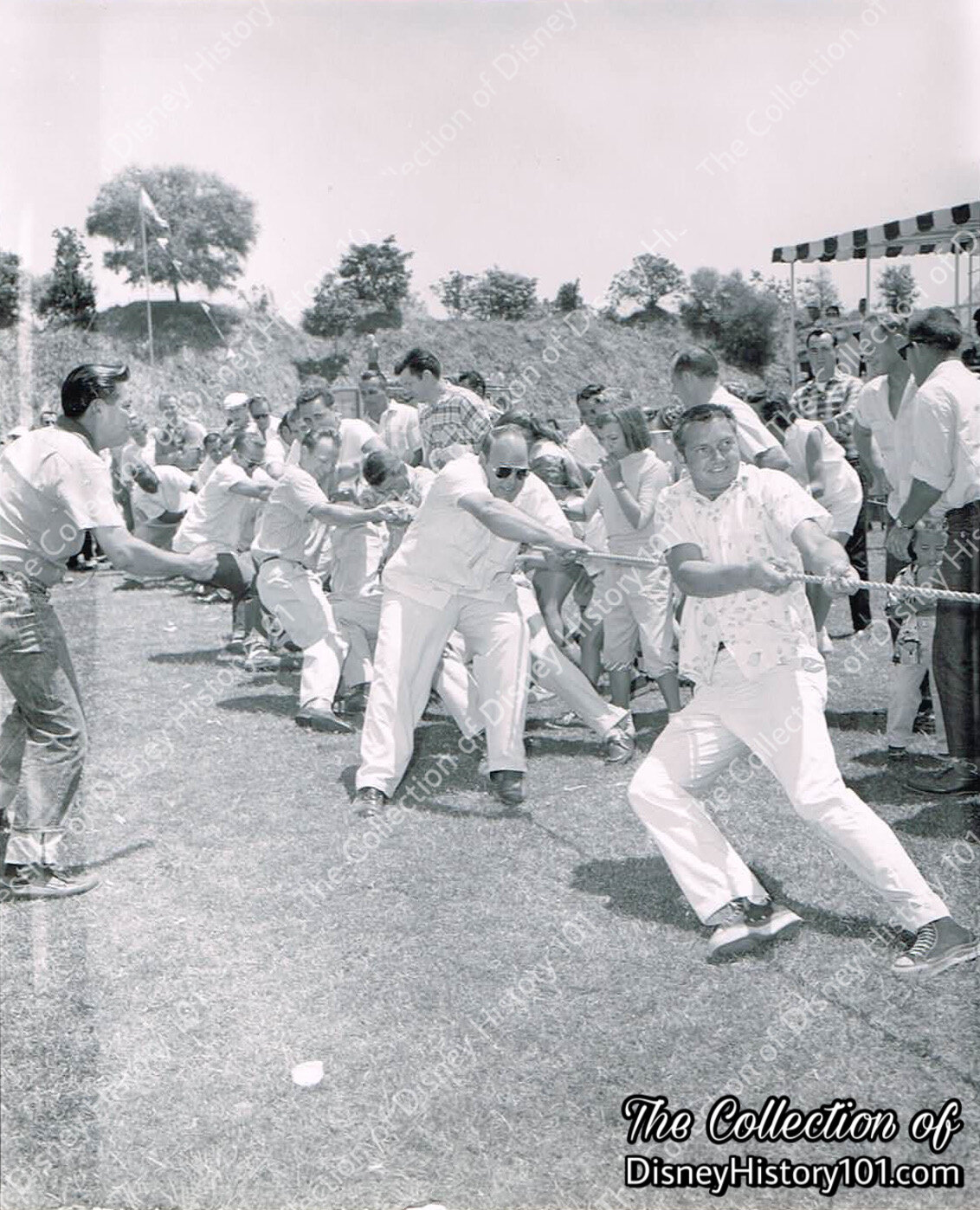
Holidayland Green
A tug-of-war at the Certified & S. Artan Families Picnic.
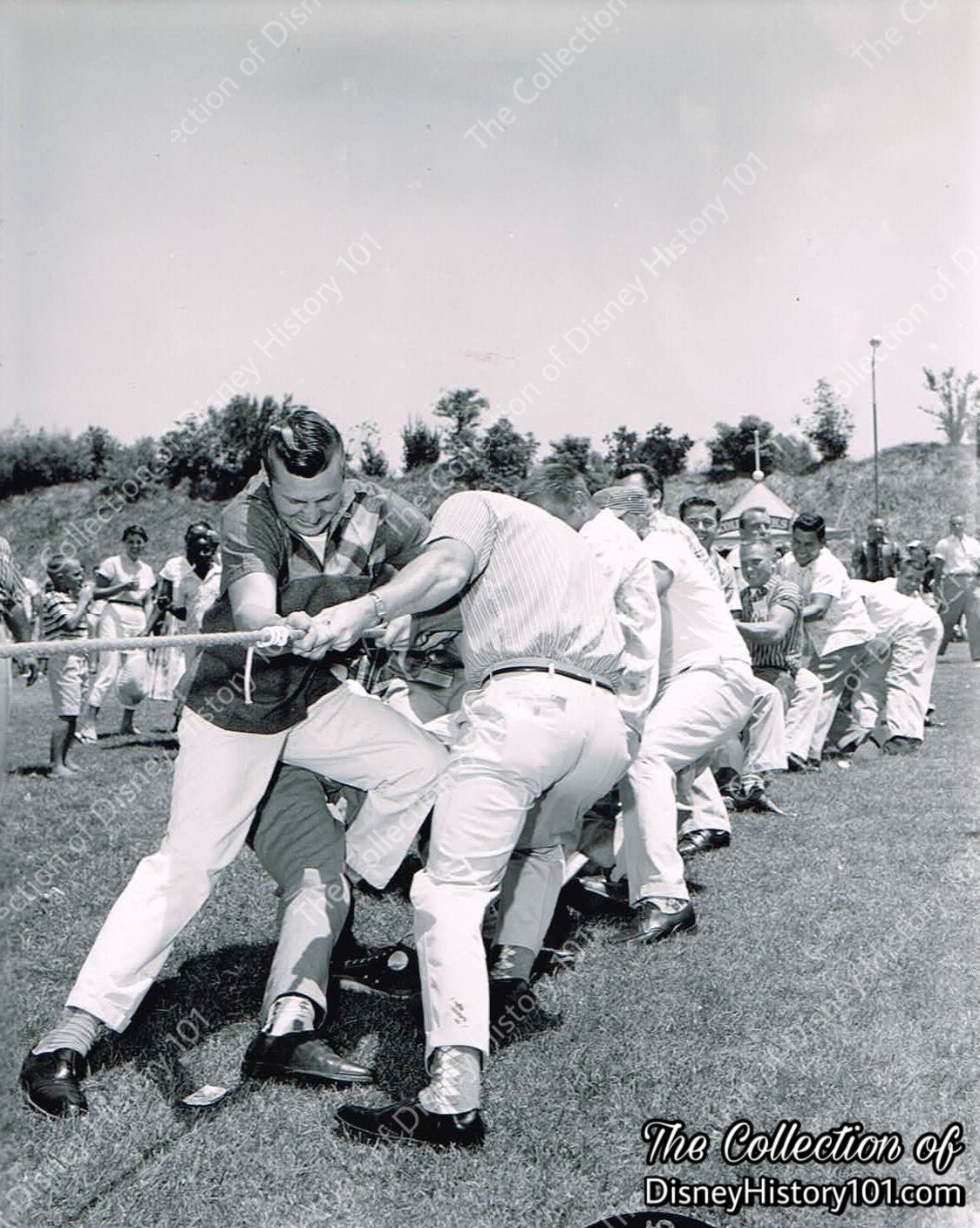
Holidayland Green
A tug-of-war at the Certified & S. Artan Families Picnic.
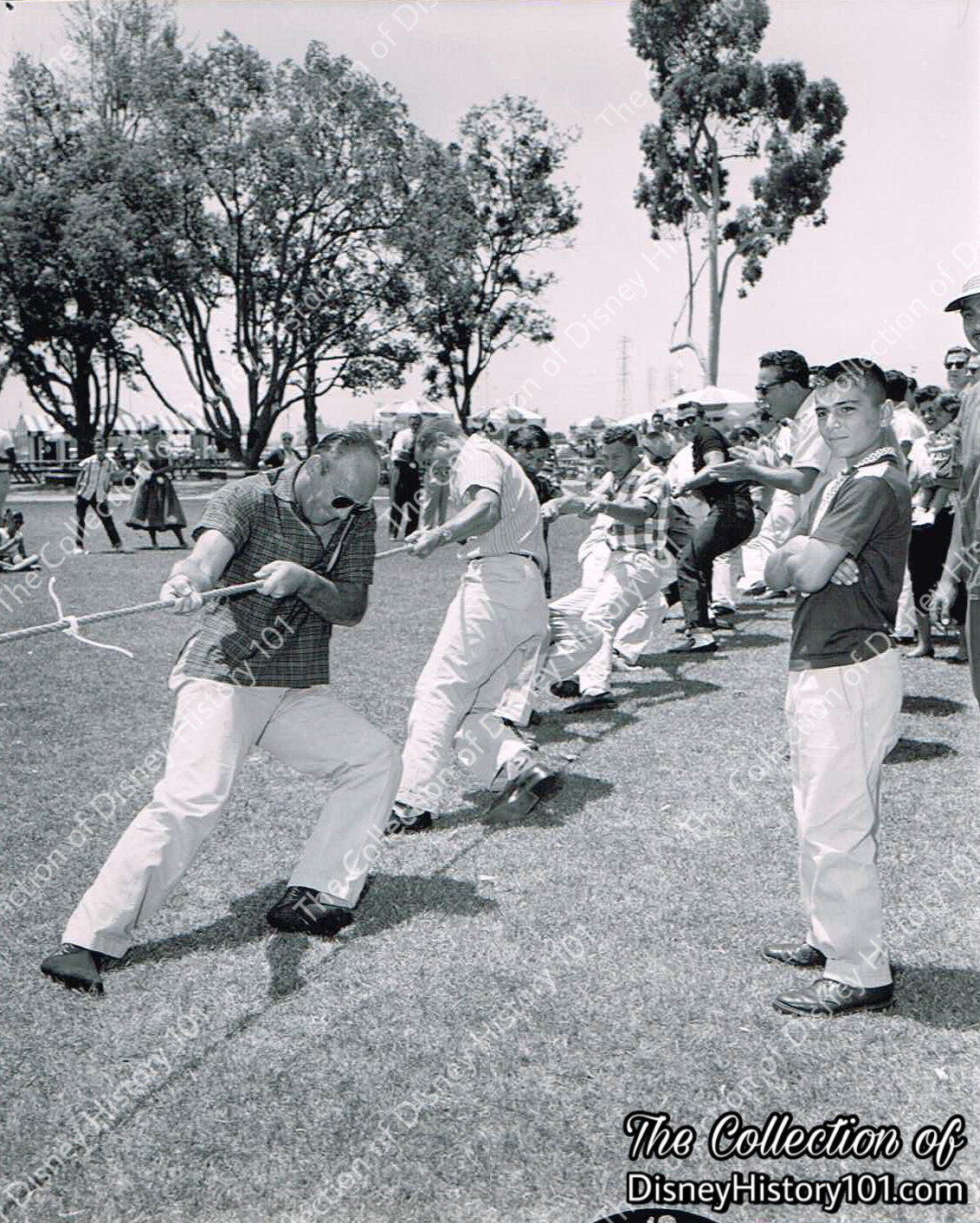
Holidayland Green
A tug-of-war at the Certified & S. Artan Families Picnic.
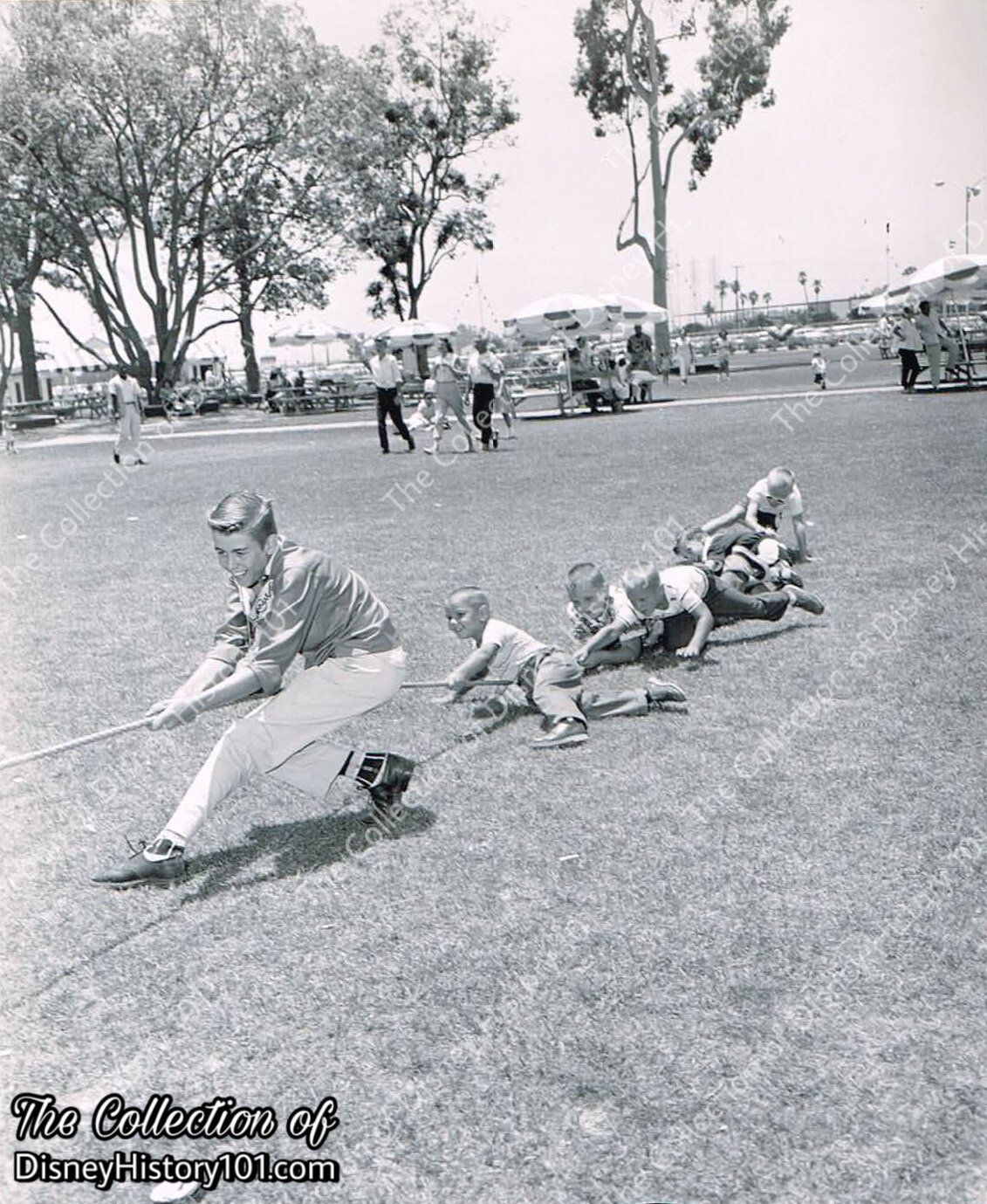
Holidayland Green
A tug-of-war at the Certified & S. Artan Families Picnic.

Just beyond the entrance of Holidayland, guests were greeted by its most memorable attraction - the Children’s Playground. The Holidayland Children’s Playground was a sand lot enclosed by a fence, and shielded on one side with flowering bushes. The Holidayland Children’s Playground featured several pieces of mostly primary-colored playground equipment featuring mostly galvanized mains (manufactured by American Playground Equipment of Anderson, Indiana, U.S.A.) Near most of the newest commercially available playground equipment devices seemed to have been ordered - a castle-themed piece with slides called the American Castle Glide, American Heavy Duty Swing Sets, the shimmering pastel M-4 Merry-Go-Round (with flowering pennants on poles), a snow-white and vermillion runged Heavy Duty “Horizontal Ladder”, another (ME-3-R) Merry-Go-Round (featuring brightly colored steel crescents above), a Sleeping Beauty Castle-inspired jungle gym, and a most memorable Westward Ho! - themed slide.
These were currently the strongest, most-durable, and safest playground equipment available for schools, parks, and recreation centers across the country. The following testimonials were added to one American Playground Equipment Catalogue published 1957. Many of this playground equipment was made available for order by catalogue. Some of this playground equipment (as the M-4 Merry-Go-Round) was also featured at the neighboring world famous Disneyland Hotel.
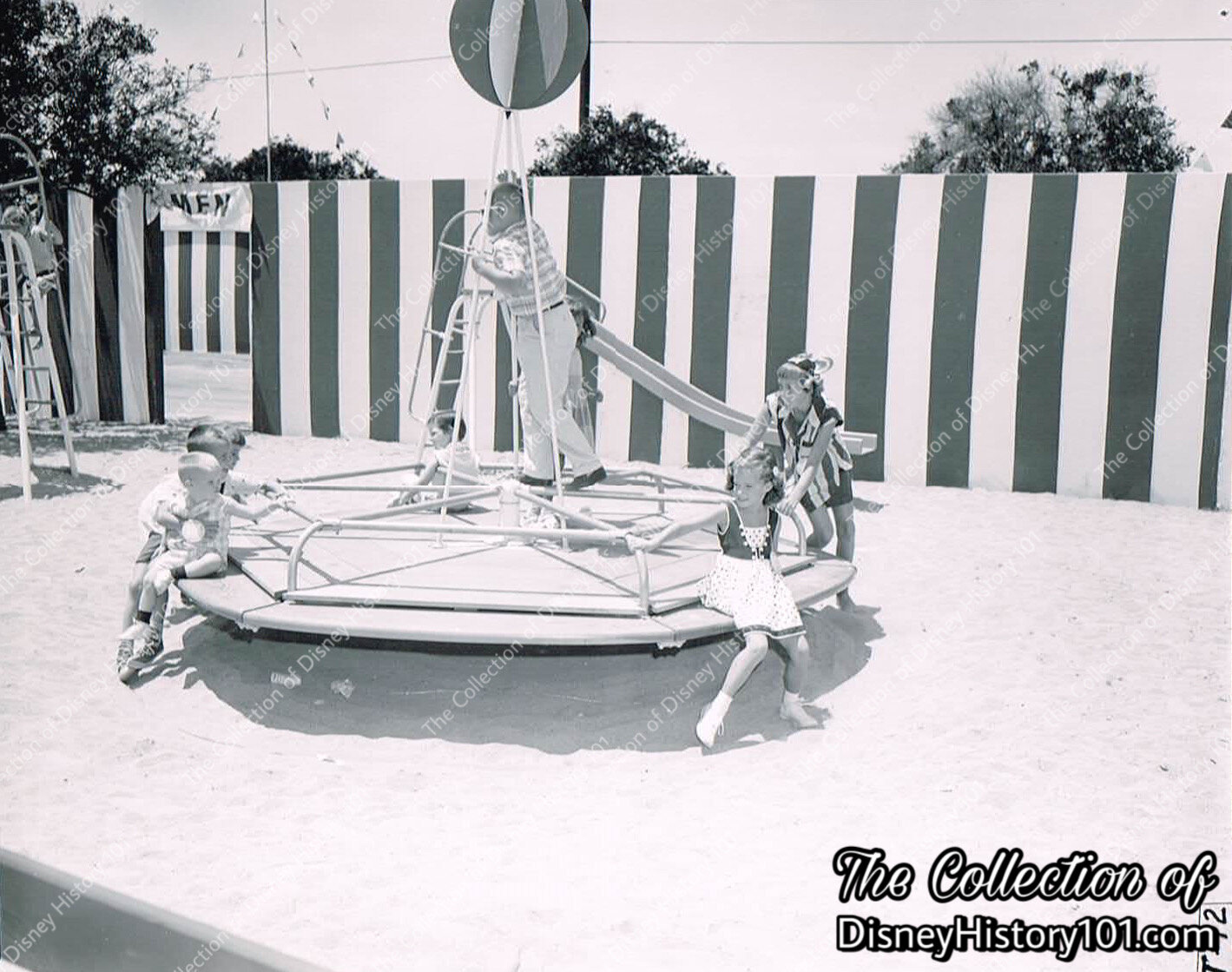
Holidayland Children's Playground Merry-Go-Round and Slide, c. 1957
Merry-Go-Rounds (or “Roundabouts”) were common pieces of playground equipment during the 1950s and 1960s, as seen in this memory of the Certified & S. Artan Families Picnic. This model ME-3-R Merry-Go-Round was manufactured by the very same American Playground Device Company of Anderson, Indiana, U.S.A. The Disneyland Hotel and Holidayland models featured additional triangular galvanized spire, triangular steel deck plate, and six colorful half-circles of sheet steel, to “impart some of the pageantry and excitement of Disneyland”. These colorful additions were included among American Playground Device’s commercially-available merchandise of 1957.
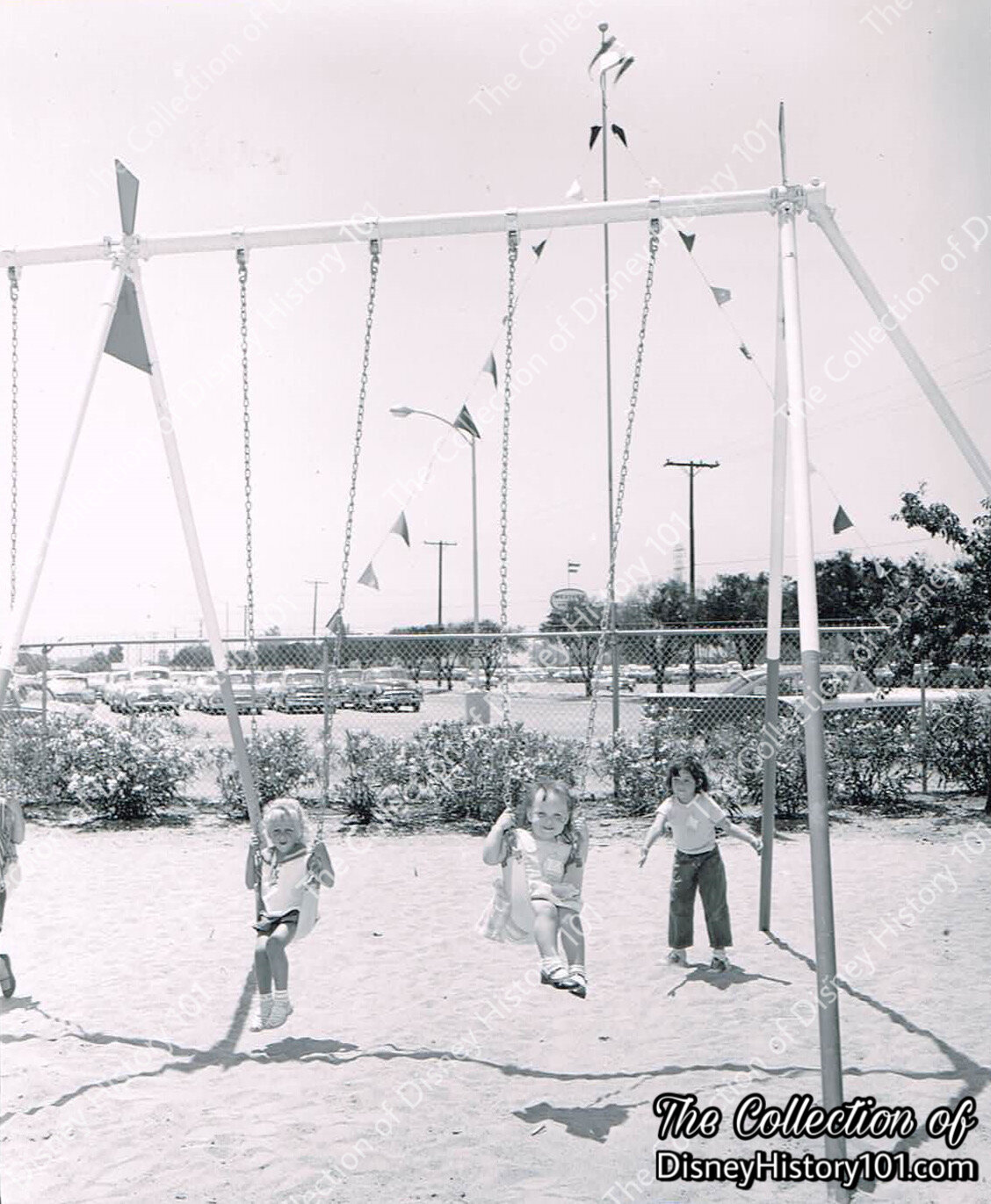
Holidayland Children's Playground Swings, c. 1957
Younger guests of the Certified & S. Artan Families Picnic enjoy the American Heavy Duty Swing Set. As with the other play equipment, colorfully festive geometric forms were added.
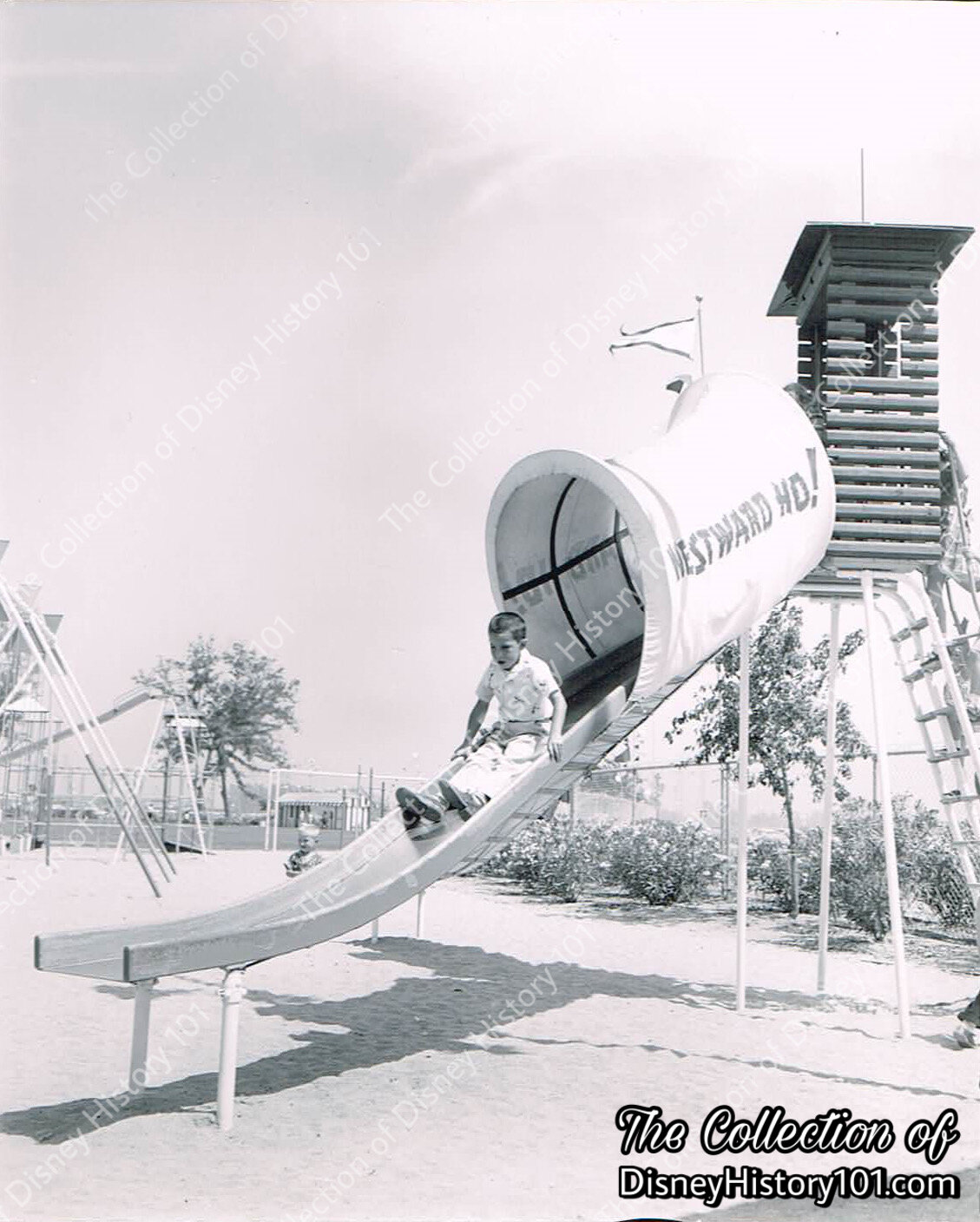
Holidayland Children's Playground Area Westward Ho! Slide, c. 1957
The Holidayland Children’s Playground featured several pieces of playground equipment, including two slides (or, “glides” as they were so-called by The American Playground Device Co.). One of these “glides” is most memorable - the custom-built “Westward Ho! Slide”, seen in this preserved memory from the Hallamore Family Picnic. The only other place in the world to have one was Walt Disney Elementary in Marceline, Missouri.
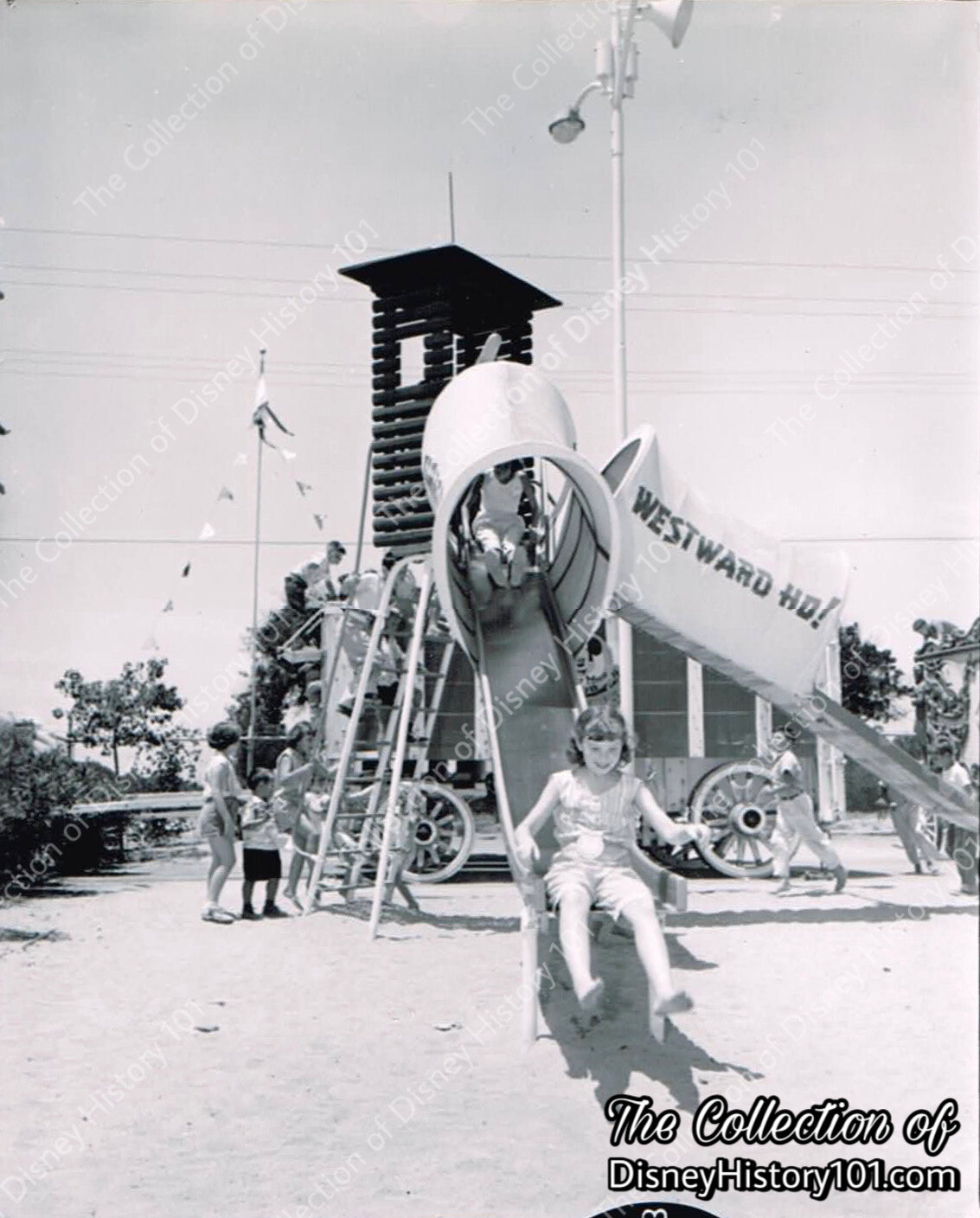
Holidayland Children's Playground Westward Ho! Play Equipment, c. 1957
It has been said that Holidayland lacked adequate lighting for nighttime events. Though this may be true, the land did have lighting in the Parking Lot, and near the Children’s Playground, as seen in this preserved memory from a Certified & S. Artan Families Picnic.
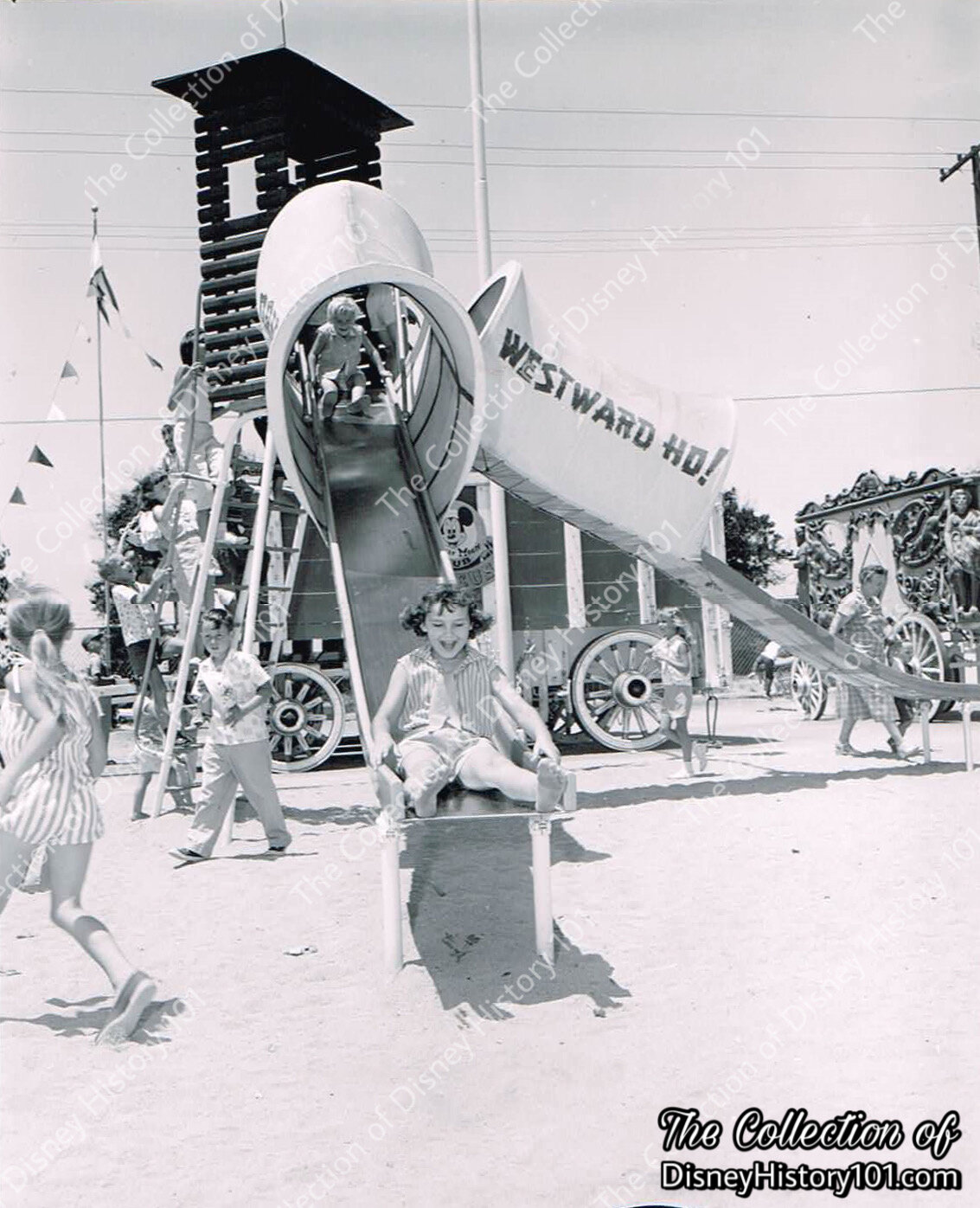
Holidayland Children's Playground Westward Ho! Play Equipment, c. 1957
Guests of the Certified & S. Artan Families Picnic enjoy the Westward Ho! Slide play equipment, while (it appears) that some children prefer to play around a Mickey Mouse Club Circus Wagon and “The Whiskers Wagon” (seen in the background).
Young Guests were safe thanks to the protection of Disneyland Security Officers.
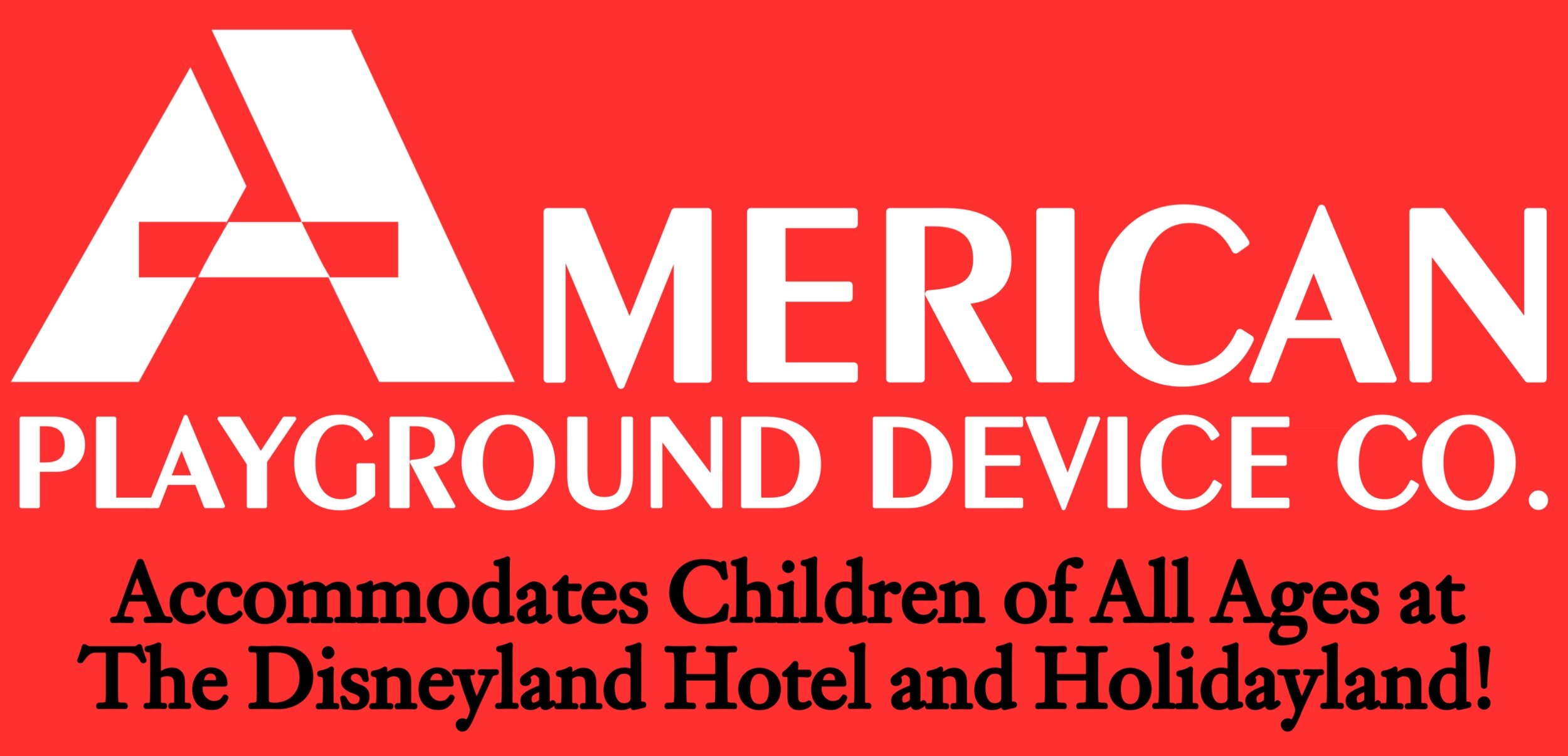
American Playground Equipment currently manufactured the strongest, most-durable, and safest playground equipment available for schools, parks, and recreation centers across the country. Some of their playground equipment (as the M-4 Merry-Go-Round) was featured in two locations at Disneyland - at both Holidayland and the neighboring world famous Disneyland Hotel. American Playground Equipment first replaced the older equipment at Playland - the Disneyland Hotel’s kiddie playground. After the equipment was successfully installed at Holidayland, a photoshoot was arranged (in which television’s Mouseketeers - Cubby O’Brien, Annette Funicello, Bobby Burgess, Sharon Baird, Darlene Gillespie, Tommy Cole, Doreen Tracey and Karen Pendleton - were featured enjoying the equipment). Guests of all ages enjoyed American Device Company’s playground equipment at both Holidayland and the Disneyland Hotel, and these very models were then made available to public consumers! The following testimonials were added to one American Playground Equipment Catalogue published 1957.
After the equipment was successfully tested at Holidayland, Tommy Walker (Disneyland Inc. Customer Relations Division) wrote Norman R. Miller (American Playground Device Company Vice President) the following words (in a letter dated November 1st, 1957) : “It gives me a great deal of pleasure to tell you how pleased we at Disneyland are with your unique and practical playground equipment. The freshness of appearance as well as the safety and design factors have made your equipment a welcome addition to Disneyland’s Holidayland. Congratulations on making so many young people so happy.”
Don Daley (Disneyland Hotel Resident Manager) wrote Warren P. Miller (American Playground Device Company President) in a letter dated October 11th, 1957 : “We have found this equipment to be outstanding in design and execution, and completely safe in every respect. Since hundreds of children a day make use of the playground equipment, our first consideration, naturally, was to provide them with the best. From literally hundreds of our guests we have received nothing but the finest compliments and we, in turn, want to pass their compliments, together with ours, on to you. We wholeheartedly endorse this equipment and highly recommend it for use in any playground area.”
Clearly, this “cross-pollination” advertising was mutually beneficial to both Disneyland Inc. and the American Playground Device Company!

Later Walt Disney donated American Playground Equipment to Walt Disney Elementary School in Missouri
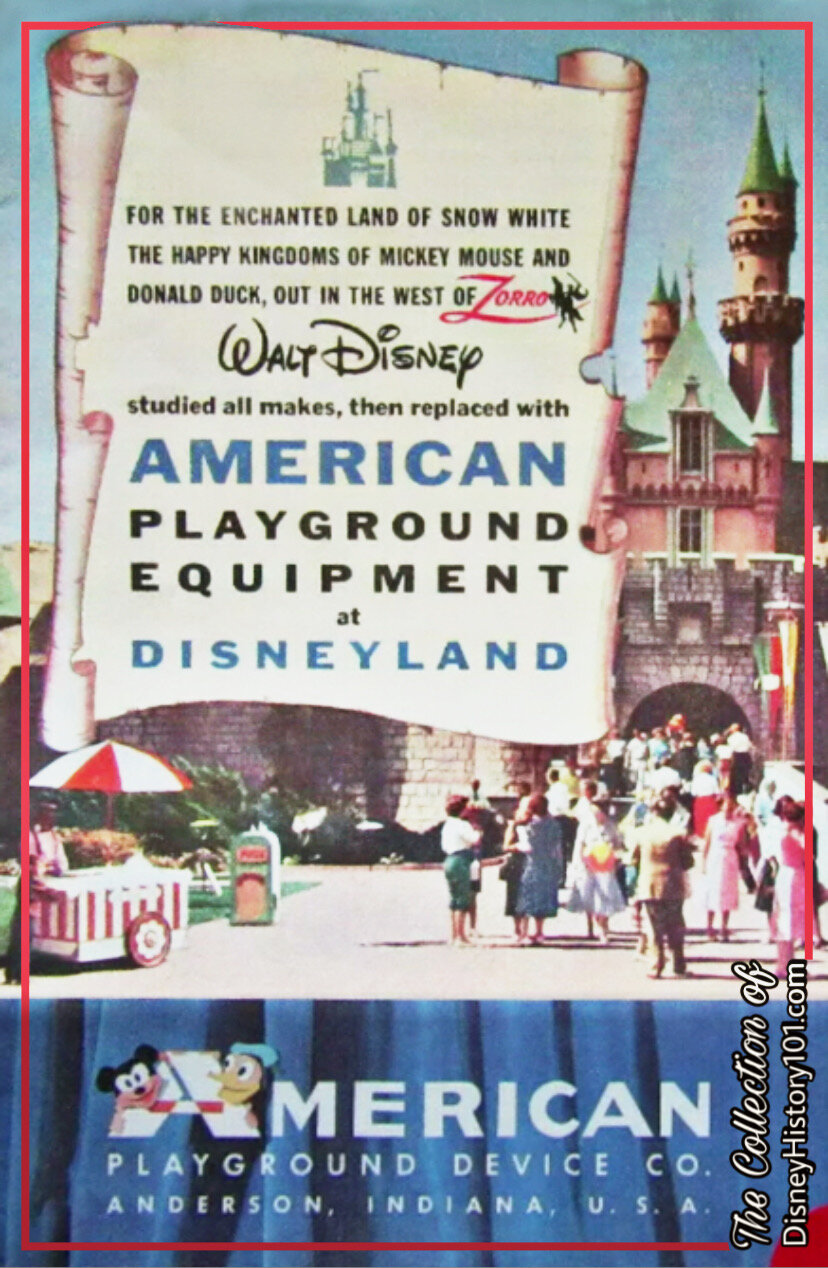
American Playground Device Company Catalogue Cover Excerpt, c. 1957
While the kids played with the American Playground Device Equipment, the adults engaged in competitive sports at the Baseball Diamond.

What would a salute to “the great American pastime” be without baseball? The Holidayland Baseball Field was a regulation softball diamond located near Disneyland’s western perimeter fence and berm. Equipment was supplied by Holidayland. Two seating areas (bleachers) were available (one on each side of the “cage”), as well as two covered sections of each bleacher seating area. Due to the position of the Holidayland Baseball Field in relation to Disneyland’s perimeter fence, few (if, any) “pop fly” balls ever made it over Disneyland’s berm, and in into Adventureland.

Holidayland Baseball Field
A guest takes a swing at the Collier Carbon and Chemical Corp. Picnic.
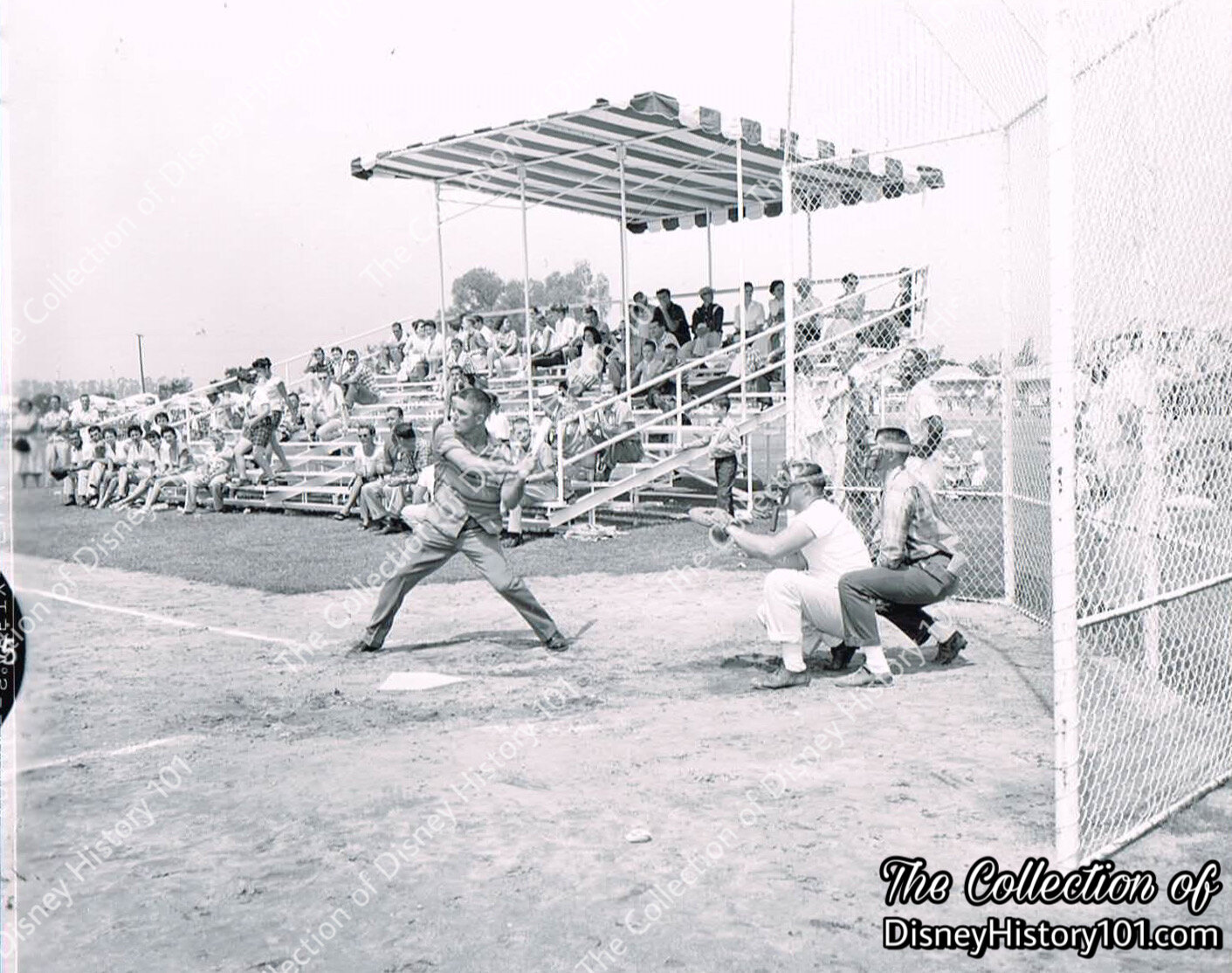
Holidayland Baseball Field
Southern California Gas Company
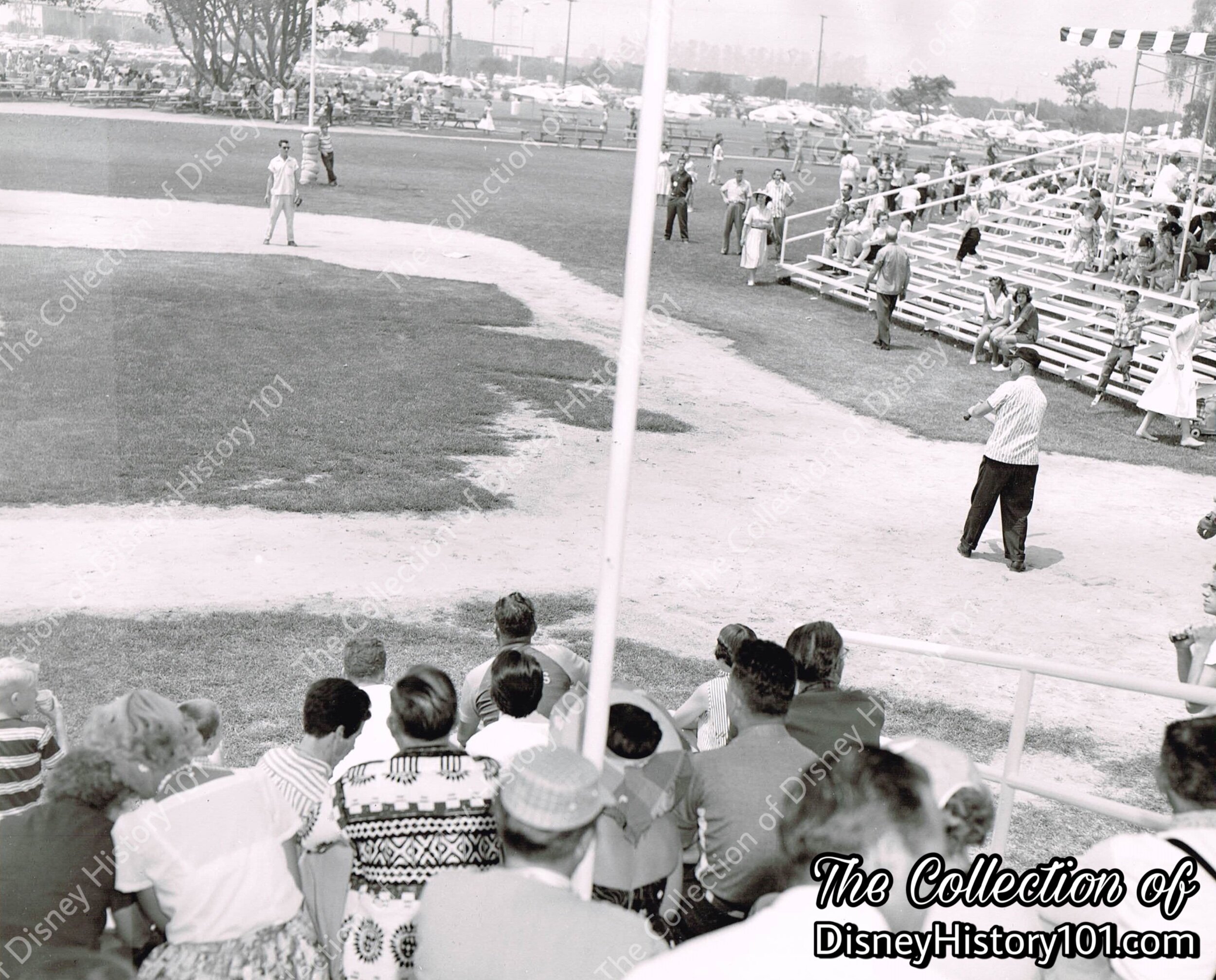
Holidayland Baseball Field, c. 1957
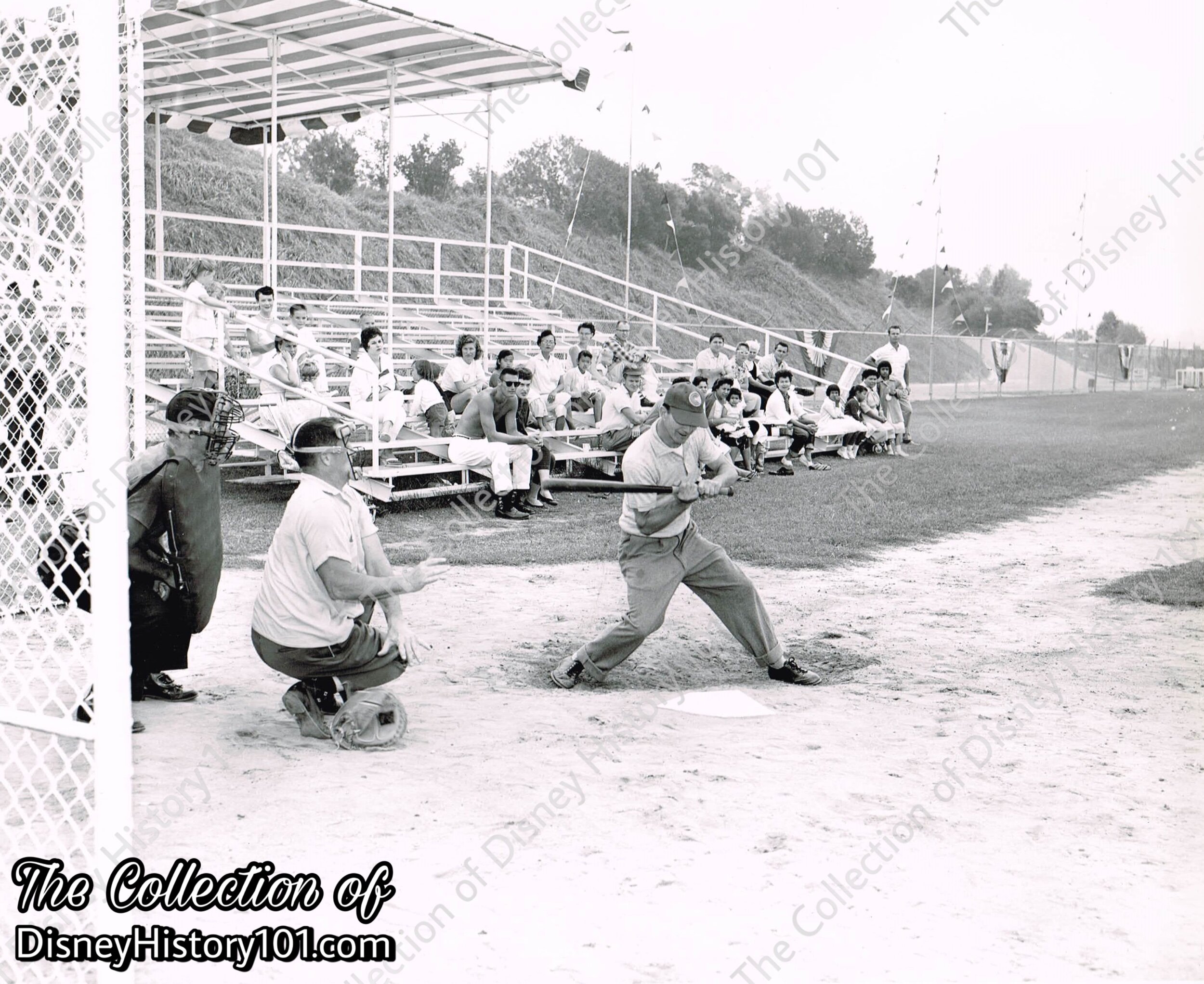
Holidayland Baseball Field, c. 1957
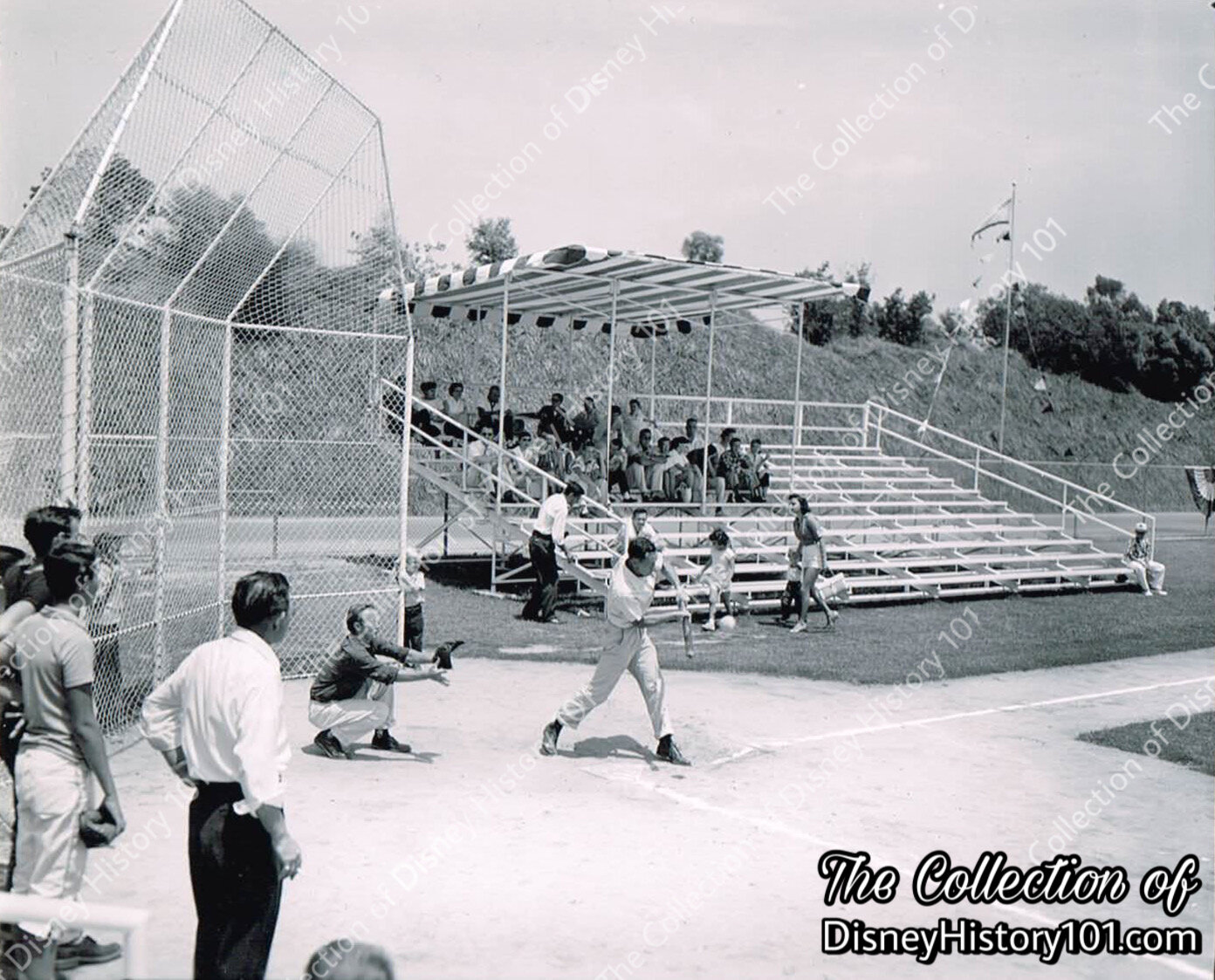
Holidayland Baseball Field, c. 1957
Hallamore Family Picnic
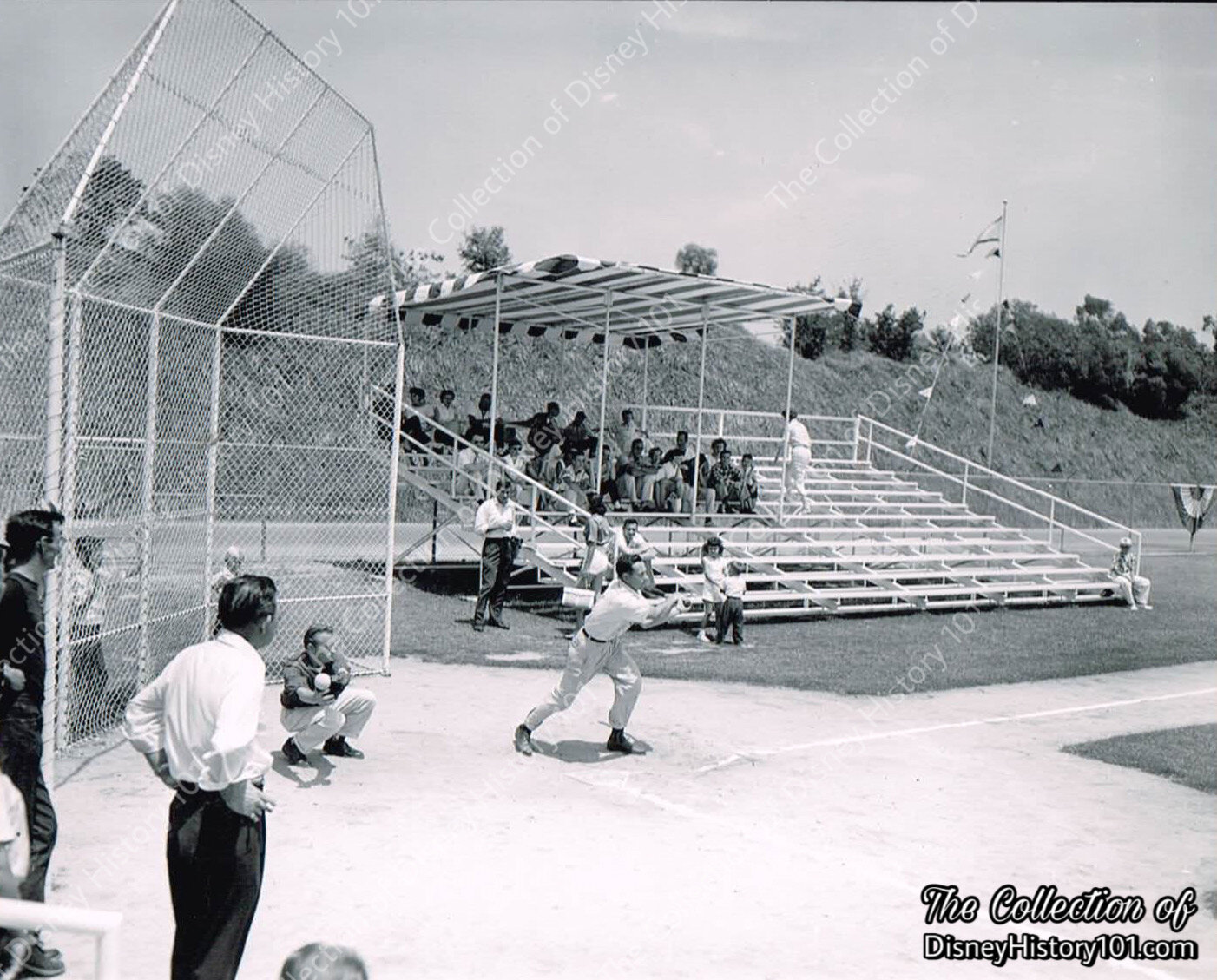
Holidayland Baseball Field, c. 1957
Hallamore Family Picnic
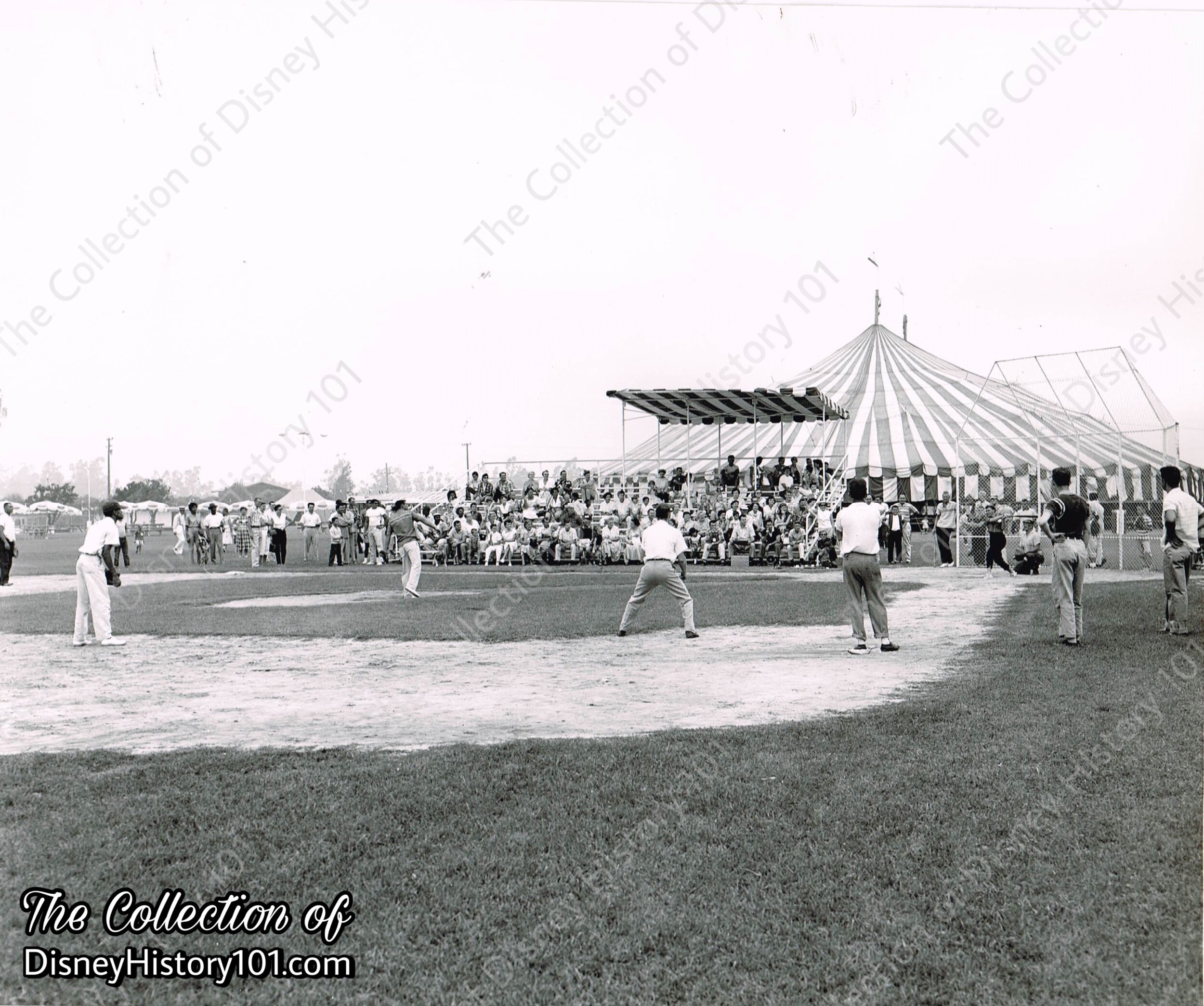
Holidayland Baseball Field, c. 1957
Continental Can Company gathered a good amount of players and spectators for their company party. The bleachers were unusually packed with standing room only, near the “hot corner”.
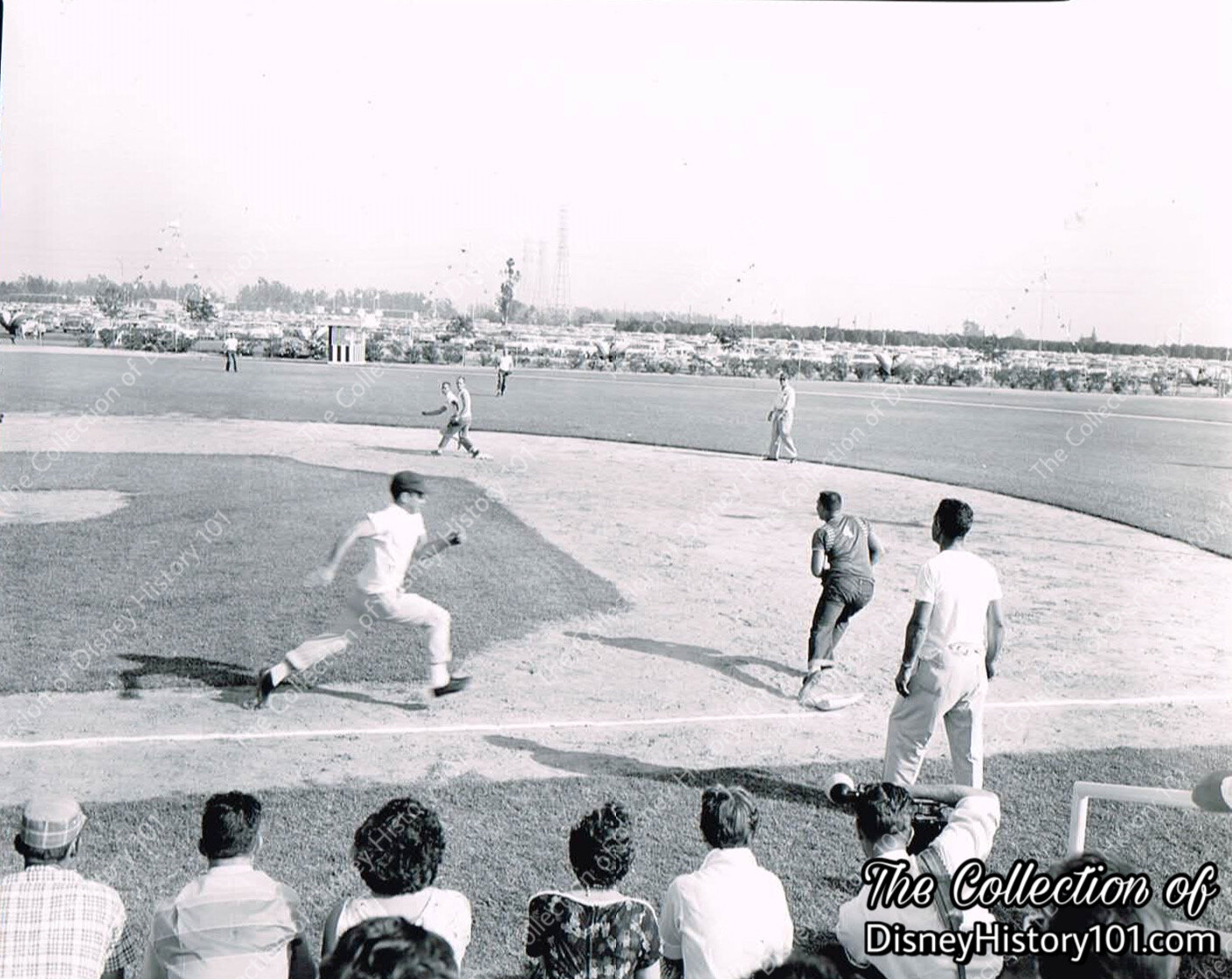
Holidayland Baseball Field
A guest runs for first base at the Collier Carbon and Chemical Corp. Picnic.
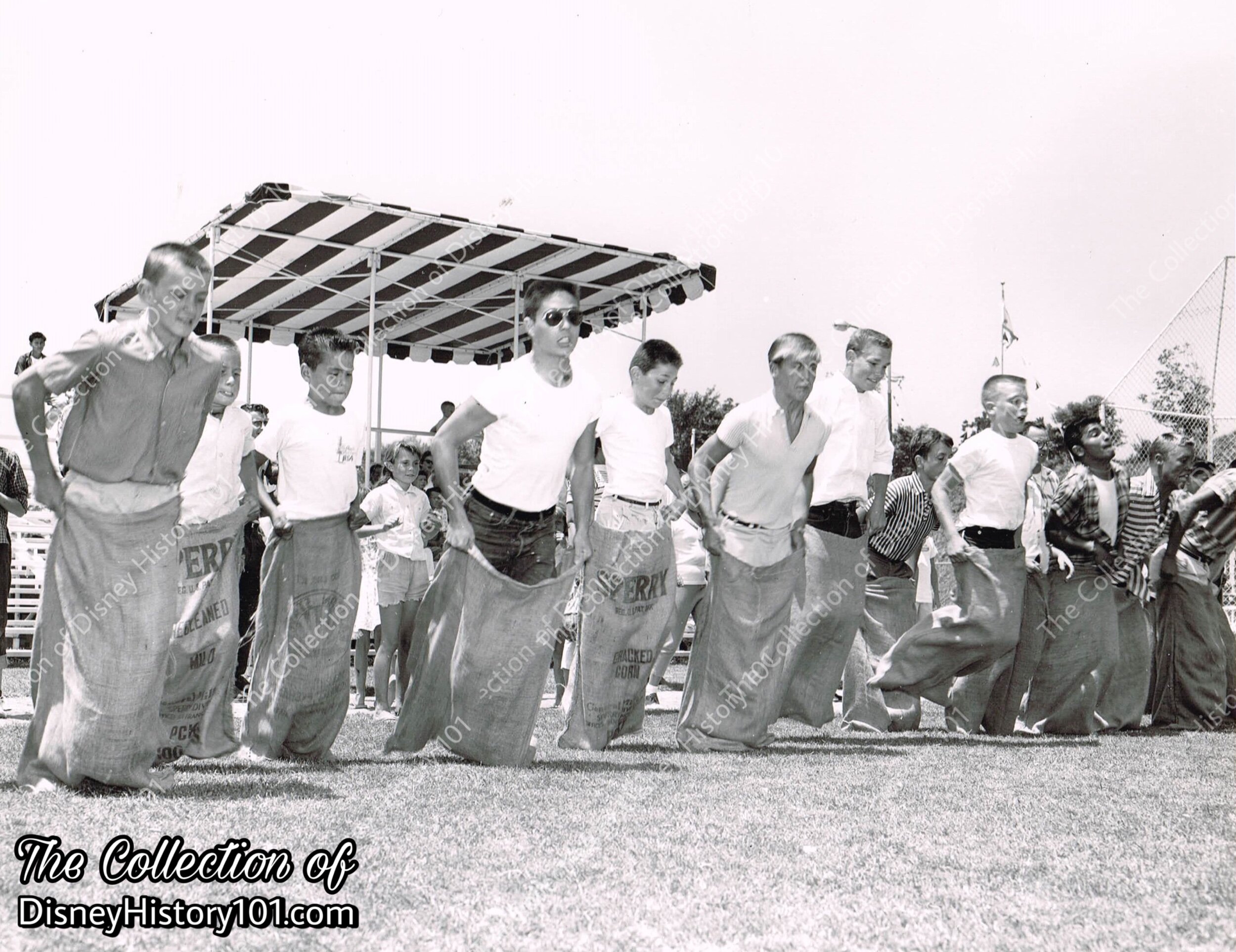
Holidayland Baseball Field, c. 1957
The Holidayland Baseball Field was occasionally utilized for other sporting events and contests, the most popular of which seemed to be the potato sack race!
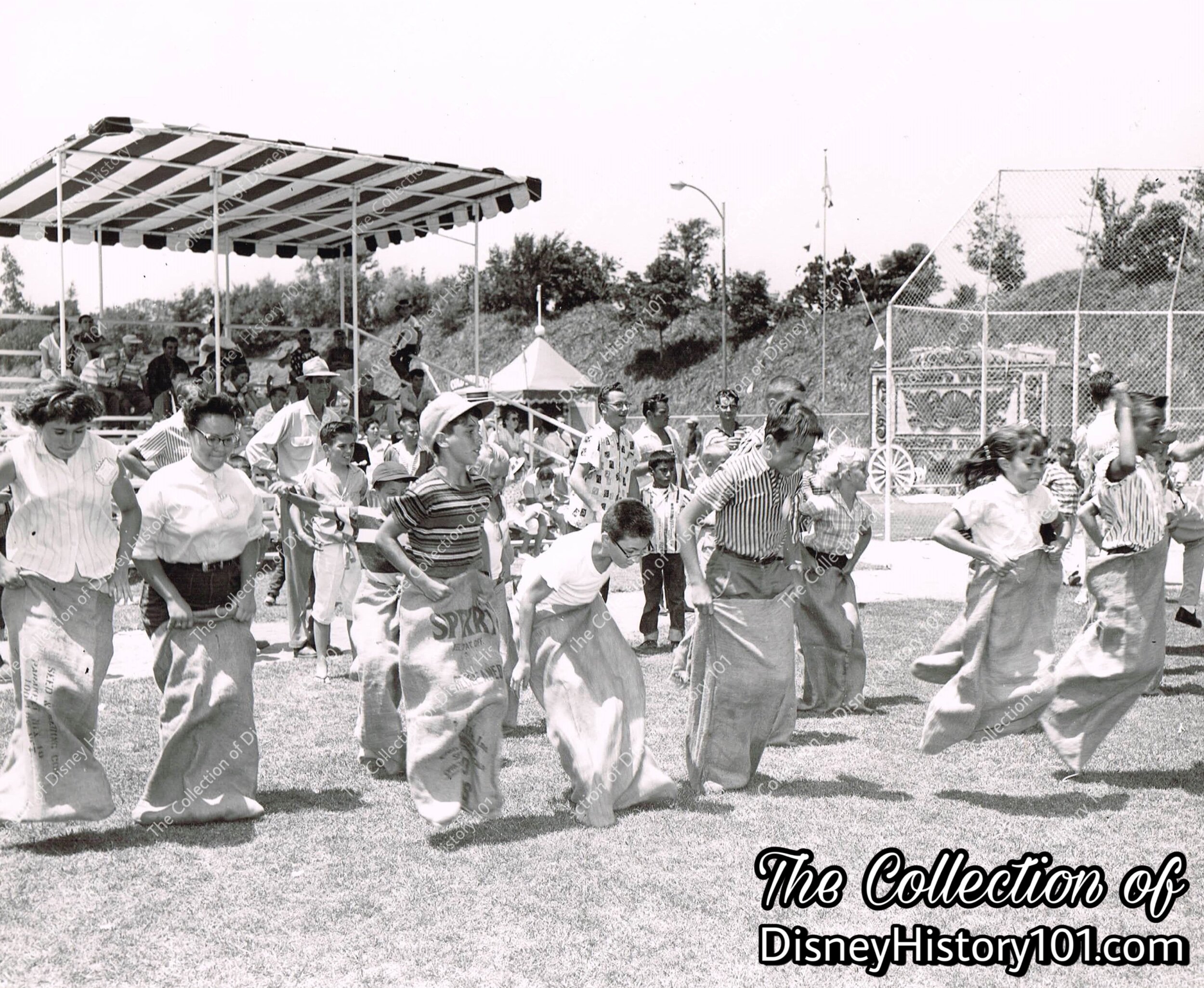
Holidayland Baseball Field, c. 1957
In the background, you may note the Shell Cab Wagon (one of the old Mickey Mouse Club Circus wagons), which was likely moved out of the Circus Tent while it was in use.
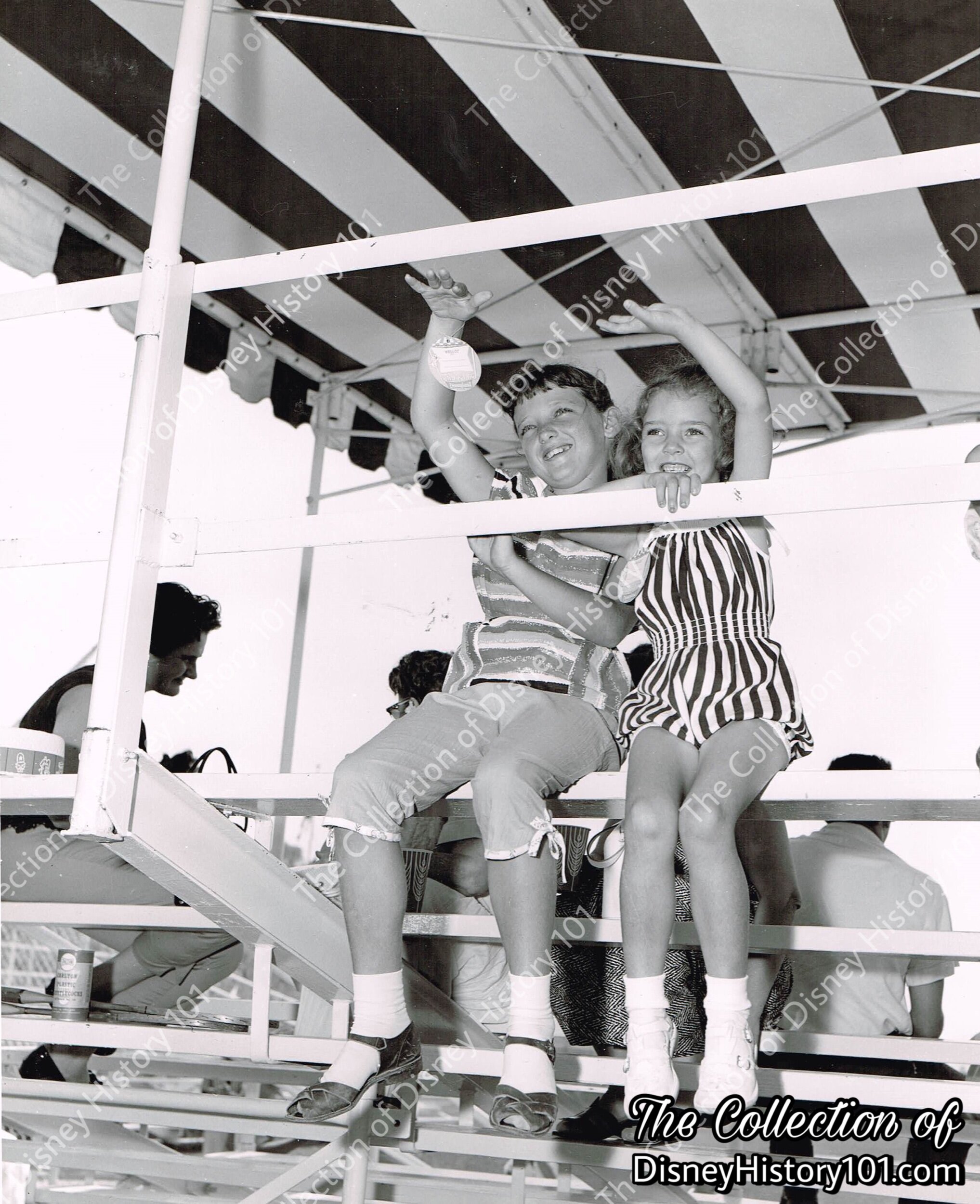
Holidayland Baseball Field grand stand, c. 1957
While a game carries on behind them, a couple of young guests hang out on the back of one of two Holidayland Baseball Field grand stands. The young guest on the left seems to be playing with his Holidayland name tag, dangling in the breeze. As there were few trees outside the Picnic Area, this was one of the few places to shade yourself from the summer sun.
As a sidelight, it is fascinating how baseball performed a role around the Studio and at Disneyland. On the importance of the sport, Walt once commented: “Every man is captain of his caree and there must be cooperation all around if he is to get what he wants out of life. There is no better time to begin learning this lesson than when we were young, and I think there is no better means of teaching it than through sports programs as well-organized and supervised as Little League baseball. Baseball is a great teacher of an important secret of living: the giving and taking in the group, the development of qualities and behavior that will stand us in good stead through life in pursuits both personal and professional.”

“The world’s largest candy-striped circus tent” (previously home to the Mickey Mouse Club Circus and Keller’s Jungle Killers) cost more than $30,000 to construct. The 19,700 square-foot tent (or, approximately 185 feet by 130 feet), located along Disneyland’s western perimeter fence. The giant circus tent can be seen located behind Main Street on post card #0001.
Though the “big top” originally seated 2,500 guests, the now 4,000 guest capacity Circus Tent was utilized for showcasing Holidayland’s main acts on the Entertainment Stage. The corporate and secular organization events often featured a variety of Disneyland performers from this stage, including the Indian Village representatives, the cast of the Golden Horseshoe Revue, the Strawhatters, or the Mexican Village’s Gonzales Trio!
Tables and benches for seating 2,400 people at one time, we’re all shaded or under the “Big Top!” The tent was heated, which was perfect for winter season events held inside (as the Mickey Mouse Club Circus of 1955). The floor beneath was paved and glazed for square-dancing. Since the days of the Mickey Mouse Club Circus, the tent was advertised as being “heated for your comfort.” Now, guests could enjoy meals and entertainment in the cold hours of the fall evening.
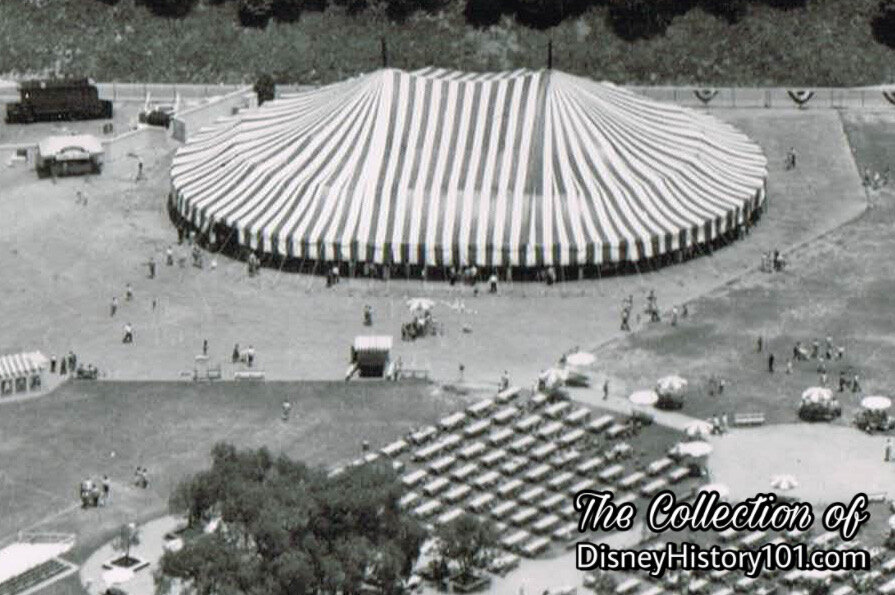
Holidayland Circus Tent, c. 1959
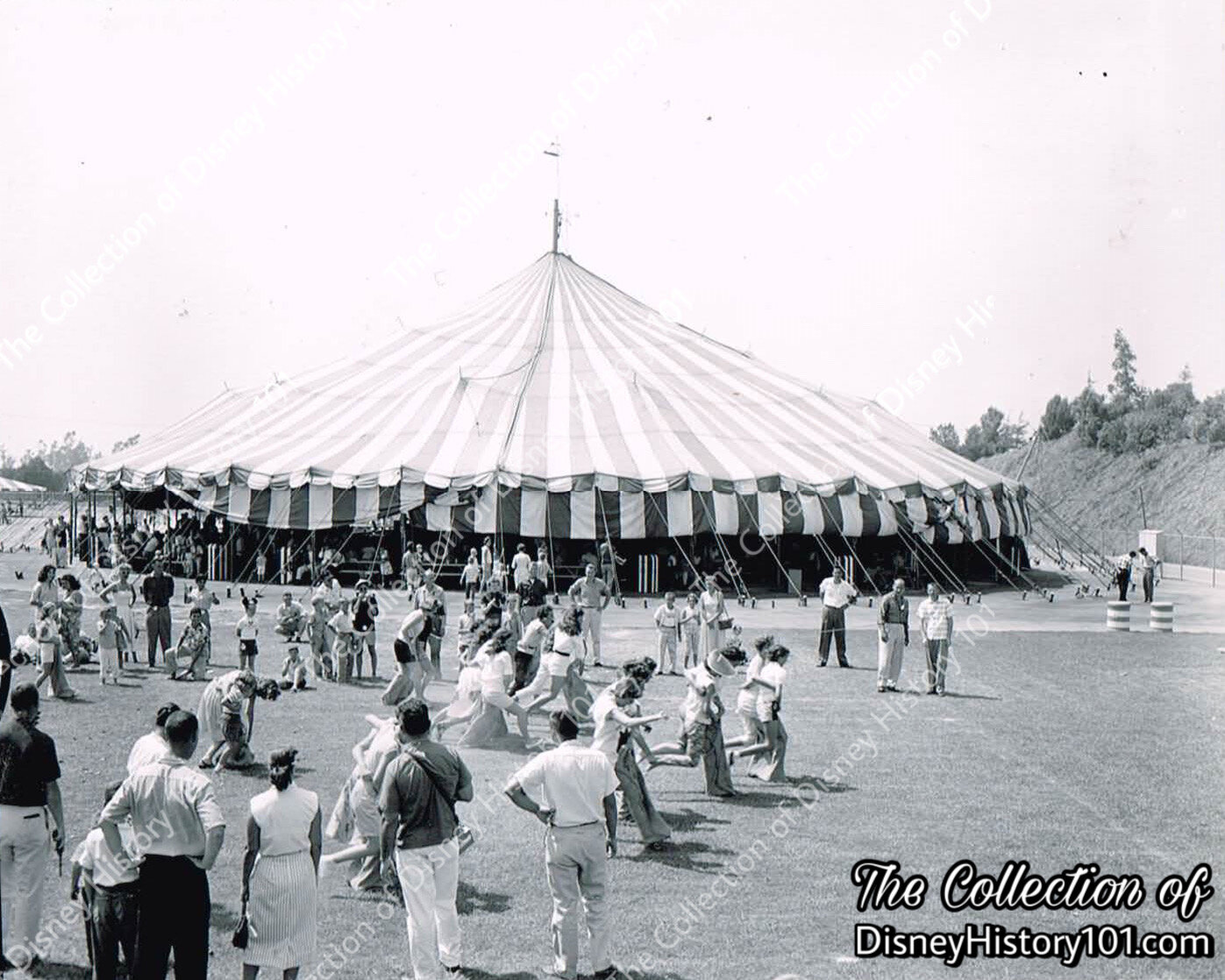
Holidayland Circus Tent, c. 1957
Competitors race at an event of the Hallamore Family Picnic.
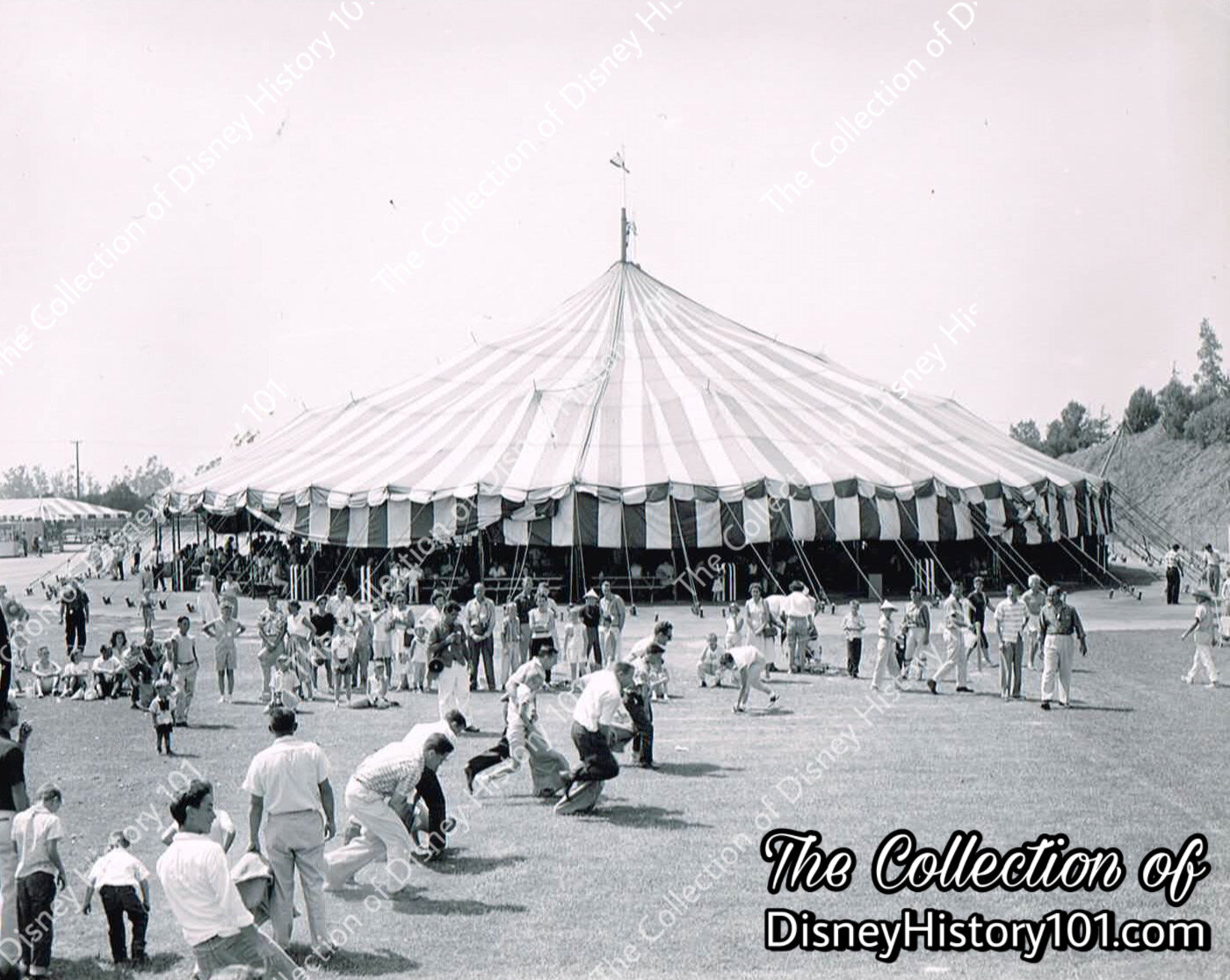
Holidayland Circus Tent, c. 1957
Hallamore Family Picnic
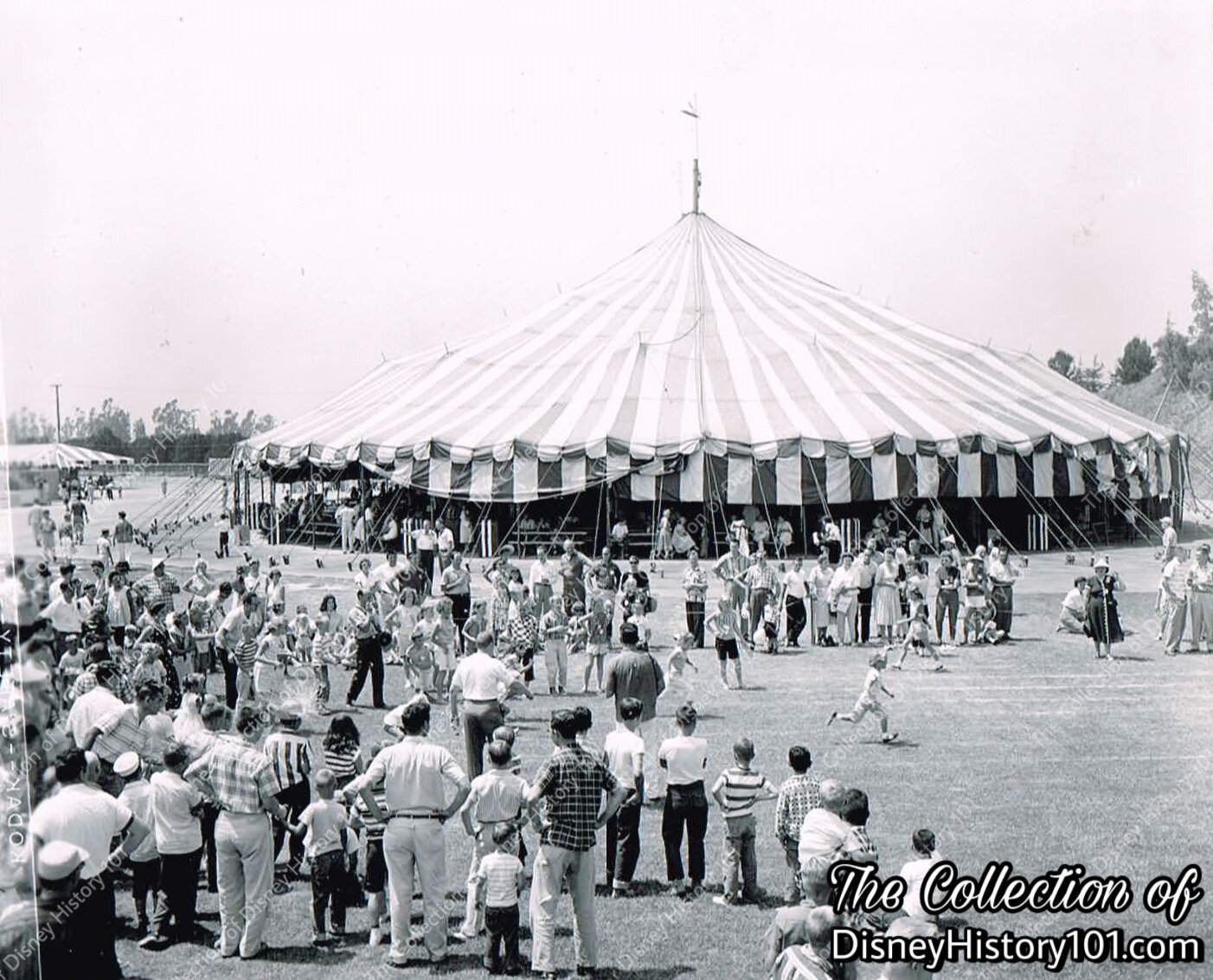
Holidayland Circus Tent, c. 1957
Spectators assemble around the field of a Hallamore Family Picnic game.
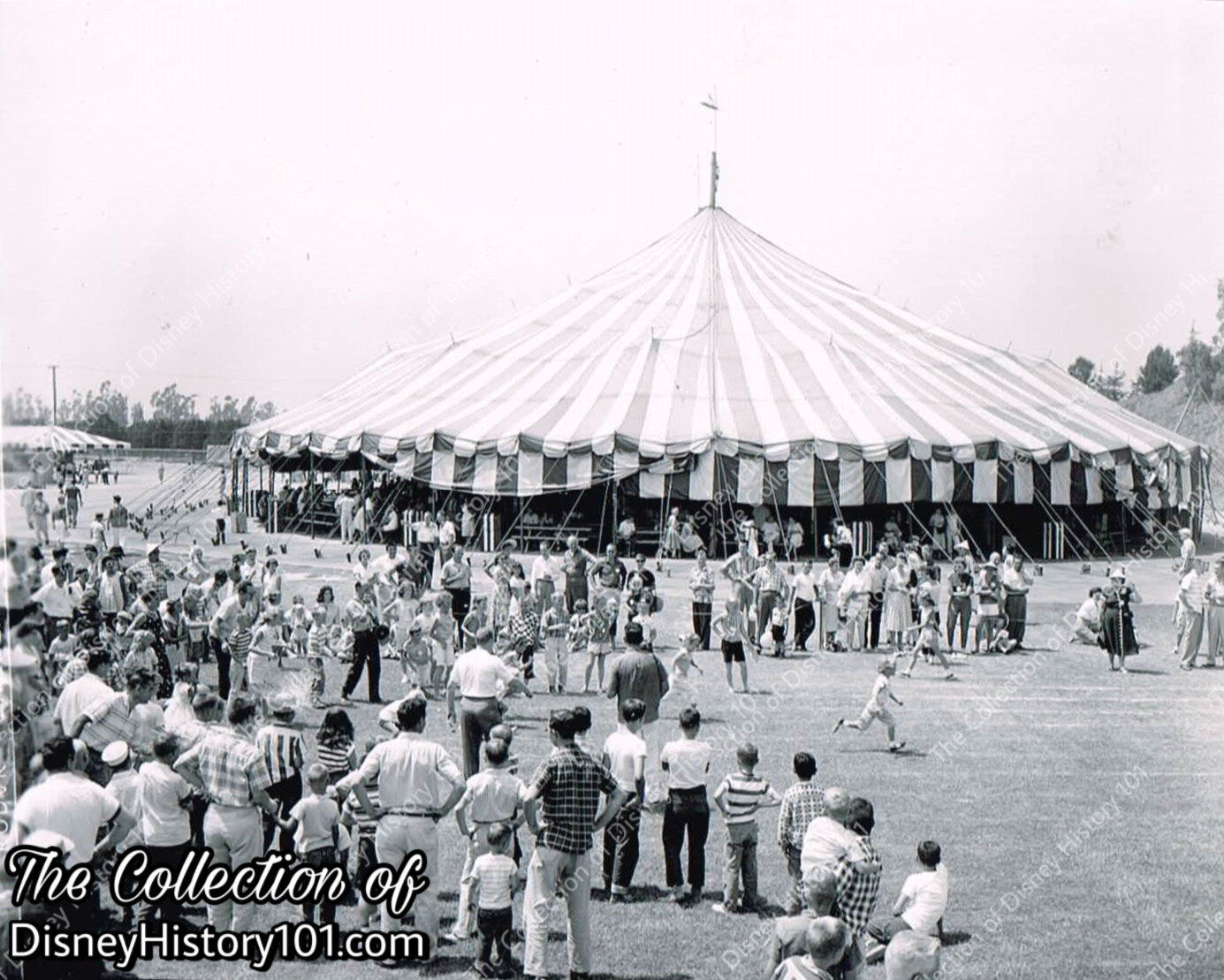
Holidayland Circus Tent, c. 1957
Hallamore Family Picnic
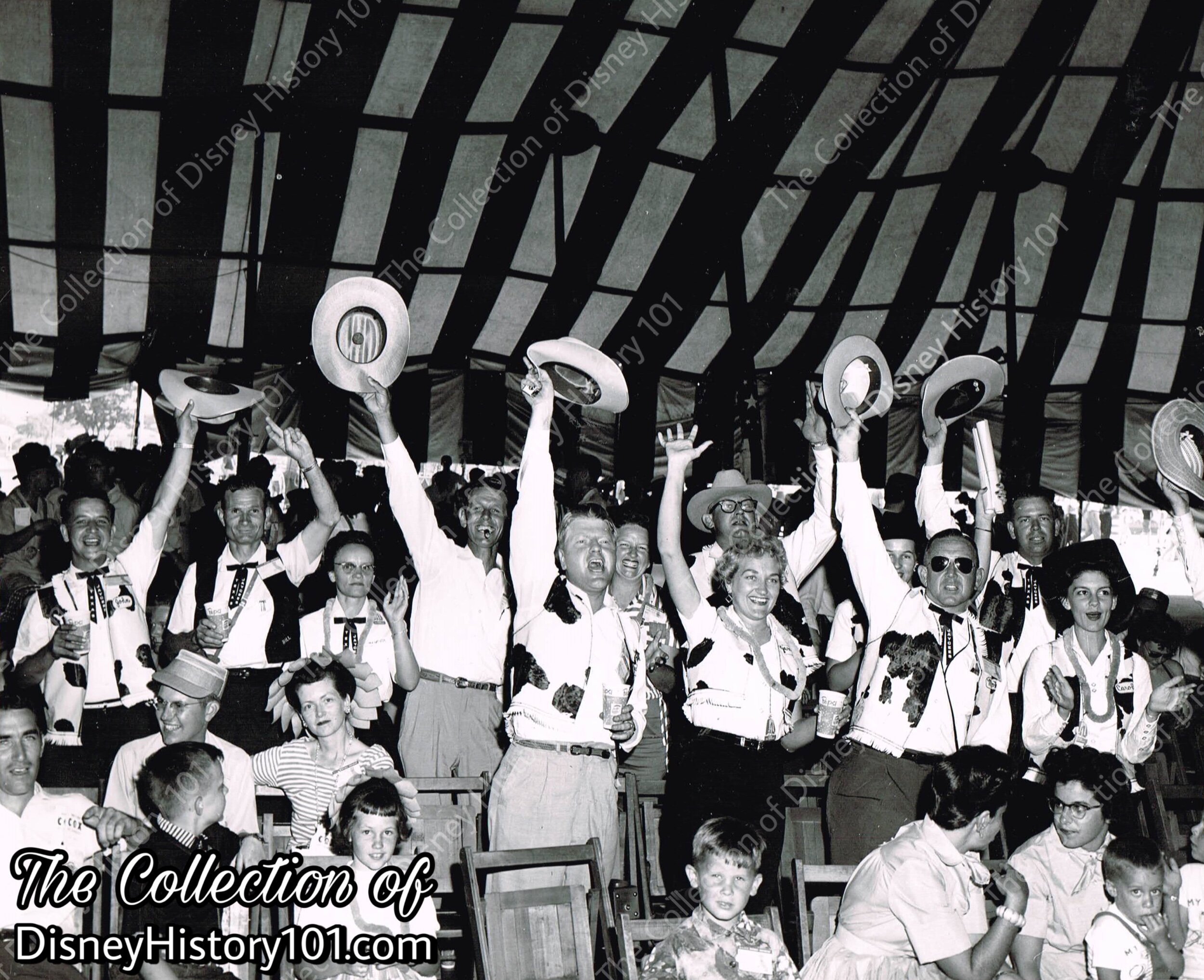
Holidayland Circus Tent, c. 1957
This was a popular location for square dancing. These Junior Chamber of Commerce members enjoy a refreshing cup of Pepsi-Cola while they raise their hats and cheer!
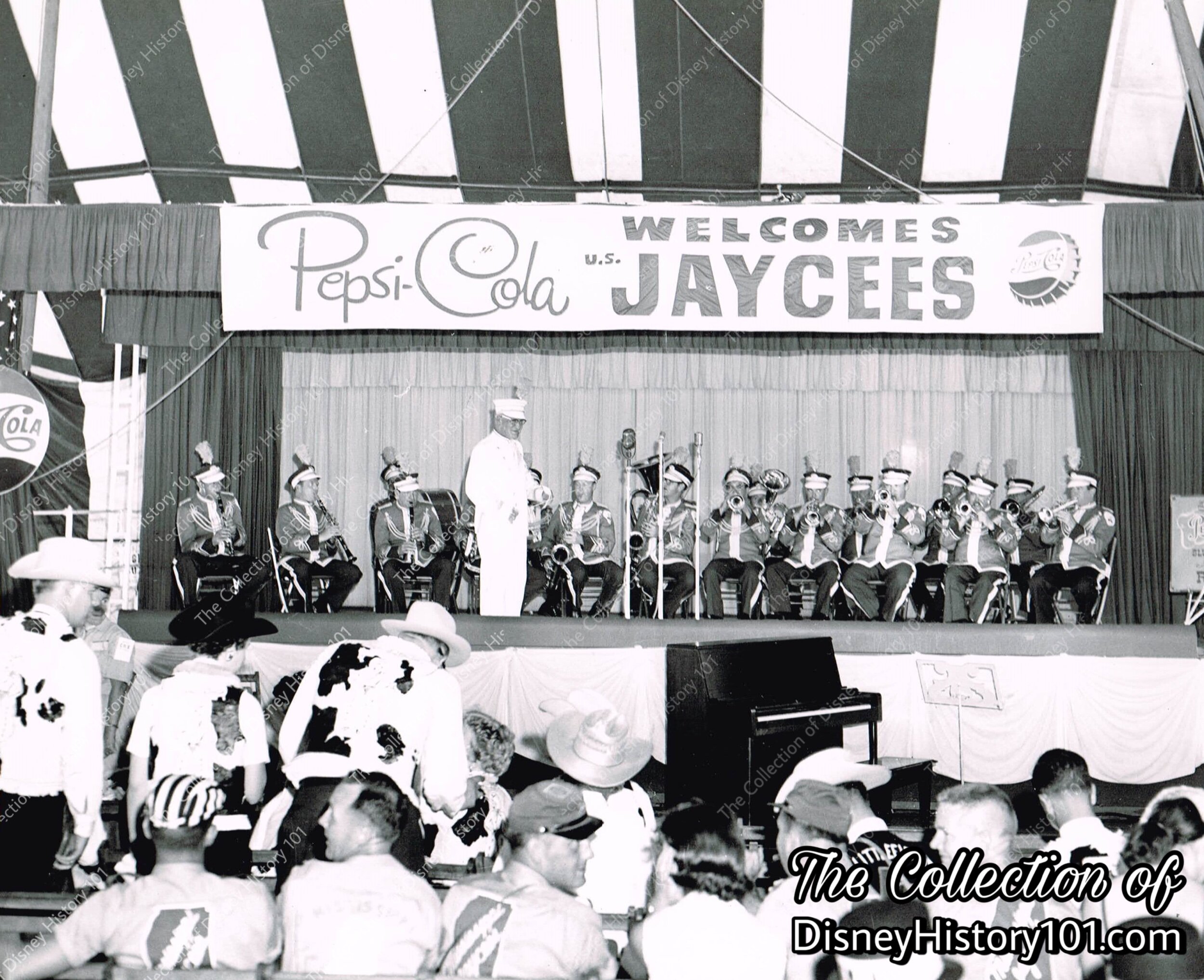
Holidayland Circus Tent, c. 1957
This Pepsi-Cola sponsored event (in honor of the youth organization Jaycees) featured some of the world’s finest music performed by the Disneyland Marching Band. Vesey Walker and the Disneyland Band were no strangers to performing in “the world’s largest candy striped tent” as they performed in the venue when the Mickey Mouse Club Circus (and the original incarnation of Holidayland) was located between Fantasyland and Tomorrowland.
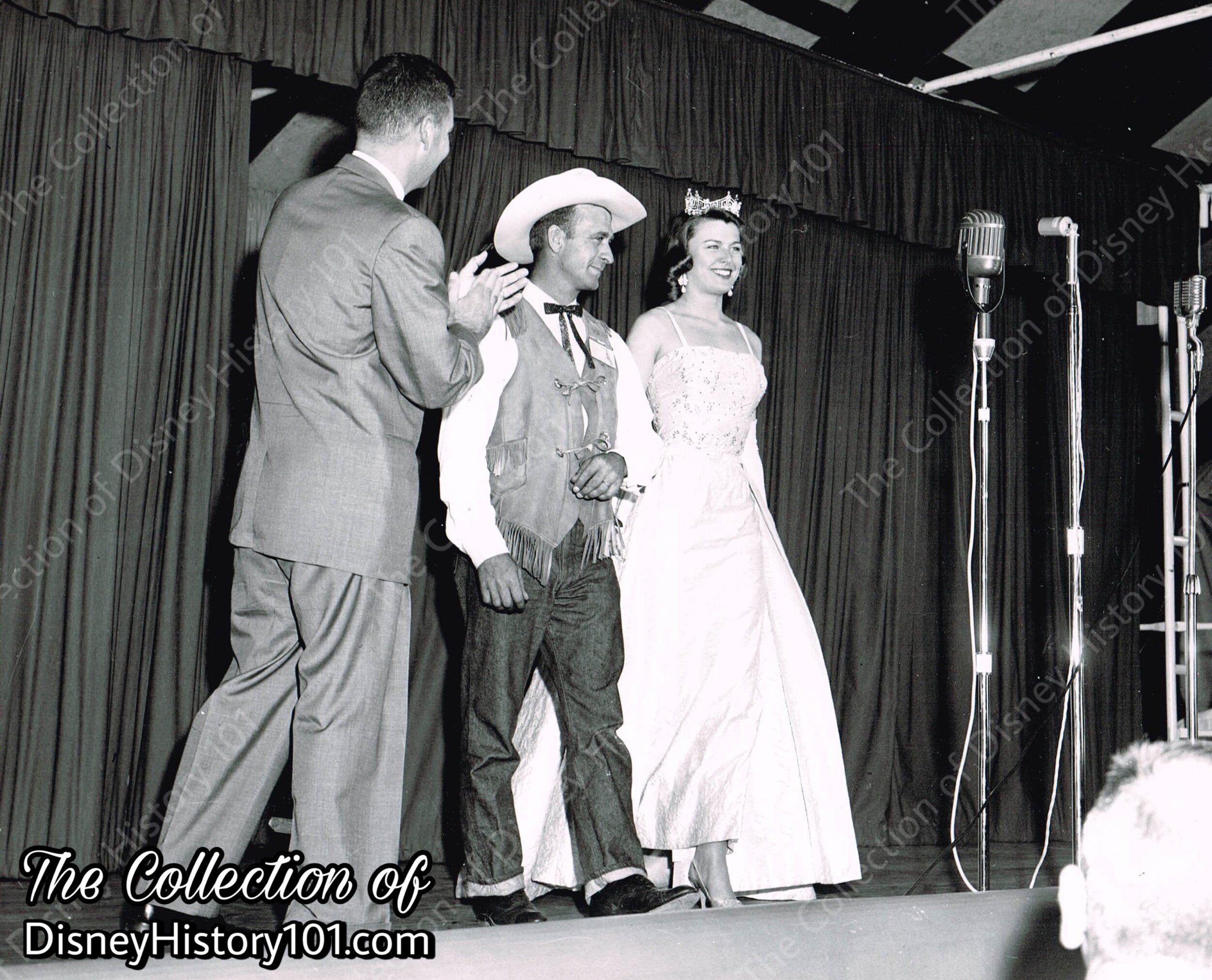
Holidayland Circus Tent Entertainment Stage, c. 1957
This unidentified event featured a Dance floor and stage inside “Big Top” to host pageants of sorts.

Holidayland Circus Tent Entertainment Stage, c. 1957
Hallamore Family Picnic
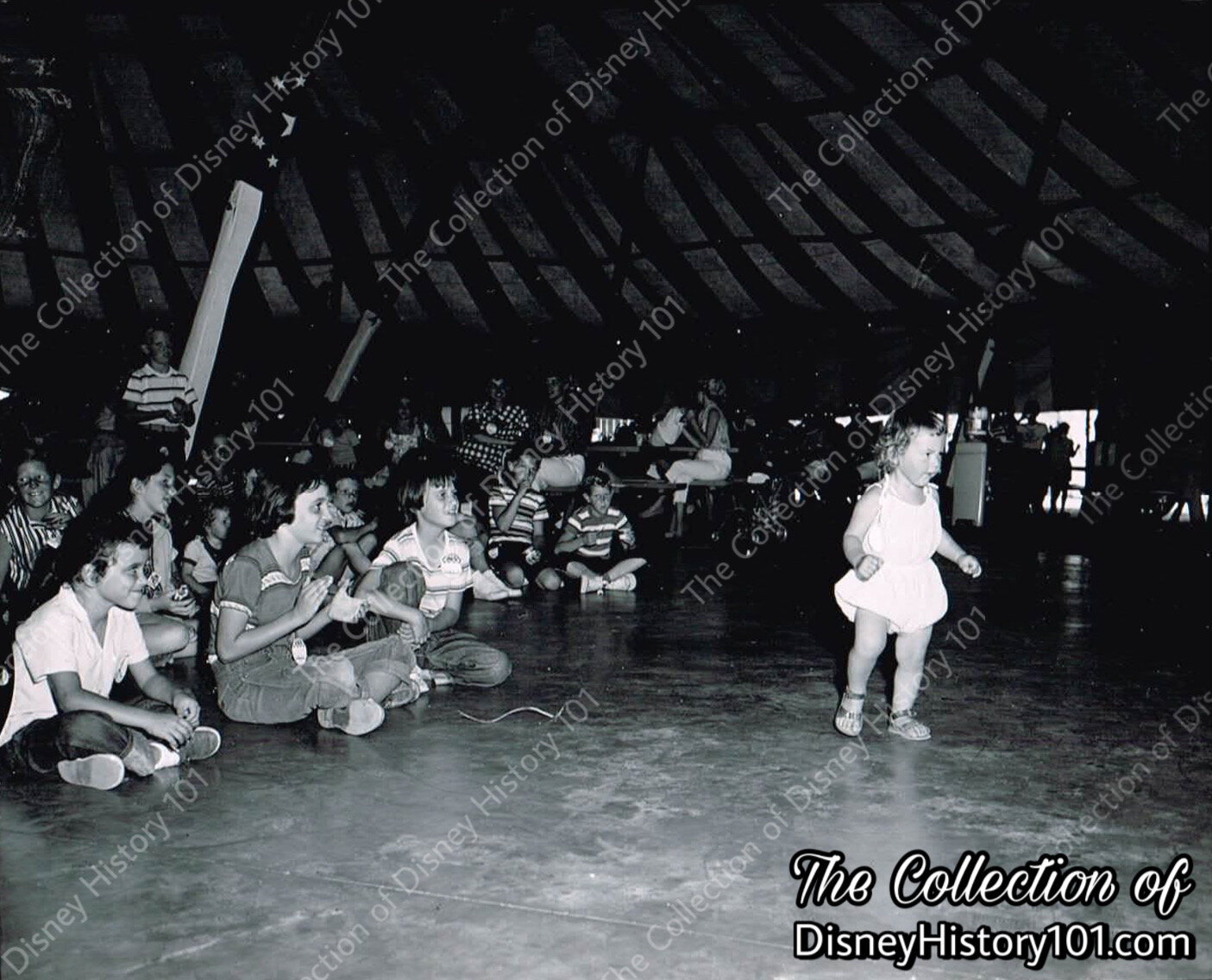
Holidayland Circus Tent, c. 1957
Hallamore Family Picnic
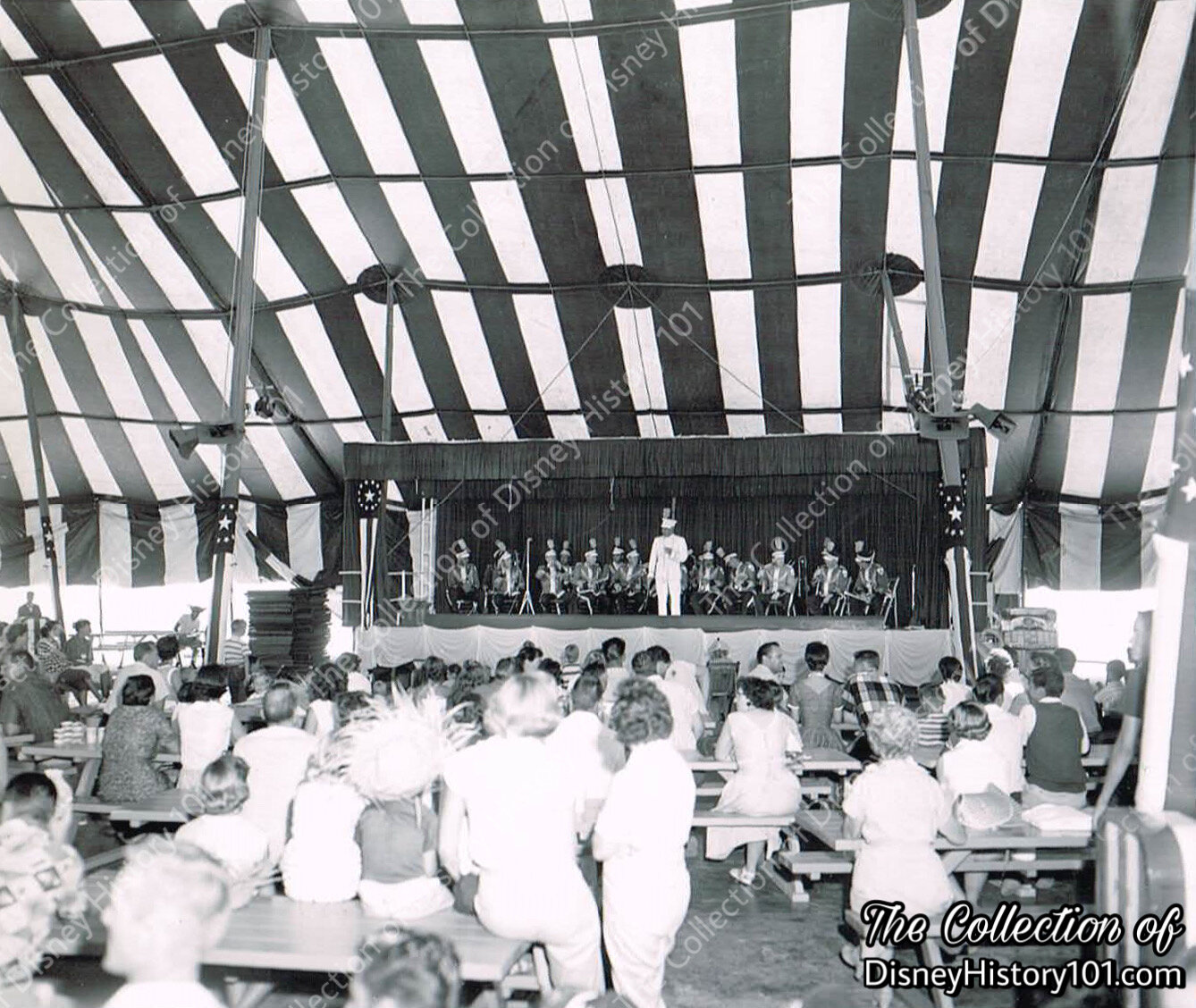
Holidayland Circus Tent Entertainment Stage, c. 1957
Note the speakers above in this Hallamore Family Picnic photo. Holidayland had a complete public address system.
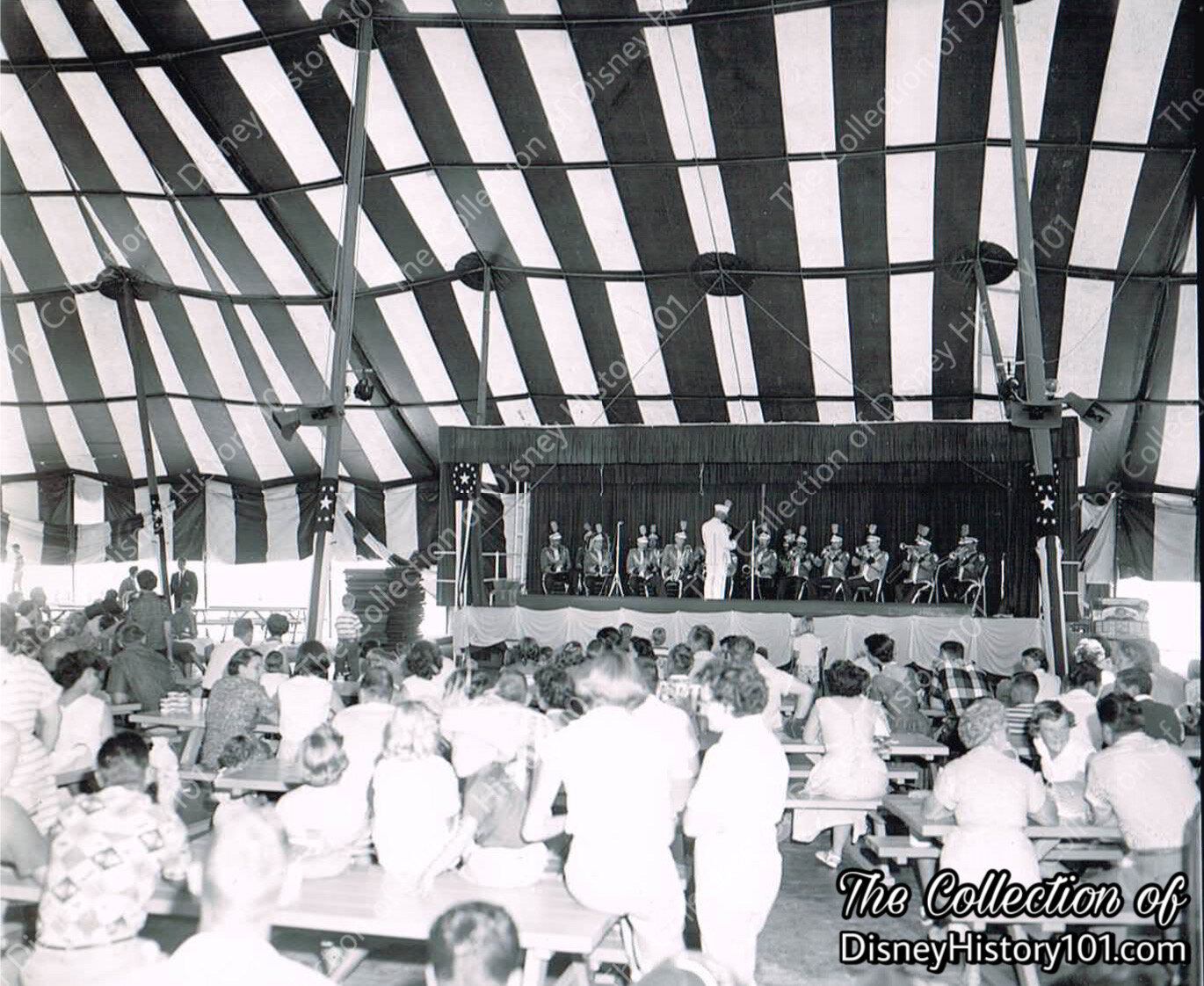
Holidayland Circus Tent Entertainment Stage, c. 1957
Hallamore Family Picnic
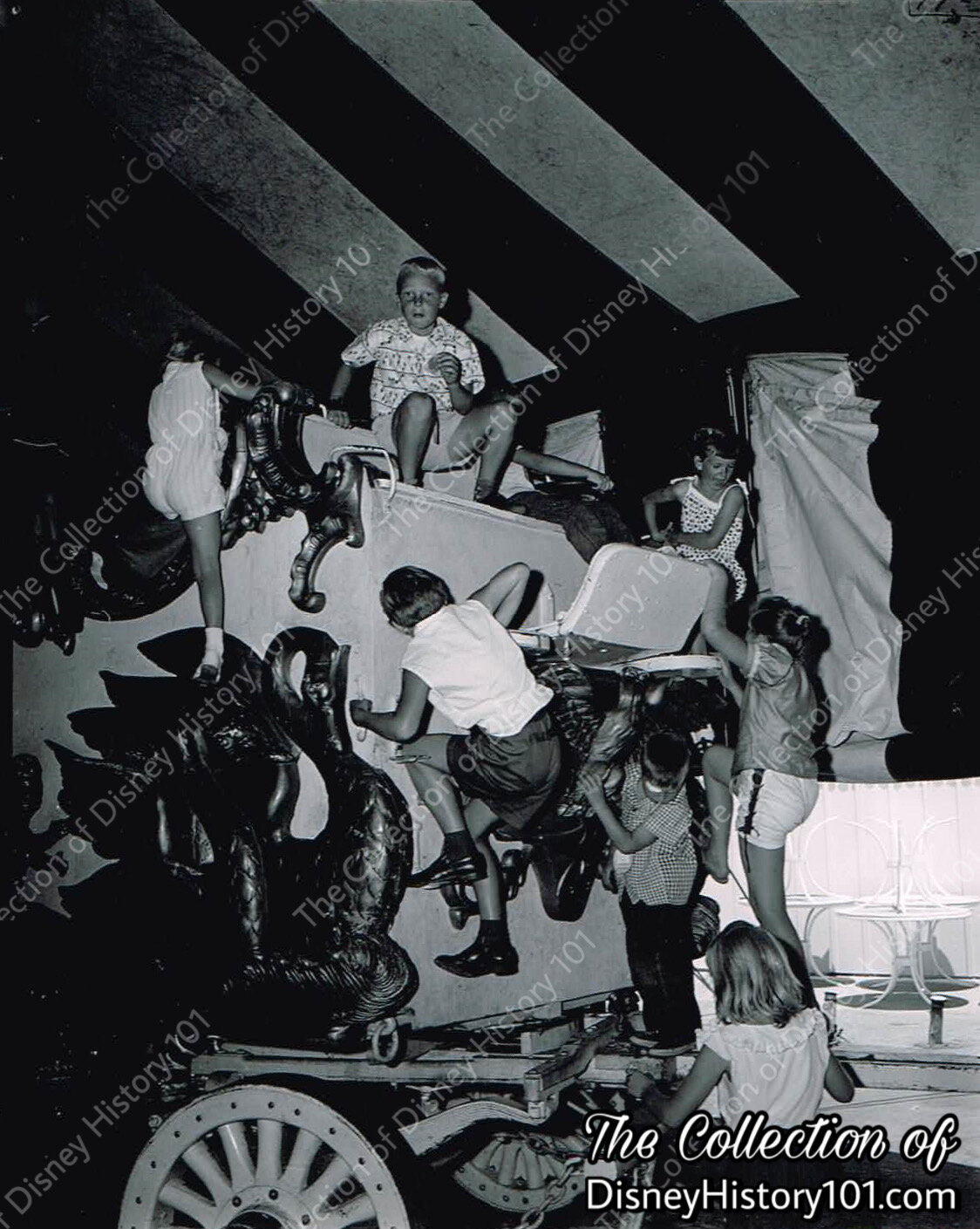
Holidayland Circus Tent and Swan Band Wagon, c. 1957
Younger guests were also occasionally found photographed climbing on what is clearly not playground equipment - the restored antique gilded wagons previously utilized in the Mickey Mouse Club Circus. Here, the younger guests climb aboard the old Bradley & Kaye Swan Band Wagon at the Certified & S. Artan Families Picnic. The Nickel Tour comments on the subject: “The wagons. unfortunately, were quickly torn to pieces at the hands of rampaging kids.”
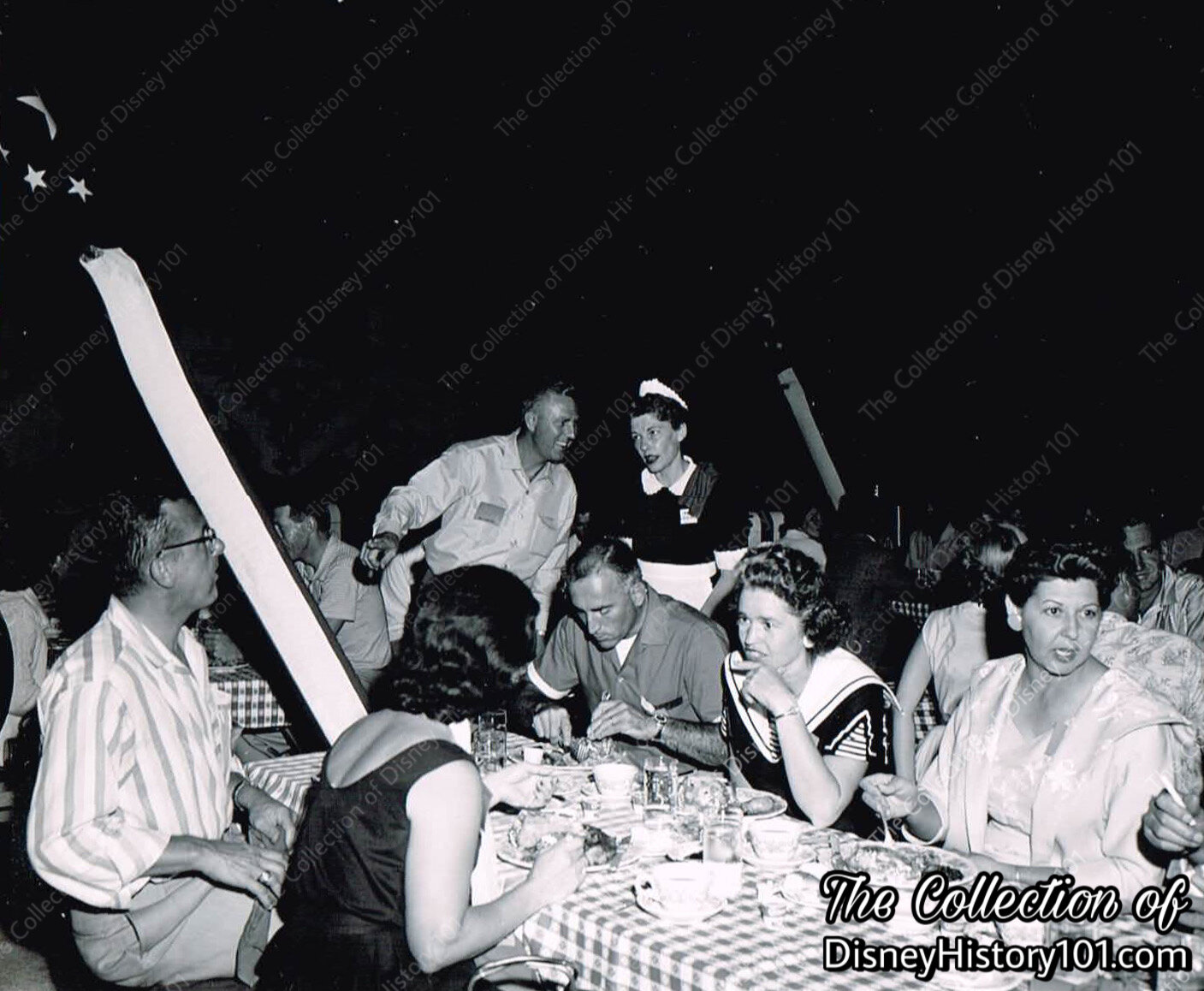
Holidayland Picnic Area, c. 1957
Sometimes the Circus Tent was used as a dining area. This memory of the Collier Carbon and Chemical Corp. Picnic features an unidentified woman wearing a costume reminiscent of the “Harvey” girl costume worn by the Main Street Train Station Concessions Manager.
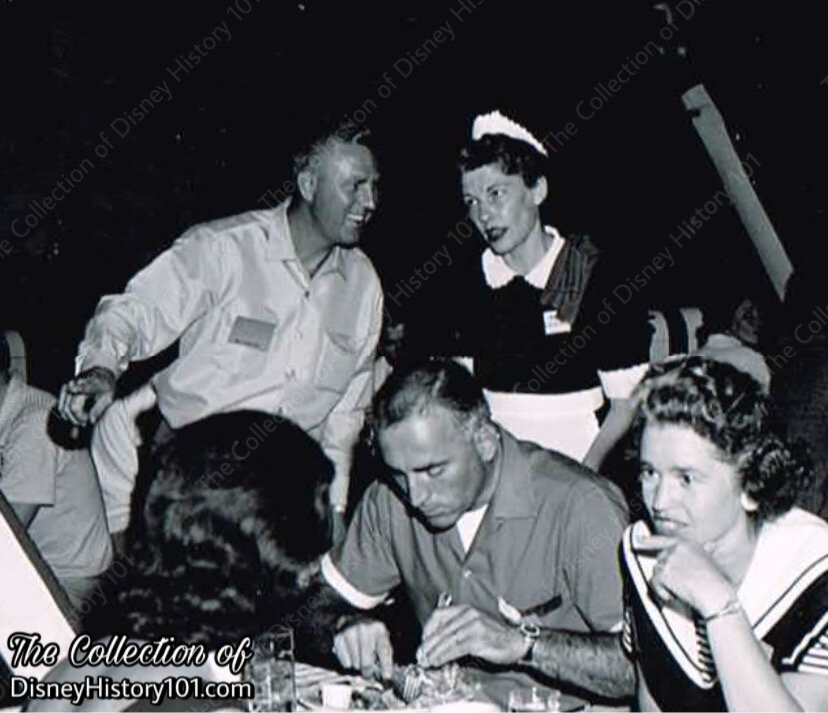
Hostess at Holidayland Circus Tent
Collier Carbon and Chemical Corp. Picnic
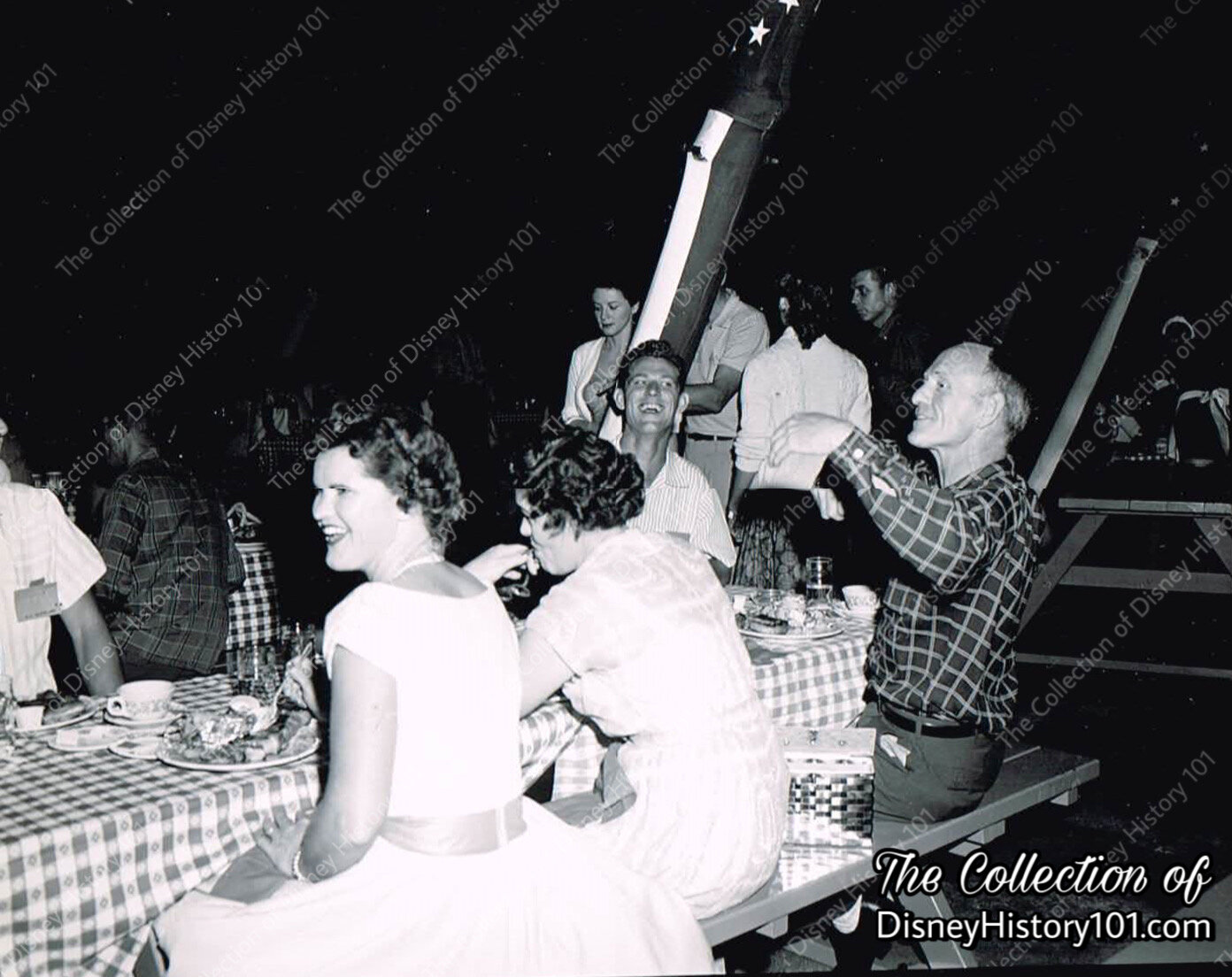
Holidayland Picnic Area, c. 1957
Collier Carbon and Chemical Corp. Picnic
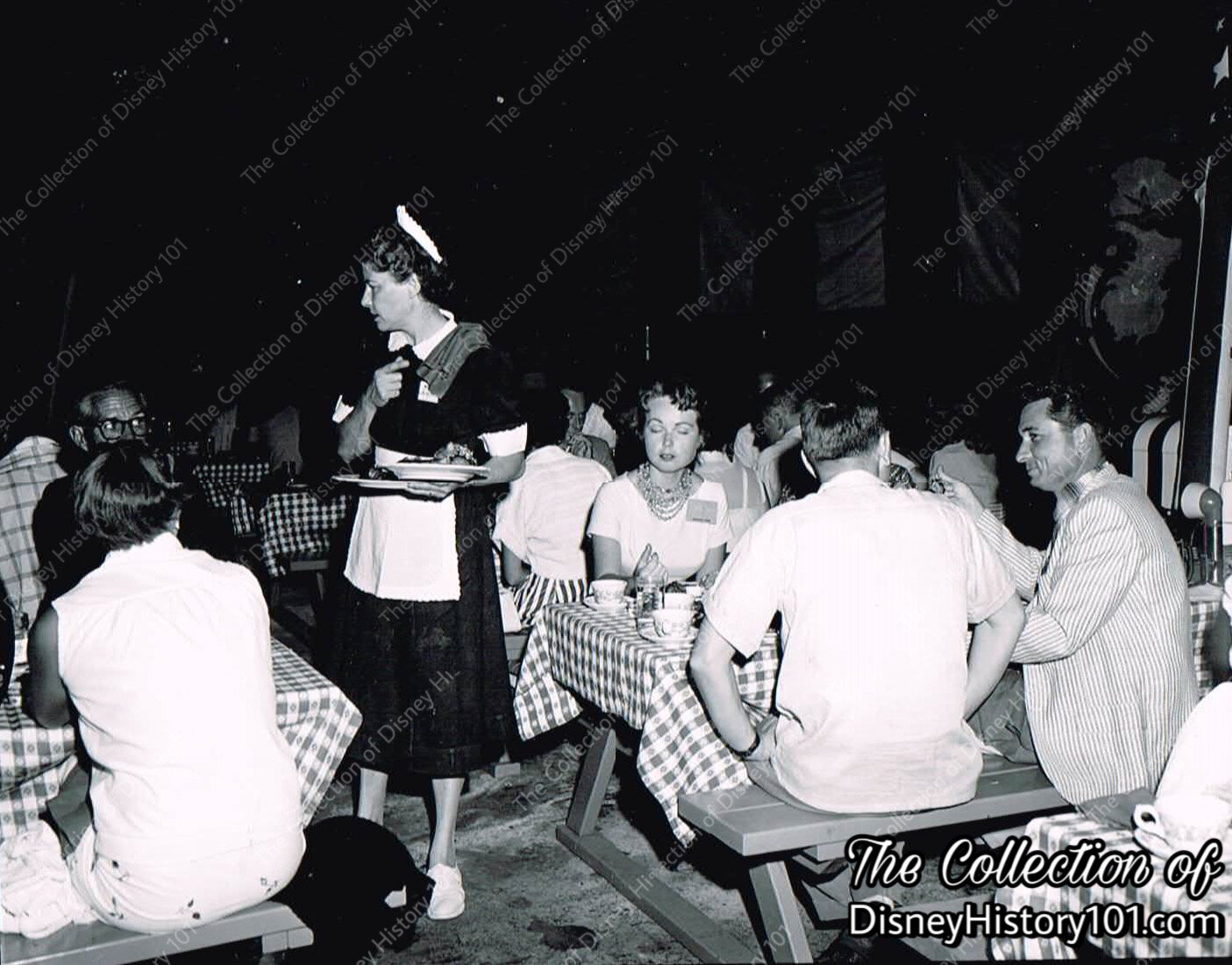
Hostess in Holidayland Picnic Area, c. 1957
Collier Carbon and Chemical Corp. Picnic
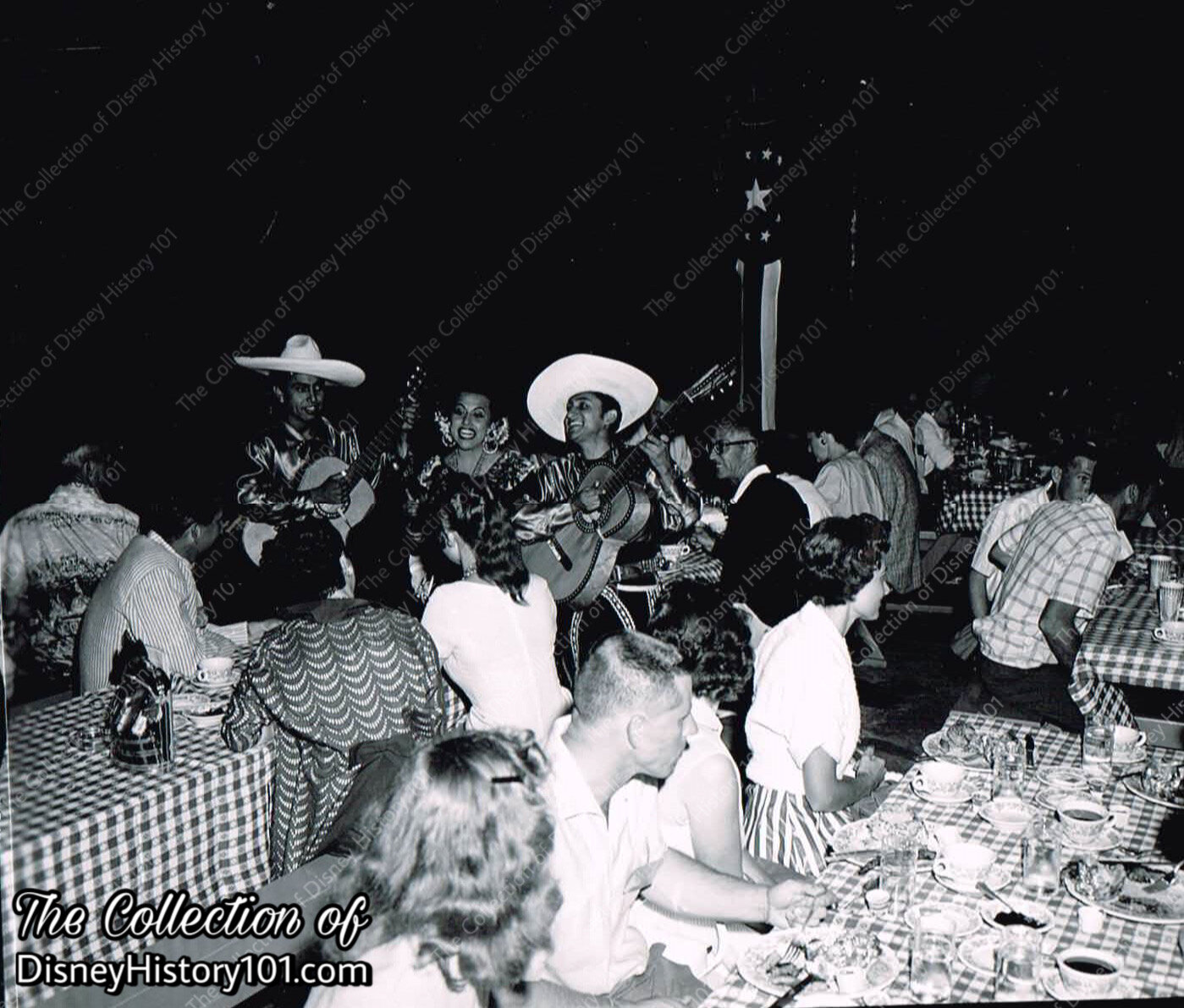
Gonzales Trio at Holidayland
A variety of live Disneyland entertainment was available to entertain Guests throughout the day. The Gonzales Trio (a regular Frontierland Mexican Village act) could be requested, and typically performed during large parties, as seen at the Collier Carbon and Chemical Corp. Picnic. During this era it was common to enjoy such popular Disneyland acts and performers (as Marshall Lucky and Sheriff Dodge, the Indians (of the Indian Village), the Disneyland Band, and the Strawhatters) in Holidayland. They could be requested and rented for large events. If you sold a minimum number of tickets to your picnic, the Mouseketeers would even perform from the Holidayland Stage.
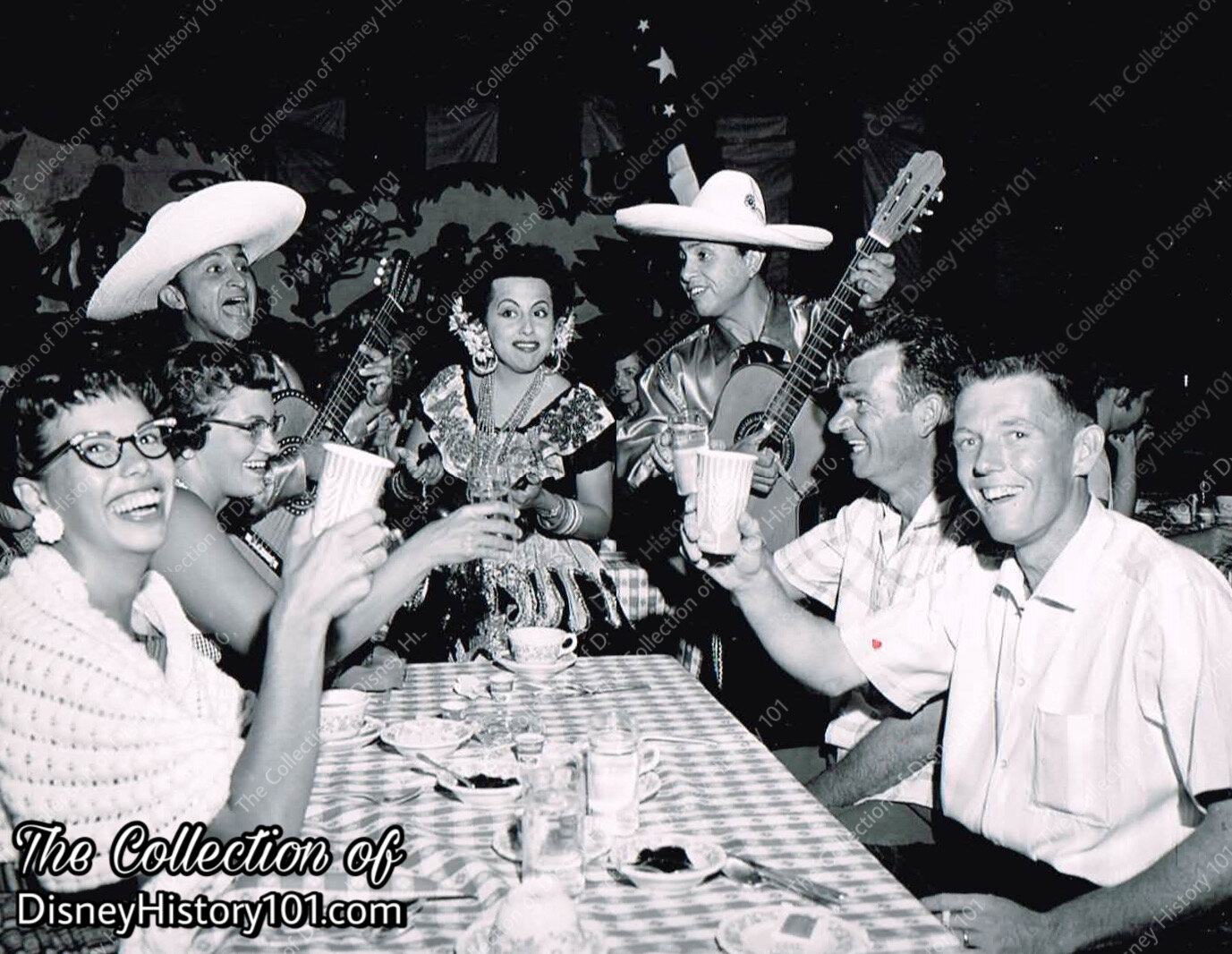
Gonzales Trio at Holidayland
Not far from the Swan Band Wagon, The Gonzales Trio creates the festive atmosphere of the Collier Carbon and Chemical Corp. Picnic!
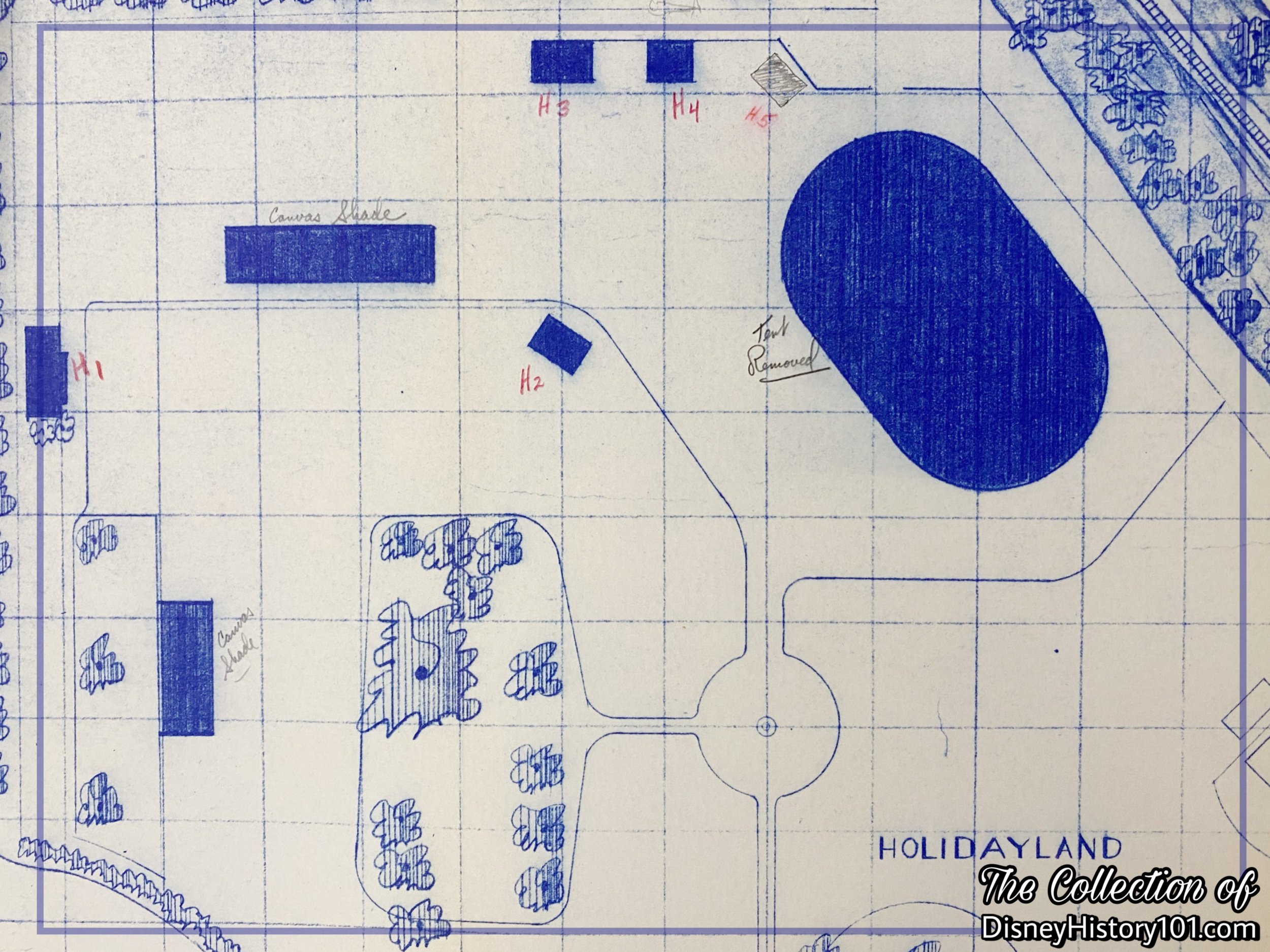
A hand-written note indicates the addition of a structure and removal of the Tent (a notable Holidayland feature) on this Disneyland Plot Plan generated around 1958.
Note the “tent removed.” The Nickel Tour commented: “Holidayland's first season ended with one of those mysterious omens we love so much... the infamous Santa Ana winds that howl across Southern California each fall. The winds attacked the candy-striped circus tent with a vengeance, literally tearing it to shreds.”
The small structure (rendered in pencil) may have been Disneyland, Inc. Job #032-50-47. By 1958, Disneyland, Inc. opened and closed Job #032-50-47 for the installation of an 81’ x 16’ chain link and canvas storage unit in Holidayland. After totaling costs by Disneyland and the Studio (for General construction, Labor, Outside purchases, Studio Overhead, Roof and front panel - Storage unit) and Sub Contracts (including Guardian Fence), the entire project cost $658.78.
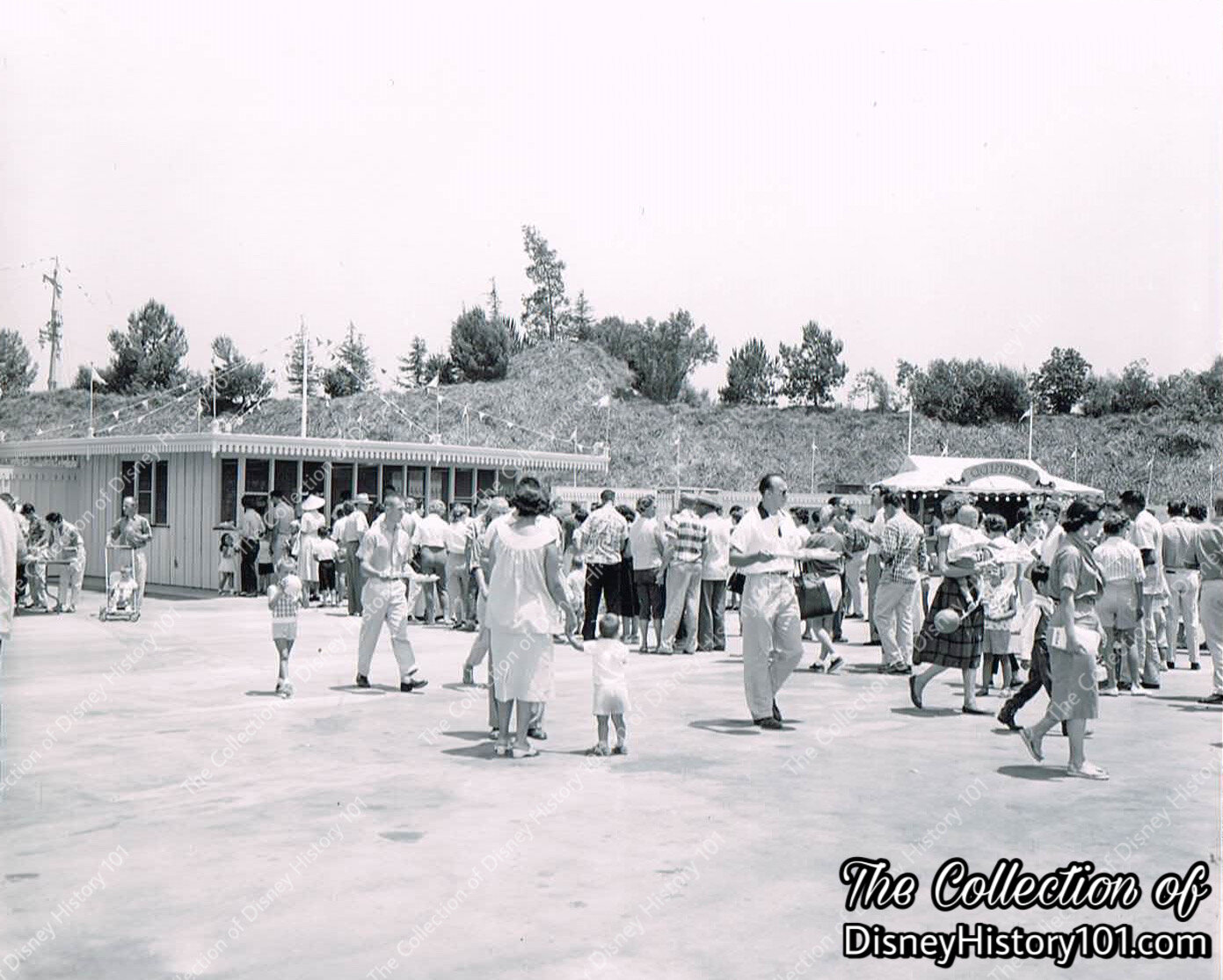
Holidayland Ticket Booth Complex
After the festivities were finished, guests were encouraged to visit Disneyland. A rather large Ticket Booth structure can be seen (next to the Coffee Kiosk) in these preserved memories from the Moore Business Forms Rediforms Picnic.
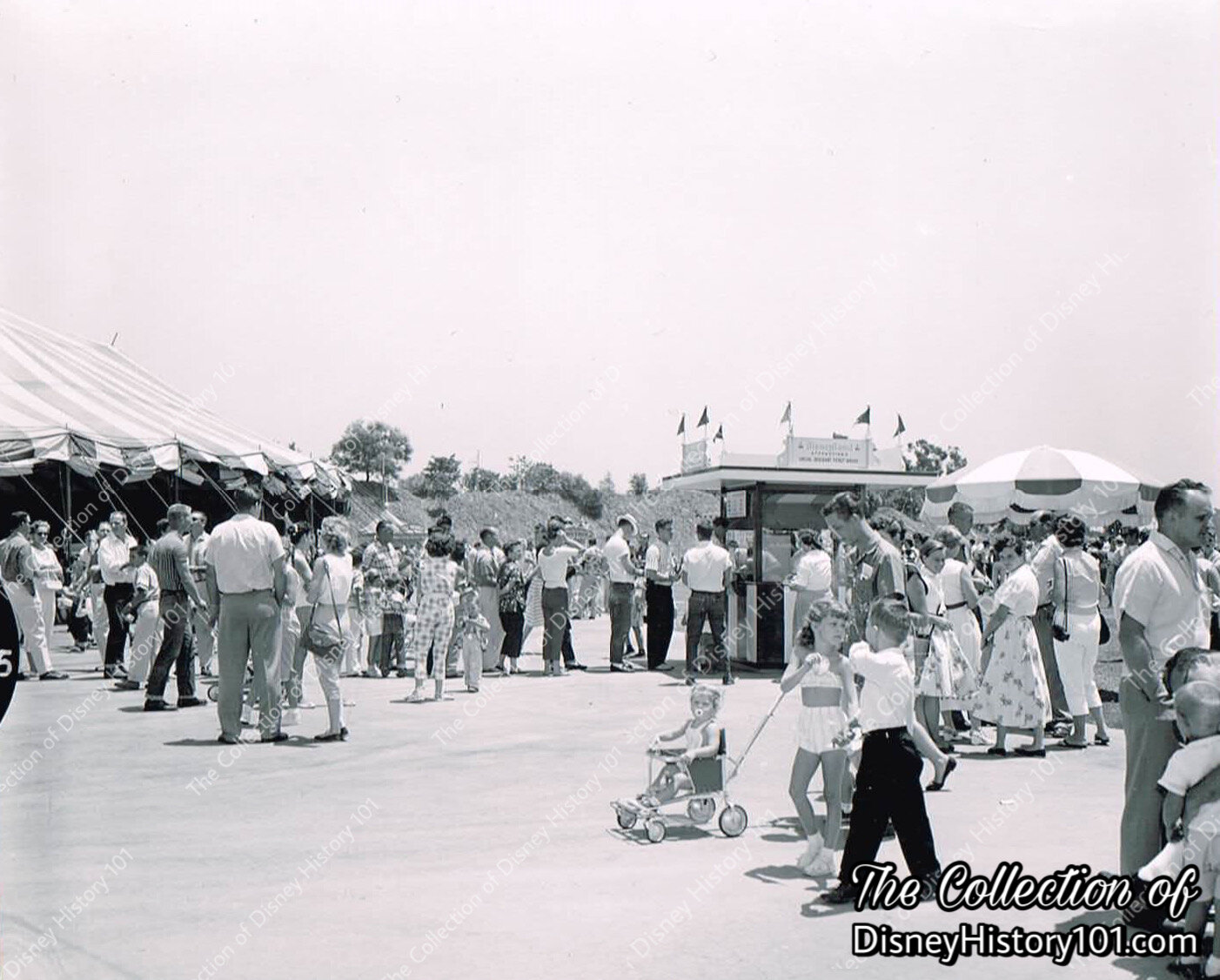
Holidayland Circus Tent & Ticket Booth, c. 1957
In a paved and level area of Holidayland (near the Circus Tent), stood a Disneyland Ticket Booth, as seen in this memory captured at a Certified & S. Artan Families Picnic.
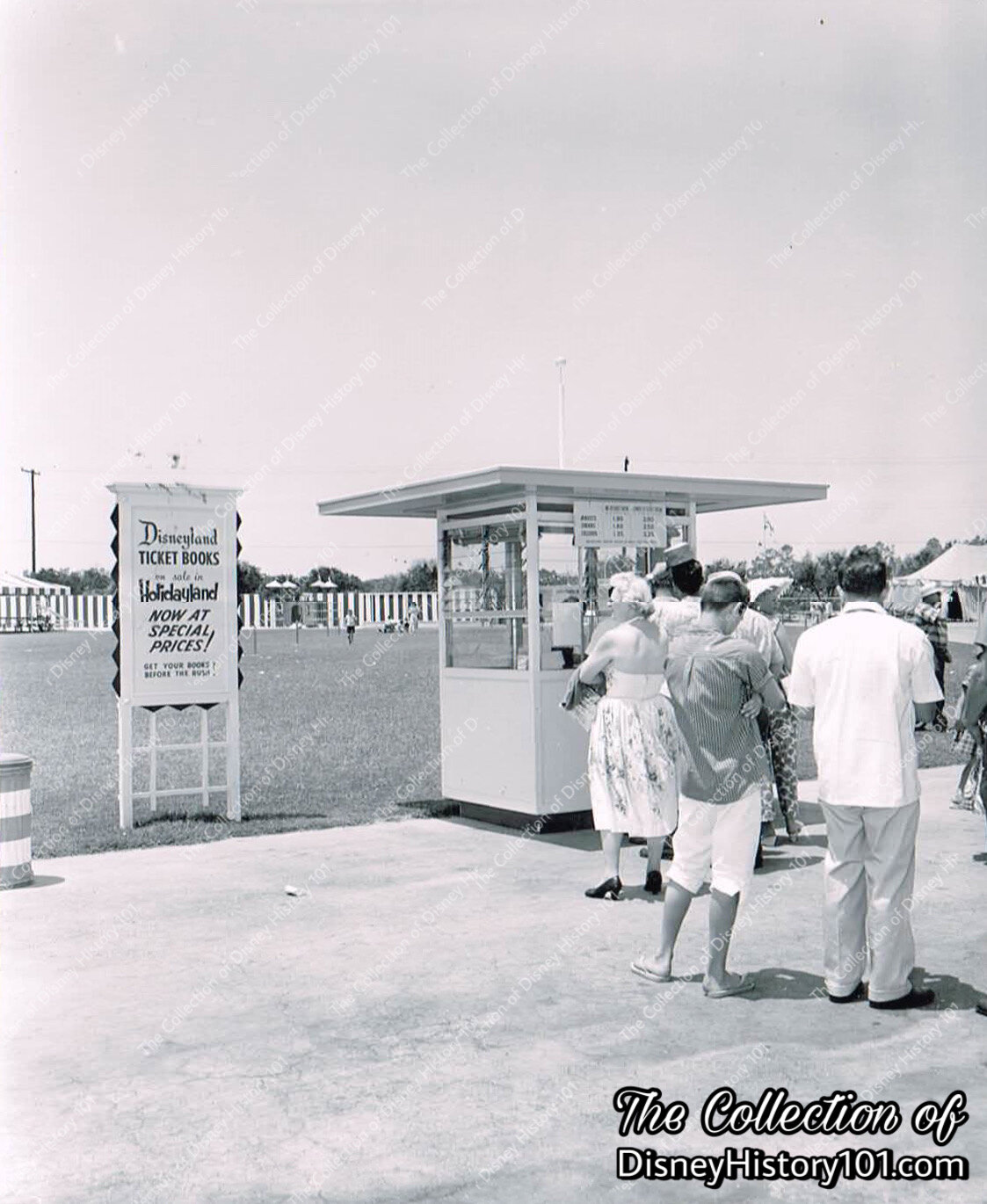
Holidayland Disneyland Ticket Booth, c. 1957
According to “The Nickel Tour”: “Guests at Holidayland could see the Santa Fe & Disneyland Railroad trains traversing Frontierland, and could hear the blast of the Mark Iwain's whistle as it steamed along the river.” However, “admission to the Park was not included with the picnics… And that was a big mistake. ‘It was a terrible concept that failed miserably,’ recalled Milt Albright, Holidayland's original manager. ‘Walt whipped the guys responsible for it, and, unfortu-nately, I was one of those guys.’”
Soon, in 1958, Milt Albright founded the Magic Kingdom Club, which “offered discounts and special admission tickets to card holders. At its peak, the Magic Kingdom Club boasted nearly 6 million members associated with more than 30,000 companies worldwide.” These Magic Kingdom Club memberships were also sold (through the Holidayland Ticket Kiosk), to employees of companies that utilized Holidayland for events. Many Holidayland guests (like these Moore Business Forms Rediforms Picnic guests pictured above) take advantage of the Disneyland Big “15-Ride” Coupon books at “special pricing” - a 10 % reduced price of $3.60! After the founding of the Magic Kingdom Club brought many more visitors to Disneyland and Holidayland, something amazing followed!
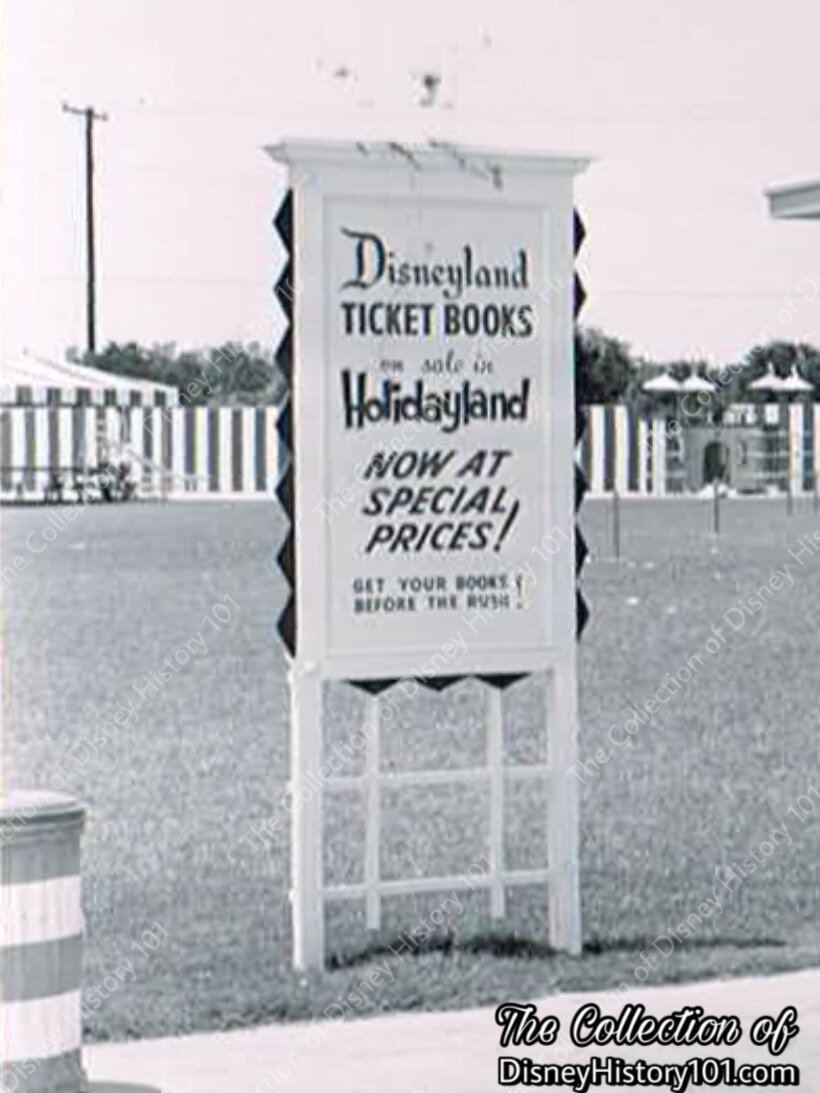
Holidayland Ticket Book Billboard

Sam McKim Disneyland Map Excerpt, c. 1958.
When Disneyland was being designed, Walt intended for only one main entrance in which all guests would pass. Now, an adjoining “entrance from Holiday Land to Disneyland, to be used exclusively by picnic and convention groups,” was part of the original plans, according to the “Disneylander” (May, 1957). However, the first Disneyland Dictionary (printed October of 1959) made no mention of this entrance stating: “There is only one Guest Entrance - it is located at the South end of the Park, facing the Parking Lot.”
When it was installed, such a gate allowed guests (with Disneyland tickets) to enter Disneyland through the “Special Gate” (as it was labelled on some tickets) located near the Santa Fe & Disneyland Railroad Frontierland Station. From there, guests headed over or through the tree-lined berm, and came upon Magnolia Park, just southwest of the Rivers of America. The author of The Nickel Tour profoundly remarks on this subject: “This short-lived deviation marks the only time in its history that Disneyland has ever had a second guest entrance.” Even with the coming New Orleans-inspired additions to Frontierland, it seems that the idea of maintaining Holidayland’s own Disneyland Entrance Gate (the Holidayland Gate) was briefly entertained.
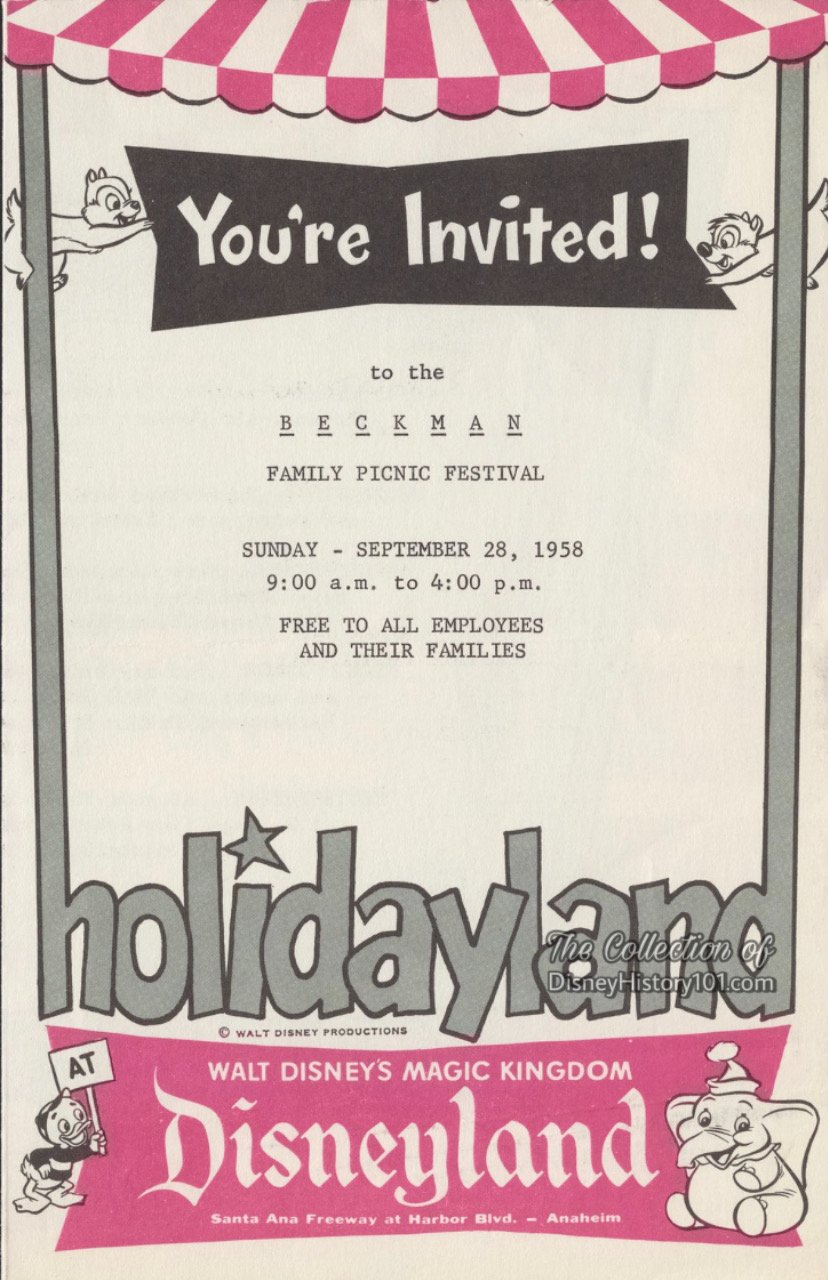
By 1958, a structure (located on West Street) once known as the “Brown House,” had a Holidayland sign hung over it and was used by the Holidayland staff like Dorothy Manes (Youth Activities). The staff was in charge of scheduling all youth groups through college age, such as Boy Scouts, etc., into the Park. Conventions, tours and adult parties were brought into the Park and Holidayland by Walt Roberts and staff. Young men in the Industrial program were bringing people from all over Southern California into Disneyland via the 20-ride ticket book which was available to any organization - as well as booking picnics into Holidayland for 1958 and as far ahead as 1959. This program was being guided by Don Norman. During 1958, the Brown House staff had set a goal of 582,000 Disneyland quests in the current year.
The year 1958 brought the “Kid’s Amateur Dog Show” to Holidayland (during March of 1958). Another big organized event occurred when Disneyland and Holidayland hosted a massive 3-day event - the Fifth Annual California Square Dance Convention, held on April 11, 12, and 13, 1958. The members of 49 separate clubs belonging to the Western Square Dance Association attended the convention. Workshops and various types of dances (both round dancing, and square dancing) were held in Holidayland’s various tents (the Main Tent and the “Round Dance Tent”) as well as on the surrounding grounds of Holidayland. This was a huge event attended by Mr. and Mrs. Goodwin Knight (the Governor and his wife) among other notable individuals.
Owing to some of the guest capacity, an 8’ x 16’ chain link and canvas Storage Unit was added during 1958, at the cost of approximately $808.39 (between Disneyland and the Studio).
Beckman Instruments, Inc. held their Family Picnic Festival on September 28, 1958. This was the peak of Holidayland! By September of 1958, Holidayland Park assets were appraised at a total value of $158,743. The figure included $108,749 of land improvements including landscaping and paved areas ($88,865), an entrance marquee ($6,199), additional fencing ($6,858), and canvas shade control ($6,827). The figure also included a food catering building ($20,627), public rest rooms ($20,274), ticket booths ($4,087), and props and dressings ($5,006). Sometime later, an 8’x6’ chain link and canvas storage area (Disneyland Inc. Job #032-50-47) was constructed by the Studio and sub-contractor Guardian Fence (at a cost of $658.78).
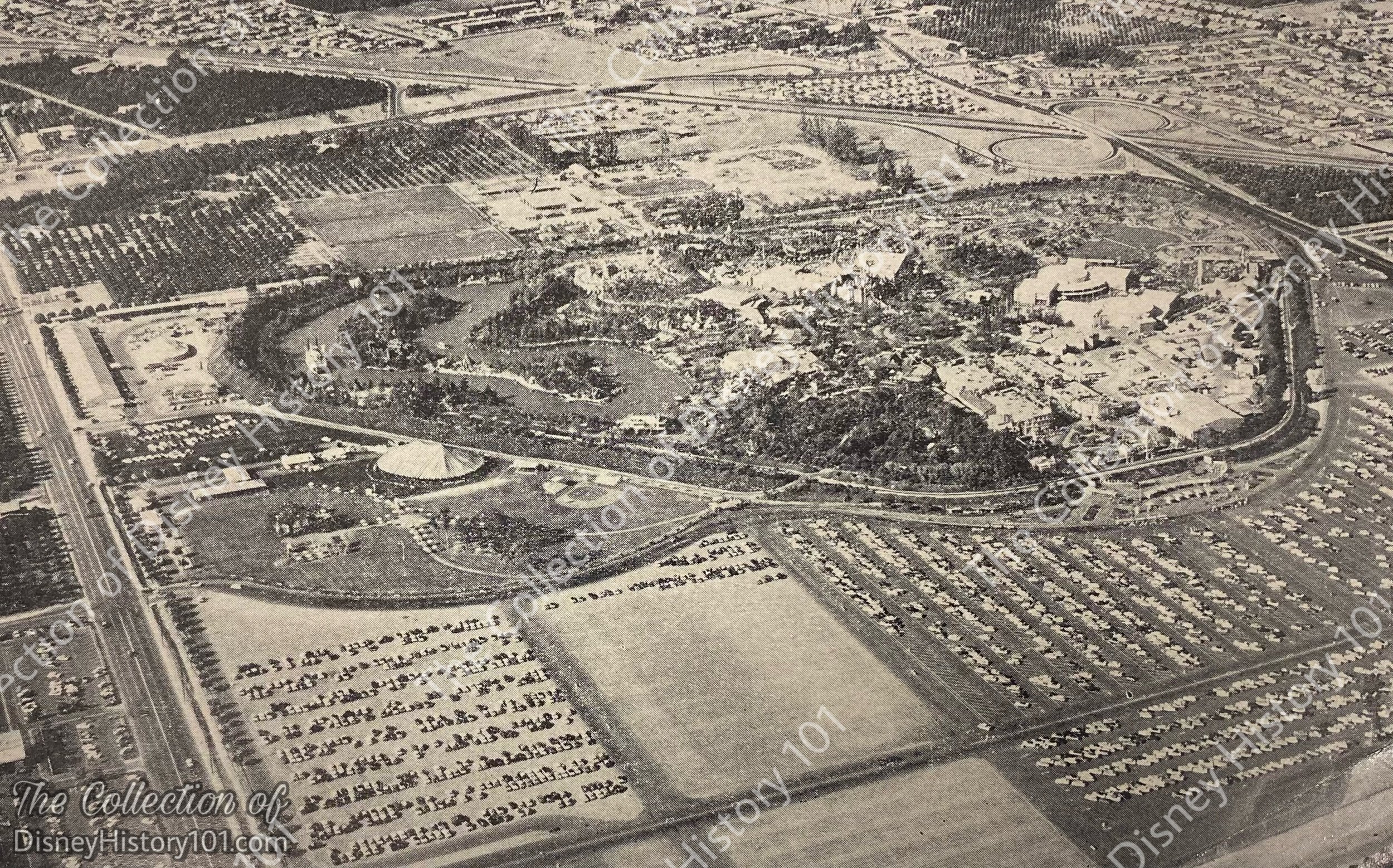
A photo published in a souvenir of the Rotary International 2nd annual conference held at Disneyland on October 31 & November 1, 1958.
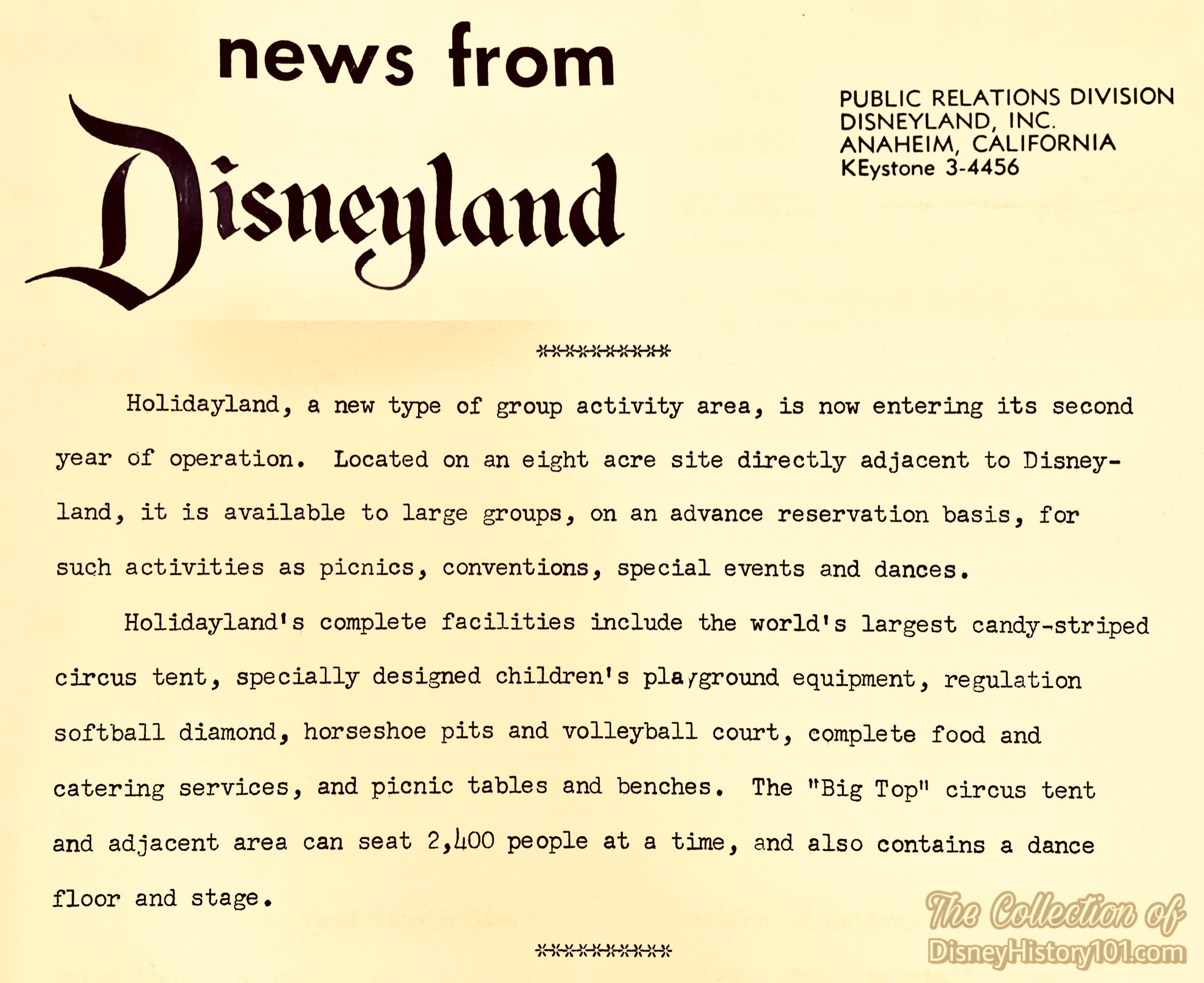
Holidayland celebrated “Disneyland ‘59.” A banner was draped across the Holidayland stage within the Circus Tent. The Al Malaikah Shriners and their families had a picnic in Holidayland and a parade in Disneyland (on May 23, 1959). The Road Lords’ organization held the “Car Club Day & Autocade” - their first (and only) annual show held at Disneyland - on September 5, 1959. Participants drove their auto entries down Main Street U.S.A., before heading to Holidayland for exhibition, judging, and an awards ceremony under “the big top”. This event was well-chronicled and published in “Rodding and Re-Styling” during March of the following year (and excerpts of that article can be seen below). This is perhaps the only periodical to memorialize Holidayland in such a pictorial fashion!
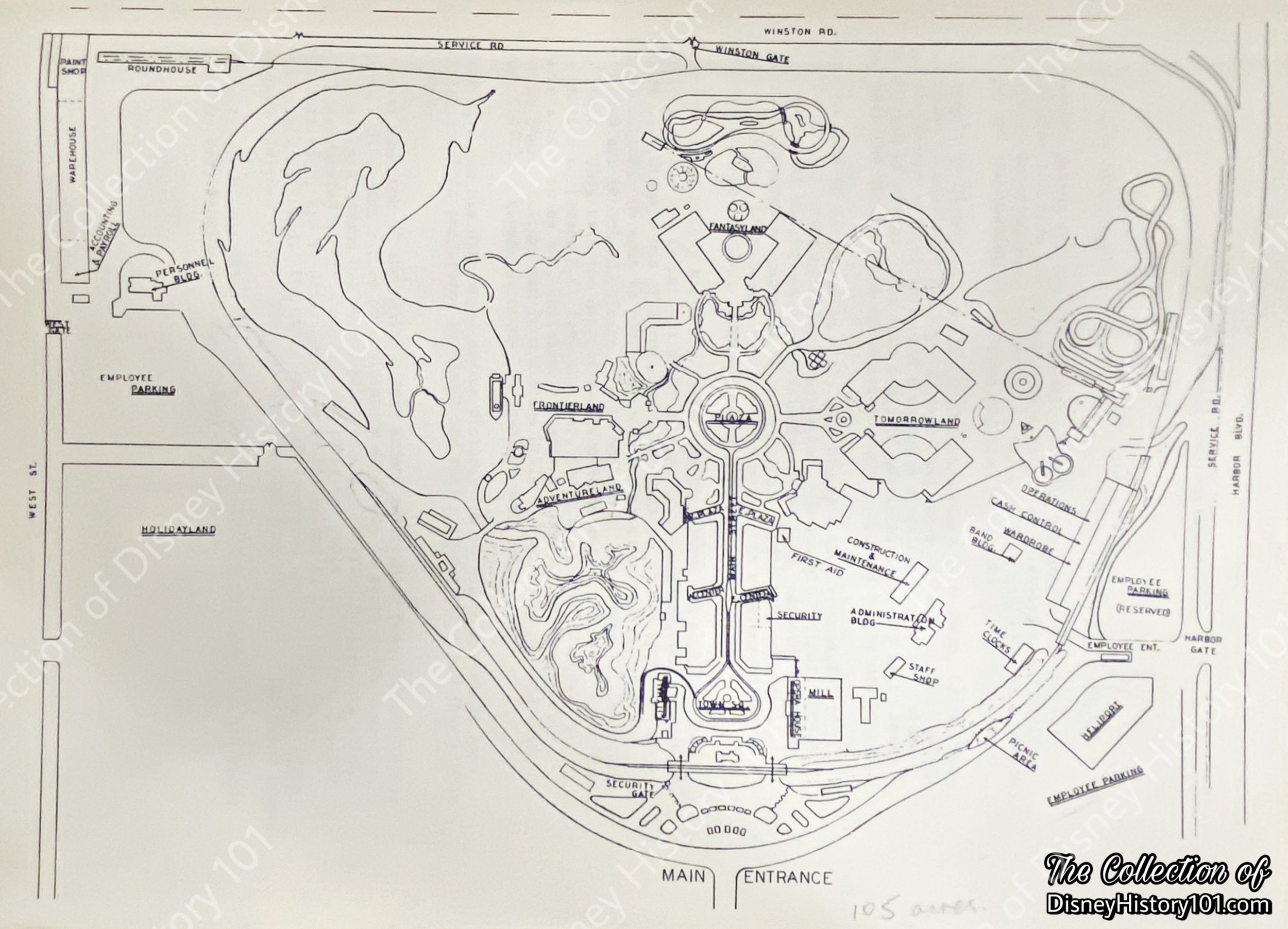
Note Holidayland in this map excerpt in The Disneyland Dictionary, printed October of 1959.
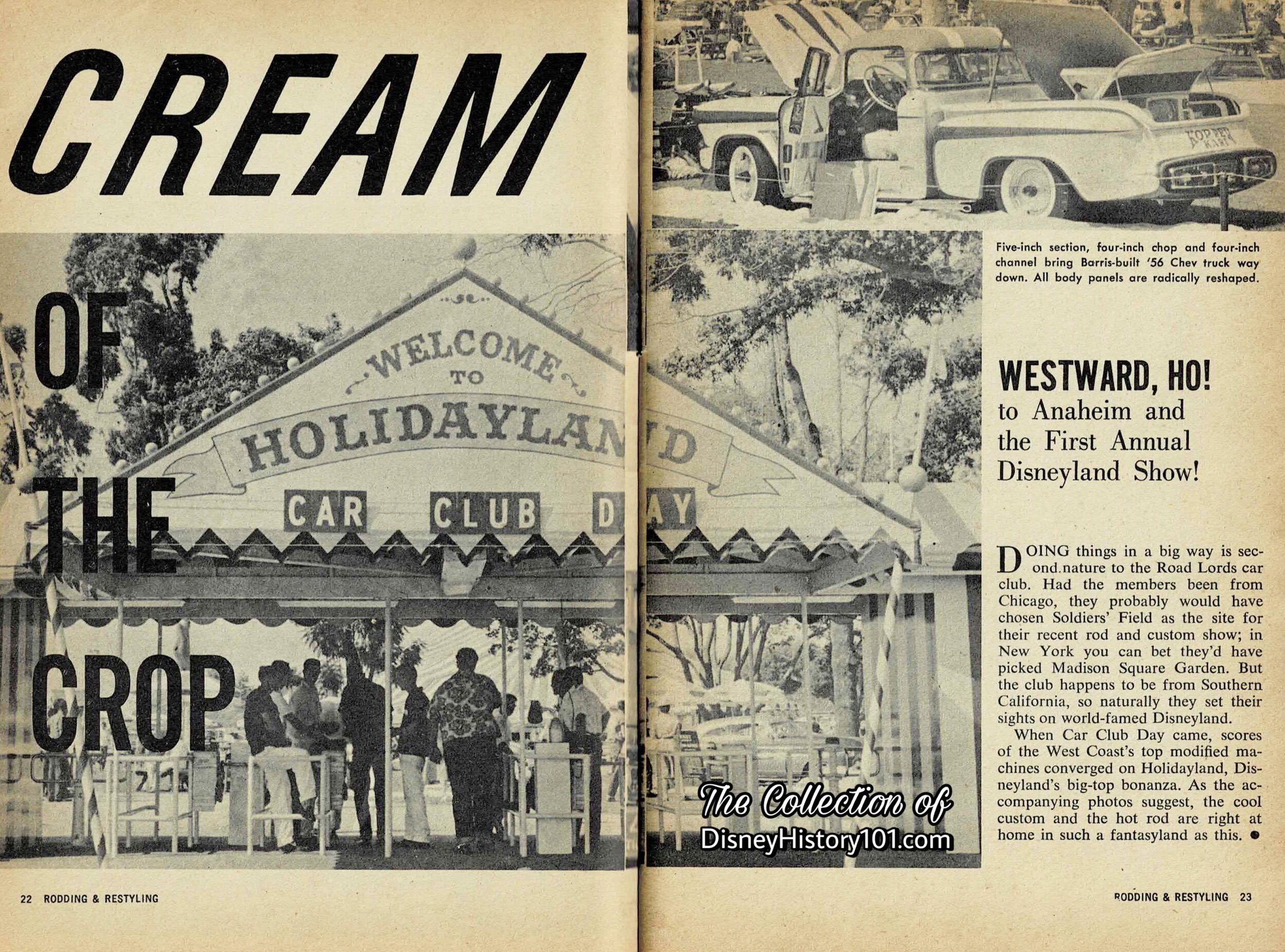
“Rodding and Re-Styling” Magazine Article, (published March, 1960)
The Road Lords’ Car Club Day included an exhibition of custom motorcycles (one pictured on the following page).
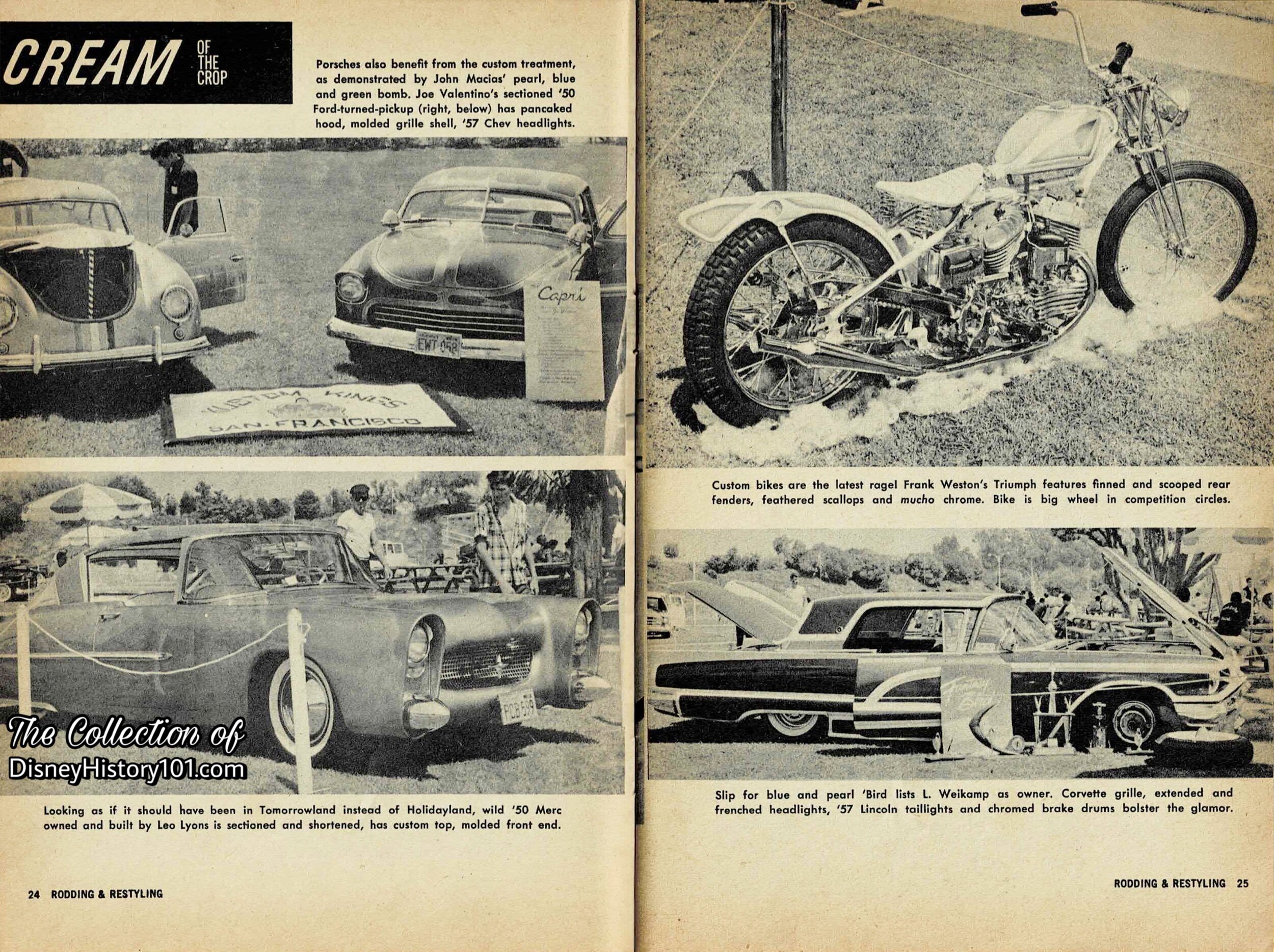
“Rodding and Re-Styling” Magazine Article, (published March, 1960)
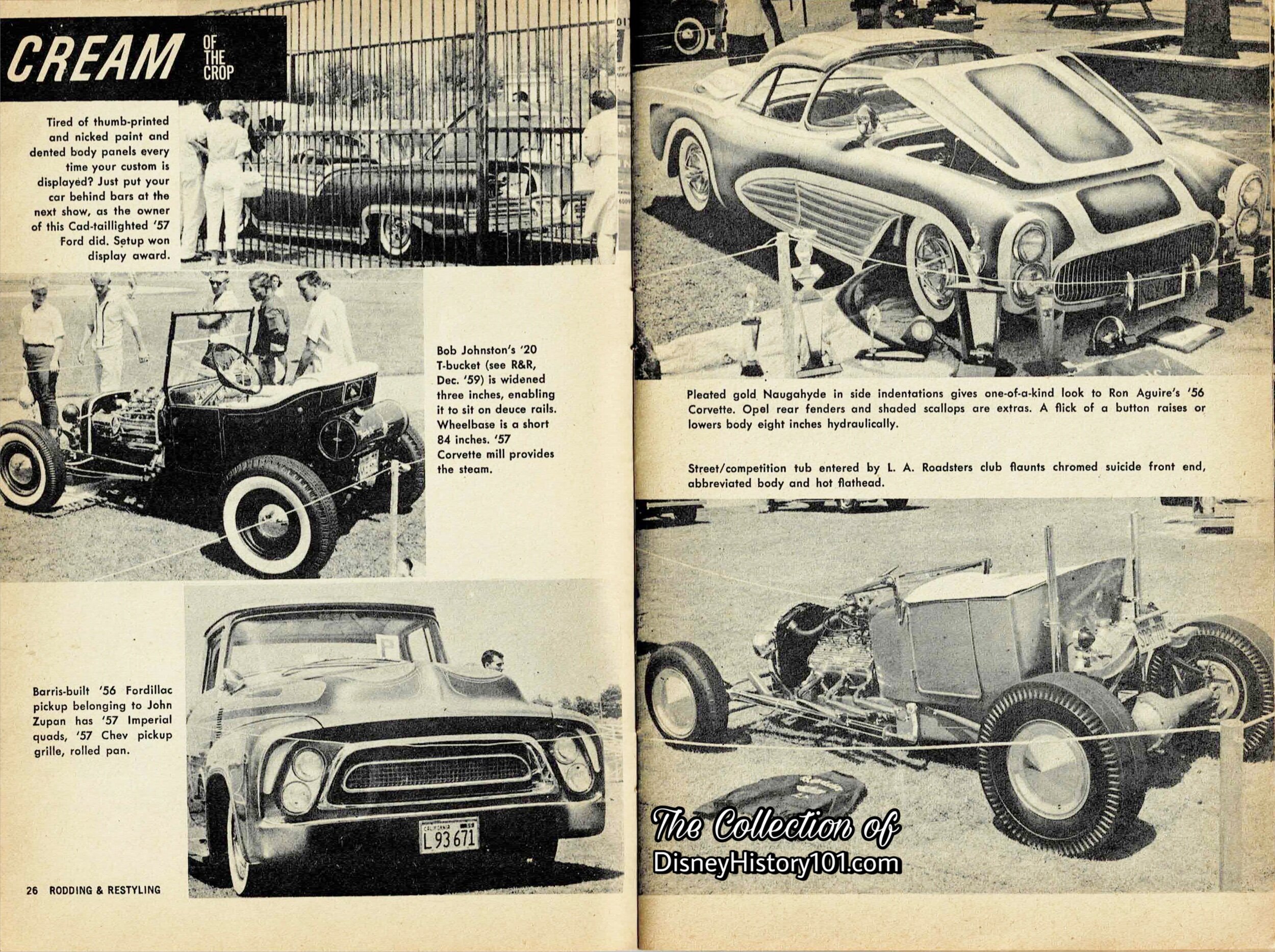
“Rodding and Re-Styling” Magazine Article, (published March, 1960)
Custom hot rod designer Ed “Big Daddy” Roth debuted his “Outlaw”, the “Excalibur” at this car show.
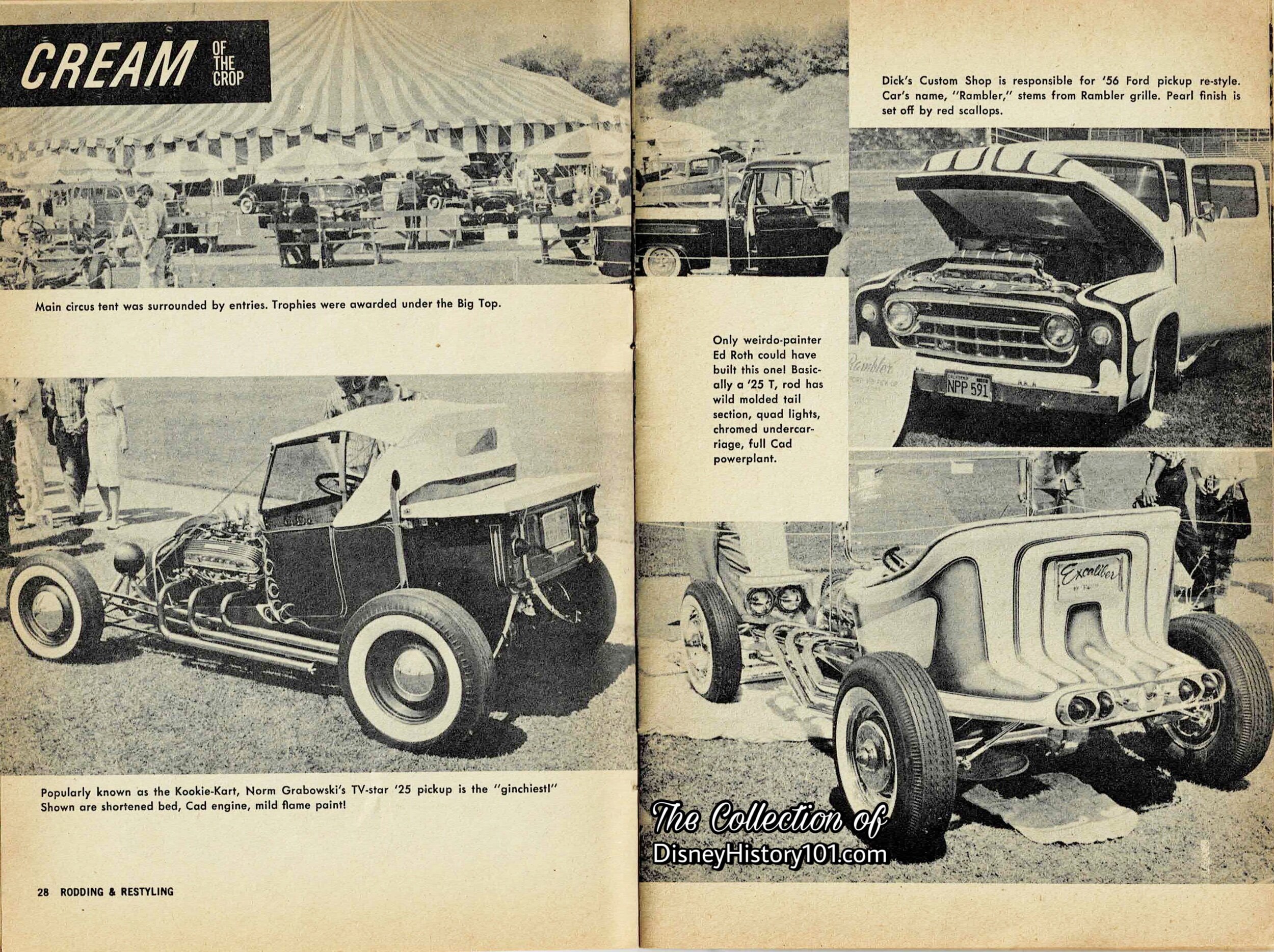
“Rodding and Re-Styling” Magazine Article, (published March, 1960)
Also of note, Holidayland hosted their first National Pop Warner Disneyland Bowl December 15th, 1959. This would become a Disneyland tradition for the duration of Holidayland’s operation and for many years thereafter! Perhaps owing (in part) to the latter, a 1-year insurance liability policy was taken out at a premium of $3,010, in 1959.
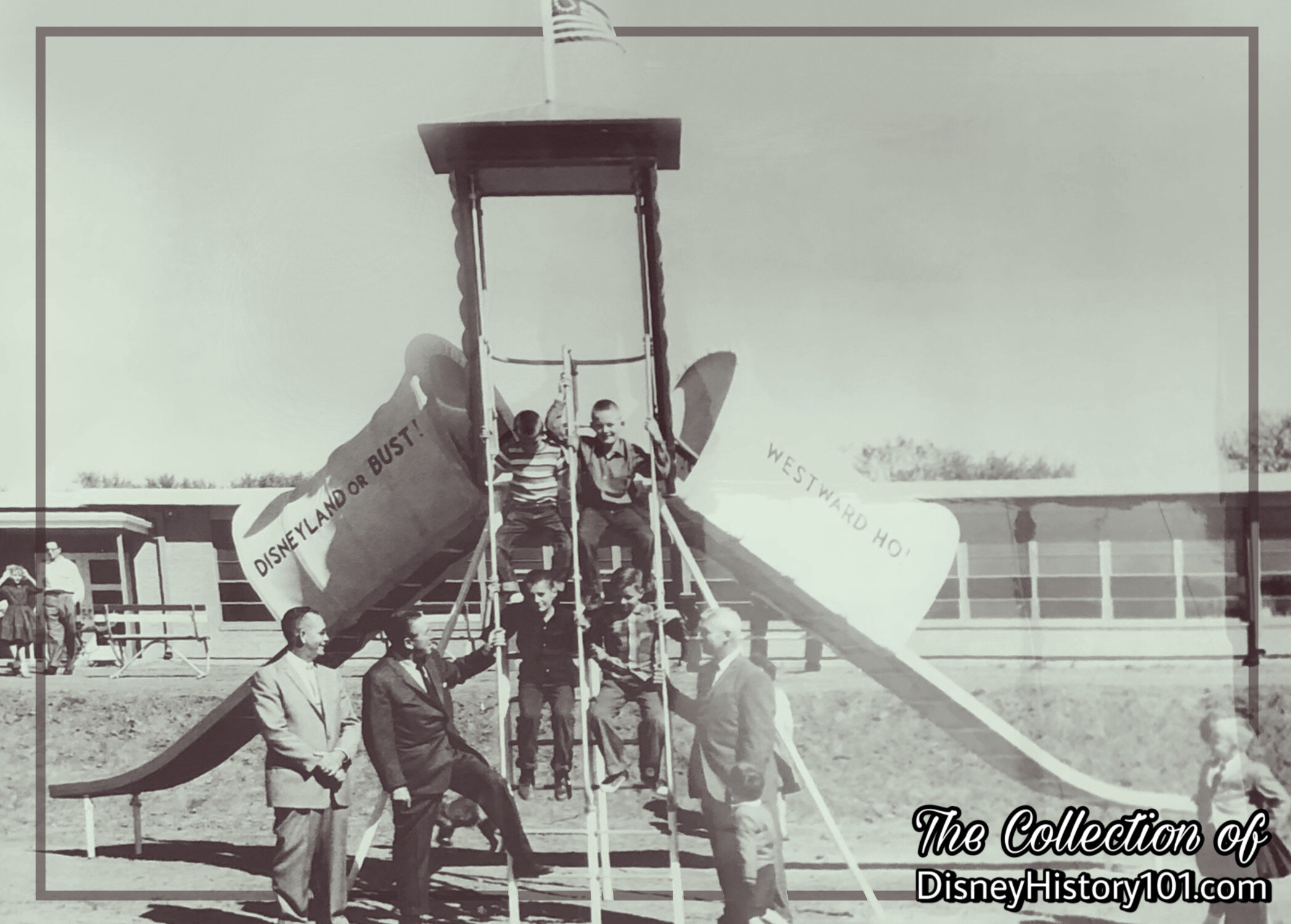
Walt gifts the Westward Ho! Slide to Walt Disney Elementary on Sunday, October 16, 1960.
“The Final Year of Holidayland Operation”
By 1960, Milt Albright had become the founder of the Magic Kingdom Club and Tim Hahne (of Disneyland Construction and Maintenance) had transferred to the Disneyland Operations Division, as Holidayland Supervisor. He would continue to oversee the Park for the last year of its operation. The year saw an Old Fashioned Fourth of July picnic on Monday, July 4, 1960. During 1960, Walt Disney gifted and dedicated the Holidayland Westward Ho! Slide to Walt Disney Elementary in Marceline, Missouri.
By the time the Monorail reopened (during the summer of 1961) with its new length of track to the Disneyland, its passengers would have received passing glimpses of Holidayland on their way to the Disneyland Hotel (at least for a couple of months). One of the last major (and noteworthy) events held at Holidayland was a Press Preview of Disneyland’s summer season held June 16th, 1961 [*some sources cite June 10th, 1961].
By 1961 new Disneyland adventures were being added for unveiling in 1962 and 1963. These included a completely new Jungle Cruise, the “world's largest” Tree House, a unique new concept in restaurants, and a “Safari Shooting Gallery” debuting during the Summer of '62. For 1963, a Haunted Mansion, New Orleans Square and the Blue Bayou Mart are being readied. Disneyland, “The Happiest Place on Earth” was becoming a permanent resident of Anaheim and doing its part in helping the community grow. However, Holidayland was clearly not on the menu.
So while Private Parties at Disneyland (introduced during the prior May of 1960) would continue for years to come, the Holidayland turnstiles would close for good, during September of 1961. All together, Holidayland had operated for a total of four years and three months, all-the-while hosting events and picnics for a variety of corporations and organizations and their families.
This was a little odd because the City of Anaheim was in search of more spaces for parks and recreational spaces. In fact, by 1961, the City of Anaheim only had a total of five community parks and six neighborhood parks either fully developed or in the process of development. The community parks had facilities to serve large residential areas with many types of recreation like lighted ball fields, buildings equipped for meetings and recreation, in some cases municipal pools, picnic facilities, and similar facilities necessary for major park activities. Future city plans (under the direction of William Stronach) were calling for the development of an additional three community parks while eight additional neighborhood park sites were being developed.
This was to the end that many local Anaheim area merchants supported the development and maintenance of recreational areas, parks, and playgrounds through taxes paid. Anaheim area residents were petitioned (through newspaper advertisements) to patronize such local merchants, and help to provide revenue for those facilities.
So why did Holidayland close? Milt Albright recalled in 1988: "It wasn't any one thing that killed Holidayland… It was just the combined effect of a whole lot of little things."
First, “Holidayland picnics were… getting more and more difficult to sell, and now, with the added cost of Park admission, group picnics were getting too expensive for all but the biggest organizations… Worse still, there were no lights for nighttime events, so evenings were out. That meant Holidayland sat unused five days a week.“[The Nickel Tour] As a result, Holidayland yielded little revenue for Disneyland Inc. after expenses of operating (labor and employee benefits; materials and supplies) and repairs and maintenance (including labor, employee benefits, materials, and outside services). For instance, a total of $10,935 (in addition to $1,644 lessee space rental; less direct expense of $7,567) for the fiscal year (52 weeks) ending September 29, 1957 and a total of $34,730 (in addition to $4,539 lessee space rental; less direct expense of $37,773) for the fiscal year (52 weeks) ending September 28, 1958.
Second, Holidayland (like other lands, adjoining properties, service areas, and utilities) was full of Depreciable Park assets totaling $158,743 by September 28, 1958. These were assets that included $108,749 of land improvements, $44,988 in buildings, and $5,006 in props and dressings. This was a huge expense for Disneyland.
Lastly, so much of what Holidayland had to offer had become redundant. You may recollect that “Holidayland, was opened… to accommodate requests from large organizations, principally industry, for a special event area to hold picnics, parties and meetings. Holidayland contains grounds for athletic events, playground equipment, meeting areas, eating facilities and other specially designed features.” [“Disneyland, U.S.A.” published 1958] By this time, the neighboring Disneyland Hotel also featured “grounds for athletic events, playground equipment, meeting areas, eating facilities” and much more, to match these specific requests and needs of industry guests.
“Holidayland Area Redevelopment”
By 1964, a portion of the area formerly known as Holidayland was still being put to use, but merely as a “Formation Area” for the 1964 Christmas Parade. However, it was during the development of one of Disneyland’s largest expansions, that Holidayland disappeared. Yes, New Orleans Square show buildings (Pirates of the Caribbean and The Haunted Mansion) and later years Backstage Outdoor Vending and SQS/DQS Buildings stand on former Holidayland area!
According to “The Nickel Tour” (published in 1995): “Holidayland is now a parking lot for employees, and all that remains of the picnic grounds is one giant pepper tree, the first-aid station, and, ironically, the permanent restrooms that were built to handle the crowds that never came back… Today, the Haunted Mansion stands where the giant tent is, while Pirates of the Caribbean takes up the baseball field.
The original entrance to Holidayland-the portal through which happy picnickers passed--was for many years a rarely used service entrance in a chain link fence. On the fence was a sign that read ‘Holiday Gate.’ The true meaning was no doubt lost on the new generations of Cast Members, most of them not old enough to remember the missing land of Disneyland. Finally, in 1994, the gate was swallowed up as construction began on The Indiana Jones Adventure: Temple of the Forbidden Eye (the second-longest attraction name in the park's history!)”
By 2005, the former site of Holidayland was serving as New Orleans Square and Critter Country.
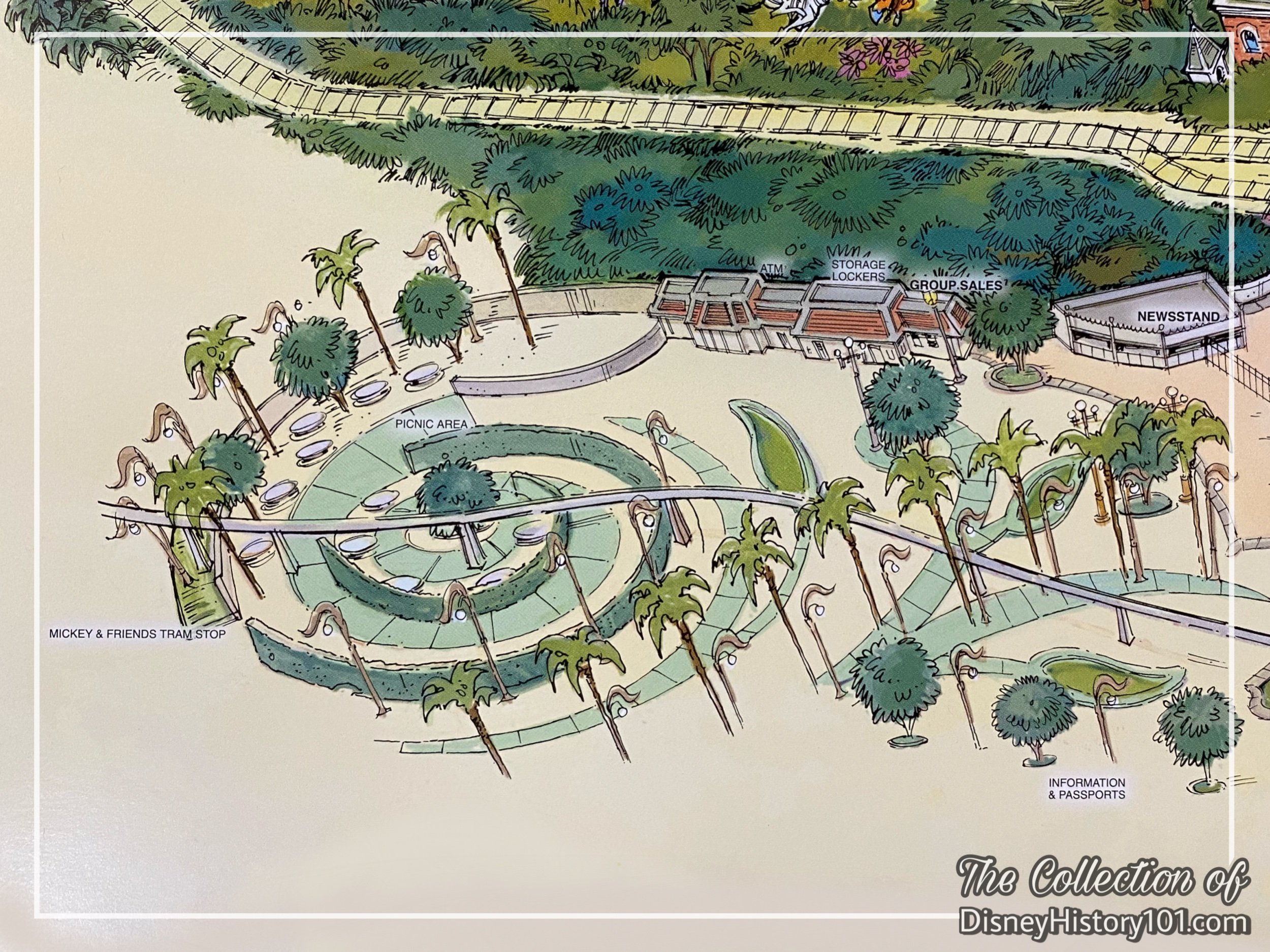
A Picnic Area is depicted on the Disneyland 50th Anniversary Map by Nina Rae Vaughn.
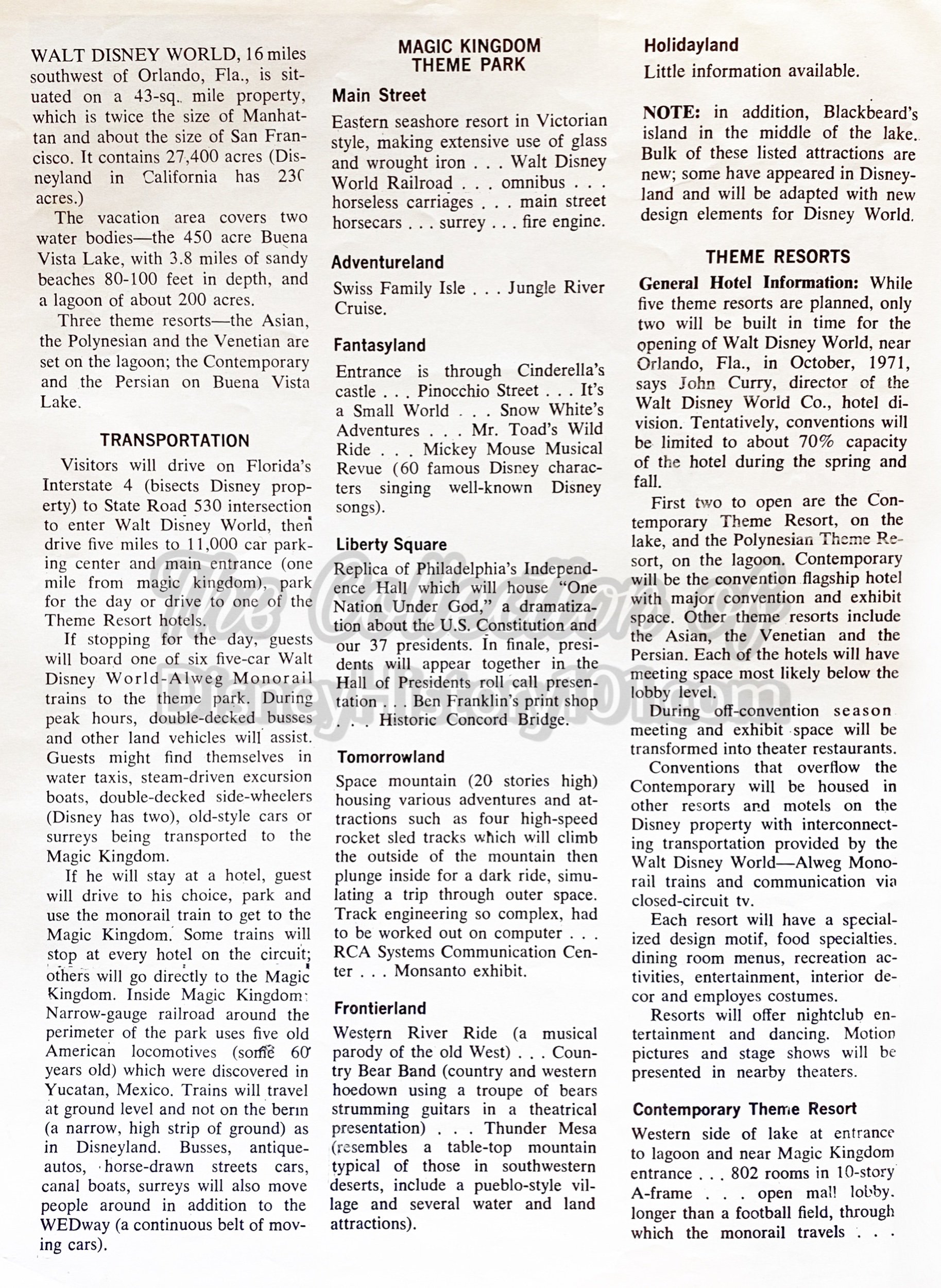
Holidayland is mentioned in the “Preview of Disney World,” printed by Bill Publications, July of 1969.
Holidayland had a legacy (of sorts). For a number of years, a Picnic Area would sit (South West of Disneyland; near the Group Sales Building) on part of the location where Holidayland once stood. As food and beverages could “not be brought into Disneyland,” guests could relax, find refreshment, and enjoy any items they brought, while in this Picnic Area, before entering the Park.
Almost a decade later, the idea of “Holidayland” was considered yet again. This time, for possible installation during Phase One of the East Coast Magic Kingdom theme park development at Walt Disney World (see the 1969 “Preview of Disney World” brochure excerpt above).
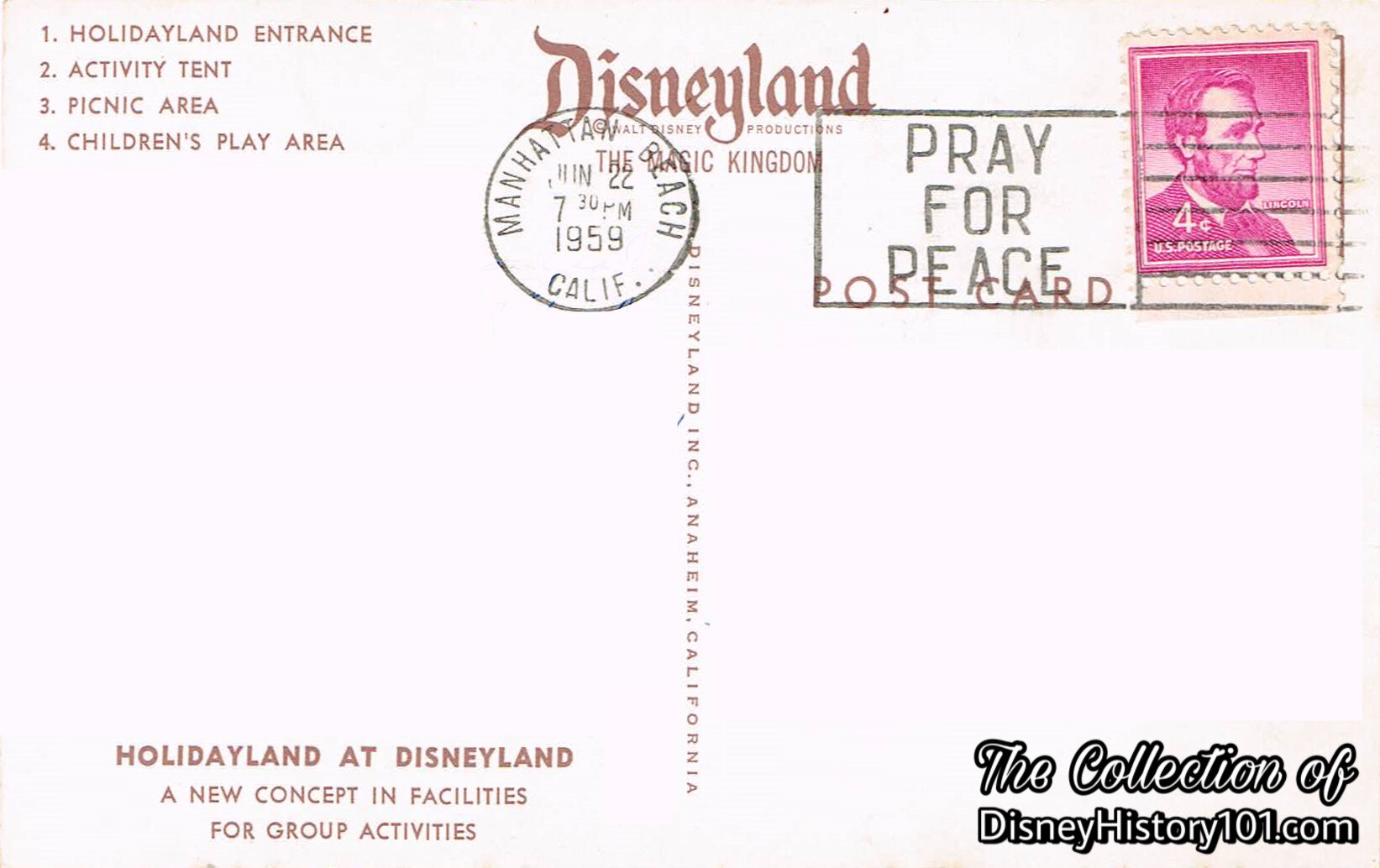
Holidayland Postcard (Back); CARD #460 (H-1)
Our tours (via Vintage View online galleries) at Disney History 101, often end in the Gift Shop, and Holidayland is no exception! For those who visited and remember Disneyland’s “new concept in facilities for group activities,” Holidayland was certainly “something to write home about.” Disneyland Merchandisers knew this, and made sure that guests could (at the very least) find one style of Holidayland postcard at select Disneyland shops!
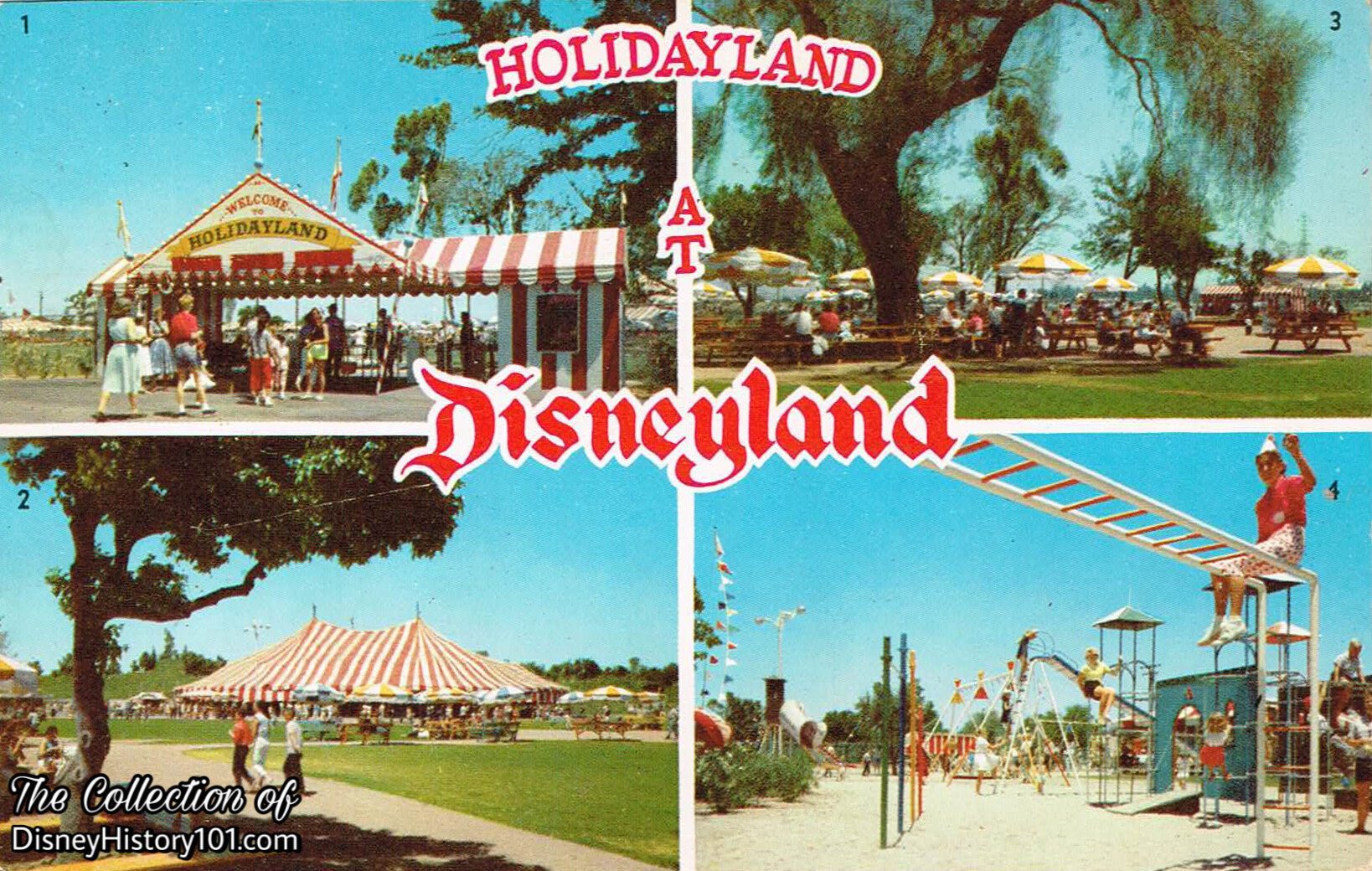
Holidayland Postcard (Front); CARD #460 (H-1)
Holidayland didn’t have a lot of iconic landmarks to be utilized for licensed merchandise. Owning to this, is the absence of Holidayland merchandise. In fact, this rarely seen postcard may be the only Holidayland merchandise ever produced. Not withstanding this rarely seen memento, those fortunate enough to have visited this short-lived land at least once in their life, still carry the cherished memories of their experience at Holidayland, which are far more valuable than any tangible souvenir may have been!

“Here is a photo of the Westchester Lariats taken in Holidayland just before we formed up for the Disneyland Christmas parade in December 1959.
I am in the middle, front row. My sister Shelley is behind me a little to the right. My brother Tom is last on the right, and my sister Maureen is in the second row, second from the right. Long before the Electrical Parade and other extravaganzas DIsneyland invited local dancing groups and high school bands to perform in the parades. In return we received free admission. It was lots of fun.
It is interesting to note the international flavor of the parade. Behind us you can see a Pipe Band, and just to the right behind us are Mexican dancers, and over to the left are Middle Eastern dancers. Thanks, Mr. Disney for giving us so many happy memories.”
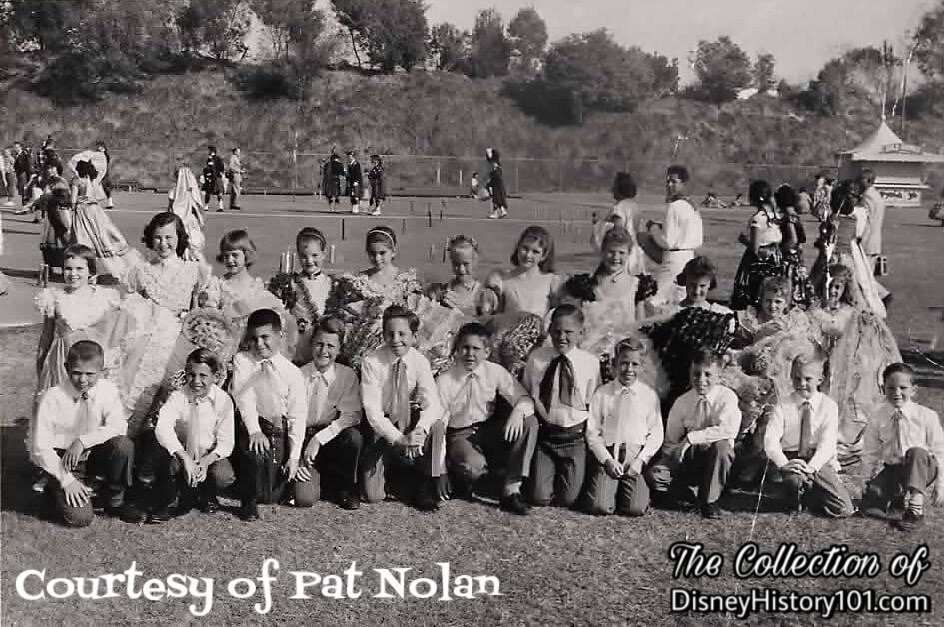
Westchester Lariats Visit Holidayland, (1959)
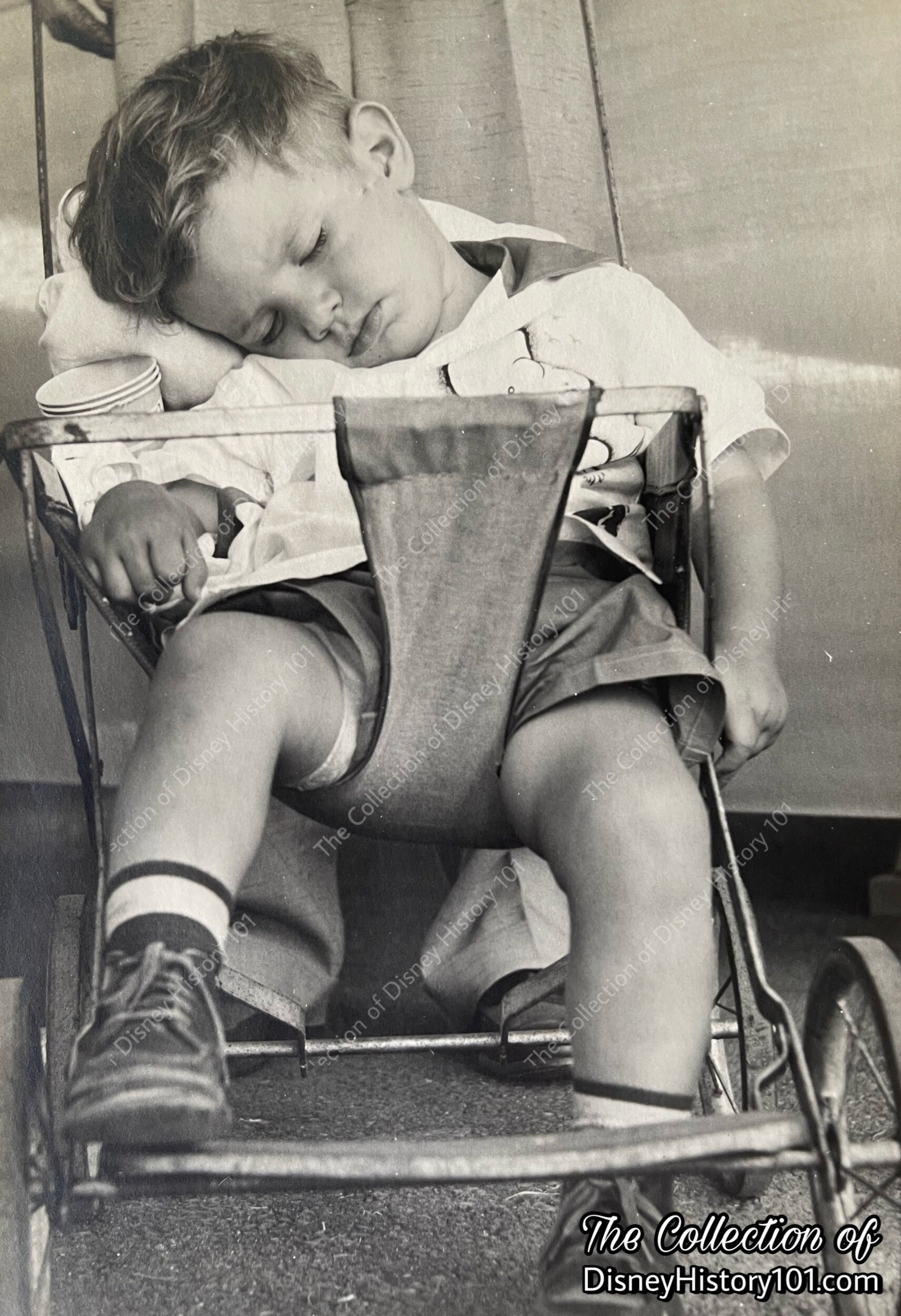
Young Guest had a fun-filled day at Holidayland, NRC Festival held August 10th, 1958 ; Photo Credit : Fred Armstrong
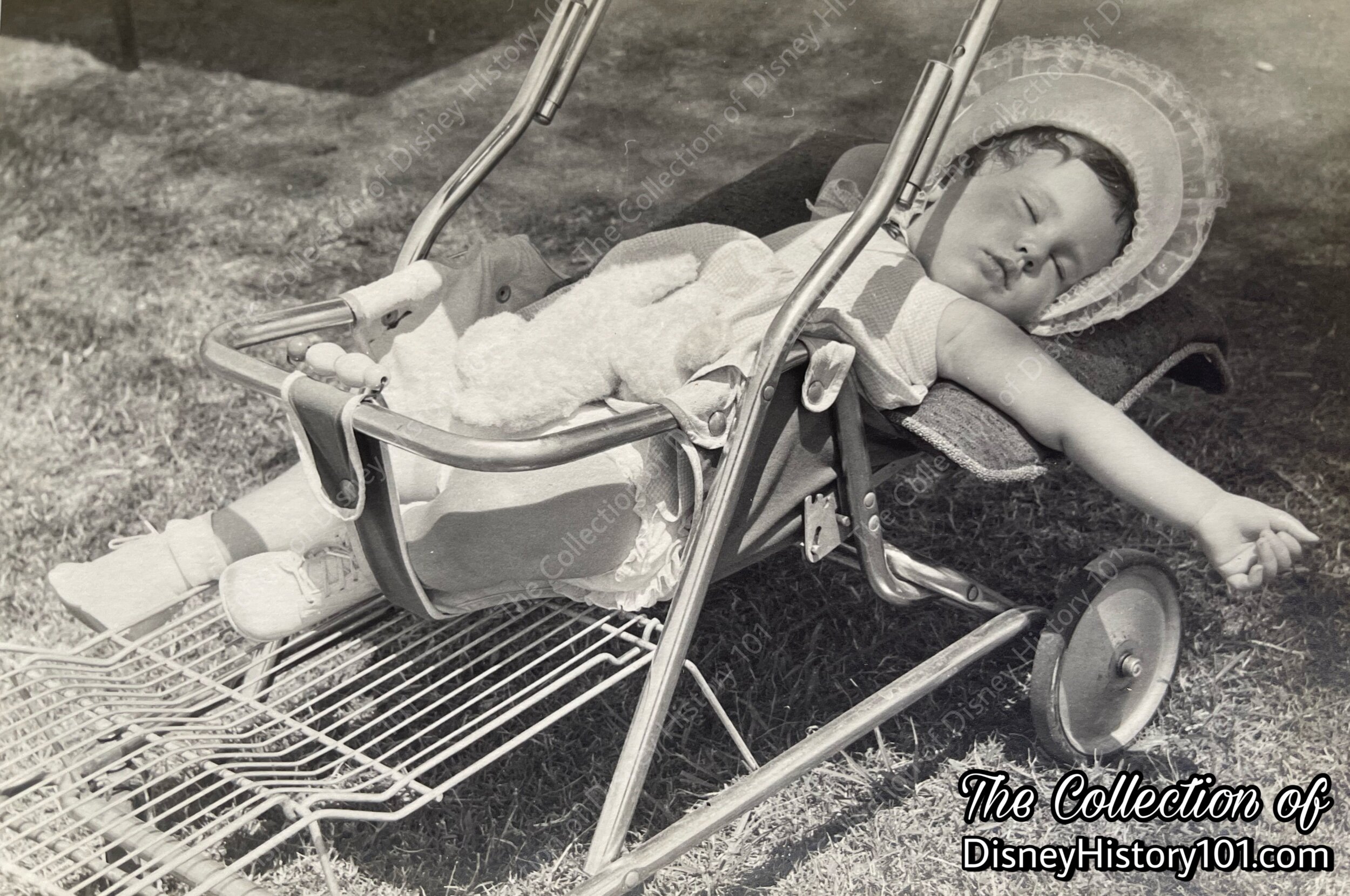
Young Guest had a fun-filled day at Holidayland, NRC Festival held August 10th, 1958 ; Photo Credit : Fred Armstrong
